30 Years Of Taking The Road Less Travelled
Fall for NORTH AMERICA
The best places to visit in the USA & Canada this autumn
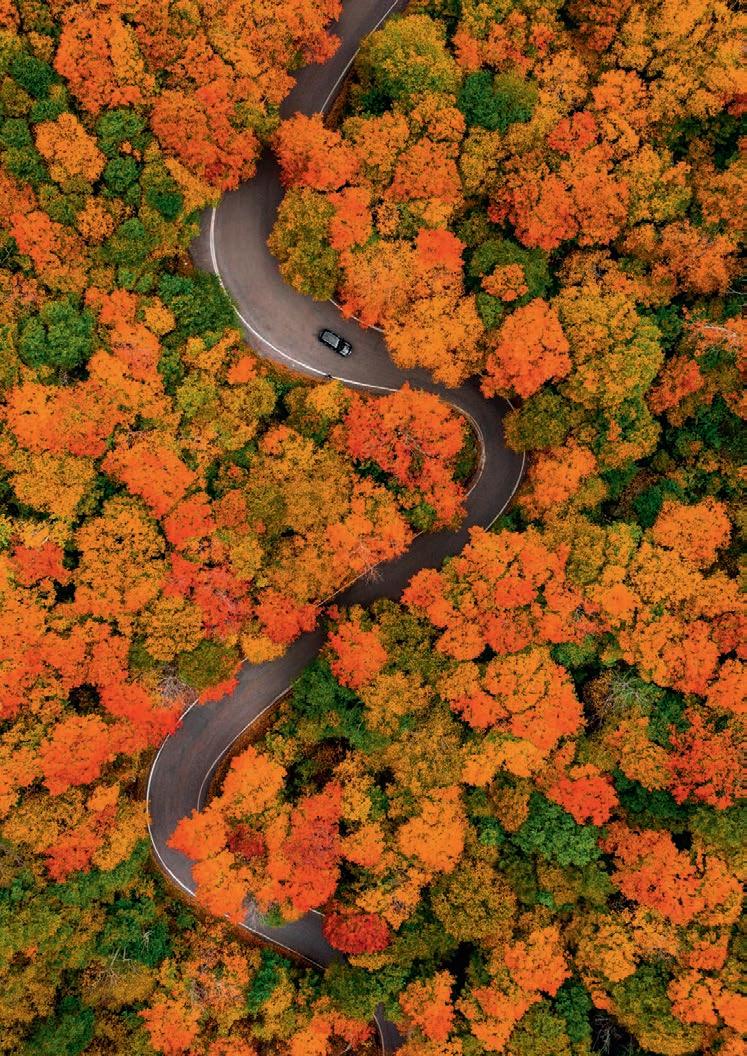
In search of India’s tigers Explore historic Jeddah Hit Belize’s Garifuna Trail
The North Wales Way Mesa Verde NP Peruvian umami Cultured Bordeaux Kenya
�
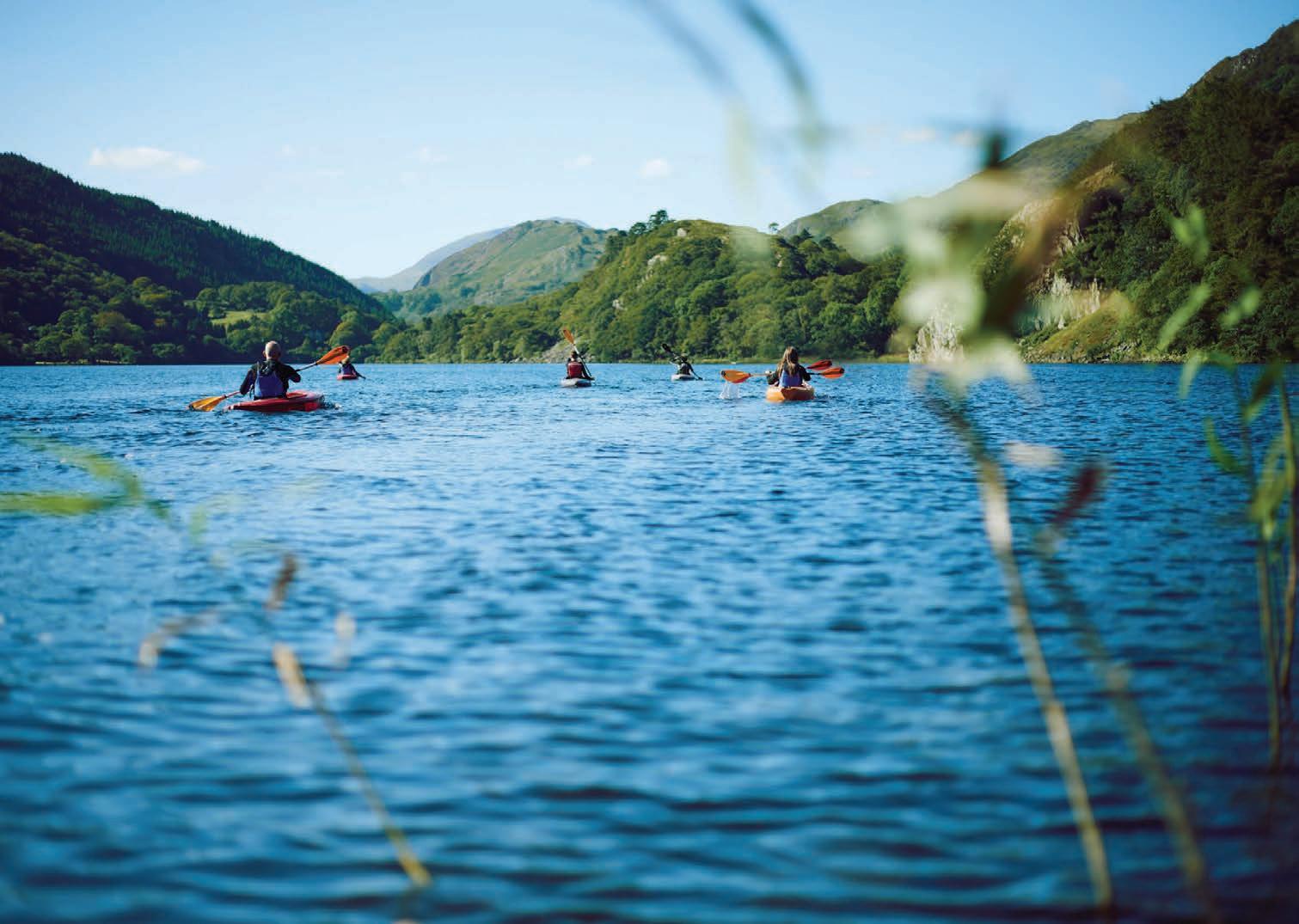






This past summer has been challenging for many people around the world. While traditionally considered the high season for much of the Northern Hemisphere, climate change is shifting perceptions of when and how we should travel. Record temperatures and devastating wildfires – from Canada and Hawaii to much of the Mediterranean – have destroyed swathes of nature, wreaking havoc on livelihoods and, less crucially, impacting travel plans. We’re hoping that autumn, with its milder weather and fewer crowds, will yield less dramatic news and afford plenty of opportunities to get back out there. The weather, despite its climate change-induced unpredictability, is one of the reasons Wanderlust recommends the USA and Canada as two of the best places to visit at this time of year (p114). Nature’s unrivalled palette delivers a kaleidoscope of reds, oranges and yellows in the form of fall foliage, particularly on the East Coast (think New England, Quebec, Ontario, Nova Scotia) and around the Great Lakes. The season also brings with it a calendar filled with festivals and events, opening the door for exploring national parks and popular historic sites across the USA and Canada, from Colorado’s Mesa Verde (p84) to Alberta’s Lake Louise (p66), without the summer hordes. Beyond North America, the Middle East also shines as a destination for autumn travel. Our founding editor, Lyn Hughes, recently led a Wanderlust team afforded unprecedented access to Jeddah’s UNESCO-listed historic district, Al-Balad, and shares the magic of one of Arabia’s still undiscovered gems this issue (p168). There is plenty to see closer to home too, and we ventured out to North Wales (p152) for a slow journey through a region that is reinventing itself.
If you’ve ever suffered from the autumn blues, make sure you plan ahead by picking some great destinations to explore. It is the antidote that works every time!
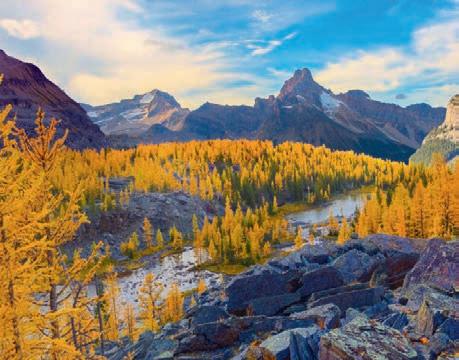
Safe travels,
George Kipouros Editor in Chief @georgiostravels

Wanderlust is the UK’s leading independent travel magazine, taking the road less travelled since 1993. Paul Morrison and Lyn Hughes schemed the project on a flight to Ecuador, aspiring to produce a publication that combined the right mix of wildlife, activities and cultural insight. Under new management since 2020, Wanderlust has expanded rapidly to add further themes to its editorial focus, such as history, archaeology and urban destinations, while continuing to strengthen its commitment to responsible, conscious and sustainable travel. It is now available in the USA, Canada and in over 70 countries around the world. With a strong and rapidly growing digital presence, wanderlustmagazine.com delivers thousands of articles and attracts over 12 million visitors a year, alongside 180,000+ social media followers. ‘The Wanderlust Club’ also maintains a community of serious travellers engaged 24/7. Wanderlust’s blend of exclusive features, practical reviews, unique insights, tips and ideas has won awards from respected industry bodies across the planet.
WANDERLUST: ‘The wish to travel far away and to many different places’
Cambridge Dictionary



7 WELCOME
UK & international covers: Fall foliage in Smuggler’s Notch, Vermont, by Anthony Quintano; limited-edition cover: Historic District in Jeddah, Saudi Arabia, by Jeddah Historic District; cover wrap & this page: Colin Peterman; Alamy
–
Instagram See behind the scenes @wanderlustmag X Latest travel news @wanderlustmag Facebook Join the chat at www.facebook.com/ wanderlusttravel magazine @wanderlustmag Newsletter Sign up to our newsletter for news, offers and inspiration at wanderlustmagazine.com Subscribe For the latest offer, turn to page 40 Threads @wanderlustmag Wanderlust: OffthePage Catch up with our very own podcast
The golden-hued larches of Banff NP in Alberta, Canada, are one of the joys of autumn in North America, a season that also sees the arrival of everything from the USA’s biggest Day of the Dead festival to buffalo round-ups; see p114
Contributors
LEIGH GARDNER
USA & Canada, p114
US park ranger Leigh recalls hiking the foothills of Tennessee in autumn this issue: “The colour change in the leaves is not only about being aware of the seasons, fall in the Appalachians is an adventure for the senses. Together with the earthy aromas and the quiet of the forest, the way the sunrise and sunset reveal new colours, from yellows to indigos, leaves me in awe.”
LOLA MÉNDEZ
USA & Canada, p114
Lola is a UruguayanAmerican freelance journalist who writes about travel and culture. This issue, she heads to Massachusetts for Halloween: “Before visiting Salem, I knew about the city’s history of accusing outcasts as witches, but I didn’t know that it was also a major port for pirates – there were even female buccaneers. Luckily, it has many museums on both its witches and piratical past.”
SUSTAINABILITY

Get In Touch
LONDON OFFICE
Capital House, 25 Chapel St, Marylebone, London NW1 5DH
Subscriptions +44 (0)1371 853641, subs@wanderlust.co.uk
Advertising +44 (0)20 4583 5486, sales@wanderlust.co.uk
JAMES DRAVEN India, p96
Award-winning travel writer and big-cat enthusiast James travels to India’s famous tiger reserves during the 50th anniversary of the Project Tiger conservation scheme: “Tigers aren’t easy to spot in the wild. Not only is their camouflage surprisingly effective, but 80% of each tiger reserve is closed to public access, allowing these endangered cats to recover in inviolate wildernesses.”
MARY NOVAKOVICH
Bordeaux, p208
Travel writer Mary is the author of the Stanfordsshortlisted My Family and Other Enemies. In this issue, she explores why Bordeaux is about far more than just wine: “It’s such a buzzing city, and it’s become a master at reinventing itself in recent years. The food scene never stops evolving, and there’s always a new cultural quarter that’s been given a complete makeover.”
General Enquiries: UK: +44 (0)20 8185 0958 USA: +1 64 6844 8718 info@wanderlust.co.uk
EDITORIAL CONTENT
Editor-in-Chief George Kipouros @georgiostravels
Founding Editor Lyn Hughes @wanderlust.lyn

Associate Editor Gareth Clark
Special Features Editor Rhodri Andrews
Special Features Editor Rosie Fitzgerald (maternity leave)

Special Features Assistant Editor Laura Field
Sustainability Editor Karen Edwards @KarenNEdwards_Writer

Editor-at-Large Katie McGonagle @katie_mcgonagle
Contributing Editors Sarah Baxter, Mark Carwardine, Paul Goldstein, William Gray & Mark Stratton

DAVID ATKINSON North Wales, p152
Travel writer David has revisited some of his former childhood haunts for this issue, as he joins the slow lane on The North Wales Way: “What really struck me was how North Wales manages to continually evolve. The places were familiar, the folklore and landscape unchanged, but the range of new attractions and local-food champions came as a revelation.”
Wanderlust is printed on paper from sustainable forestry and produced using suppliers who conform to ISO14001, an industrial, environmental standard that ensures commitment to low
Pleaserecyclethismagazine
CLAIRE ANTELL-THORNE
Georgetown, p200
An updater of the Bradt guide to Guyana, Claire has spent 20 years exploring its wilds, but it’s Georgetown that keeps drawing her back: “Since my first night in the capital, sipping rum with a rancher and discussing poison arrowheads, I have enjoyed delving into the complex history of a city shaped by water, the sugar industry, and now oil.”
OfficialpartneroftheFCO’s KnowBeforeYouGoCampaign

© Wanderlust Travel Media Ltd, 2023, ISSN 1351-4733 Published by Wanderlust Travel Media, Capital House, 25 Chapel St, Marylebone, London NW1 5DH. All rights are reserved. Reproduction in any manner, in whole or in part, is strictly forbidden without the prior written consent of the publishers. All prices are correct at time of press. No responsibility for incorrect information can be accepted. Views expressed in articles are those of the authors, and not necessarily the publishers. Wanderlust is a registered trademark. US distribution Wanderlust (ISSN No: 1351-4733, USPS No: 23718) is published six times per year by Wanderlust Travel Media Limited, and distributed in the USA by Asendia USA, 701 Ashland Ave, Folcroft PA. Application to Mail at Periodicals Postage Prices is pending at Philadelphia, PA, and additional mailing offices. POSTMASTER: send address changes to Wanderlust, 701 Ashland Ave, Folcroft, PA. 19032. Contributions & work experience For details, please go to www.wanderlustmagazine.com/about-us Printing Walstead Roche, Victoria Business Park Roche, St Austell, Cornwall PL26 8LX Newstrade distribution Marketforce (UK) Ltd: 0203 787 9001 Circulation marketing Intermedia Brand Marketing Ltd: 01293 312001
DESIGN

Art Director Graham Berridge
Assisted by Scott Jessop (maps)
DIGITAL
Digital Creative Director Anil Karwal
Digital Editor Jessica Reid
COMMERCIAL PARTNERSHIPS
Chief Commercial Officer Adam Lloyds (adam.lloyds@wanderlust.co.uk)

VP Brand Partnerships David Read (david.read@wanderlust.co.uk)
Senior Creative Partnerships Manager Simon Bryson @_bryos
BUSINESS
Chief Executive George Kipouros
Chief Operating Officer Elliot Wellsteed-Crook
Marketing & Social Media Manager Christina Wildman Mullett

Wanderlust Club Manager Maria Manta
In memory of Co-founder & Publisher Paul Morrison

RECENT AWARDS

ABOUT US
carbon emissions and environmentally sensitive waste management. The paper can be widely recycled.
8 October/November 2023




56 Sustainable Travel
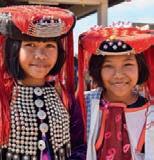


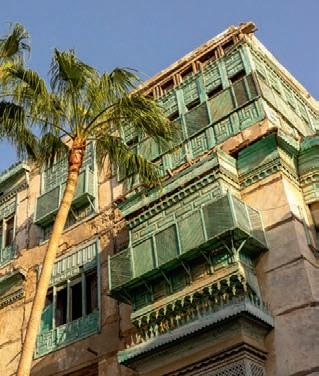

When the pictures we take can do more harm than good




58 World Food: Nikkei

How the arrival of Japanese workers in the late 19th century gave Peru a taste for umami

63 Dream Sleep

Visit the sustainable stay that is revitalising a little-seen part of Greece’s Peloponnese

66 WanderSleeps:
Canadian Rockies

The Rocky Mountain stays that make the most of their setting
74 Dispatches: Belize






Join a new trail inviting visitors to explore Belize’s Garifuna heritage via its communities


84 Dispatches: Mesa
Verde National Park
Why the disappearance of Colorado’s Ancestral Pueblo people is no mystery at all
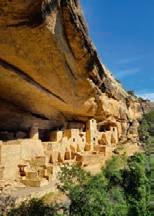
CHECK IN 12 Viewfinder
bounce back, plus wild leopards
Just Back From…
the
Iceland’s
and we escape to lush Vermont 29 Your Photos You send us your top travel shots JOURNAL 32 Grapevine All the latest travel news, views, stays and exhibitions 37 Health How to make sure that diabetes doesn’t upset your adventures 44 Armchair Travel The shows, podcasts and books to set your travel passions alight 52 Departures We pick the tours that offer a fresh look at North America Contents
Slovenia, Greece and Ethiopia
22
Feeling
heat alongside
lava peepers,
74 22 66 58 168 56 52 63 44 84 THIS ISSUE MAPPED
FEATURES
96 India’s Tigers
It has been 50 years since India launched Project Tiger, a landmark conservation programme that introduced a raft of parks, reserves and policies created to protect a tiger population limping towards extinction. Now, with numbers creeping upwards, we visit the habitats of Madhya Pradesh to see the effect on a country that is now home to 70% of the world’s tiger population

114 USA & Canada in Fall
Autumn in North America is a time of fine food, great festivals and unforgettable foliage. We talk to the locals who know it best, as they pick the top fall escapes in the USA and Canada, from leaf-peeping road trips to buffalo round-ups, to joining the celebrations at North America’s largest (and loudest) powwow
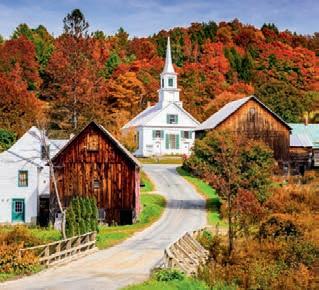
152 The North Wales Way
How a slow drive along the North Wales Way rekindled one writer’s love for the region and revealed
a part of Wales that is gradually reinventing itself through food, culture and the rediscovery of its history from a local perspective
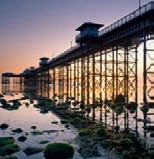
168 Historic Jeddah

The district of Al-Balad was the heart of Jeddah for centuries, but it has long since fallen into
DISCOVER
200 World Heritage

Why a recent oil boom means Guyana’s capital must balance preservation of its colonial past with building for the future
204 Museum Cities
How the Age of Discovery gifted Lisbon a museum scene to envy
206 Indigenous Culture

A new wave of local travel experiences is finally helping Kenya’s remote communities to benefit from tourism
208 Urban Spotlight
Bordeaux isn’t just about wine. The city is forever reinventing itself, and it’s putting culture and sustainability at the forefront

216 British Break
disrepair. As its townhouses undergo a much-needed restoration and it readies itself for a new wave of visitors, we take a sneak peek at what is being done to restore the area to its best while still keeping its communities and soul intact
The UK’s dark-sky sites reveal not only cosmic views, but a history and wildlife tied to the heavens
223 Wanderlust Quiz












Test your travel knowledge by naming these US cities
226 Top Guide




















Gambian birding expert Malick Suso on his top sightings
SUBSCRIBE TODAY!
And get exclusive access to competitionsoffers,and events. See p40 for details
Map illustration: Scott Jessop
96 216 152 22 204 226 22 114 114 52 114 52 114 200 84 114 58 168 12 206 208 56 32 12 12 12 63 96 32
114 152 208 206 Northumberland North Wales Iceland Lisbon The Gambia Vermont Amelia Island Puerto Rico Manitoba The Yukon The Maritimes Oregon Georgetown Colorado Idaho Peru Jeddah Kenya Bordeaux Bangladesh Malaysia Rhodes Diriyah Falkland Islands Slovenia Peloponnese India Great Barrier Reef www.wanderlustmagazine.com 11
Piran, Slovenia
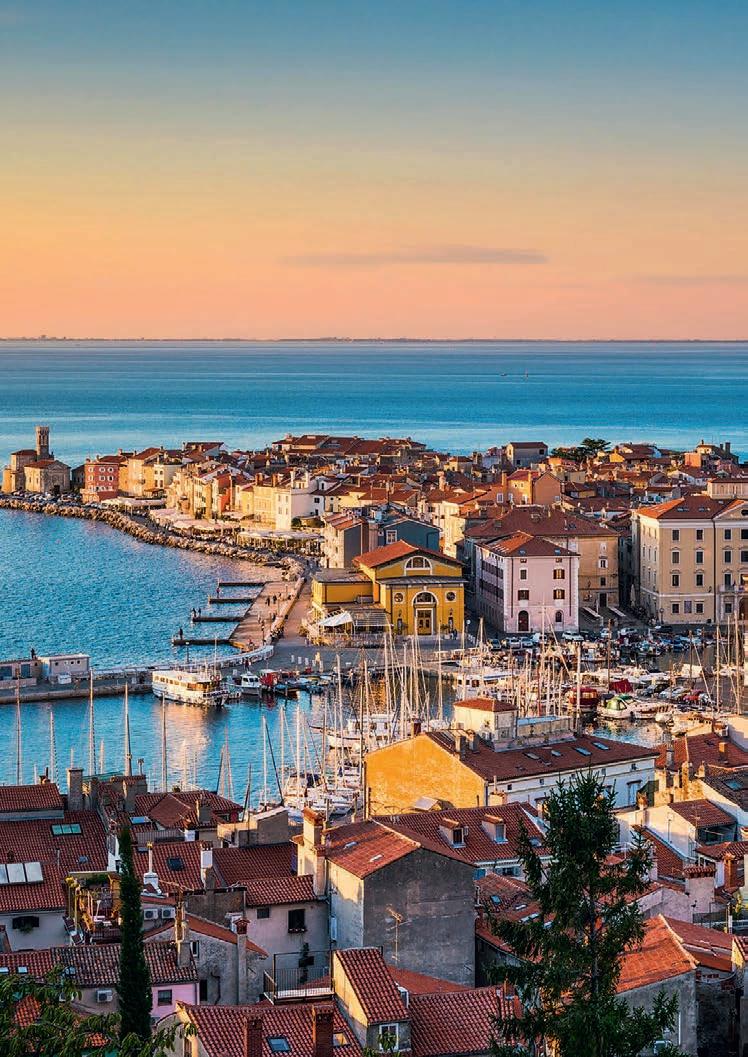
Photographer:
Michael Abid
This summer was a difficult one for many, not least in Europe where fires and rains battered the continent. In August, Slovenia suffered its worst-ever natural disaster as floods swept across two-thirds of the country. But even in the most affected central and eastern areas, things have largely returned to normal now, although the damage and loss of livelihood during the busy summer period continues to resonate for many. Certainly, those travellers tempted by Slovenia’s Adriatic coast will find their customary warm welcome intact in Piran, a town of exquisite Venetian Gothic fancy and no small number of nooks from which to spy sunset bathing the waters of the gulf a hazy orange. During late summer its twisting alleys, walkable city walls and historic Tartini Square would normally be packed with crowds, so autumn is the ideal time to visit in peace. Yet, as you wander one of Europe’s best-preserved historic cities, know that you will also be helping to support local businesses craving a busier end to the year than usual.
© Michael Abid/Alamy
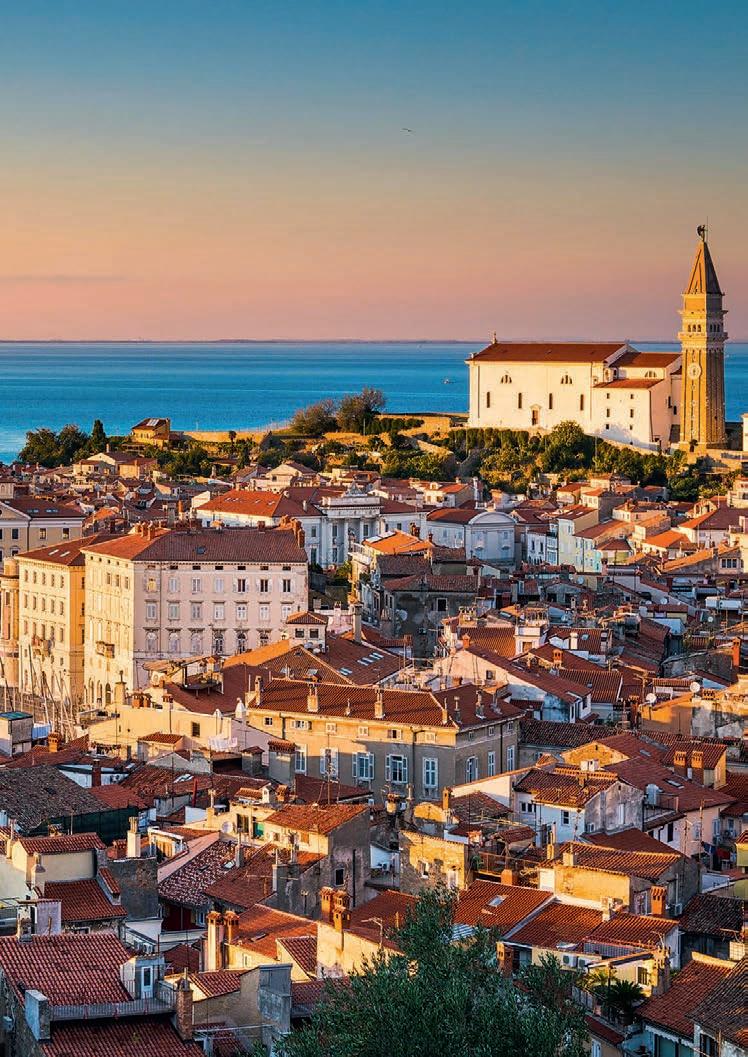
VIEWFINDER
Falkland Islands, UK
Photographer: Stephen Wilkes
What is an authentic photograph? For all that it can seem like life has been captured mid-flow, the image you see is always the result of some kind of optical trickery: ways of deceiving the eye to create depth, movement, emotion.
No one knows this better than the acclaimed American photographer Stephen Wilkes, who in his latest book, Day to Night, set about creating pictures by taking thousands of shots from a single position over the course of a day, then spent months stitching them together digitally into one panorama. Among the more miraculous is this image of an albatross-strewn hillside in the Falklands, where dusk descends on one side just as a rainbow soars up the other. In some ways it’s a lesson to us all. While many laud travel photography as a wholly instinctive art, Wilkes reminds us that it’s also about choices, patience and the thing we most forget in our quest for authenticity: pure imagination.

© Stephen Wilkes. Day to Night by Stephen Wilkes (TASCHEN; £60) is out now; taschen.com

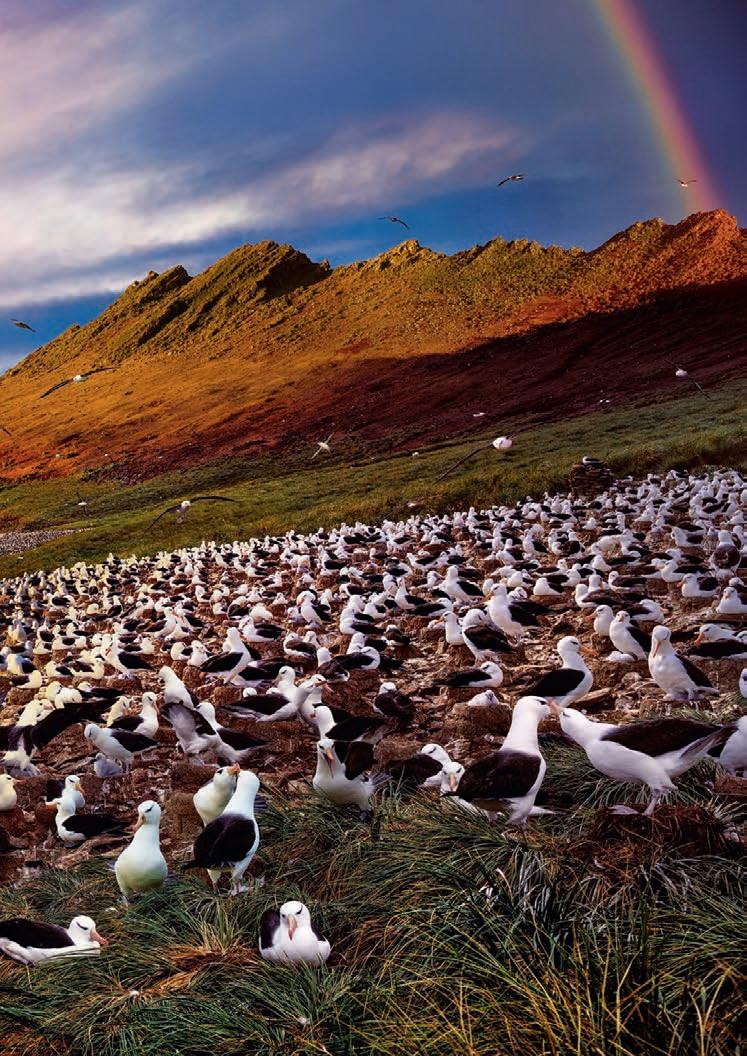
VIEWFINDER

VIEWFINDER
Masai Mara National Reserve, Kenya
Photographer: Paolo Torchio
Not missing something until it’s gone is easily one of the worst human traits. It’s the kind of dull complacency that books like Remembering Leopards, part of a long-running series by some of the world’s top photographers, seeks to avoid by turning its gaze on yet another species on the brink. Having already raised over £1 million for wildlife conservation, the latest edition takes the leopard as its muse, many subspecies of which face extinction. The Amur leopard, for example, is the world’s rarest big cat and prowls a territory barely the size of London on the RussiaChina border. Few will ever see one, whereas the leopards of Kenya’s Masai Mara (pictured) might be elusive but can sometimes be spotted roaming the wooded savannah by lucky travellers. If this series demonstrates one thing, it’s that persistence is everything in both conservation and wildlife watching, but once you miss your shot, it’s gone forever. © Paolo Torchio. Remembering Leopards by Wildlife Photographers United (Remembering Wildlife; £49.50) is out in October; rememberingwildlife.com

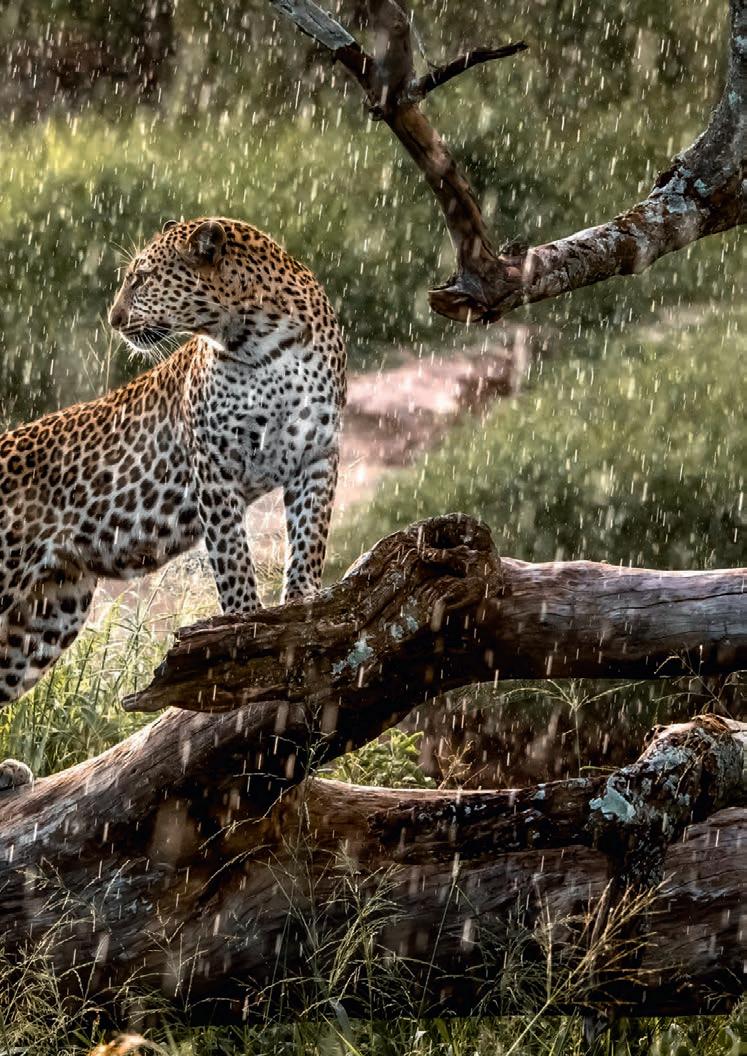
Diriyah, Saudi Arabia

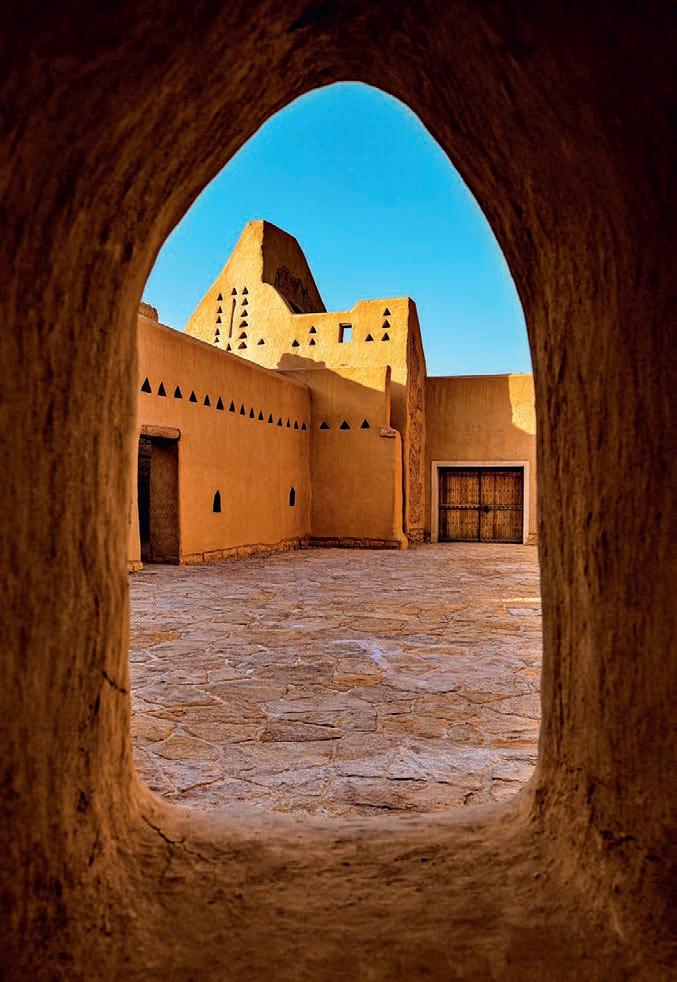
They say you can never plan the future by the past, but in the case of Saudi Arabia, whose heritage sites are undergoing a series of grand restorations, you can almost set your watch by it. We have already seen the Nabataean ruins of Hegra reopen to the public, and in this issue we take a sneak peek at the renovations to Jeddah’s historic district of Al-Balad (see p168), but among the country’s most exciting projects is Diriyah, where the UNESCO-listed At-Turaif (pictured) reopened to visitors at the turn of this year. A site of mud-built palaces, mosques and museums, this was where the first inklings of the Kingdom took shape, as new book Diriyah Culture: At-Turaif explores. It is also the first of many new openings here, as hotels, restaurants and shops – each built in the Najdi style – emerge. For all the ambitious new builds in Saudi’s future, it is the resurrection of its historic areas that thrills us the most. It’s proof, if it were needed, that the past should always be a part of our future.
© Diriyah Gate Company Limited. Diriyah Culture: At-Turaif (Assouline; £150) is out now; eu.assouline.com

Aksum, Ethiopia
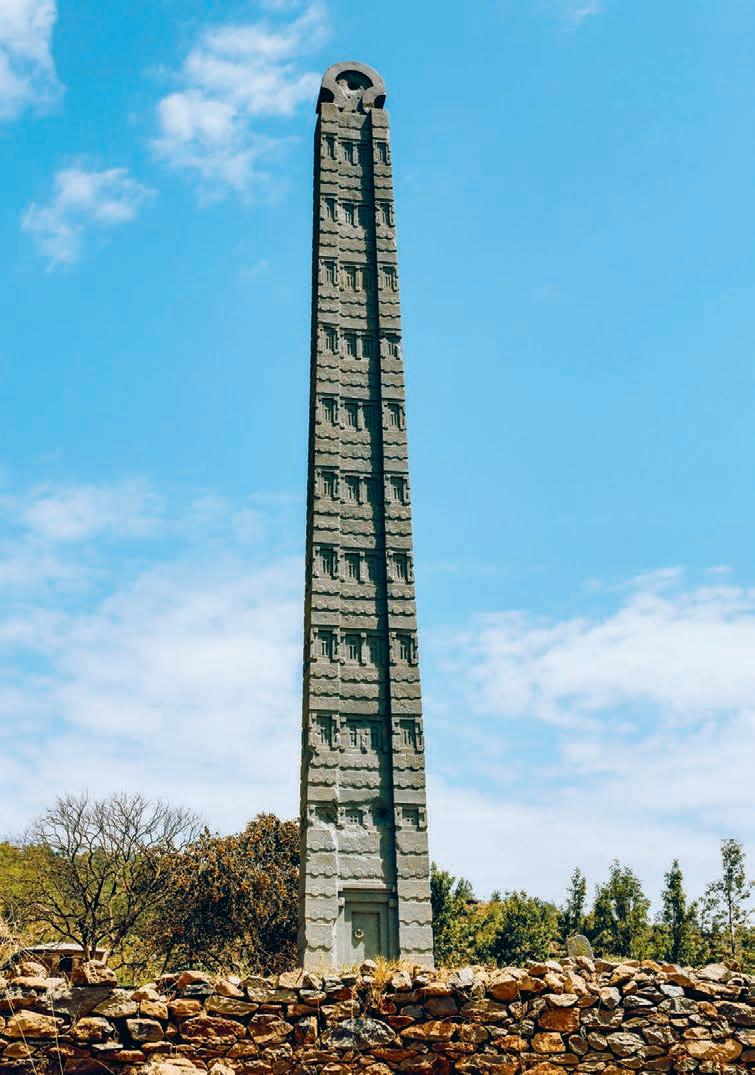
In November, it will be a year since the peace treaty that ended fighting in Ethiopia’s Tigray region was signed. Between the pandemic and the outbreak of war, local authorities estimate the country lost over £1.5 billion in tourism revenue over two years, a figure that inevitably filters down to those who feel it the most: the communities relying on this income. With the region now opening to visitors again, it’s a good time to remind ourselves of what we missed: an area that was once the centre of one of the great powers of the ancient world. At its peak in the 3rd century AD, the Aksumites controlled much of modern Ethiopia, East Africa and Yemen, as Philip Matyszak’s new book, Lost Cities of the Ancient World, explores. What they left behind is still being uncovered, with sites like Beta Samati having only been rediscovered in 2009. But in its fields of stelae – huge obelisks rising from the scrub near Aksum – you can find a region where the glories of the past still linger on the surface. © Artrushfoto/Adobe Stock. Lost Cities of the Ancient World by Philip Matyszak (Thames & Hudson; £25) is out now.


VIEWFINDER
Assos, Kefalonia, Greece
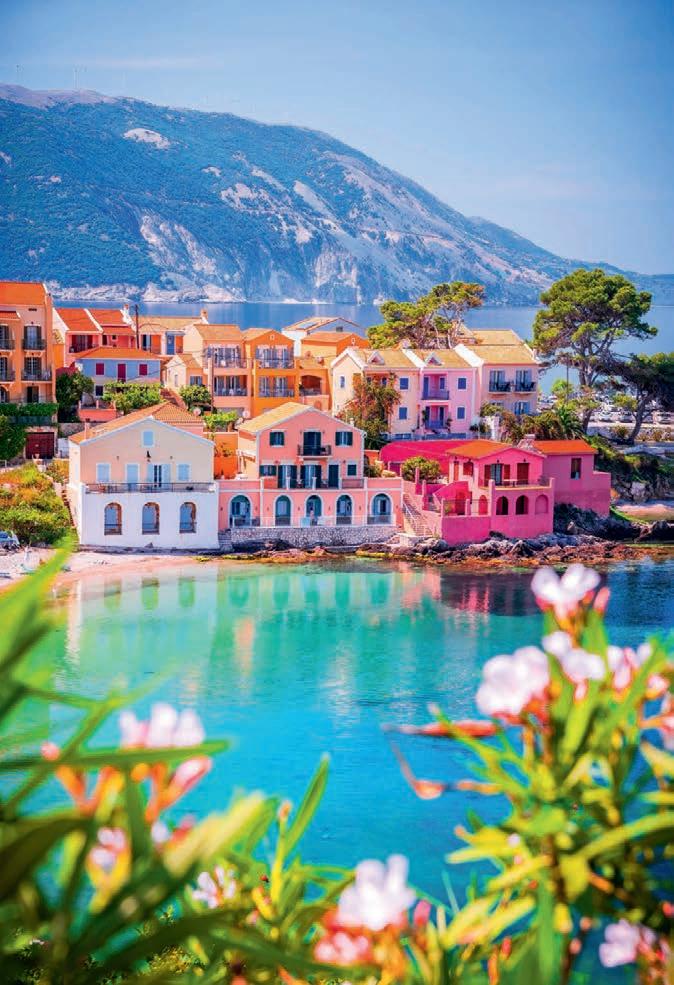
Seventy years ago, the Greek islands of the southern Ionian Sea were struck by a devastating earthquake. Among the worst affected was Kefalonia, where towns, livelihoods and hundreds of lives were erased in hours. The island’s oncebeautiful Italianate architecture, left over from its days under Venetian rule, was largely destroyed; the only remnants that survived were high in its northern tip, where the port town of Fiskardo lay untouched, protected by a thick crust of limestone that buffered the quakes. Sadly, Assos, lying to its south and wrapped by a large shallow bay, wasn’t as lucky. It was levelled. But such was its charm that it was rescued by a group of French tourists, who poured money into rebuilding it as it was. In their honour, the town square was rechristened Paris, and its terraces still make for a suitably laid-back Gallic retreat on a warm autumnal day, as the water fills with paddlers. Afterwards, stroll past colourful houses streaming with bougainvillea to the isthmus where steps wind up to the ruins of a 16th-century Venetian castle, high on the bluff, to gaze down and recall a time when tourism saved a town.
© Alpineguide/Alamy

Lindos, Rhodes, Greece

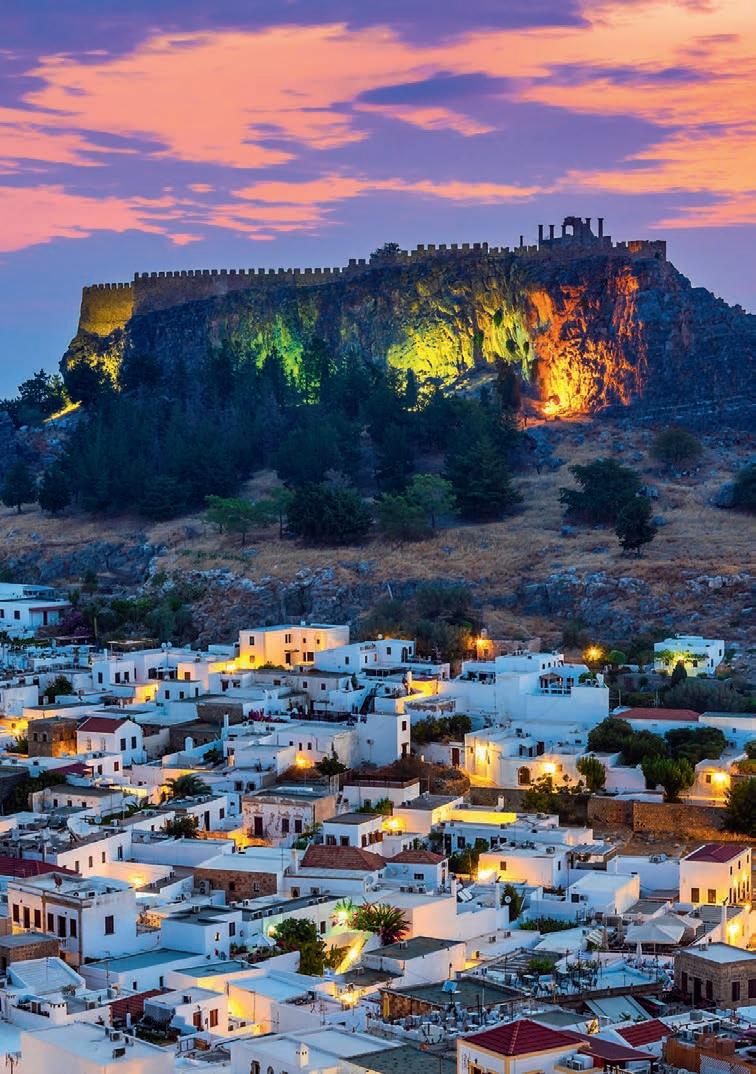
As wildfires tore across Greece this summer, one of the worst-affected areas was the island of Rhodes, which saw 13,500 hectares of forest set ablaze. Thousands had to be evacuated, and it will be around five years before its forests recover – though the replanting process has already begun. Yet one of the miracles of the summer was how the island’s historic sites survived unscathed. Long before the medieval Knights of the Order of St John arrived on Rhodes and reshaped its great citadel, Lindos was the main port here until as late as the 5th century BC. As the land burned all around the town this summer, it remained remarkably untouched. Its acropolis still towers over a covered market scattered with whitewashed captains’ houses, whose hochlakia (black-and-white mosaic) floors now host busy cafés. But the real jewel here sits on high, within the walls of a castle built millennia after the acropolis was first settled. It hides the ruins of temples and walls that have resisted the rough salt breeze for generations, reminding us that this island can withstand anything, especially the elements. ©
Alpineguide/Alamy
VIEWFINDER
Iceland
Mark Stratton returns from the south-west of Iceland, where volcanic activity on the Reykjanes Peninsula recently fuelled a steady stream of visitors wanting to see an eruption up close
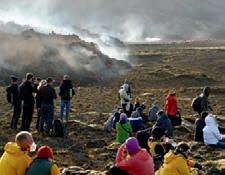

Whathappened? On 10 July, a fissure opened within Iceland’s Fagradalsfjall volcanic complex, which had seen two eruptions since 2021. Fountains of 1,100ºC lava gushed skywards from the Litli-Hrútur hillside and a blackened cone began rising within days. Initially, sulphur-dioxide gas and moorland fires made the area dangerous to approach, so, after arriving within 72 hours of the eruption, I waited several days for access to be declared safe. Howtoseeit: Local authorities created a 20km round-trip path to a viewing site that ran from a new car park at Suðurstrandarvegur, 35km from Reykjavik, and crossed rough, flattish terrain. I followed hundreds of locals and tourists in walking to within 1.5km of the emerging cone, where emergency services prohibited closer access.The volcano spat lava in two flaming jets that oozed over its flanks.The viewing point was a bit distant, but it was also just metres from the front of a creeping lava flow that moved imperceptibly slowly and sounded like shattering glass. In the area: Previous Fagradalsfjall eruptions have created lava plains and cones to explore on foot. Describing them as lunar landscapes is an overworked cliché, yet the Reykjanes Peninsula
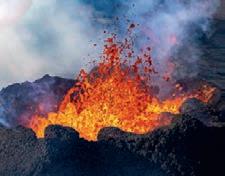
is somewhat alien. It’s an A to Z of volcanology, with gushing geysers,boiling springs and sulphurcoloured lakes easily explored by hire car. Near Sandvik, a bridge spans the diverging Eurasian and North American tectonic plates that power Iceland’s volcanic activity. Close to the eruption is the famous Blue Lagoon geothermal spa. Staying safe: It’s vital to heed local advice and to not attempt to access an eruption if the path is temporarily closed.Wear good boots, stay hydrated and take both binoculars and a long-lens camera. Competent drone flyers were getting the best pictures of the eruption. IwishIhadknown:Given the stinging heat and dust, I should have taken ski goggles. Likewise, if you have respiratory concerns,you would be well advised to pack one of those canister gas masks that some people bought during the pandemic. Anything else: While past Fagradalsfjall eruptions lasted up to six months, all activity here ceased on 5 August.That’s not to say that it won’t erupt again soon, though, so be prepared to move quickly if it does in order to see it. I travelled with Discover theWorld,which offers a Volcano Special tour that includes a guided volcano hike (discover-the-world.com).
LETTERS OF THE MONTH
Goingsolo
I thoroughly enjoyed the ‘Solo Travel’ feature in the latest issue [issue 228; Aug/Sep 2023].

I have travelled solo many times, on both long and short trips, and I love it. The article reinforced my own experiences and reassured me that, yes, evenings alone are the worst aspect of it, but I overcome this with food and drink, walking tours and the odd KFC when I can’t face a restaurant by myself. So many people tell me I’m ‘brave’ and that they could never do it, but of course, they never tried! Thank you also for highlighting the difference between ‘single’ and ‘solo’ – definitely a bugbear of mine!
Andrea Kerns
Quiztime
I just wanted to email to say that not only am I a long-standing fan of your magazine, but I absolutely love your Friday [online] quizzes. They are a highlight of my week and are always fun. I can’t think of one e-newsletter that I always open apart from yours!
Jo O’Connell
Drop us a line with your stories and travel tips at fromtheroad@wanderlust.co.uk and help others find their way. Also, follow us on Facebook (wanderlusttravelmagazine), Threads (@wanderlustmag), X (@wanderlustmag) and Instagram (@wanderlustmag).
JUST BACK FROM…
Wanderlust reserves the right to edit all submissions; images: Alamy; Mark Stratton; @Ragnar Th Sigurðsson/Arctic Images
⊲ 22 October/November 2023
Feeling the heat (clockwise from this) Litli-Hrútur (Little Ram) first erupted in July; 12,000 earthquakes were recorded just prior to this; a 20km round-trip hike takes visitors to the volcano viewing point
Uncovering the American West in

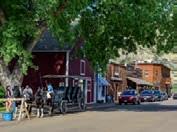
NORTH DAKOTA

Discover one of America’s best-kept secrets with a visit to North Dakota. Experience Indigenous American heritage and the history of the American Midwest against a striking backdrop of cinematic prairie and plains on the border with Canada.
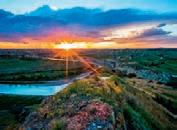

INDIGENOUS AMERICAN CULTURE


The Peace Garden State’s Indigenous American communities played a vital role in shaping the area’s history, culture, language and practices, which are integral to life today. Begin your visit at the North Dakota State Capitol, in Bismarck, and admire the bronze statue depicting Sakakawea, a Lehmi Shoshone girl who guided the legendary Lewis and Clark survey expedition (1804–06) into the West. Nearby, the North Dakota Heritage Center houses eclectic exhibits that include rare examples of Indigenous beadwork, tools used by early hunters and the world’s largest squid fossil. Afterwards, visit On-A-Slant Indian Village at Fort Abraham Lincoln State Park, which lies on the Lewis and
The best of the American West (clockwise from top left) Many of North Dakota’s 500,000 bison live in Theodore Roosevelt NP; Medora is home to the North Dakota Cowboy Hall of Fame; Indigenous American communities have shaped North Dakota’s history and culture; Wind Canyon lies in the South Unit of Theodore Roosevelt NP; the Lewis and Clark Interpretive Center outlines important history
Clark National Historic Trail; its five replica earthlodges show how the thousand-strong population would have lived prior to the 1781 smallpox epidemic that decimated the village. And don’t miss New Town, where you can learn about the Mandan, Hidatsa and Arikara communities at the MHA Interpretive Center and see a reconstruction of an earthlodge village on Lake Sakakawea. The United Tribes International Powwow celebrates expert dancers and drums every September.
WHAT TO DO IN THE OLD WEST
With America As You Like It, you can hike or ride on horseback through the North Dakota badlands. Explore the rugged canyons, chalk cliffs and fertile plains that make up Theodore Roosevelt National Park, where abundant native grasses sustain herds of bison and pronghorn (the fastest mammal in the Western Hemisphere). Be sure to lace up your boots to tackle some of the 232km Maah Daah Hey Trail too, which connects different sections of the park.
In lively Medora, immerse yourself in the state’s rodeo heritage at the North Dakota Cowboy Hall of Fame, then stretch your legs on the 2.5km Point-toPoint Trail that scales the bluffs. Having worked up a hunger, grab a pitchfork steak fondue before embracing the Medora Musical, an extravaganza of horsemanship, music and fireworks.
Further east, drive the Killdeer Mountain Four Bears Scenic Byway for impressive views of the Little Missouri River Valley, and finish by delving deeper into the history of the American West at the Lewis and Clark Interpretive Center and Fort Mandan.
ABOUT THE EXPERTS
America As You Like It is a specialist tour operator with plenty of experience in putting together unforgettable and scenic US itineraries.
PROMOTIONAL FEATURE www.wanderlustmagazine.com 23 For more information, visit: americaasyoulikeit.com/north-dakota
Follow in the footsteps of US President Theodore Roosevelt and let the rugged, natural landscapes of North Dakota transform you into an inspired adventurer
America As You Like It
Vermont, USA
The Wanderlust team relocated to New England for part of this issue, as we explored a lush state filled with outdoor escapes, historic towns… and lashings of maple syrup

HIGHLIGHTS Cycling the Island Line Trail
An undoubted highlight of the trip was cycling the 21.6km-long (one way) Island Line Trail from Burlington, which begins near the marina. It’s easy enough to rent bicycles for the day, and we hired a mix of manual and electric bikes from friendly company Local Motion (localmotion.org).
From there, we traced the eastern shoreline of Lake Champlain, pausing periodically for breaks not because of heavy legs (the going is really flat), but because the route is laden with lakeside panoramas that are just too irresistible not to soak up for a little longer.The trail is easy for most of the way, allowing you to concentrate fully on the surrounding woodland as well as the marshy wetlands of Delta Park, a sub-tropical wilderness best viewed as you cross over theWinooski River on its namesake bridge.
While we’d been teased with glimpses of the lake during the first portion of the trail, we suddenly found ourselves pedalling directly across it on a 5km-long causeway that practically skims the water.With Lake Champlain being such an integral part of Vermont’s character, it was a surreal feeling being so close to its surface without actually being on it. It goes without saying that the lakeside views are astonishing, but aside from the glittering vistas, it also offered a glimpse into how locals use this area for recreation.We passed hordes of fellow cyclists, boaters, dog walkers, sunseekers and fishermen along the way.
Before long you’ll reach ‘The Cut’, a 61m gap in the causeway, but this is just a good excuse to hop on the Bike Ferry (donations are appreciated), which allows you to carry your two-wheeled adventure over to Grand Isle, where you can recharge at Snow Farm Vineyard before making the return journey.
A sunset sail on Lake Champlain
We clambered aboard the aptly named Friend Ship, operated by the Whistling Man Schooner Co (whistlingman.com), to set sail on Lake Champlain. At 1,269 sq km, this is the biggest lake in New England (its northern tip even stretches into Canada), but you only get a sense of how vast it is when out on the water. Amid views of the silhouetted Adirondack mountains, we soaked up the myths told to us by our captain, Diddy, and learned that the lake even has its own version of the Loch Ness Monster, ‘Champ’. Afterwards, we explored Burlington itself, a laid-back city of lakefront cafés and bars, and strolled the pedestrianised Church Street, home to a range of boutiques and eateries.
Horse riding with Lajoie Stables
Vermont’s hardwood forests, trickling creeks and craggy mountains make for ⊲
JUST BACK FROM…
Words by Rhodri Andrews & Laura Field; images: Rhodri Andrews; Graham Berridge; George Kipouros
24 October/November 2023

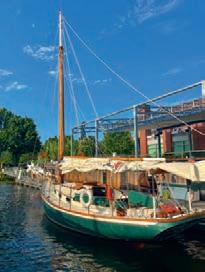

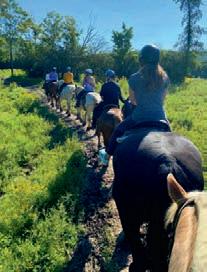


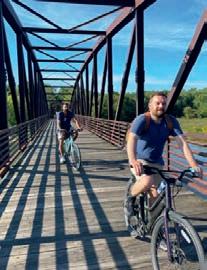
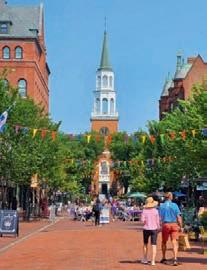
www.wanderlustmagazine.com 25 Vermont, USA
All board! (this page; clockwise from top left) Pedalling across the Winooski River bridge serves up fine views over Delta Park, 22 hectares of floodplain forest, marshy wetlands and sandy shoreline; the Wanderlust team set sail on the Friend Ship; saddling up for a ride with Lajoie Stables; the 5km-long causeway is easily the best bit of the Island Line Trail bike ride, as it feels like you’re almost pedalling on the water; the Wanderlust team head out onto Lake Champlain with the Whistling Man Schooner Co; Vermont is home to over 100 covered bridges – more per square kilometre than anywhere else in the US; gazing out across Lake Champlain; a stroll down Burlington’s Church Street; (left page) the team pose with our latest cover beside the canoeing lake at Sterling Ridge Resort
Wanderlust at large (this page; clockwise from top left) One of many beautiful homes found around Vermont; the Ticonderoga steamboat operated on Lake Champlain until 1953 – now it lies in the grounds of the Shelburne Museum; 70,000 sheets of 23.75-carat gold leaf were used to restore the golden dome of Montpelier State House in 2018; one of the lodges at Sterling Ridge Resort; the gold-tipped Ira Allen Chapel is one of Burlington’s most recognisable sights and was built to hold 1,000 people; canoeing the lake at Sterling Ridge Resort; the clapboard houses of Vermont are a delight; the landscape off Route 101; views over state capital Montpelier; (right page; top–bottom) Vermont produces around 50% of the USA’s maple syrup; our latest cover finds the perfect home
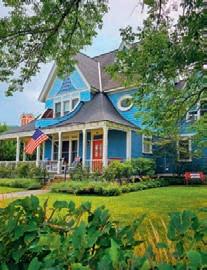

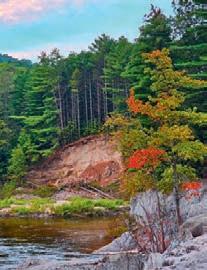
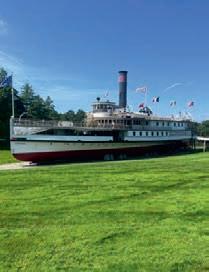

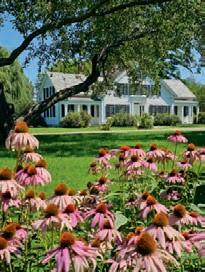

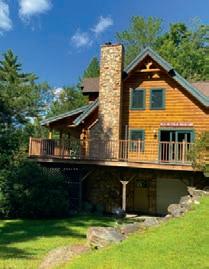

JUST BACK FROM… 26 October/November 2023
the perfect horse-riding backdrop. And so it proved on our experience with Lajoie Stables (lajoiestables.com), where an hour’s ride served up the opportunity to see the state from an entirely different perspective.
We rode Western-style through woodland and meadows, spotting secretive deer and a noisy family of wild turkeys flitting through the grass. One of the horses, Alex, stood a gigantic 20 hands high and was only a few inches shorter than the largest horse ever recorded (23 hands). But don’t worry if you’re an uneasy rider; complete novices will feel safe with these well-trained animals right from the off, leaving you free to concentrate on the scenery from a unique vantage point.
Must see
The Shelburne Museum is home to one of the most significant collections in northern New England, but at times it can seem more like a village than a museum. Its primary focus is on art, design and all things Americana, so it’s an eclectic mix, but each exhibit is separated by a short walk through the vast grounds, which span more than 18 hectares.
The collection was accrued by Electra Havemeyer Webb and her family in the early 20th century.We saw exhibits including miniature circus models, as well as a multitude of wooden animals that had once been part of various carousels but had been collected here in honour of the travelling circuses of America’s past.There was even a lighthouse (in perfect condition) that had originally sat on the shores of Lake Champlain but now found itself within the museum.
We also climbed aboard the Ticonderoga steamboat, a National Historic Landmark that has been restored by the museum and is now the only walking beam side-paddlewheel passenger steamer in existence.Today, the ship showcases what life was like in its heyday, offering a glimpse into the America of 100 years ago. Another of the incredible buildings is the Round Barn, which held a selection of historic horse-drawn carriages and a sled that was several metres long and topped with a velvet seat cover – though it looked more like a church pew on skis.
Lastly, the Shelburne Museum has also launched The Native American Initiative and will eventually add a 40th building, the Perry Center for Native American Art, to its campus.We’ll have to come back in 2026, when it opens, to see it in person.
What’s the capital like?
Vermont’s capital is the pint-sized yet pretty Montpelier, which has all the charms of a relaxed New England town. Lined with friendly coffee shops and teahouses, it’s easy to see its sights on foot.You’d be forgiven for

thinking you were on a purpose-built movie set, such is its prettiness: all the buildings are charmingly angular and as pristine as the streets. Montpelier’s showstopper is theVermont State House, which dates back to 1859. This grandiose Greek Revival building is topped with a glinting golden dome and is surrounded by manicured gardens, all set against a backdrop of dense forest. Inside, there’s an exhibition and mural recounting Vermont’s history that is well worth a visit.
And the food?
Vermont loves its comfort food, as we discovered at the delicious Halvorson’s (halvorsonsupstreetcafe.com) on Church Street in Burlington – we challenge anyone to beat their smoked turkey sandwich and fries. But most of all,Vermont is proud of its array of produce and its farm-to-table philosophy. Local apples, maple syrup (see ‘We wish we’d known’) and plenty more are sold across the state.And as with many parts of the US, craft breweries are enjoying a resurgence here, something we experienced first-hand at The Alchemist (alchemistbeer.com), a brewery in Stowe that has an impressively responsible ethos, thanks to its community work and state-of-the-art wastewater treatment.
Top tip

Most visitors flock toVermont in the winter to enjoy the ski slopes and snow-capped mountains at resorts like Stowe. Autumn is also popular for ‘leaf peeping’, a phenomenon that involves immersion in the forests. But if you want our advice, it’s well worth going during the quieter summer months.Vermont isn’t called the Green Mountain State for nothing; its emerald rises are best seen in the sunshine, and the roads are pleasantly quiet at this time. If you visit during the summer,
you’ll feel like you have the whole of Vermont, including its waterfalls, lakes and mountains, all to yourself.
We wish we’d known…
How important maple syrup is in Vermont.The state produces around half of all the maple syrup that comes out of the US, and this is more than evident when you’re travelling.We drove by roadside shacks selling it by the gallon, and it was a flexible fixture on menus, appearing in lemonades, spritzers and glazed on ham. Our accommodation, Sterling Ridge Resort (sterlingridgeresort.com), even had its own maple sugarworks, and some of our team took a tour to understand the incredible efforts that go into making it.

Cautionary tale
We’d certainly recommend pre-booking a taxi or Uber for when you arrive at Burlington Airport, especially if your flight lands during ‘anti-social’ hours.We struggled to find transport when arriving close to midnight, and locals advised us to pre-book in future. In this ever-growing cashless society, we’d also advise always carrying money, as many of the servers in restaurants, as well as the guides and the people running experiences, depend on tips as a substantial part of their income.
Anything else?
We can think of few places better to pitch up at than Sterling Ridge Resort, a collection of self-catering wood cabins sprinkled throughout hardwood forest and not far from Jeffersonville.You’re left to your own devices to explore, but friendly owners Barb and George are always on hand to help. Make sure you make use of the complimentary kayaks and canoes for a paddle on the lake – it’s a moment of pure serenity.
www.wanderlustmagazine.com 27 Vermont, USA
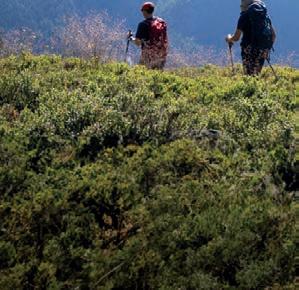
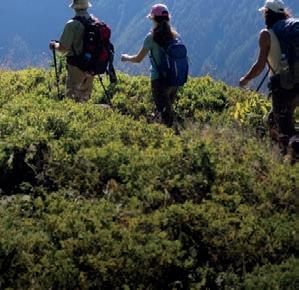





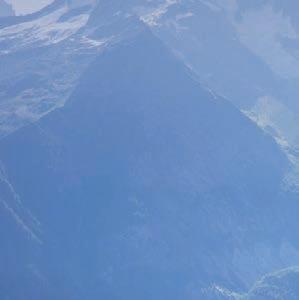
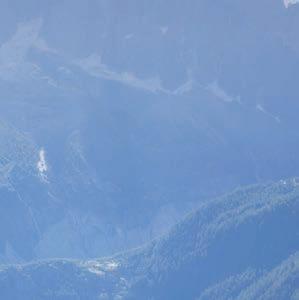

#wanderlustmag
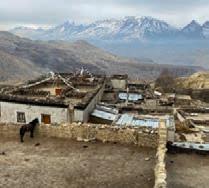
You’ve been sending us images of your latest trips and favourite adventures – tag us at #wanderlustmag on Instagram or email them to us at fromtheroad@wanderlust.co.uk
“Abandoned since 2004, Thuy Tien Waterpark in Hue, Vietnam, has a giant, dragon-shaped building.” Soai

“The view from France’s Aiguillette des Houches (2,280m) as the clouds finally part to show the peak of Mont Blanc.” Martin

“Being surrounded by king penguins, fur seals and elephant seals on South Georgia was breathtaking.” Andrew Heppleston
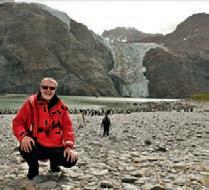
“Skomer Island, Wales, is home to about 20,000 nesting puffins and lots of seabirds. It’s an amazing day out!” Gunilla Roberts

“Watching the sun rise over Morocco, just outside Marrakech, from around 900m up in the air was special.” Chris Brown
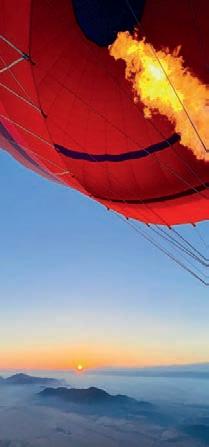
“Mayon Volcano, which is located on the main island of the Philippines, Luzon, is still active and has erupted 52 times over the last 500 years, giving it the almost perfect cone shape that you can see today from a distance.” @Finding_Colin
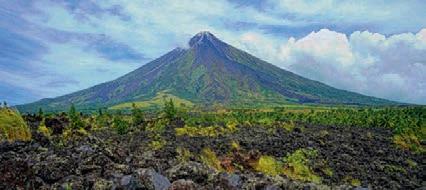
www.wanderlustmagazine.com 29 YOUR PHOTOS
Killey
Pham
“An Upper Mustang hike in Nepal is far quieter than the usual tourist treks, partly due to the permit fee.” John & Alison Sharvill














The latest travel news and stays, plus how to be an ethical photographer, the roots of Nikkei cuisine, celebrating Garifuna culture, and much more… journal

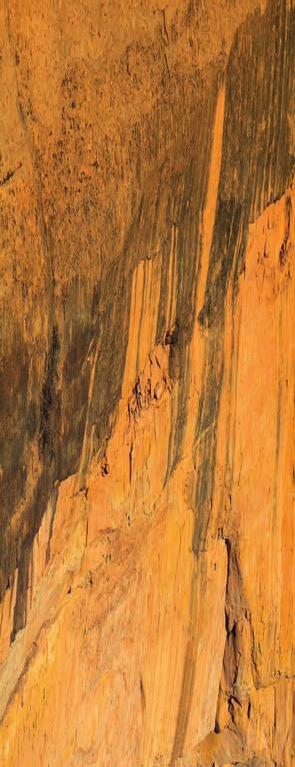
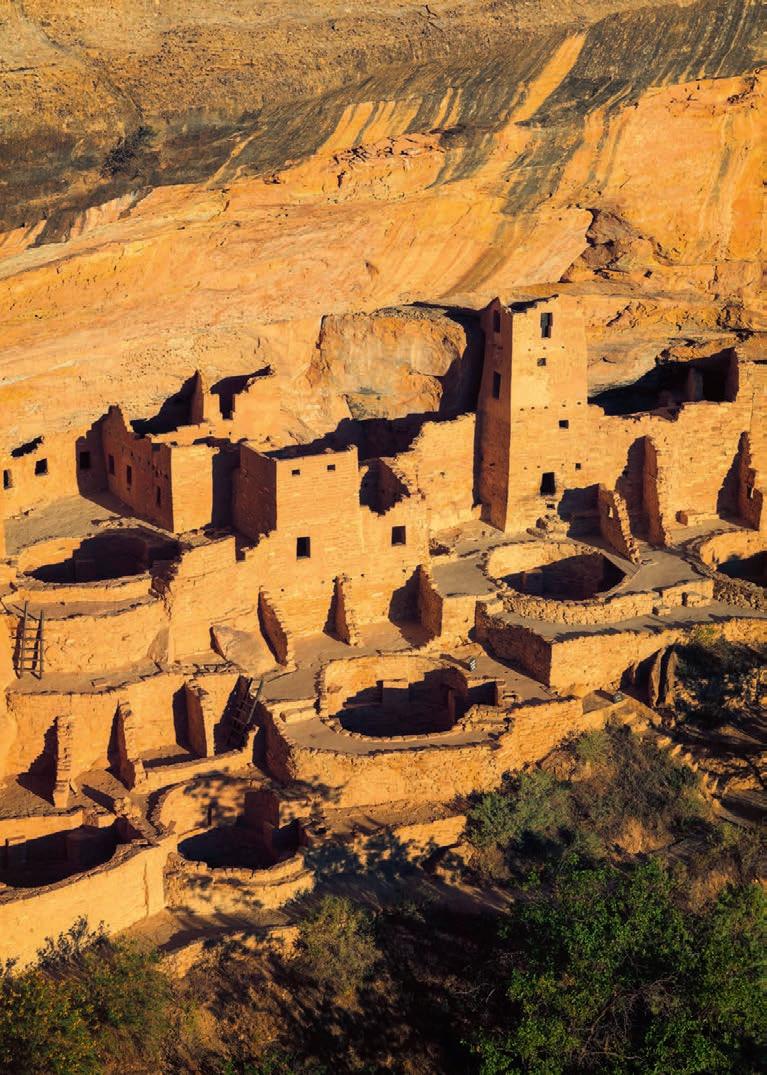
Grapevine 32 Health 37 Armchair Travel 44 Departures: USA & Canada 52 Sustainable Travel 56 World Food: Nikkei Cuisine 58 Dream Sleep: Greece 63 WanderSleeps: Canadian Rockies 66 Dispatches: Belize 74 Dispatches: Mesa Verde NP 84
Alamy Ancient finds The Cliff Palace of Colorado’s Mesa Verde NP is the largest cliff dwelling in North America, and its 150 rooms once held a population of about 100 people. But why it was abandoned is
still open to conjecture; see p84
What’s New
Eastern promise
There’s good news for fans of the golden age of rail. The muchmissed Eastern & Oriental Express restarts in February 2024 with two new routes across Malaysia. The luxury rail journey was suspended in 2020 due to the pandemic, but it returns to the tracks with refreshed interiors and a pair of seasonal threenight journeys, each beginning in Singapore. The ‘Essence of Malaysia’ route (Feb, Nov & Dec) chugs through Kuala Lumpur, Alor Setar and Langkawi, with an overwater detour to Pulau Payar Marine Park. Alternatively, the ‘Wild Malaysia’ trip (Mar–Oct) weaves its way to Merapoh and Taman Negara NP, home to one of the oldest rainforests in the world. belmond.com
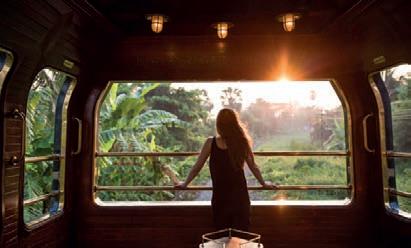
Regenerating the reef
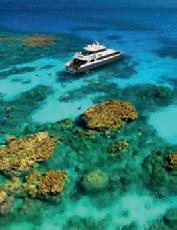
Reef recovery dives, citizen science projects and visits to a coral ‘biobank’ are among the new sustainabilityfocused initiatives that are empowering travellers to help protect Australia’s fragile Great Barrier Reef. You can explore a living ‘coral ark’ at Cairns Aquarium, where the Forever Reef Project is working to maintain biodiversity and has so far preserved 181 out of the reef’s 415 coral species. There are also eco-certified dives with the Cairns-based Tusa Reef Tours; a chance to make and install ‘reef stars’ that aid coral regeneration with Dreamtime Dive & Snorkel; and you can even get involved at home by analysing images captured during a reef census. citizensgbr.org
Cultural Americas
What was formerly the Albright-Knox Art Gallery has reopened after a four-year renovation as the Buffalo AKG Art Museum (pictured). Along with a new extension that has expanded its gallery space, exhibitions include Clyfford Still: A Legacy for Buffalo (until 11 Mar 2024), which features 33 works by the Abstract Expressionist and documents his affection for the area. buffaloakg.org

The cultural contribution of Rhode Island’s Chinese community comes to the fore in a new show at Rosecliff, one of Newport’s historic mansions. The exhibition, The Celestial City: Newport and China (until 11 Feb 2024), has over 100 paintings, sculptures, photos and ceramics on display that depict the influence of Chinese immigrants here from the 18th century through to the Gilded Age. newportmansions.org
Gadsden’s Wharf in Charleston, South Carolina, was the entry point for more than 40% of all enslaved Africans transported to the United States, and this poignant site is now at the heart of the recently opened International African American Museum. It features an African Ancestors Memorial Garden and 12 permanent exhibitions that shed light on Black history, resistance and cultural influence. iaamuseum.org
Celebrate the 40th birthday of hip-hop at an exhibition exploring the impact of the genre on the Canadian capital. Ottawa Art Gallery’s 83 ‘til infinity exhibition (until 18 Feb 2024) charts the music’s development both globally and within the Ottawa-Gatineau region through photos, posters, clothes, vinyl records and turntables. oaggao.ca
⊲
Belmond; Buffalo AKG Art Museum; PhlipVids
32 October/November 2023 GRAPEVINE
All the latest stays, exhibitions, museums and cultural encounters that are fuelling our travels this issue
Walkonthe CANARY ISLANDS’ wildside
EXPLORE LANZAROTE AND LA GRACIOSA

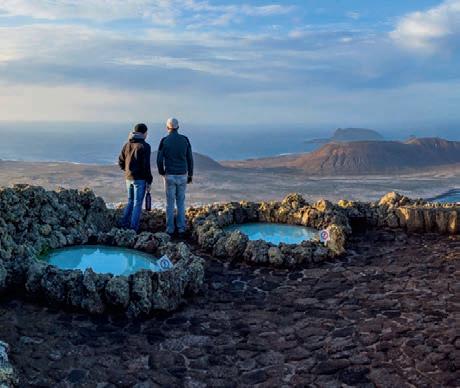
With its rugged volcanic vistas, the landscape of Lanzarote provides a stunning backdrop to a destination that offers far more than just a suntan. From the coastal paths to the dramatic volcano trails, unforgettable walking adventures are rich for discovery in Lanzarote. At Montana Cuervo, the path takes you through an epic opening in the rockface, leading to a centuries-old caldera. Or for those who prefer sand underfoot, the track east of Playa Blanca promises a coastal route that
leads to not one but three heavenly, footprint-free beaches. Venture north and you’ll find La Graciosa, the eighth Canary Island, which lies just 30 minutes from Lanzarote by boat. Here you can embark on a 9km trek that hugs the shoreline or take a 4.5-hour hike to the bone-white sands of Playa de las Conchas. Choose from any of these routes – and more – on Inntravel’s Lanzarote & La Graciosa itinerary
LACE UP ON LA GOMERA
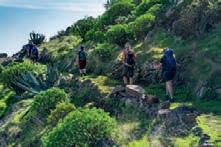
La Gomera has done such an impressive job of staying out of the


Wild walks (clockwise from top left) Reward your weary legs with panoramas like those from Mirador del Río in Lanzarote; hike along La Gomera’s emerald-tinted trails; the Canary Islands are known for their beguiling rock formations; you can spy La Graciosa from Lanzarote’s coastline; walking trails reveal local villages like Hermigua in La Gomera
limelight that those who make the effort to venture there often find it hard to grasp how it’s still such a well-kept secret. This is an ethereal place, peppered with lofty peaks, plummeting ravines, and black and white-sand beaches. Travellers who take on its challenging hikes are rewarded with rugged beauty – especially to the north. Inntravel’s Walking in La Gomera itinerary offers a fantastic way to explore the island’s best paths. Find yourself discovering remote canyons, such as Barranco de Erque, by ambling through the quaint hamlets and villages and gazing across valleys terraced with vineyards and banana plants. You’ll even get up close with an iconic island landmark: Roque Cano. Soaring some 200m high, this rock is lauded not just for its size and dominance, but also for its surroundings, made up of a lush confection of island flora, including junipers and wild olive trees.
ABOUT THE EXPERTS
An Inntravel experience is created by experts who love walking and discovery. With first-hand expertise to share various trail lengths, difficulties and terrains, Inntravel holidays deliver memorable moments, with inspiration from the very first step. Inntravel specialises in self-guided trips that feature beloved hotels and luggage transfers throughout the journey.
PROMOTIONAL FEATURE www.wanderlustmagazine.com 33 For more information, visit: www.inntravel.co.uk/canaries
Lava-scorched vistas, hearty food and wild experiences make for the ultimate Canaries walking holiday. With nearly 40 years’ experience of the islands’ routes, Inntravel can deliver epic ‘wow’ moments
Alamy; Shutterstock; Inntravel
Renoir in Guernsey
A new exhibition celebrates the Impressionist’s brief love affair with the Channel Island
1883
5 WEEKS
A short stay on the island transformed his artistic style forever.
15 PAINTINGS

Renoir painted 15 landscapes, including the bay of Moulin Huet.
6,292KM
Artworks for the exhibition are on loan from as far afield as the Cincinnati Art Museum, USA.


An art trail through the Moulin Huet Valley traces the real-life locations that inspired Renoir.
Guernsey photographer Paul Chambers has captured images of the island using camera technology from the 1880s (AFG Gallery, Old Quarter).
Underwater art
Grenada’s unusual underwater art gallery is getting a boost this autumn with the addition of 31 new sculptures created by local artists. The Underwater Sculpture Park – a series of artworks set below the surface of the Caribbean Sea that also acts as an artificial reef for marine life – will feature new works inspired by the island’s annual carnival Spicemas, as well as local folk characters and other aspects of Grenadian culture. They will be on display at Prickly Bay Marina until October, before being installed in the marine park. puregrenada.com


Viva Italia!
Renoir in Guernsey, 1883 runs from 30 September to 15 December at Guernsey Museum in Candie Gardens, St Peter Port. artforguernsey.com
The beachfront city of Pesaro, set on Italy’s Adriatic coast, is gearing up for its role as Italian Capital of Culture in 2024 with a series of events and art installations throughout next year. The popular seaside resort is the birthplace of opera composer Gioacchino Rossini –who wrote The Barber of Seville and the ‘William Tell Overture’ – and it is already recognised as a UNESCO Creative City of Music. Highlights include Magazzini Rossini, which will put 43 years of costumes and props from the Rossini Opera Festival on display, as well as art residencies, installations along city cycle routes and architecture walks.

Alamy;
K
www.sverrehjornevik.com 34 October/November 2023
Orlando
Romain; Shutterstock; Vestige Collection;
Pierre-Auguste Renoir arrives in Guernsey, which inspired some of his most iconic works. SEPT –DEC
Latest flights
Set your sights on South America as two new direct flights make it easier to reach some of the continent’s most sought-after cities. LATAM has plans to begin a non-stop service from London Heathrow to Peru capital Lima from December, flying five times a week. Meanwhile, Virgin Atlantic will start daily flights from Heathrow to São Paulo, Brazil, from 13 May 2024. There’s good news closer to home, too, as October heralds the start of new British Airways flights to Riga, Cologne and Belgrade from Heathrow, while later in the month sees low-cost links to Cairo begin flying from London Luton with easyJet and WizzAir, plus a new easyJet flight to Akureyri opens up winter trips to northern Iceland from London Gatwick.
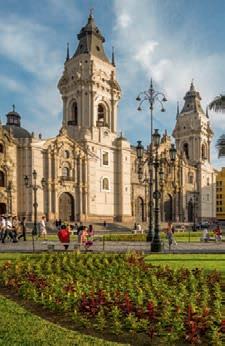
New sleeps
Husband-and-wife team Victor Madera and Maria Obdulia Fernandez are the creative force behind Vestige Son Vell, (pictured), having painstakingly restored this 18th-century manor house in the Menorcan countryside and transformed it into a boutique hotel. Its 34 rooms are split between the main house and the sprawling estate, which is surrounded by olive and citrus groves and has easy access to the adjoining Camí de Cavalls trail. vestigecollection.com

Two historic Munich buildings – the former headquarters of the State Bank of Bavaria and the neighbouring Palais Neuhaus-Preysing manor house – are being given a new, luxurious lease of life as the Rosewood Munich, which opens for bookings on 29 September. Set in the Old Town, with Marienplatz Square just moments away, its marriage of Baroque architecture with plenty of touches of Bavarian culture promises much. rosewoodhotels.com
Living the high life
The Norwegian fjords are famous for their spectacular sea views, but you can now get an even better vantage point thanks to a new via ferrata that takes intrepid travellers up the highest sea cliff in Europe. The climbing route up Mount Hornelen, on the Norwegian island of Bremangerlandet, offers panoramic views from 860m above sea level. Choose from three guided routes taking between three and nine hours, with varying degrees of difficulty. hornelenviaferrata.no

Deliberately designed to blend into a grove of mopane trees, the diminutive Camp Doros invites guests to get back to nature on Namibia’s Onduli Ridge in Damaraland. It has space for just six tents (each with solar power), though it still makes room for a communal sun deck and plunge pool. There are also rangers on hand to guide black rhino tracking adventures. ultimatesafaris.na
The tranquil banks of Kerala’s Ashtamudi Lake make a peaceful setting for The Leela Ashtamudi, A Raviz Hotel, which opened back in August. Its 93 rooms are designed in the Nalukettu style that is common across the area; there is even a traditional houseboat you can board to complete the quintessential Keralan experience. theleela.com
www.wanderlustmagazine.com 35 GRAPEVINE

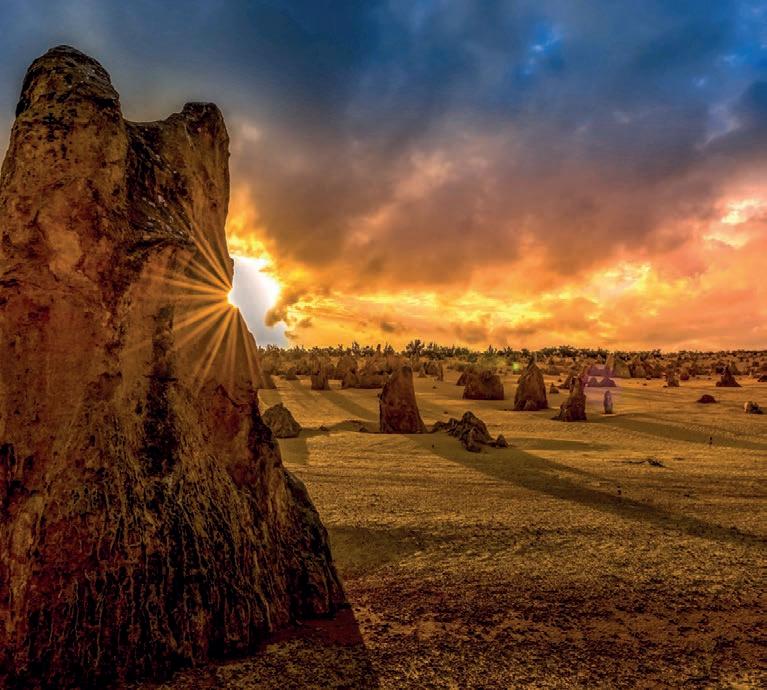
Travelling with diabetes
Managing your diet and medication is no problem if you plan ahead, writes Katie Bareford, senior clinical advisor at
Travelling with diabetes means there are a few more things to think about before you set off, but it shouldn’t be a barrier to having fun. Certainly,if you’re travelling abroad,a little extra planning can go a long way.
If you are going on a long-haul flight, discuss this with your healthcare team first.They will advise you on any adjustments to your insulin injections,insulin pump or medication that may be required if you are crossing time zones. On long flights you may need snacks in between meals and at bedtime to prevent blood sugar levels dropping too low; if you use insulin, monitor your levels frequently and be prepared to change to your dosage.
Insulin pumps and continuous glucose monitoring systems can be damaged if they pass through certain types of screening equipment, such as X-ray machines,whole-body scanners and hand-luggage scanners. Airport security staff should provide people who use medical devices with safe alternatives that will not damage their diabetes technology,and should never insist they go through security equip-
DIABETES IN NUMBERS
More than
5 MILLION people in the UK are living with diabetes
ment that may damage them. Carry a Medical DeviceAwareness Card and a letter from your GP to remind you and airport staff of any screening advice.
If you’re travelling in a hot climate, remember that heat can affect your insulin and stop it from working properly;it can always be kept cool in a hotel fridge or cool bag (provided that it does not freeze). Cloudy insulin damaged by heat may have a brownish colour, and clear insulin may become cloudy – do not use insulin that looks like this.

Insulin can freeze in extreme temperatures but cannot be used if it has been frozen,so make sure it doesn’t come into contact with any ice blocks if using a cool bag. If you’re travelling in the polar regions, keep it in your cabin at room temperature or in an insulated inside pocket to prevent freezing.

It’s important to remember your routines for managing diabetes when you’re abroad. Don’t avoid trying new things, but be aware that eating different foods, becoming more or less active, or drinking alcohol can all make a big difference to your blood sugar levels, so check regularly in order to keep yourself safe.
Staying equipped (top to bottom) Carrying medical equipment can be problematic when going through airport security, as scanning may damage it, so be sure to inform airport staff of your situation; insulin must be kept cool or at room temperature to avoid spoiling
850,000 people in the UK could be living with diabetes but are yet to be diagnosed
Fewer than
1 in 10
An estimated people in the UK with diabetes have type 1 diabetes, where the pancreas produces no insulin
5WAYSTO MANAGE DIABETES WHILEYOUTRAVEL
1 Bring two to three times as much insulin, medication and equipment as you’d usually use, in case you have to stay longer or there are disruptions.
2 Make sure your travel insurance policy covers pre-existing medical conditions such as diabetes, as many don’t, and ensure that you are covered for any emergency medical costs arising from this.
3
It’s important to keep insulin in your hand luggage in case your luggage is lost, and because the hold is so cold that it may be damaged.
4 Airlines can provide details on the timings of meals so you can plan your insulin. Standard meals may not supply enough carbohydrates if you are on insulin or certain diabetes tablets, but cabin crew can often give you additional fruit, crackers or rolls.
5 Bring a doctor’s letter stating you have diabetes and that you need to carry medical supplies. This is often requested by airlines/operators. Also take a copy of a recent prescription in case you need supplies while away.
All content is for informational purposes only and does not constitute medical advice, treatment or diagnosis. Consult a healthcare professional before taking action; images: Alamy; Shutterstock
Diabetes UK
www.wanderlustmagazine.com 37 HEALTH
Back to nature in
Gran Canaria
Soak up this sun-swathed island’s natural landscapes
You’ll likely know Gran Canaria for its golden sands, sea and year-round balmy temperatures. But should you step away from its urban centres and cosmopolitan capital, you’ll find a host of natural wonders to explore.
Whether you’re an active traveller looking to wander among verdant pine forests and hike unique nature reserves, or want to investigate mystical volcanic landscapes, or
Island life at a slower pace (this page; clockwise from top left) Gran Canaria’s breathtaking Summit has been declared a World Heritage Site and UNESCO Biosphere Reserve; the dazzling natural pools of Caletón de los Cangrejos beach; the naturally formed low-lying sea of clouds in the north means that the island’s higher altitudes are great for stargazing
just desire to get away from it all by soaking up Atlantic views from a natural swimming pool, Gran Canaria has you covered. The island is like a giant, open-air playground that’s been forged by fire, wind and water over millions of years, and increasingly people wish to venture away from its coastal resorts to explore the many wonders.
Here are five special places that will show you an authentic side to life on the island, and prove that nature is Gran Canaria’s greatest attraction.


REFRESHING ROCK POOLS
While most visitors head straight to the sandy shores in the south of Gran Canaria, the northern coast has incredible natural swimming pools. Formed from volcanic rock over millions of years, these dipping ponds are a great way to cool off and experience relaxed Atlantic sea bathing when the temperatures soar.

It’s a good idea to plan your visit, as some of the pools only appear when the tide goes out. Los Charcones, for example, is one of the largest, and its clean water means that it has even acquired Blue Flag status; however, there are plenty of others to choose from. In the coastal neighbourhood of Moya – the town famous for its crunchy biscuits – lies El Altillo, another large pool with easy access. You can also find smaller examples close to Gáldar, including Emiliano and El Agujero. While most of these pools are shallow, families should consider Dos Roques, which is backed by a sandy beach.
MULTICOLOURED MOUNTAINS
Gran Canaria emerged from the ocean floor about 15 million years
38 October/November 2023
ago, but its undulating landscape has been evolving over millennia, resulting in a unique blend of rocks, ravines and riscos (crags).
Head down the twisting mountain road from La Aldea de San Nicolás to Mogán in the west and you’ll witness a geological spectacle. Known locally as Los Azulejos (the tiles), the rocks here display a natural rainbow of jade, ochre, terracotta, pink, teal and red. At first glance, they look almost painted on, but centuries of erosion have exposed a vibrant display of colour. From here you can explore the Inagua Natural Park and nature reserve, which is awash with Canarian pine trees as well as endemic flora and fauna, such as the elusive Gran Canaria blue chaffinch.
STAR-STUDDED SKIES
The original pre-Hispanic inhabitants of the island had a deep connection with the earth and heavens. This relationship with the night sky is still cultivated through the island’s various protected areas.
As a Biosphere Reserve and dedicated Starlight Destination, Gran Canaria has exceptionally clear skies for stargazing. A weather phenomenon known as the Panza de Burro (Donkey’s Belly) also means that cloud is kept below the peaks of the mountains in a sort of blanket, trapping light pollution underneath. Consequently, those who head up to high altitude will be afforded stellar views – quite literally.
If you fancy learning more, be sure to visit the Observatorio Astronómico de Temisas, which offers a range of classes and workshops, or alternatively, book onto a five-hour astronomy tour with AstroGC.
COASTAL CLIFFTOPS
The west of Gran Canaria has always been more rugged and
underdeveloped than the rest of the island, and its landscape remains wonderfully untouched, providing some of the most uninterrupted views of the natural environment in the Canarian archipelago.
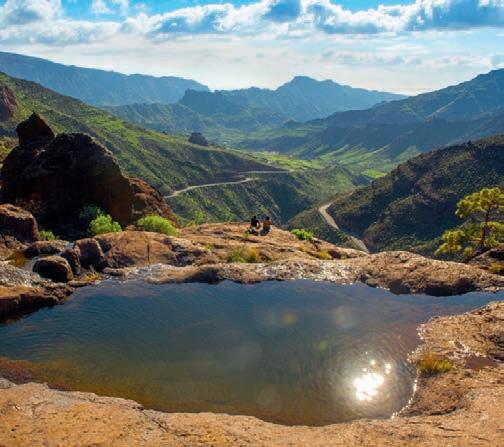
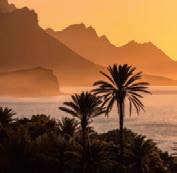
Take the winding road to La Aldea de San Nicolás and stop at the Mirador del Paso de Marinero (aka Mirador del Balcón). There’s a viewing platform here that offers mesmerising views of the coastal rocks, vertiginous cliffs and Atlantic horizon. To your left, you’ll also see a series of peaked rock formations; legend has it that this is the ridged tail of a sleeping dragon.
The coast here is part of the Tamadaba Natural Park that covers
Natural wonders take centre stage (this page; clockwise from top left) The Dragon’s Tail is a geological formation on Gran Canaria’s west coast; Los Azulejos is known for its colourful rocks; Gran Canaria’s Wine Route is the only officially certified one in the Canary Islands
7,500 hectares from the sea to the highlands inland and is well worth exploring on foot.
VINEYARD VIEWS
You can grow pretty much anything in the fertile soils of Gran Canaria, from avocados to coffee, but one of the island’s most historically successful cultivated plants is the grapevine. And where there are grapes, there is wine.
If you need yet another excuse to explore the island, you’re in luck. Thanks to a new wine route (Ruta del Vino), you can plan various days of visits to vineyards, bodegas, restaurants and wine bars, learning about local grape varieties such as Negramoll and Listán Negro. If you want vistas with your vino, try Bodegas Bentayga, up in the mountains, where you can sip on Agala wine as you drink in the views. Alternatively, head to Bodega San Juan, one of the oldest wine producers on the island.

PROMOTIONAL FEATURE www.wanderlustmagazine.com 39 For more information, visit grancanaria.com
Beny Aguiar; Jesus de Leon; Marcos Cabrer; Rguez Fajardo; Nacho Gonzalez Oramas; Turismo Gran Canaria





* See full terms and conditions at https://shop.wanderlust.co.uk AUTUMN SPECIAL OFFER! FOR JUST £45 £28!* TRAVEL FURTHER Oneyearof travelinspiration, whichincludes… Sixcollectable doubleissues 1,200+ pages of travel ideas delivered to your door Fulldigitalaccess Read the magazine online and on the go Members-only webpage Access all past editions since 2010 £50travelvoucher! Use with some of the best tour operators Exclusive members-only… Events, competitions, prizes and workshops Subscribe to the Wanderlust Club and get a FREE COPY of our Incredible Travel Stories From Around the World bookazine To redeem, visit our shop onwww.wanderlust.co.uk or call 01371853641and use the code Autumn23 Hurry while stocks last! 30 Years Of Taking The Road Less Travelled O JOURNEYS AncientMenorcaFirst-time Antarctica Hawaiiescapes Theultimateguide















MADRID after See sunset
From quaint, cobbled streets lined with independent boutiques to world-class museums, monuments and galleries, Madrid has long been a hub for art, history and culture; however, it’s not only during daylight hours that the Spanish capital shines.
Stay for sunset and you’ll see another side to this vibrant city, as locals gather on sun-dappled terraces, mixologists work their magic at underground speakeasies and live musicians entertain the crowds, keeping the fiesta going from dusk till dawn.
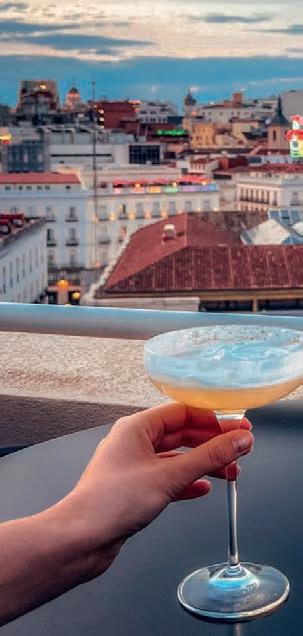
EAT LIKE A LOCAL
At the heart of the city is its evergrowing culinary scene: an eclectic mix of casual tapas bars, colourful markets, historic cafés and cutting-edge restaurants, many of them boasting Michelin stars. Among the most legendary is Bótin, an atmospheric casa that opened in 1725 and lays claim to being the world’s oldest
restaurant, serving local classics such as cochinillo asado (roast suckling pig) amid rustic, heritage-filled interiors.
For traditional tapas, it’s worth paying a visit to the trendy Justicia neighbourhood for Celso y Manolo –try the jamón ibérico and slow-cooked octopus – while La Galería, in the lively El Retiro district, has regular DJs to liven up the evening. But if you’re after something more casual, head for one of the city’s markets. The 100-year-old Mercado de San Miguel is unmissable, and is filled with artisanal bakery stalls, gourmet cheeses, seafood and freshly prepared tapas.
Those after a gourmet experience won’t be short-changed, either; the city is home to 23 Michelin-starred restaurants, a collection crowned by the three-starred DiverXO. Ranked third in this year’s World’s 50 Best Restaurants list, this renowned spot puts creativity at the forefront, with theatrical dishes (described as “canvases”) served as part of an intimate 12-course tasting menu.
Elsewhere, the two-Michelin-starred DSTAgE fuses Japanese, Mexican and Spanish cuisine to intriguing effect, while Paco Roncero serves experimental Spanish dishes on the top floor of the elegant, 19th-century Casino de Madrid building.
PREPARE TO BE ENTERTAINED
Madrid’s restaurants aren’t just about the food. Many double up as live music venues, and there’s a vibrant flamenco scene focused around the historic centre and La Latina, the city’s oldest neighbourhood.
Among the standouts is Corral de la Morería, one of the most venerable flamenco tablaos in Madrid and the only one in the world to boast a Michelin-starred restaurant. Everyone from Rita Hayworth and Hugh Grant to Salvador Dalí and John F. Kennedy have graced its floors, with

42 October/November 2023
It’s going to be a late one! Madrid is the real city that never sleeps, and is as vibrant by night as it is during the day…
some of Spain’s best-known flamenco dancers, guitarists and singers also having performed there over the years.

Equally unmissable is Flamenco 1911, which originally opened as a restaurant on the site of a former chocolate factory and has long been the city’s go-to flamenco venue (its guests include Ernest Hemingway, Ava Gardner and King Alfonso XIII). Other popular spots include Cardamomo; Flamenco de Leones, which opened last year; and Tablao de la Villa, housed in a 19th-century mansion.
Madrid’s live music scene isn’t limited to flamenco; everything from indie to jazz is found here, all centred on a mix of small bars and bigger-name rock venues such as El Sol, which was founded in the 1970s during Madrid’s hedonistic ‘movida’ movement.
Just as iconic is Café la Palma, a sprawling venue in the bohemian
Malasaña neighbourhood that ships in famous Spanish rock artists and DJs. There is also Café Central, a jazz hotspot since the 1980s that has played host to icons including Lou Bennett and George Adams.
RAISE A GLASS
There’s plenty more to Madrid’s nightlife than its busy live music scene. Cocktail bars scatter the lively Barrio


Raise a toast (clockwise from far left) See flamenco at its very best at Corral de la Morería; rooftop bars are among the finest places to soak up citywide views of Madrid; seeing the city after dark lets you mingle with the buzzing local life; Barrio de La Latina is one of Madrid’s nicest neighbourhoods for tapas and bar-hopping
de Las Letras, including Salmon Guru, a retro-styled haunt that was ranked 15th on the World’s 50 Best Bars 2022 list. Over on the famous Gran Vía street, you’ll also find Museo Chicote, which was the first cocktail bar in the city when it opened in 1931 and was once frequented by the likes of Grace Kelly and Frank Sinatra.
If you want to work a little harder for your drinks, head to one of the city’s growing clutch of speakeasies. Inspired by 1920s Paris and strewn with plush red velvet, Le Speakeasy opened earlier this year in the basement of Robuchon Madrid in the exclusive Salamanca neighbourhood. Close by, El Coleccionista sits hidden away in the colourful BiBo restaurant, offering artsy, experimental cocktails amid antique-filled surroundings.
If you’d rather stay outside and make the most of Madrid’s mild evenings, amble up to one of its slew of rooftop bars. Gran Vía is home to several, including El Cielo de Chicote at the top of Hotel Montera Madrid, a historic bar dating back to 1931. Today it’s still a prime draw for Madrileños at sunset with its Balinese beds, outdoor tables and 360-degree views over the twinkling city skyline.
Further along Gran Vía you’ll also find the street’s crowning glory: Azotea del Círculo, set atop the Círculo de Bellas Artes cultural centre. Pull up a stool to watch the sky turn a peachy pink at sunset and get a bird’s-eye view of the city that never seems to sleep. It’s Madrid at its very best.
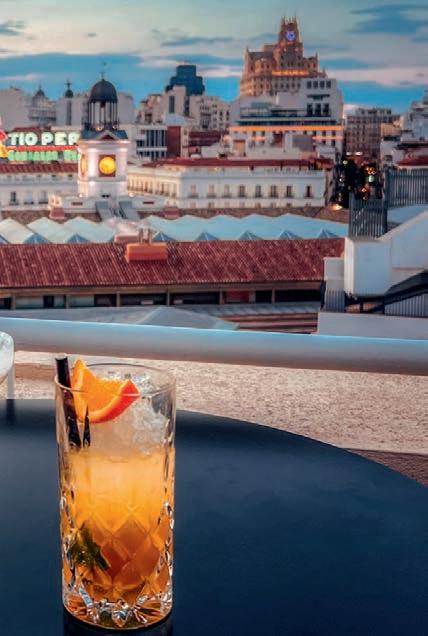
PROMOTIONAL FEATURE www.wanderlustmagazine.com 43 For more information, visit: www.esmadrid.com/en
Madrid Destino; Paco Manzano
Travelling with purpose
n any scorecard, nature is losing.” It’s hard to argue with Kris Tompkins on this one, although after watching the indefatigable star of new documentary Wild Life (Disney+), you’ll be reluctant to disagree with her on anything. She and her husband, the late Doug Tompkins – co-founder of the North Face and Esprit brands – were behind the conservation project to buy over a million hectares of raw Chilean wilderness before gifting it back to the country in the shape of the Pumalín DouglasTompkins National Park, among other eco-projects.
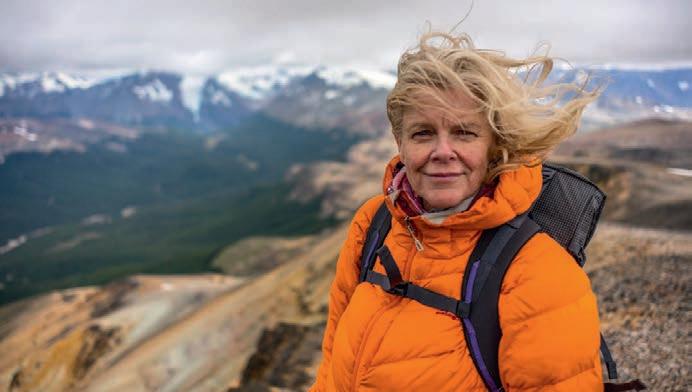
The film intercuts the Tompkins’ plan – complete with shots of that remarkable terrain – with both the story of their entrepreneurial decades and Kris’ trek to Pumalín’s highest point in her search for closure following Doug’s tragic passing.The film is a suitably epic tribute to the massive lives at the centre of an impossibly big dream.
Climate change is at the heart of a host of new series, with Levison Wood: Walking With… (Channel 4) perhaps being the best of the rest. It follows the explorer in tracking environment-threatened species such as Namibia’s desert lions, the orangutans of Borneo and East Greenland’s polar bears. Along the way he visits locals to gain insights into their relationship with these animals and the often-hostile land.
BBC iPlayer is also hosting two intriguing looks at conservation.The second season of Barra’s Return of theWild takes

us across Europe – Rome, Grenada, Romania – to scrutinise the efforts being made to protect and rewild nature. Saving Venice, on the other hand, meets the engineers that could rescue a city literally sinking under the weight of its history.
If you’d prefer a more old-fashioned travelogue, Joanna Lumley’s SpiceTrail Adventure (ITVX) sees the actor journey through the trading hotspots of Indonesia, India, Madagascar, Jordan and Zanzibar. Meanwhile, Jane McDonald:Lost in Japan (My5) follows the boisterous cruise singer as she joyfully karaokes her way through reliably curious corners of Japanese culture.There’s also a big cheer as Celebrity Race Across theWorld (BBC iPlayer) returns for its second instalment, with its cosy cast list of old pop stars andTV presenters all set to sweet-talk their way from Africa to the Arctic.
Lastly, the BBC’s new natural history big hitter is focused on climate change of a historical nature. The spectacularly produced, relentlessly interesting Earth (iPlayer) tells the story of the creation of the planet as we know it, kicking off the series with a pre-dinosaur global-warming event that hits rather too close to the bone.
“Extinction,” proffers host Chris Packham, “is a vital part of evolution.” It’s not a massively comforting thought.


The great giveaway (top–bottom) Wild Life tells the story of Kris Tompkins and the greatest private conservation project in history; Chris Packham glimpses into the future by looking at the story of our planet in Earth

ARMCHAIR TRAVEL
“How did it come to this?” ask a stampede of new TV travel shows that delve not only into the world’s hidden corners, but look at what is being done to protect them (and their inhabitants) from the sins of the past
“O
44 October/November 2023
Read this!
Fuel your literary passions this issue, as the experts at Stanfords crack the spines on the latest top travel reads…



A History of the World in 500 Maps

Christian Grataloup Thames & Hudson; £35 Stanfords Book of the Month for September 2023



This remarkable read traces life on our planet through the prism of old maps. It uses them to chart historical trends ranging from the dispersal of humankind to the spread of colonialism in the 18th century, allowing its author to zero in on unique moments in time, such as the invention of farming or the Industrial Revolution.
Windswept
AnnieWorsley
William Collins; £17
Annie trades academia for life in a remote Scottish croft, finding plenty of narrative heft in her return to a simpler existence – laying quartz stones in the river to reflect the moonlight and attract salmon, waking to the husky call of duelling stags.
LISTEN HERE!
Along the way she ponders the history of a land where the past is etched into valleys carved by glaciers, elevating her prose to more than just an elegy for a quieter time.
Walking the Bones of Britain
Christopher Somerville Doubleday; £25
Inspired by a map in his tattered Philip’s Modern School Atlas showing the rough geology of the UK, the author (better known as the walking correspondent for The Times) sets off on a thoughtful 1,600km hike that delves into the rocks beneath the British countryside and how they changed life on this tiny isle.
Great-Uncle Harry
Michael Palin
Hutchinson Heinemann; £22
A new book by the ever-entertaining Palin is always cause for celebration. His latest merges his Ripping
The autumn series of our Wanderlust: Off the Page podcast has landed.
Inspirational episodes include ‘California Road Trips’, ‘Azerbaijan: Where East Meets West’, ‘Experiencing Alberta’s Indigenous Cultures’ and ‘Why You Should Visit the Azores’. We’re also fans of History’s Greatest Cities, presented by longtime Wanderlust contributor Paul Bloomfield, who teams up with expert guides to delve into the story of great European cities.
Readers get 10% off by using the code ‘Wandering’ on the Stanfords website: www.stanfords.co.uk. Wanderlust members can get 25% off – see p162

Yarns past and travelogue present in a biography that follows a little-known relative from quiet, rural England to India, New Zealand and the battlefields of Europe. Inspired by a collection of old family photos and diaries, he pieces together the travels of his heretofore anonymous great-uncle to reveal the life of an ordinary man who lived an extraordinary existence.
Dublin: Like a Local Éadaoin Fitzmaurice & Nicola Brady
DK Eyewitness; £13
If you want to explore a side to Dublin beyond Temple Bar and Trinity College, DK’s ‘Like a Local’ series is a neat way to discover the things typically shunted out of guidebooks to make room for the bigger sights. From secret basement dens holding after-hours poetry slams to kayaking the River Liffey, this is more about experiences than bucket lists.
Run: Races and Trails
Around the World
DK Eyewitness; £25

A useful guide to the world’s best races and routes, including a mix of off-the-beaten-path trails and park runs. It’s not an everyday read, but this handpicked list of the world’s 100 finest runs might just serve as inspiration for an adventure that you never anticipated.
Abroad in Japan
Chris Broad
Bantam; £17
Following in the steps of countless hapless Brits, TEFL teacher-turnedYouTuber Broad first arrived in Japan at a rural village high in the north. This book, like his channel, seeks to unravel a culture that can often seem distant to visitors, charting his life over ten years and countless quirky anecdotes, from cat-café allergies to getting evicted from a love hotel.
Words by Tom Hawker; images: © Jimmy Chin/Disney+; BBC/BBC Studios; Alamy
IN ASSOCIATION WITH www.wanderlustmagazine.com 45 JOURNAL Travel From Home
Explore UNESCO-Protected

GERMANY
With an astounding number of UNESCO World Heritage Sites, Germany is the perfect place to go slow and tune into cultural heritage. Discover the right UNESCO experience for you…
Words Summer Rylander

Welcome to Germany, where 51 UNESCO World Heritage sites scatter a land that is rarely short of historical high points. Each site offers unique insights into the country’s past and culture, and amid all the diverse landscapes, remarkable monuments and environmentally friendly travel options, it’s easy to customise a cultural tour that takes in vastly different sides of the country. Whether you’re fascinated by industry, passionate about design or delighted by castles, there’s a heritage travel route for you. Or if you prefer to connect with nature, you’ll have plenty of time to unwind and enjoy the UNESCO-listed elements found within Germany’s national parks, nature reserves and lustrous gardens.
Embracing slow, mindful travel is a major part of any trip here, and the options for exploring by train, bicycle or even on foot are myriad. Travelling with purpose allows all of us to better understand local cultures; to establish a sense of place and connect the dots between curiosity and comprehension. So, why not head out
on a UNESCO-inspired journey and discover a different side to Germany?
CASTLES AND PALACES
From countryside castles to citycentre fortifications, Germany is home to some of Europe’s most impressive UNESCO-listed cultural treasures. Admirers of art and architecture should begin in North Rhine-Westphalia, where the small town of Brühl – 20km from Cologne –is home to a grand display of German Rococo design.
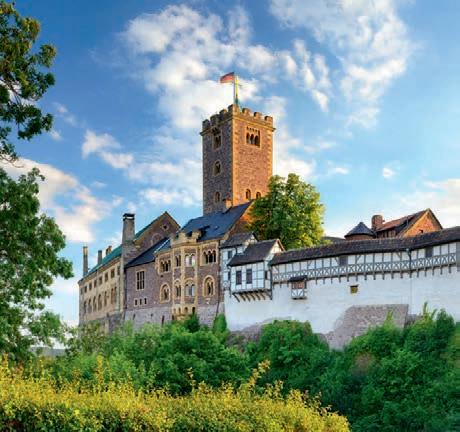
The 18th-century Augustusburg Palace took 40 years to complete, and it’s still one of the country’s finest buildings. Take your time over the ornate staircase and filigree frescoes before strolling through the gardens to reach Falkenlust Hunting Lodge, the former falconry base and private retreat of Prince Clemens August. It’s clear from the well-preserved rooms that no expense was spared on this lodge; even the composer Mozart was impressed during his 1763 visit, and it’s no wonder that these properties have been on the UNESCO World Heritage List since 1984.
If this has given you a taste for grand designs, head to Potsdam,

where you could easily spend several days exploring 150 buildings and 500 hectares of magical parkland. This UNESCO-listed ensemble is where Prussian royalty once came to enjoy the perks of power in their 17 palaces, including the Orangery Palace (inspired by Rome’s Villa Medici), the Neo-Gothic Babelsberg Palace and Sanssouci Palace, a favoured summer retreat of Frederick the Great.
On a hilltop overlooking the medieval town of Eisenach, Wartburg Castle traces a history of nearly 1,000 years. Perhaps most notably, this was where Martin Luther translated the New Testament in just 11 weeks; however, it’s Wartburg’s impressive construction and seamless integration into its forested surroundings that earned UNESCO’s commendation as ‘the ideal castle’.
Fit for a king (clockwise from left page) The Würzburg Residence is a Baroque beauty with almost 400 rooms to peruse; admire Wartburg Castle, which overlooks the medieval town of Eisenach; learn about Le Corbusier’s vision for modern living at the Weissenhof Museum in Stuttgart
Further south, the Würzburg Residence is widely regarded as Germany’s most remarkable Baroque palace, and it has been on the Heritage List since 1981. Nearly 400 rooms and perfectly manicured court gardens will keep you busy, though art aficionados will want to factor in extra time to admire the largest ceiling fresco in the world, which is unmissable from the grand staircase.
ARCHITECTURE AND DESIGN
If you’re inspired by design, Germany is the perfect destination to tap into your creativity. Plan your UNESCO experience around impactful architecture and learn about how the Bauhaus movement revolutionised what it means for a building to be climate-friendly, accessible and headturning. Then, take a closer look at theories on how our homes should best serve us, and discover what we can still learn from an artists’ colony that was established in 1897.
PROMOTIONAL FEATURE For more information, head to the official Germany Travel website: www.germany.travel/en
Alamy; ©GNTB / Francesco Carovillano; Alamy
⊲
Both functional and striking, Bauhaus buildings are characterised by geometric shapes and prominent glass surfaces. This less-is-more simplicity is readily conveyed at the Bauhaus sites in Weimar, Dessau and Bernau, where the design form was honed throughout the 1920s and ’30s. UNESCO recognised a key collection of Bauhaus buildings in 1996, and travellers can gain insights from museums and exhibitions throughout the region.
In Stuttgart, the work of SwissFrench architect Le Corbusier (aka Charles-Édouard Jeanneret) takes centre stage at the Weissenhof Museum, where he worked alongside his cousin, Pierre Jeanneret, in 1927 to design housing that redefined the concept of modern German architecture. Here you’ll find a unique exhibition that captures Le Corbusier’s ethos, which states that a home is a machine for living and so should serve us efficiently and intuitively. Today, the building and its neighbouring dwelling comprise part of a UNESCO-listed housing estate where past and future still collide.
Germany’s capital city is a mustsee no matter your passions, but travellers who prioritise architecture will especially want to seek out the Berlin Modernism Housing Estates. Its six UNESCO-recognised estates represent the pinnacle of residential architecture in 1920s Berlin, where abundant air, light and green spaces were promised to tenants to boost their quality of life.
Finish your exploration of German design in the small city of Darmstadt, near Frankfurt. It was here, above the main town, that an early artist’s colony, Mathildenhöhe Darmstadt, emerged and gave birth to a range of
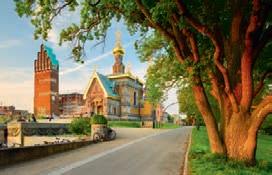
experimental architecture. A recent addition to the UNESCO World Heritage list, this unusual collection consists of 23 elements, including a 50m-high tower, a grove of plane trees, a finely decorated Russian chapel, a garden pergola and much more.
INDUSTRIAL HERITAGE
Germany’s robust industrial past continues to shape the country today. From natural resource management to a one-of-a-kind smelting factory, travellers with a keen interest in innovation will enjoy getting off the beaten track to explore the country’s lesser-known Heritage Sites.

Centuries of mining history are documented in the pits of Rammelsberg, which sit just outside the historic, half-timbered town of Goslar. Once the world’s largest repository of zinc, copper and lead, these mines were powered by water that was controlled at the Upper Harz Water Management System: a sophisticated network of dams, reservoirs, ponds and trenches. Today, the area is fantastic for hiking, making it easy to combine a historical experience with nature.
Form and function (this page, top to bottom) The Völklingen Ironworks was the first industrial monument to gain UNESCO World Heritage status; Mathildenhöhe Darmstadt was an early artist’s colony that today features on the UNESCO World Heritage list
Another eco-friendly way to experience Germany’s mining heritage is to take a guided hike through the Erzgebirge mining region. Set in the Ore Mountains, near the border with the Czech Republic, the Erzgebirge region features lush meadows and dense forests that make it easy to see why the area was once referred to as Miriquidi – a medieval term for a dark forest. Because of the Erzgebirge’s significance in technological and scientific innovations, UNESCO has designated this mining region as one of significant cultural heritage.
On the border with France, the Völklingen Ironworks offers a different view of industrial Germany. These are the only remaining smelting works of the so-called golden age of the steel industry. Having thrived throughout the 19th and 20th centuries, the plant remains fully intact and is celebrating its 150th anniversary in 2023. No other ironworks across Europe or North America are this complete, and a guided tour is a treat for history buffs.
In the North Rhine-Westphalia city of Essen, the Zollverein Coal Mine Industrial Complex is a jewel of European industrial heritage. This UNESCO site features complete
48 October/November 2023 PROMOTIONAL FEATURE
©Lookphotos/Günther Bayerl; ©GNTB/Francesco Carovillano; ©Verkehrsverein Reichenau e. V./Helmuth Scham; ©GNTB/Udo Bernhart; ©GNTB Bettina Dittmann Fotodesign; ©Lookphotos/Travel Collection
installations of a working coal mine, including pits, railway lines and miners’ housing, yet its architecture is perhaps the most striking element. The buildings here are fine examples of Modernist design, translating the form and function of Bauhaus for the industrial era.
CHURCHES AND ABBEYS
Germany’s strong religious history is intrinsically linked to its culture –monks perfected German beer, after all – and its UNESCO-listed churches are more than just places of worship. Throughout the country are soaring cathedrals and intriguing abbeys that have awed visitors for centuries.

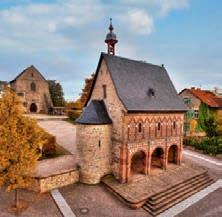
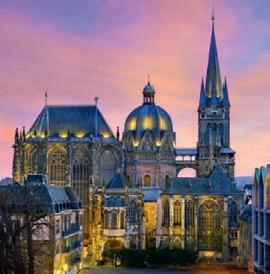
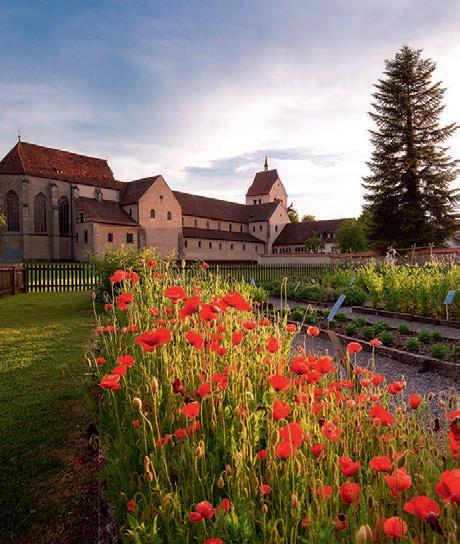
The Aachen Cathedral was Germany’s very first UNESCO World Heritage site, and it’s easy to see why. This distinguished sanctuary in North Rhine-Westphalia was built as early as 790 AD, and although it stands at a modest 32m in height, it has witnessed the crowning of 30 kings and still serves as the resting place of Emperor Charlemagne, who was buried here in 814. The cathedral is certainly the main landmark of Aachen, but be sure to
explore the rest of the city and enjoy its celebrated shopping scene, which is committed to selling Fair Trade goods. Also in North Rhine-Westphalia is the striking Cologne Cathedral, recognisable for its Gothic architecture. It towers 157m above Cologne and briefly held the title of world’s tallest building when its construction was completed in 1880. Its height is most
Moments of reflection (this page; clockwise from top left) The monastery on Reichenau Island; Cologne’s Gothic Cathedral; Lorsch Abbey; Aachen Cathedral was Germany’s first ever UNESCO site
easily appreciated from the south tower, which you can access via a staircase of 533 steps.
Alternatively, Lorsch Abbey offers a different perspective (literally) on Germany’s religious past, given its King’s Hall is the last remaining building that is still visible above ground. However, it does contain the excellent archaeological remains of a Carolingian-constructed complex that is thought to have been built in the mid-9th century. It’s also a special area for biodiversity, and part of the site is operated by the Lauresham open-air laboratory.
Finish on the Monastic Island of Reichenau, which is located in beautiful Lake Constance. The star here is its Benedictine monastery, which is said to have been founded in 724. Visitors today can explore its trio of Romanesque churches, whose medieval monastic architecture hides detailed wall paintings that are still visible across all three sites. The island also still has a strong market culture, and both grows and sells produce from gardens that have been cultivated for centuries.
For more information, head to the official Germany Travel website: www.germany.travel/en
⊲
HISTORIC TOWNS
From traditional villages to bustling cities, it could be argued that Germany’s lengthy history means that all of its towns are historic in one way or another. Some, however, do stand out, and their celebrated landmarks, sites and contribution to local culture make exploring here a delight.
In Bavaria’s Upper Franconia region, UNESCO-listed Bamberg Old Town is a can’t-miss destination for travellers seeking classic German charm. Halftimbered houses line the hilly streets leading up to Altenburg Castle and its gardens, which reward visitors with magnificent views over the city and the surrounding countryside. Famously, Bamberg’s old town hall perches atop the Regnitz river, carefully balanced on an artificial island between two bridges.
Just north of the Harz mountains lies Quedlinburg, one of Germany’s most extensive and best-preserved examples of a medieval town. Its 1,300 timber-framed buildings were built across six centuries, and just wandering the Old Town is like strolling through time. Together with the city’s Collegiate Church and Castle, it has been on the UNESCO Heritage List, since 1994. You’ll definitely want to have your camera for this one!
Elsewhere, Hamburg has long been an important trading port, and while it’s still one of Germany’s
Standing the test of time (this page, top to bottom) Quedlinburg’s Old Town is one of Germany’s best-preserved examples of a medieval centre; Germany’s Beech Forests will bring you closer to ancient history
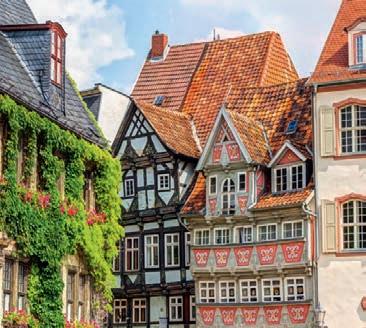
most modern metropolises, the Speicherstadt and Kontorhaus districts are scenic reminders of the city’s maritime heritage. Characterised by spacious canals, Speicherstadt is touted as the world’s largest contiguous warehouse complex and is best toured aboard a historic barge. Kontorhaus, meanwhile, is where you’ll find Hamburg’s architectural highlights, including the Chilehaus, recognisable from its ship’s prowinspired construction.
While you’re in Germany’s north, be sure to take in the historic centres of Stralsund and Wismar. Like Hamburg, these cities were prominent during the 400 years of the Hanseatic League (a medieval federation of
merchant guilds and market towns), and their architecture and layout is nearly unchanged. You’ll find halftimbered houses and fine examples of Gothic brickwork throughout both cities, but be sure to make time in Stralsund to visit the German Maritime Museum. This comprehensive exhibition centre has four different components and features a variety of exhibitions and scientific findings.
GARDENS AND NATURE
UNESCO-inspired travel doesn’t have to mean sticking to monuments and urban areas. Germany’s alluring natural landscapes offer quiet respite from the city centres, so pack your hiking boots and discover local heritage across the great outdoors.
The aptly named Garden Kingdom of Dessau-Wörlitz combines landscape design with architecture unlike anywhere else in Germany. Here you’ll find 140 sq km of 18th-century gardens and elegant manor houses, all resting along the banks of the Elbe and Mulde rivers. Together, they make for a wonderful stroll. The Garden Kingdom earned UNESCO World Heritage status in 2000 for its harmonious landscapes that responsibly prioritise nature.
Get closer to ancient history in the Ancient Beech Forests of Germany. These can be found in five special areas, including Müritz and Jasmund National Park in MecklenburgWestern Pomerania; Hainich National Park in Thuringia; Kellerwald-Edersee National Park in Hessen; and in the Grumsin Forest in Brandenburg’s Schorfheide-Chorin Biosphere Reserve. These rare forests are an unspoilt glimpse of what continental
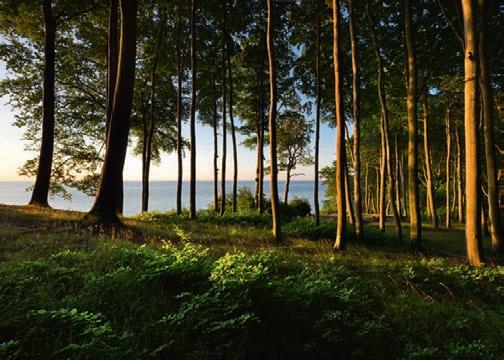
50 October/November 2023
©iStock/mije_shots; ©Lookphotos/Heinz Wohner; ©GNTB/Francesco Carovillano; ©GNTB/Julia Nimke; ©GNTB/Christof Herdt
Europe might look like were it not for our intervention, and their UNESCO designation is actually an extension to another listing – the Primeval Beech Forests of the Carpathians.
Another visual feast is the Upper Middle Rhine Valley, which is crisscrossed with vineyards, dazzling greenery and castle-dotted hilltops. Follow the Rhine river on foot or by bicycle to take in the views with a dose of fresh air, and you’ll understand why it’s one of Germany’s most beloved outdoor spaces. A 65km stretch of the Rhine Valley is on the Heritage List for how impressively it illustrates longterm human interaction within such a varied array of landscapes.
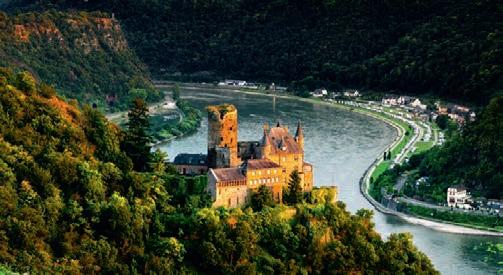
Lastly, conservationists, birdwatchers and beachgoers alike will want to head straight for the Wadden Sea on Germany’s northern coast. This UNESCO World Heritage landscape is the world’s largest unbroken system of tidal flats, and this biodiverse haven spans 500km across coastal Denmark, Germany and the Netherlands. The region is crucial to the conservation of migratory African-Eurasian waterbirds – more than 10 million of which pass through each year.
CULTURE AND INTELLECTUAL HERITAGE
Culture comes in many forms, and Germany has a longstanding reputation for its thinkers, musicians, writers and artists. Many of the country’s UNESCO sites honour this history, from an island of museums to its opulent opera houses.
The whole of Berlin is a cultural hotspot, but the capital’s Museum Island is a concentrated hit of ideas, artwork and artefacts from thousands of years of human history, spread across house collections and exclusive
exhibitions in five institutions. Where else can you see a 3,000-year-old bust of Egyptian queen Nefertiti, the Roman Pergamon Altar and Auguste Rodin’s The Thinker in one small area?
After visiting the capital’s museums, head to the city of Bremen to glimpse its beautiful Town Hall. This is a quintessential example of the Weser Renaissance architecture of the 16th and 17th centuries that can be found throughout northern Germany. Together with the city’s statue of Roland (a symbol of freedom and trading rights), the Heritage List acknowledges these sites for their representation of civic autonomy and sovereignty in urban European society.
Germany’s oldest city is Trier, founded in 16 BC as Augusta Treverorum, and it’s worth top spot on the list of any traveller with a passion for history. It is home to an impressive collection of Roman monuments, the venerable Cathedral of Saint Peter, and the Basilica of Our Lady, which is the earliest-built French High

Taking centre stage (this page; clockwise from top) The Upper Middle Rhine Valley has verdant scenery and hilltop castles; the Margravial Opera House in Bayreuth is one of Europe’s finest Baroque theatres; the picturesque Cathedral of Saint Peter is in Trier, Germany’s oldest city
Gothic church outside of France. These highlights earned it UNESCO inscription in 1986, when Trier was singled out for being an outstanding testament to Roman civilisation.
End your cultural expedition at the Margravial Opera House in Bayreuth, one of Europe’s finest Baroque theatres, which also serves as a museum and an occasional stage for rare opera performances. The operas held at Margravial must date from the building’s own era, adding an element of living cultural preservation to its story. UNESCO lauds this site as the only one of its kind that can welcome an audience of 500 for an authentically Baroque opera experience. From decor to acoustics, Margravial is the closest you can get to seeing an actual opera in the 1750s.

PROMOTIONAL FEATURE For more information, head to the official Germany Travel website: www.germany.travel/en
Unique North America
See a side to the USA and Canada beyond the big cities and discover incredible stories and special wildlife with our pick of the trips
TOUR
THE FOUR CORNERS STATES
There is no easy way to sum up the Four Corners states – Arizona, New Mexico, Colorado and Utah.They might share a desert topography, bristling with mesas and towering pinnacles, but there is so much here that is unique, from the pueblos of Albuquerque to the vast night skies over the red rock of Utah. BonVoyage’s Planes,Trains and Desert Terrains trip opens the door to all these, as you ride the old Durango
& Silverton Narrow Gauge Railroad into the mining country of the San Juan mountains, hit the hot springs at the bizarrely titledTruth or Consequences (a town that changed its name to win a 1950s radio contest), visit Spanish missions inTucson and take stock at the Grand Canyon. BonVoyage (bon-voyage.co.uk).Year-round; 14 nights from £2,850pp, including international flights.
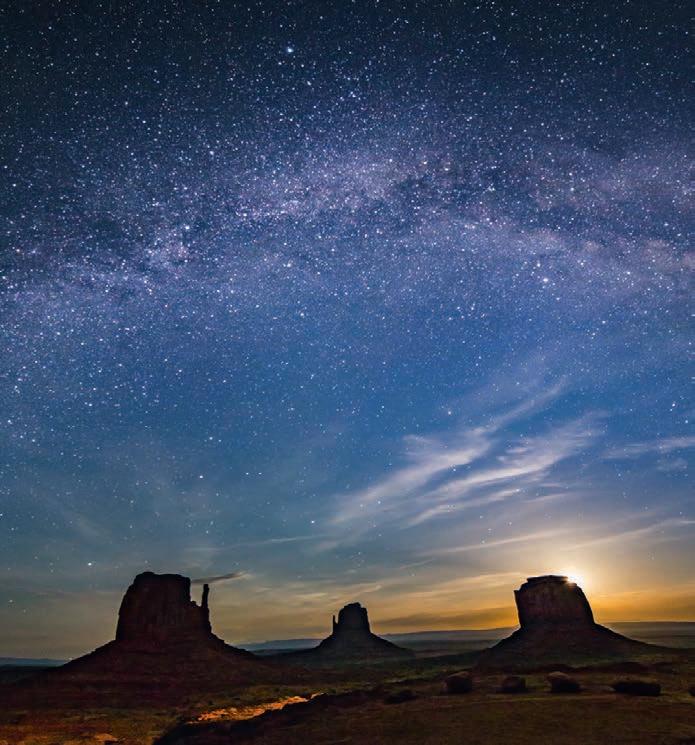
52 October/November 2023 DEPARTURES
MEET SOUTH CAROLINA’S GULLAH GEECHEE
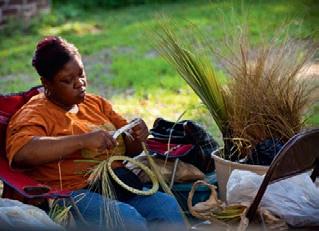
Few travellers know the story of the Gullah Geechee, descendants of enslaved Africans who were sold to the island plantations off the USA’s lower Atlantic coast. Here they were cut off from the rest of the mainland by the waterways, so managed to keep their roots, their music, their culture and their foodways intact – even their language is the only distinctly African Creole in the US. IntrepidTravel’s Charleston to Savannah: Exploring Gullah Geechee Culture first explores African American heritage and the civil rights movement in Charleston before heading to the South Carolina islands of James, Johns and St Helena to meet the communities of Gullah Geechee living there. Here you can learn about a history, culture and struggle that remains unique in the US. Intrepid Travel (intrepidtravel.com). March–June 2024; 7 days from £3,220pp, excluding international flights.
SPEND WINTER IN YELLOWSTONE NP

Wyoming and Montana are the setting for Audley Travel’s Winter in Yellowstone tour, which makes the most of the park’s fallow months, when many of its lodges close (Dec–early Mar) and travel becomes trickier for those going it alone.The crowds drift away during this period, so what better time to explore Yellowstone’s mud pots, geysers and hot springs, as they fog the winter air with steam, or scan for its famed grey wolf packs, which are easier to spot against the snow as they stalk elk deep into the valleys. In addition, guests will set off on snowshoe adventures in GrandTeton NP, then head up into Big Sky Country in Montana, where cross-country skiing and sleigh rides put the heavens on full widescreen before you settle in for the night at your ranch in the Rockies. Audley Travel (audleytravel.com). Flexible; 14 days from £7,800pp, including international flights.
GET INTO GEAR IN THE MARITIMES
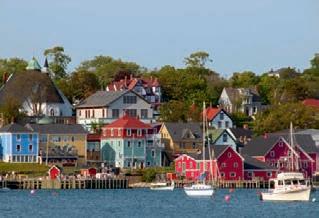
On the tip of eastern Canada lie the Maritime Provinces of Nova Scotia, New Brunswick and Prince Edward Island, the inspiration behind Lucy Maud Montgomery’s classic, Anne of Green Gables. It’s a region defined by panoramic bays, vast parks, fresh lobster dinners and historic towns such as the UNESCO-listed Lunenburg, whose salty past and sailing heritage still loom large. Discover the World’s Canada: Maritimes Explorer self-drive charts a rugged course through this world via scenic routes. Hit the Cabot Trail that threads the dramatic Cape Breton Highlands, then cruise the Fundy Coastal Drive, passing the twisted sea stacks of Hopewell Rocks to see the phenomenal force of the world’s highest tides. Discover theWorld (discover-the-world.com). May–September; 13 nights from £2,054pp, excluding international flights.
TAKE A SAFARI IN BRITISH COLUMBIA
The west coast of Canada is where the vast temperate rainforests of British Columbia trickle down to the waters of the Johnstone Strait. It is an area rich in wild encounters, andWildlifeWorldwide’s Safari Slowly on Canada’sWest Coast tour puts you square in the centre of that world. Based in Farewell Harbor Lodge, on an inlet at the edge of the Great Bear Rainforest, you are surrounded by trails and some 85,000 sq km of wilderness – ample room for its black and grizzly bear population to roam. Spend your time in the Broughton Archipelago on excursions deep into the rainforest to look for its resident bears, before heading out on boats to scour the water for migratory orcas and humpbacks while bald eagles soar overhead. Wildlife Worldwide (wildlifeworldwide.com). June–October; 9 days from £6,495pp, including international flights.
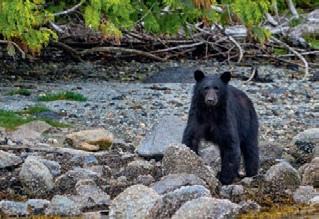
Alamy; Shutterstock JOURNAL USA & Canada www.wanderlustmagazine.com 53 ⊲
HEAR THE BLUES IN THE DEEP SOUTH
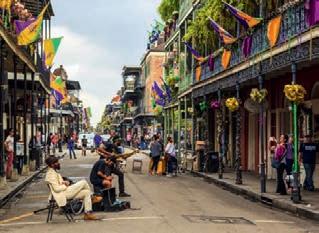
The Deep South is the home of the blues. By exploring states along the Mississippi – Georgia,Tennessee, Mississippi, Louisiana –ExodusTravels’ Deep South & Delta Blues trip delves into the roots of a music that first emerged among the descendants of enslaved Africans in the region’s plantations.A visit to Louisiana’s Houmas House Plantation adds context, as does a trip to Birmingham, Alabama, where civil rights leader Martin Luther King Jr found his voice and was later buried.Then make your way through New Orleans, Memphis and Clarksdale, where Robert Johnson was said to have sold his soul at a crossroads for superlative skills on the guitar, to get a taste of where the likes of BB King and MuddyWaters first wowed their audiences. ExodusTravels (exodus.co.uk). June–November; 12 days from £4,299pp, excluding international flights.
SEE BOTH SIDES OF NORTH DAKOTA
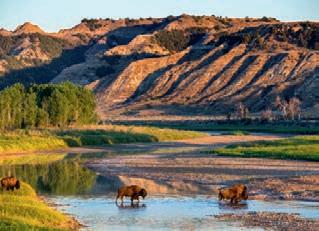
In parts of North Dakota, where the plains stretch for days, it can still feel like an America before Lewis and Clark headed west. On the North Dakota Adventures self-drive tour from America AsYou Like It, the open road is an invitation to explore just why.Whether visiting the largest national grassland (Little Missouri) in the USA or roaming the badlands of Theodore Roosevelt National Park, there is plenty of natural grandeur to explore. But it’s the cultural side of the state that intrigues most,with the outdoor stage shows of Medora, a drive along the Enchanted Highway to see the sculptures that line this route, and a visit to Fargo’s Plains Art Museum, filled with local and Indigenous art, all offering a tantalising glimpse of North Dakota’s creative scene. AmericaAsYou Like It (americaasyoulikeit.com).Year-round; 12 nights from £1,819pp, including international flights.
WILDERNESS AND WINE IN OREGON
Oregon is perhaps best known for ‘capital of weird’ Portland, but it has plenty more strings to its bow. North America Travel Service’s Wilderness,Wine & Coast Adventure explores these corners as it follows the Columbia River east of Portland and up to Mount Hood, which is filled with hiking trails and skiing spots. From here you can choose to detour east via the ‘Painted Hills’ – remarkable hillsides streaked in reds, blacks and yellows – and the high desert of Central Oregon, before looping back round to the pinot noirs, vineyards and farm-totable eateries of theWillametteValley. But the highlight is arguably Oregon’s unsung west coast, where dunes, lighthouses, basalt headlands and sea lion colonies await. North AmericaTravel Service (northamericatravelservice.co.uk).Year-round (best: May–Sep); 10 days from £2,211pp, including international flights.
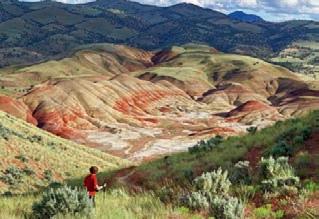
BEARS AND BELUGAS IN MANITOBA
Midsummer in the remote Canadian town of Churchill, Manitoba, is a special time to arrive. Despite being 400km from the nearest big settlement, Churchill fills with visitors in the winter months because this is when the polar bears come to hunt on the ice of Hudson Bay.In summer,the waters thaw and the bears spread out along the coast,but another visitor takes their place.Trailfinders’Ultimate Bears & Belugas Summer Adventure times its arrival for the migration of some 60,000 beluga whales into the bay. You can still spot polar bears here, and boat tours or visits to the town’s famed Polar Bear Holding Facility (where bears who have become troublesome are held before relocation) will delight those wanting to see more,but it’s the whales that are the star at this time of year. Trailfinders (trailfinders.com). July–August;7 days from £4,609pp,excluding international flights.
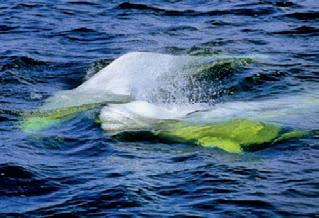
Alamy; Shutterstock
54 October/November 2023 DEPARTURES
See where North and South connect in
CINCINNATI
Cincinnati was the USA’s fastest-growing metropolis by the 1830s, and its renaissance over the last decade or so has once again made it a must-visit. Now, with the launch of new direct flights from London Heathrow with British Airways, there are even more reasons to plan a trip to the ‘Queen City’.

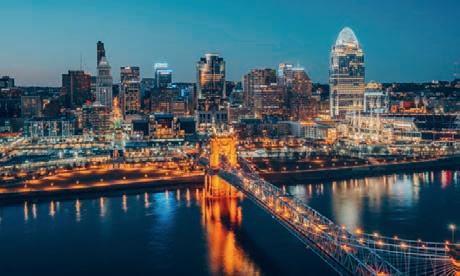
CITY DELIGHTS
As well as the Cincy Region’s lively Oktoberfest (the largest in the US), the city also hosts the May Festival, a haven for classical-music fans.
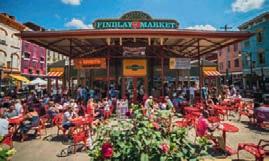
If you’re after food, the vibrant Findlay Market (the oldest in Ohio) has enough delights to entice any epicurean. The city was once known as Porkopolis, and its famous goetta – a meatloaf that was introduced by German immigrants in the 19th century – is a must-try dish. The Cincy Region’s local chili is also special –with hints of cinnamon and chocolate – so head to Skyline where you can try heaps of it spooned over spaghetti and topped with a layer of shredded cheese. For a refreshing beer to wash it all down with, head to the excellent Rhinegeist brewery (one of more than
80 local breweries) afterwards.
Cincinnati is very walkable, but it’s also easy to explore its neighbours, Kentucky’s Covington and Newport, on foot by crossing the John A. Roebling Suspension Bridge, an architectural icon which was the prototype for New York’s Brooklyn Bridge. Before Las Vegas, Newport was the original ‘Sin City’ and once a celebrity playground from the Roaring Twenties until the 1960s. It was made notorious by the tough guys who owned the casinos and befriended the likes of Frank Sinatra, so book a ‘gangster tour’ for tales of its colourful past. Or explore The B-Line, Northern Kentucky’s selfguided craft bourbon tour.
If you don’t fancy walking, Cincy –as it’s known – also has the Connector,
The world at your feet (clockwise from top left) Cincinnati’s John A Roebling Suspension Bridge lights up at night; sample bourbon cocktails on The B-Line craft bourbon tour; kayaking the Ohio River is one of the best ways to see the city; find a local bite to eat in Findlay Market
an electric-powered streetcar that is free to use and takes you through its most prominent neighbourhoods. Be sure to get off at its northernmost tip at Findlay Market and make your way to the American Sign Museum in the Camp Washington area to see its collection of historic neon signs.
GO GREEN

On the Ohio River’s north side lies lush Smale Riverfront Park, an ideal spot to relax and watch the city go by. The park boasts local art installations and a fine cycling trail with views of the city’s skyline, as well as plenty of areas to kayak nearby. You can also stop at the National Underground Railroad Freedom Center for an insight into the 19th-century network that used to smuggle enslaved people from the South to freedom in the North. Beyond the city, there are plenty of green spaces to explore. Enjoy the wildflowers at the restored Bender Mountain Nature Preserve, where you can hike an abandoned stretch of Delhi Pike road, among other trails. Or venture up into the hills to Mount Airy Forest, which was one of the earliest urban reforestation projects in the United States; now its treehouse and picnic spots make for an ideal escape. There’s also the Licking River Greenway Trail, near Covington, which is great for hiking, walking and cycling. And these wild corners are just for starters in the Cincy Region...
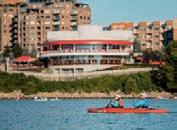
PROMOTIONAL FEATURE www.wanderlustmagazine.com 55 For more information, head to: www.visitcincy.com
Often a launchpad to explore wider Ohio and Kentucky, linger longer in the Cincy Region for fine architecture, heritage and wild, green spaces
Visit Cincy
Happy snapping?
When visiting a small town called Maheshkhali in southern Bangladesh, it began to dawn on me just how problematic some photography can be.
Maheshkhali was quite busy that day: a small cruise ship, with an estimated 100 passengers, had anchored offshore and many of its guests had wandered into town, buying souvenirs, sipping on coconuts and taking pictures. On a residential back road, away from the bustle, a small child – no more than four years old – was playing in a yard. His cheeks were stained with mud and his clothes in tatters. A metre or so away, just by the gate, a western traveller was photographing him without the child realising. As he innocently rolled a burst bicycle tyre in the mud, the traveller snapped away, capturing a depiction of Maheshkhali without context.
Someone else’s shoes
There’s no denying that taking photographs while travelling is a lovely way of documenting a trip. It preserves the characters and colours we come across, adding depth to the memories we preserve in our mind.Yet what had happened in Maheshkhali isn’t an uncommon occurrence. A child was photographed by a stranger, without his or his parent’s consent. Would this not be problematic if it were happening back home?
Then there is the added complexity of context. Images can unintentionally trap people and places in a narrative that isn’t their reality. Around the corner from where that child played, a lively street market was filled with young entrepreneurs – mostly women – who were weaving and embroidering scarves, shawls and wraparound skirts. The photo of the child was taken without a connection to, or an understanding of, this community. Yes, photographs tell a story, but nuance shouldn’t be overlooked.

Is it Instagrammable though?
Today, a travel photo shared on social media can take on a life of its own. Search on Instagram for #durdledoor and you’ll find over 300,000 photos showcasing almost identical scenes of the iconic limestone arch in Dorset. With their aerial views, glassy ocean and sunset
backdrops, these are images filtered within an inch of perfection. Yet what these photos don’t explain is that this area is fragile: the surrounding limestone rock is crumbling and the grassland is diminishing. Signs ask visitors, arriving in their hundreds each day, to stay on the path, but people still scramble over the ropes and climb onto the ridge in the name of an Insta-worthy picture. The conservation of this remarkable British landmark and its surroundings is now in jeopardy.
In 2017, a survey by Schofields Insurance revealed that 40% of clients, aged 18 to 33, picked holidays depending on ‘how Instagrammable’ the destination was. It seems that Insta-worthy, tick-box culture has become a reason to travel. With no context, no learning and no real understanding of the place, is this really a healthy way to experience the world?

While most travellers’ intentions are harmless, we should afford the same courtesy to the places and people we come across that we would expect from others visiting our home towns. With all this in mind, perhaps it’s time to recoin the responsible traveller’s motto to, ‘Take fewer pictures, leave fewer footprints’.
WORD TO THE WISE
If you choose to put your photographs on a social media platform, consider the value of a caption. Social media can be a powerful tool in telling cultural stories and raising awareness of social issues; without a description, the image is left up to the interpretation of the viewer. This is especially important to bear in mind when photographing people. Could your image perpetuate a stereotype of a community, place or religion? If so, adding colour and context can correct this. Share people’s names and personalities, and if you’re highlighting a culture, platform facts rather than focusing on your interpretation. It might take a bit of Googling, but accurate captioning can make all the difference to perception, so use your words wisely.
In service of the almighty post (clockwise from top left) When taking pictures of other cultures, such as this shot of a woman and child in Maheshkhali, be sure to pay them the same courtesies that you would wish to receive were a stranger taking your photograph; taking pictures of children while travelling is problematic at the best of times, and should be avoided entirely if you do not have permission from their parents; be aware when posting images of other cultures, such as this shot of a pair of young Lisu girls in Chiang Rai Province, Thailand, that you are not perpetuating a stereotype, and try to give factual context for the image you post
For a long time, ‘Take only pictures, leave only footprints’ has been the motto of the discerning traveller. Perhaps it’s time to rethink this advice, suggests Karen Edwards
“Photos can unintentionally trap people and places in a narrative that isn’t their reality”
56 October/November 2023 SUSTAINABLE TRAVEL
5
RESPONSIBLE PHOTOGRAPHY TIPS
1 Take notice of customs and rules
Some government buildings, religious figures, monuments and private land aren’t permitted to be photographed. Respect those customs, no matter how perfect the shot may be.
2 Always ask for permission
Carrying a phrase book or the Google Translate app will help to address a person in their own language. Sometimes even a smile and a nod towards your camera can also get the message across politely. If unsure, don’t take the photograph.


3 Read the room
If you feel uncomfortable, the chances are that your subject is also feeling the same. When photographing in a community, be aware of people’s reactions and stop if anyone seems disgruntled.
4 Never photograph children without permission
Always ensure you have consent before taking a picture of a young person. Consent for children should come from an adult. Before taking the shot, ask yourself how you might feel if a stranger snapped a picture of you – or your children – in that moment.
5 Know the backstory
Extra consideration should be taken with regard to how accurately people and cultures are represented on social media. Include the context of the image within the caption to reduce misunderstandings or stereotypical assumptions.

www.wanderlustmagazine.com 57 JOURNAL Photography
Alamy
How Peru embraced umami
The roots of Nikkei cooking stem from an influx of Japanese labourers to Peru. Little did anyone know that it would later birth one of the world’s most talked-about fusion cuisines, writes
Nikkei cuisine, which derives from the word ‘Nikkeijin’, meaning the ‘Japanese diaspora’, is history captured in food. Immigrants from Japan began arriving in Peru from the late 19th century onwards seeking work and a new life. They brought with them their cooking methods and a love of seafood and umami flavours, and slowly adapted Peruvian food and ingredients to suit their tastes.The result is a fusion cuisine now gaining worldwide recognition, thanks to pioneers such as Nobu Matsuhisa and MitsuharuTsumura.
Elise van der Heijden of Eat Peru
It’s no wonder that Peru’s restaurants recently dominated the top end of theWorld’s 50 Best Restaurants list. Nikkei cuisine has played a big role in this newfound interest, with its zesty, fresh, seafood-rich dishes. Combining miso, dashi and soy sauce – staples of Japanese cuisine – with Peruvian chilli peppers and various other local ingredients, the core of Nikkei cooking is built on simplicity and flavour. By harnessing the umami-rich profiles of ingredients like bonito flakes and kombu kelp, it is that rare example of two different cultures coming together in culinary harmony.
Tasting notes
The chefs of Shizen Restaurante Nikkei are hard at work perfecting recipes in their Lima restaurant, but they also run online classes to help cooks at home recreate some Nikkei classics
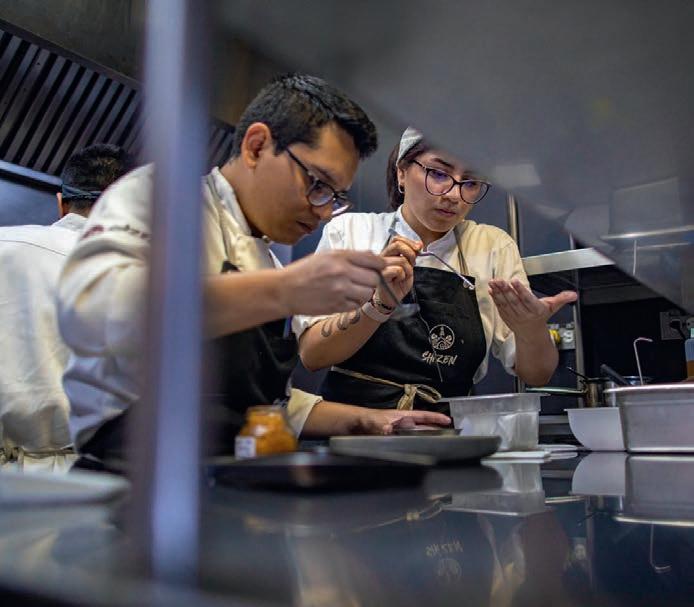
58 October/November 2023 WORLD FOOD
FIVE DISHES YOU SHOULD TRY (AND WHERE TO FIND THEM)
1 Ceviche
In Peruvian-Japanese fusion cuisine, ceviche is the undeniable champion. Fish and seafood marinated in fresh lime juice and sprinkled with spicy yellow chilli peppers continues to capture people’s hearts and taste buds far beyond Peru’s borders. Traditionally served with boiled sweetcorn kernels, sweet potato and plenty of julienned red onion, you will find variations around the country. For the freshest fish, stick to the coast, with Enkai in Lima (enkai.pe) and Cevichería Purito Limón in Arequipa (+51 54 281295) both good options.
2 Octopus with black-olive sauce
Octopus is popular all around the Pacific, and this merger of two different preparation styles is an absolute delight: grilled just enough to preserve its texture and topped with a creamy, slightly tart black-olive sauce. For a truly authentic Nikkei experience, head to the capital, Lima, to try this and
other dishes at the best-in-class Maido (maido.pe) or Shizen Restaurante Nikkei (+51 926 855 394).


3
Oysters
Peru is notable for its coast, which is rich in seafood. Oysters are a big ingredient here, and by combining their unique qualities with Peruvian flavours and Japanese-style recipes, inventive chefs have come up with dishes that are simply mouthwatering. Ginger, lime, avocado, yellow chilli peppers and black olives are just some of the ingredients you might find paired with oysters in Nikkei restaurants around Peru. To try some of the more creative, head to Koi Maki Bar in Trujillo (linktr.ee/koimakibar) and Costanera 700 in Lima (costanera700.pe).
4 Udon and ramen
Noodles remind us that the charm of Peruvian-Japanese cooking isn’t restricted to seafood. Udon and ramen dishes have also been given a Nikkei makeover,

and you’ll find that Indigenous Peruvian ingredients such as sweet potato, yellow chilli peppers and local spices make wonderful accompaniments. Indulge in some noodle goodness at Kintaro in Cusco (kintarocuzco.com), or try the more high-end Osaka in Lima (osakanikkei.com/en/local/lima).
5 Peruvian-style maki

Maki (traditional sushi rolls) have taken Peru by storm, but the Nikkei version is worlds apart from the Japanese original. Peruvian chefs have been quick to integrate traditional local ingredients, such as yellow chilli peppers, avocado, lime and olive sauce, to create an infinite variety of fusion maki that continue to grow in popularity. The biggest crowd pleaser (and with good reason) is maki acevichado, a sushi roll filled with ceviche. It’s a must-try when you’re experimenting with Nikkei. Sample this at Edo Sushi Bar in Lima (edosushibar.com), or head to Sukha in Urubamba (sukha-urubamba.negocio.site).
TRY THIS
Nikkei cookery courses
There are lots of cookery classes on Scoolinary (scoolinary.com) that can teach you the foundations of Nikkei cuisine, with many of them run by Lima’s top chefs. Toshi Matsufuji of Al Toke Pez offers a great, selfpaced ‘Nikkei Street Food’ course, while the co-founders of Shizen Restaurante Nikkei (Coco Tomita and Mayra Flores) and founder of Sutorīto Māketto (Javier Miyasato) offer a ‘Nikkei Cuisine’ class covering everything from maki acevichado to ceviche.
WANDERLUST RECOMMENDS
Visit EatPeru.com for authentic Peruvian recipes and articles on Nikkei cuisine, PeruvianChinese food, Peruvian chocolate and street food.
 Alamy; Jimena Agois; Shizen Restaurante Nikkei
Alamy; Jimena Agois; Shizen Restaurante Nikkei
5 4 2 3 1
JOURNAL Peru www.wanderlustmagazine.com 59
VIRGINIA EXPLORE THE FINER SIDE OF LIFE IN
Stretching between the Appalachian Mountains and the Atlantic Ocean, Virginia’s scenic byways are perfect for enriching slow-travel experiences. Here’s a taster of how best to savour the Old Dominion.
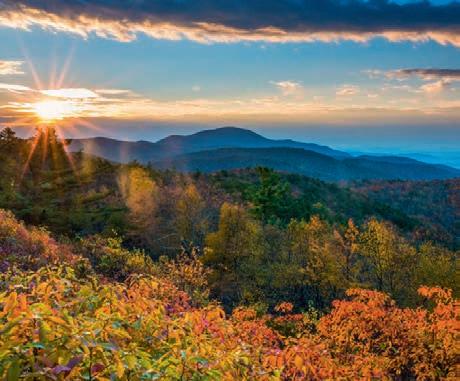
EXPERIENCE VIRGINIA… By road, rail and beyond
From the misty mountain scenes of the Blue Ridge Parkway to the sun-kissed coastal vistas around Chesapeake Bay, Virginia’s variety of landscapes make it the perfect escape for a road trip. Rolling forest covers around 62% of the land here, and its serpentine stretches of tarmac wind through cinematic overlooks, historic towns and gentle bayside shores. These make for some spectacular long-distance drives, although road trips aren’t the only way to explore them.
The Virginia Scenic Railway is the state’s only sightseeing train, and its regular services snake through the countryside and small towns of the Shenandoah Valley. From its modernised 1940s passenger cars, guests can soak up bucolic rural life and national forests with a fine-dining meal and some esteemed company. Another option is to drift above the treetops with only the sound of the breeze for company on a hot air
balloon ride. This is one of Virginia’s more remarkable experiences, as you glide above the scenic countryside of Shenandoah National Park.
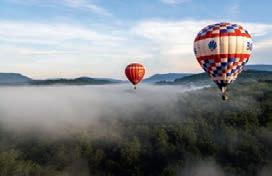
Virginia’s hills, forests and wilds are among the USA’s finest destinations for riding, exploring Virginia’s vineyards on horseback or taking the 110km Virginia Highland Horse Trail that winds through Mount Rogers National Recreation Area. For an indulgent encounter with nature, take a grand boat tour around the marshlands of the Chincoteague and Assateague Islands, where you might spot Chincoteague ponies, dolphins and birds like black skimmers and little blue herons.
Through your taste buds
Virginia’s great outdoors isn’t simply pretty to view, it’s the origin of some sublime gastronomic experiences.
State capital Richmond has one of America’s most exciting culinary scenes, and has even lured some award-winning local chefs back home from the big cities. Brittany Anderson of the German-inspired nose-to-tail restaurant Metzger Bar & Butchery and David Shannon of L’Opossum, which dishes up excellent French fare, are just a couple of the most celebrated.
While local produce is abundant in Virginia, one of the state’s signature dishes is oysters. Introduce yourself to their delights on the Chef’s Table Tour with Pleasure House Oysters, which lets visitors handpick and eat their own oysters from the Lynnhaven River.
There are almost 300 breweries, 60 distilleries and more than 300 wineries in the state, too, which owe plenty to the passion and creativity of Virginia’s locals. Drop by the farmland setting of Lickinghole Creek brewery, pay a visit to Lost Rhino for a delicious taste of its Native Son amber ale (made with 100% local Virginia ingredients) or enjoy a private tour of the high-end wineries sprinkled around Charlottesville.
And if you thought American whiskey was the sole preserve of Kentucky, the bourbons and ryes made by the Tarnished Truth Distilling Company will put you straight.
By exploring its history and culture
Few states can offer the same window on American heritage as Virginia can. From visits to early colonial settlements to honouring the birthplace of country
60 October/November 2023
Widescreen vistas (this page; top to bottom) The Blue Ridge Mountains turn golden in autumn; see Virginia from above on a hot air balloon ride
A luxury trip to Virginia offers the time to truly indulge in its scenic landscapes, tantalising food and captivating culture
music, Virginia teaches us plenty about the United States that exists today.

Start at Jamestown, the site of the first permanent English settlement in North America and part of the state’s famed Historic Triangle. Explore early US history on a trip to Colonial Williamsburg’s living museum, which recreates one of America’s earliest capital cities, then complete the triangle at Yorktown, significant for both the Revolutionary War and the Civil War. Its 1884 Yorktown Victory Monument is a truly colossal sight.
History fans should also spare some time to soak up Mount Vernon, the site of President George Washington’s well-preserved plantation home, on a guided tour.
The USA’s growth as a nation eventually led to a flourishing arts scene, and the Virginia Museum of Fine Arts boasts an eclectic collection,



Travel in style (this page; clockwise from right) The Salamander Middleburg; the Blue Ridge Parkway in autumn; go horse riding in Virginia’s vineyards; explore Jamestown’s colonial past; the state is dotted with intriguing distilleries; oysters are one of the stars of Virginia’s local cuisine; take the time to peruse the Virginia Museum of Fine Arts
PREMIUM SLEEPS IN VIRGINIA
1 THE HISTORIC CAVALIER HOTEL & BEACH CLUB
including the largest haul of Fabergé eggs outside of Russia. Be sure to drop by the Birthplace of Country Music Museum in Bristol to see how a few recording sessions in 1927 led to the creation of this enduring music genre. Lastly, for something a little quirkier, check out Richmond’s Edgar Allan Poe Museum and learn more about the master of macabre literature.
Elizabeth Taylor, Muhammad Ali and President Jimmy Carter are among the glitterati to have stayed at the Cavalier Hotel since it opened its doors in 1927. Situated in lively Virginia Beach, The Cavalier has been meticulously restored to its original grandeur, delivering timeless Virginia luxury.
2 KESWICK HALL
Completed in 1912, this opulent hotel in the foothills of the Blue Ridge Mountains was recently remodelled. With its ethereal horizon pool, a spa and exceptional restaurant and golf course, Keswick Hall makes for a refined getaway.
3 SALAMANDER MIDDLEBURG
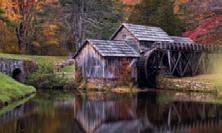
This equestrian-themed resort in the heart of Virginia’s wine country features a wonderful spa alongside a wealth of outdoor activities. The rooms are spacious and plush, and they all include patios or balconies for guests to unwind under the sun.

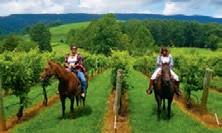
With a love for everything stateside, North America Travel Service has offered bespoke designer trips for over 50 years. From epic adventures out west to shorter urban city breaks, North America Travel Service will plan your itinerary down to the smallest detail to ensure a memorable trip. northamericantravelservice.co.uk/ luxury-virginia/
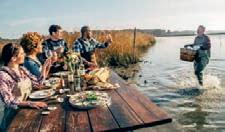
PROMOTIONAL FEATURE For more information, visit: www.virginia.org www.wanderlustmagazine.com 61
Alamy; AWL; Carlita Pitts/@iamthelita; Grey Walters/@greywalters; Visit Virginia; Shutterstock












Alamy; Shutterstock CATCH UP ON: Tobago’s Culture, History and Wild Nature; Highlights of Colourful Croatia; Exploring the Pacific Northwest AUTUMN SEASON LAUNCHING NOW EXPERIENCING ALBERTA’S INDIGENOUS CULTURES H Azerbaijan: Where East Meets West H California Road Trips H Germany’s UNESCO Sites H Guide to the Azores wanderlustmagazine.com/podcast Listen now! THE PODCAST LISTEN HERE: OFF THE PAGE
Costa Navarino, Greece
In a little-visited corner of the south-western Peloponnese lies a multifaceted luxury tourism project that places environmental regeneration, local community and sustainable development at the forefront of its endeavours
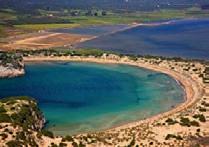


Facing the twinkling Ionian Sea, the 1,000-hectare development of Costa Navarino spans five sites on the coast of Greece’s Peloponnese region, a vast peninsula west of Athens. It first opened its doors in 2010; now it includes flagship stay The Romanos, A Luxury Collection Resort; the family-friendly Westin; a unique W Resort with unusually strong local character; and a just-opened, ultra-luxury Mandarin Oriental resort. Guests have access to restaurants, shops and wellness and sports facilities, and cycling and walking paths scatter the area.You could easily treat it as a self-contained world, but there is far more to this project.

The Romanos is the pre-eminent resort within Costa Navarino, featuring a little over 300 rooms, with almost half of them equipped with their own infinity pools (using water from sustainable irrigation systems). Its Blue Flag sand-dune beach hosts a monitoring and protection programme for the loggerhead sea turtle (Caretta caretta), and patches are frequently cordoned off as nesting areas.The resort also offers surprisingly good value for money in its plethora of dining options, including the excellent beachfront Barbouni, which has a heavy focus on local Greek cuisine and sustainably sourced seafood.
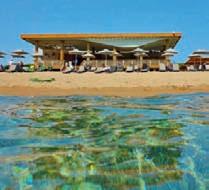
Many of Costa Navarino’s buildings have been inspired by local architecture and the nearby Mycenaean ruins. Indeed, the site of the storied Palace of King Nestor – which was described in Homer’s Odyssey and Iliad – and its exquisite frescoes are but a ten-minute drive away.The wider area of the largely still-off-the-beaten-path western Peloponnese is also rich in history and archaeology, and the
UNESCO-listed Ancient Olympia site, birthplace of the Olympic Games, is just 90 minutes’ drive from the hotel.
Along similar lines, Costa Navarino’s ‘Messinian Authenticity’ experiences focus on getting people out of the resort area through immersive activities, such as regional cookery classes held in a local village, olive harvesting (Kalamata, of olive fame, is the nearest big town and international airport) and olive oil- and wine-tasting sessions, all managed and run by local community agrobusinesses.
Before its redevelopment as a resort, the area was mostly made up of disused farmland with limited vegetation; following its reinvention it has seen the biggest olive tree transplanting programme in Europe take place, in addition to the planting of 9,900 new indigenous trees. Costa Navarino has been credited with bringing about a significant economic revival in the south-western Peloponnese, employing and training thousands of locals and attracting international visitors to a lesser-known corner of the Greek mainland.
While notable oversights are still present – including the Canadian-made toiletries in the bathrooms of the Romanos – the resorts here stand out in terms of tourism sustainability and community engagement credentials in Greece. In a country where visitors often focus on the beauty of its islands, Costa Navarino offers a worldclass mainland alternative with bountiful nature, crowd-free beaches and historic sites from Greece’s Heroic Age. GK Roomsfromaround£280pnatTheRomanosinspring/autumn; costanavarino.com
www.wanderlustmagazine.com 63 DREAM SLEEP
Alamy; Costa Navarino; Christos Drazos Photography
NOVA SCOTIA’S CAPE BRETON ISLAND EXPLORE
Experience fresh sea air, Celtic culture and outdoor adventure on this revitalising Canadian Island
Separated from the Canadian mainland by the Strait of Canso, Cape Breton is the wind-whipped northern tip of Nova Scotia, a land of rugged cinematic landscapes where culture runs deep and the seafood is as spectacular as the densely forested river valleys.
From the sea-sprayed coastal highway of the Cabot Trail to the fresh plates of steaming shellfish served at Baddeck Lobster Suppers, few corners of Canada are as life-affirming and invigorating as Cape Breton. Its widescreen landscapes promise wonderful outdoor adventures. It also has plenty of its own stories to tell, via
Raucous rhythms (this page, clockwise from top left) Experience Gaelic culture as it existed hundreds of years ago at the Highland Village Museum; celebrate traditional Celtic song and dance at one of the 49 concerts held for the annual Celtic Colours International Festival
the people who have lived here for generations. Meeting the island’s First Nations and Acadian (descendants of early French settlers) communities reveals some fascinating tales that offer a unique glimpse of local life.
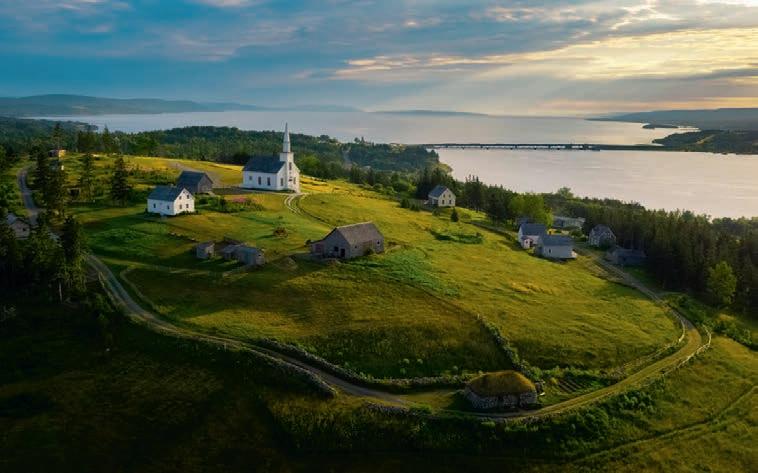
CELTIC CULTURE
Throughout Cape Breton runs a strong Celtic tradition that dates back to the 18th century, when wave after wave of Scottish settlers first arrived. Celtic culture stayed within the diaspora, who made this their home, and it is a heritage that is still keenly felt across the island today.
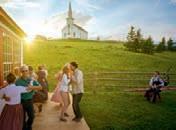
One of the most joyous expressions of Celtic culture found here lies within
the local music scene. The Celtic Colours International Festival (6–14 October), in particular, is a raucous celebration of traditional Celtic song and dance across 49 concerts – many with a strong emphasis on Cape Breton fiddle playing – and more than 200 cultural experiences.
64 October/November 2023
But Celtic culture doesn’t begin and end with the violin. To learn more about the Celtic people who travelled here and what their day-to-day lives were like, the new Interpretive Centre at the Highland Village offers a striking window into traditional homestead life, all within a restored historic community.
Celtic culture has made a huge contribution to the richness of life on Cape Breton, and for anyone exploring it, these places are just the beginning.
OUTDOOR PURSUITS
From tranquil lakeside trails to soaring mountain summits, the gorgeous terrain of this windswept island is a magnificent canvas that makes you want to head into the great outdoors. Whether it’s hiking amid the yawning river canyons of Cape Breton Highlands National Park or cycling beside the waves of the Celtic Shores Coastal Trail, there are a host of revitalising activities available here to coax out your adventurous side.
The Cabot Trail, a spectacular 298km driving loop around the northern tip of the island, is one of Canada’s iconic road trips. As it approaches the western coast at Chéticamp, be sure to get out and trek the Skyline Trail, which was redesigned in late 2021. If you do so, you’ll emerge onto a spectacular headland with panoramic views of the Gulf of St Lawrence and Cape Breton Highlands National Park.
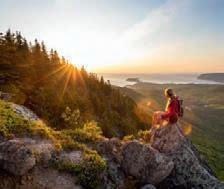
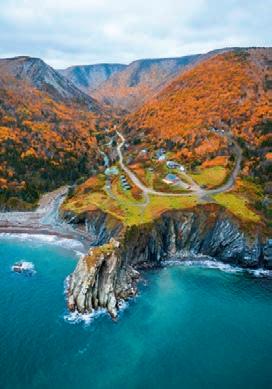

If the weather behaves, kayaking the gentle waters of Bras d’Or Lake paints Cape Breton in a totally different light. So, slow down, soak in the scenery and experience Nova Scotia’s wildest corner at your own pace.
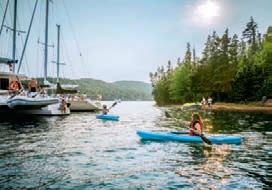
INDIGENOUS COMMUNITIES

For more than 10,000 years, the Mi’kmaq First Nation has called Nova Scotia home. They’ve seen Cape Breton change dramatically over the centuries, but it all began with them.
A cultural tour of Bras d’Or Lake’s Goat Island, along a winding 2.4km trail, is
Live life in the slow lane (this page; clockwise from top left) The picturesque Cabot Trail is a 298km loop around the northern tip of the island; admire the jagged cliffs of Meat Cove; the Cape Breton Highlands National Park offers panoramic views of the Gulf of St Lawrence; learn about Indigenous Mi’kmaq culture on Goat Island; embark on a kayak expedition at Baddeck
the perfect opportunity for visitors to learn about not just the Mi’kmaq way of life, but the foundations of Cape Breton. Following a heritage guide from the community, who arrives dressed in full hand-made regalia, the tour makes a series of stops at recreated traditional villages around the island, helping you to gain a better grasp of Mi’kmaq history and culture. Another historic community here is the Acadians, descendants of settlers from south-western France. Learn more about their fascinating history by heading to Chéticamp and checking out the mask displays at the Centre de la Mi-Carême, then make your way to the Hooked Rug and Homelife Museum at Les Trois Pignons cultural centre to see what the daily life of the settlers was really like.
CULINARY DELIGHTS
Flanked by the Gulf of St Lawrence to the west and the mighty Atlantic Ocean to the east, the rich seas surrounding Cape Breton produce an abundance of fine seafood. From shucking fresh oysters at island institution The Rusty Anchor to diving into a plate of scallops St Jacques (and other Acadian delicacies) at Le Gabriel Restaurant & Lounge, Cape Breton’s fresh seafood demands to be sampled. And if lobster is your thing, then there’s nowhere better to visit than the appropriately named Baddeck Lobster Suppers in the small town of Baddeck.
But all of this great food needs to be washed down, so be sure to keep an eye out for the pubs, breweries and distilleries that form part of Nova Scotia’s Good Cheer Trail. Sample myriad beer styles at Sydney’s Breton Brewing Co, sip sweet ciders at the Island Folk Cider House or enjoy a wee dram at the Glenora Distillery, home of Canada’s first single malt whisky.
If you want to experience the best of Cape Breton’s gastronomy all in one place, look out for the annual KitchenFest celebrations. Otherwise, just let your nose be your guide.
PROMOTIONAL FEATURE
For more information on how to plan your visit, go to: novascotia.com and discover-the-world.com/holidays/cape-breton-explorer
Dean Casavechia; Patrick Roho Photography; Tourism Nova Scotia; Tom Cochrane
The call of the Rockies
From historic ski lodges to rustic backcountry cabins and a mock-Scottish castle, we pick the stays in Canada’s Rocky Mountains that make the most of their setting
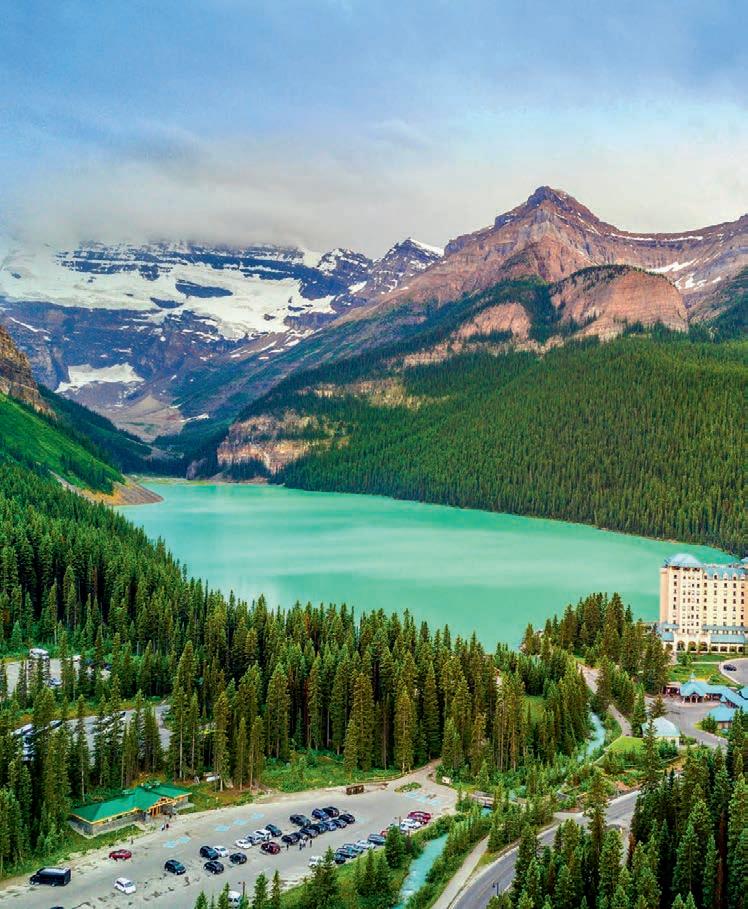 Reviewed by Oliver Berry
Reviewed by Oliver Berry
Between a rock and a wild place The waterside location of the Fairmont Château Lake Louise is one of many dramatic settings in the Canadian Rockies where you can find a cosy, luxurious escape yet still feel the lure of the Canadian wilderness 66 October/November 2023 WANDERSLEEPS
FAIRMONT CHÂTEAU LAKE LOUISE


This hulking, 539-room hotel commands one of Canada’s knockout locations: on the edge of the Rockies’ most famous lake, with a horizon filled by spiky summits. In winter, you can even walk out of the door, strap on your skates and glide straight out onto the ice. And while the building looks curiously incongruous in this setting – more Las Vegas casino than mountain hotel – there’s no denying the luxury level or the grandstand mountain view from the rooms. There are several restaurants to choose from, as well as an impressive spa, and staff can arrange activities ranging from canoeing to horseback treks. A new wellness centre is also in the works. Rooms from around £210 per night, excluding breakfast; fairmont.com/lake-louise
KANANASKIS MOUNTAIN LODGE
A part of the Marriott’s upmarket Autograph Collection, this is as close as the Rockies gets to a boutique resort. There is an undeniably retro, 1970s-inspired feel to the design, which seems more metropolitan-modern than mountain resort, and you’re certainly getting a unique setting for your money. It’s located way out in the sticks of Kananaskis Country, about an hour’s drive from Canmore; as such, there is ample opportunity for outdoor adventures nearby. Alternatively, simply head over to the hotel’s Nordic Spa, explore the indoor waterpark or hit a few holes on the golf course. Rooms from around £299 per night, excluding breakfast; marriott.com
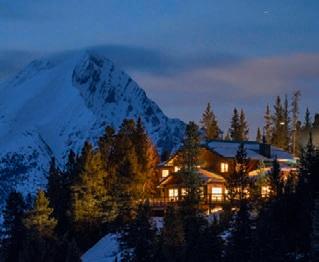
⊲
Alamy; Fairmont Hotels & Resorts; Nick Fitzhardinge Photography
JOURNAL Canada www.wanderlustmagazine.com 67
POST HOTEL

Established in 1942 as a ski lodge by renowned local guide Jim Boyce, the Post Hotel ranks as one of Lake Louise’s most enticing stays, and now operates under the prestigious Relais & Châteaux banner. Set in the middle of Lake Louise’s busy service town, the hotel has retained much of its original 1940s ambience, with walls crafted from local stone and hand-hewn
logs, giving it the appearance of a more rustic escape. But this is an upmarket affair these days, and few could quibble with its 20,000-bottle wine cellar, saltwater pool, excellent restaurant and classy spa. Main lodge rooms are pleasant enough, but the waterfront cabins on the Bow River are quieter and have more character. Rooms from around £275 per night, excluding breakfast; posthotel.com

WANDERSLEEPS
SKOKI LODGE
This log-built backcountry stay was Canada’s first commercial ski lodge, raised in the remote Skoki Valley in the early 1930s by members of the Ski Club of the Canadian Rockies. At an altitude of 2,164m, it’s seriously remote and is only accessible by hiking or skiing in via the 11km trail from Lake Louise. Once you arrive, it’s like stepping back in time: there’s no running water or electricity, the only light comes from candles and kerosene lamps, and it’s heated by wood-burning stoves. Meals are served communally, so you’ll be on first-name terms with everyone by the end of the day. And if you’re a stargazer, the night-time skies are out of this world. Rooms from around £200 per night, including all meals; skoki.com
PRINCE OF WALES HOTEL
In the early days of Canadian mountaineering, guides were shipped over from Switzerland to blaze the trails and cajole guests up to the summits, so there’s often an Alpine feel to the region’s old hotels. Nowhere is this more obvious than the Prince of Wales, which overlooks UpperWaterton Lake.Thanks to its gables, green-tiled roof and timber cladding, it appears as if torn straight from a Swiss chocolate box. From the uniformed bell-hops to the traditional afternoon teas, you’ll find an old-fashioned refinement here not common in the Rockies. Don’t miss dinner in the Royal Stewart Dining Room, which has a floor-to-ceiling window looking onto the water. Rooms from around £150 per night, excluding breakfast; glacierparkcollection.com
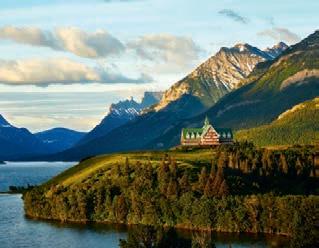
LAKE O’HARA LODGE
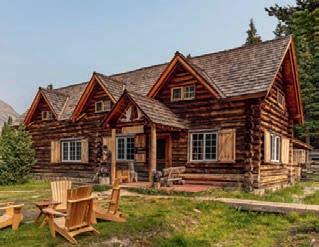

Hidden in the backcountry of Yoho National Park, beside a photogenic lake that requires a permit to visit in summer, this is the ultimate off-grid Rockies refuge.The only way in or out is via a rough 11km access road, which is closed to public traffic; guests are ferried up from the parking lot aboard a shuttle bus in summer (Jun–Oct), or ski in during winter.The old lodge was built in 1926 and its eight rooms are still furnished in 1920s style, but it has since been bolstered by the addition of lakeside cabins built from local cedar wood.The location offers access to many trails off the tourist radar, and the lodge is a fun place to share tales of your adventures.There’s no wifi, no phone reception and no distractions – just silence and hikes galore. Rooms from around £500 per night, including all meals; lakeohara.com

TEKARRA LODGE
For something more traditional than Jasper’s modern hotels, Tekarra Lodge is the ticket. It’s charmingly old school, with each of its small cabins having been furnished in a rustic, frontier style: cosy lounges, log fires, self-catering kitchenettes and a cute gabled porch for watching the sunset. Its setting, on the banks of the Athabasca River, means that it’s a little removed from the bustle of JasperTown, but that hasn’t stopped its restaurant from becoming a local favourite – the house special of meatloaf made with elk, bison, wild boar and forest mushrooms is well worth trying. Look out for evening craft sessions, talks and marshmallow cookouts by the campfire. Rooms from around £170 per night, including breakfast; tekarralodge.com
Alamy; Fairmont Hotels & Resorts; Erik McRitchie/Post Hotel; Prince of Wales Hotel by Pursuit
JOURNAL Canada www.wanderlustmagazine.com 69 ⊲
CATHEDRAL MOUNTAIN LODGE
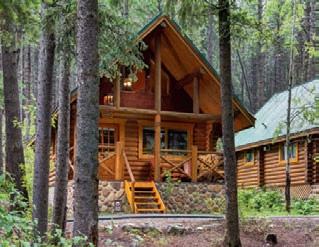
If it’s timber cabins you’re daydreaming of, then it’s hard to top the ones at Cathedral Mountain. Flung up on the less-touristed slopes of Yoho National Park, the cabins here feature all kinds of spoils: stone fireplaces, wood burners, polished timber floors and private verandas offering majestic vistas of Mount Stephen, Field Mountain and Cathedral Mountain. Better still, there are noTVs in any of the rooms, helping you to cut down on screen time. Meals are served in the main lodge, designed by Vancouver architect Brad Lamoureux, or if you want to take in the outdoors, ask for a picnic to eat on the banks of the Kicking Horse River. Rooms from around £320 per night, including breakfast; cathedralmountainlodge.com
FAIRMONT JASPER PARK LODGE
Dating back to the 1920s, this is the oldest and grandest of Jasper’s resorts, located on a sprawling 283-hectare estate surrounded by forests, peaks and the glittering expanse of Lake Beauvert. Originally built for railway tourists, it’s by far the plushest place to stay in the national park, with lodge rooms, suites and signature cabins set among trimmed lawns and pine trees.This is definitely not a place where you’ll be roughing it: take a dip in the heated outdoor pool, relax in the spa or dine out in one of the five restaurants.The hotel even has its own boathouse, where you can hire a canoe for the day and go exploring on the lake. Rooms from around £214 per night, excluding breakfast; fairmont.com/jasper
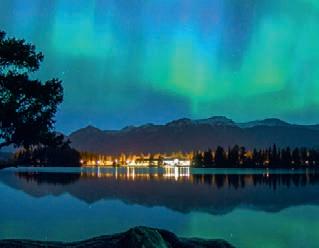
MOUNT ENGADINE LODGE
While the crowds flock to Banff and Lake Louise, the quieter, wilder, emptier valleys of Kananaskis Country feel gloriously peaceful by comparison, even in the peak months of summer.This small cabin complex is the only place to stay in Spray Valley Provincial Park, and it’s a favourite for hikers and bikers looking to explore the trails in blissful peace and quiet. There’s a choice of comfortable cabins or rooms in the lodge, or you can go wild in one of the canvas glamping tents – or even a Mongolian-style yurt. Canmorebased Skala Adventures (skala.ca) leads guided treks to top trails nearby, including Commonwealth Creek, Rummel Lake and Tent Ridge. Rooms from around £200 per night, including breakfast, packed lunch and dinner; mountengadine.com
MORAINE LAKE LODGE
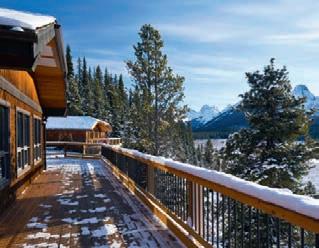
Located 15km south of Lake Louise, Moraine Lake Lodge offers a glimpse of another equally celebrated panorama: the Valley of the Ten Peaks, which features on the back of the Canadian $20 bill. It’s a setting that the lodge makes good use of.This collection of modern cabins in Banff National Park is the only place to stay on Moraine Lake proper, with its well-equipped, private lodges set among peaceful forests of pine and larch. It’s also a great excuse to get out on the water. Slip away before breakfast, borrow one of the hotel’s canoes and paddle out onto the lake long before the day trippers arrive. The only downside is that the hotel is only open from mid-June to mid-September, so it sells out fast. Rooms from around £825 per night, including breakfast; morainelake.com
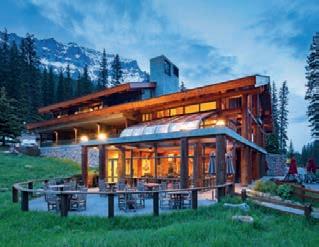 Alamy; Calgary Photos/Cathedral Mountain Lodge; Fairmont Hotels & Resorts; Moraine Lake Lodge
Alamy; Calgary Photos/Cathedral Mountain Lodge; Fairmont Hotels & Resorts; Moraine Lake Lodge
70 October/November 2023 WANDERSLEEPS
FAIRMONT BANFF SPRINGS

This landmark Rockies hotel is a surreal sight, given that it looks like a Highland castle has been picked up, transported across the Atlantic and plonked down on the Canadian mountainside. Built in the 1880s as part of the Canadian Pacific Railway’s campaign to attract tourists to the Rockies, its extravagant, turreted edifice has been designed in Scottish Baronial style, and it affords a commanding view over Banff Town and the Bow Valley. Now owned by the Fairmont chain, it’s the epitome of mountain indulgence: huge rooms, a championship-level golf course and a 3,700 sqm spa fuelled by Banff’s famous hot springs.The Rundle Bar makes a fine spot for a sundowner, too. Rooms from around £353 per night, excluding breakfast; fairmont.com/banff-springs

JOURNAL Canada
SINGAPORE AIRLINES Widen your travel radar in style with

When exploring the world, the journey is as important as the destination, and with Singapore Airlines, you can enjoy both in equal measure. Its vast network and welcoming crew take travellers from the UK to stunning destinations across the globe – South-East Asia, Australia, New Zealand – in modern, comfortable cabins. There’s a good reason why it was recently honoured as the ‘World’s Best Airline’ at the Skytrax World Airline Awards. They’re all an easy hop from the central hub of Singapore, too, with regular non-stop flights from the UK – four flights daily from London Heathrow and five flights a week from Manchester to the Garden City. So, as soon as you board you can kick back and prepare to relax in style; the time will fly by…
Adventures await (top to bottom) Komodo National Park in Indonesia is closer than you think; Singapore Airlines’ premiumeconomy cabin will surprise you with its top cuisine
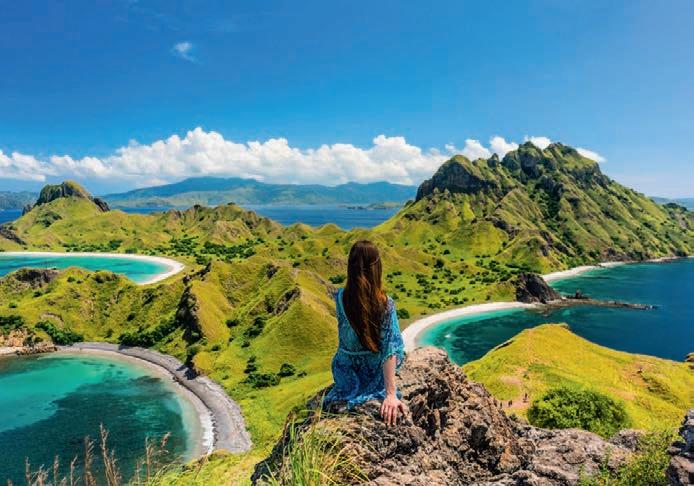
CHOOSE YOUR DESTINATION
Getting to Australia, New Zealand or South-East Asia from the Garden City is a breeze, thanks to Singapore Airlines’ plethora of connecting onward flights. All you need to think about is what destination suits you best…
NEW ZEALAND
New Zealand is filled with wild, lush volcanic landscapes. So, when you’re embarking on such a big adventure, the comfort, cleanliness and friendly crew that Singapore Airlines provides is a real boon. Being partnered with national carrier Air New Zealand, this air alliance offers the fastest route from the UK to the Land of the Long White Cloud. When departing London and Manchester, via Singapore, you can opt to fly to Auckland (North Island) or Christchurch (South Island). Onboard, all the cabins boast unlimited free wifi for KrisFlyer members – a comfort level that’s, literally, made for the long-haul.
If you choose to fly into Auckland in New Zealand’s North Island, explore Wellywood’s Wētā Workshop, which is home to movie artefacts made
72 October/November 2023 For more information, visit: www.singaporeair.com/WelcomeGB
Win return flights and enjoy smooth flying experiences to destinations across South-East Asia and Australasia, where Singapore Airlines makes it easy to reach the globe’s furthest corners
famous by The Lord of the Rings film trilogy. There are volcanic delights at Rotorua and on the trails wrapping Tongariro National Park, you’ll find wild wonders in the Waitomo Glowworm Caves. Alternatively, wildlife and wine lovers should head to the South Island, where grape-growing is big business in Marlborough and vineyards and outdoorsy adventures await around Queenstown. Fiordland National Park harbours the millpond-calm waters of Milford Sound and Doubtful Sound, where you can spot humpback whales and dolphins.
AUSTRALIA
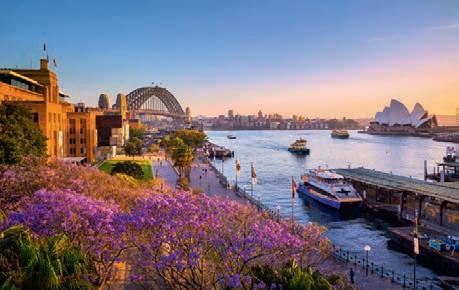
With seven gateways to choose from, flying with Singapore Airlines is one of the best ways to reach Australia from the UK. Partnered with Virgin Australia, Singapore Airlines ensures a seamless flying experience and remains the most frequent airline visitor to the country. Embark on a return trip to iconic cities such as Sydney, Melbourne, Perth and Brisbane, and see some of the biggest and boldest landmarks, epic wildlife and rugged landscapes along
the way. Or why not delve deeper into this vast country and explore more with the help of some open-jaw options? Perhaps fly into Cairns, the gateway to Queensland’s Tropical North and the kaleidoscopic waters of the Great Barrier Reef, before venturing cross-country to catch a flight home from artisanal Adelaide or multicultural Darwin. Whatever adventure you choose, each destination is as compelling as the last. And with Singapore Airlines’ abundant options, you can explore Australia your way, at your own pace. Experience Singapore Airlines hospitality first hand, with the chance to win two premium economy return flights, choosing a destination of your choice in either Australia or South-East Asia.
SOUTH-EAST ASIA
From Bandung to Yangon, Singapore Airlines flies to over 40 destinations across South-East Asia from London Heathrow and Manchester. Flying with them means comfort, style and convenience – particularly in SouthEast Asia where you can combine with trips on low-cost sister airline Scoot. Travellers will also get a taste of what is to come from their meals onboard, which are inspired by the destinations it services.
Those after some coastal fun will feel the lure of Phuket (Thailand), Cebu (Philippines), Denpasar (Bali) and Da Nang (Vietnam), where soft sand often gives way to exploring otherworldly corals and towering karsts by kayak. Speaking of towers,
See the world in style (clockwise from left) Make the most of your trip with a longer ‘stayover’ in Singapore; Singapore Airlines brings you closer to iconic sights like Fiordland National Park in New Zealand; Sydney is just a simple hop from Singapore


the skyscrapers and bright city lights of the capitals of Malaysia, Indonesia, Thailand and the Philippines await, offering vibrant hubs filled with culture and history. They’re also great jumping-off points for the surrounding jungles, countryside and volcanic landscapes. Or perhaps temples are more your speed. Head instead to Myanmar’s Mandalay or Cambodia’s Siem Reap, which lies just a stone’s throw from the vine-clad ruins of the spectacular Angkor Wat complex. The Singapore Airlines competition prize (see bottom right) of two return premium-economy tickets allows you to pick between a South-East Asia destination of your choice or an escape to Australia.
HOW TO WIN
Singapore Airlines is offering two return premium-economy tickets from the UK to a destination of choice in Australia or South-East Asia. For a chance to win, answer the following: Who designed Singapore Airlines’ iconic cabin crew sarong kebaya?

a) Christian Dior
b) Pierre Balmain
c) Yves Saint Laurent
To enter and for full terms, conditions and data policies, please go to wanderlust.co.uk/competitions. The closing date is 30 November 2023.
PROMOTIONAL FEATURE www.wanderlustmagazine.com 73
Alamy; Singapore Airlines; Shutterstock; Destination New South Wales
A new dawn for the Garifuna community
When the Garifuna people settled in Belize, they had to carry their traditions and culture with them; now a new trail is inviting visitors to explore this heritage through local communities
 Words Lynn Houghton
Words Lynn Houghton
DISPATCHES
“Would you like to try some homemade wine?” asked Pen Cayetano.Tall, gangly and with a fistful of dreads tightly clenched in a ponytail atop his head, the prolific painter and musician proffered a glass with the air of a good host. As introductions to the world of traditional Garifuna music went, this was certainly a more genteel opening gambit than I’d anticipated, particularly from a man credited with the creation of punta rock. Even to this day, the 1980s sounds of his Original Turtle Shell Band still underscore much of Belize’s club-music scene.
I accepted the glass and stepped up to the backyard bandstand, where I was faced with an imposing set of tall, African-style drums that reminded me of Cuban congas. They were played in a similar fashion, and after Pen laid out the basic rhythm, I set my wine to one side and followed along.
I’d had a drum kit in my youth, so I relished the opportunity to relive those days. Pen, meanwhile, accompanied himself as he sang a song of freedom and the transfixing power of the sea. I played along but mostly just listened, enthralled by the sounds that came from his hands.
“It was the women who created the punta beat with the rhythm of their kitchen utensils,” Pen explained, sketching the origins of a music unique to the Garifuna people.When I thought about the enormous pestles and mortars used locally to pummel plantains into mash, it was easy to see the connection.
As Pen played, my mind drifted along with the music while my eyes caught sight of his paint-splattered Crocs. Prior to my drum session, his wife, Ingrid, had ushered me into their studio gallery in Dangriga for
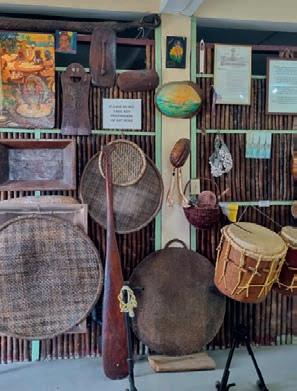

Dangriga, on the southern coast of Belize, is a major cultural centre for the Garifuna people, known collectively as the Garínagu. They trace their roots to the island of St Vincent, and although differing tales of their origins exist, it was here that a group ofWest Africans and the island’s Indigenous Kalinago-Taino (Carib-Arawak) people formed a unique culture and community, bolstered by the steady influx of those escaping slavery.
The Garínagu resisted European colonisation until a bloody conflict with the British led to them being exiled to a Honduran island in the late 1700s, from where they spread out along the Caribbean coast. By the time Belize acquired its modern-day name in 1973, they were already scattered along its southern shoreline; today they make up around 6% of the country’s population.
a brief tour, showing me some of his early paintings depicting the Garifuna experience, culture and roots. Images of hurricanes and hardships had blared from the canvas. But as he beat out his punta rhythms with the broad slap of his palms, he painted a history of his community every bit as vivid as if he had done so with the stroke of a brush. It was certainly a story worth hearing.
In 1802, the first Garifuna settlers arrived in what is now part of southern Belize.This is celebrated on 19 November as Garifuna Settlement Day, as festivities take over the small coastal communities. In Dangriga, this includes the re-enactment of a coterie of sailors arriving on the beach and others drifting up Stann Creek in traditional boats, and is followed by lots of food and dancing.
I had arrived just as celebrations were being planned for this year’s events. But
⊲ JOURNAL Belize www.wanderlustmagazine.com 75
“It was the women who created the punta beat with the rhythm of their kitchen utensils”
Alamy; Lynn Houghton
Life in the little city (clockwise from far left) With a population of under 12,000, Dangriga is a busy centre for the Garifuna community, and visitors have plenty of opportunity to delve into different aspects of the local culture, from drumming sessions and crafting workshops to exploring the many culinary traditions; the author meets Pen Cayetano, a self-taught painter and musician who is a legend in his own lifetime, having invented punta rock by introducing the turtle-shell drum and electric instruments to the age-old sounds of the Garifuna community; the wall of Pen’s studio is like a museum of traditional instruments
I was also here to explore the GarifunaTrail, an exciting new scheme aimed at introducing visitors to a collection of local businesses and institutions that promote Garifuna art, food, crafts and dance in the context of the wider community. Pen was just my first stop.
Touring the historic house next to his studio afforded me the chance to see not just Pen’s artwork, but also that of local artists such as Mercy Sabal, famous for her quilts and dolls. It had given me a longing to explore this side of Garifuna culture. So, after wrapping up our session, I took a few photos, wished Pen good day and set off into town.
Dangriga’s buildings are mostly decorated in bright hues of yellow and black, the official colours of the Garifuna flag. Some of the older houses – painted orange, indigo blue or cerise – are constructed of wood, so had been treated with a resin to combat the furious wind and rain of hurricane season,
the tail end of which fades just as November’s celebrations begin. It seemed a fitting symbol for everything this resilient community has had to weather down the centuries. Having whetted my appetite for traditional Garifuna music, it was now time to visit local drum maker Daytha Rodriguez. Her ‘workshop’, I discovered, was actually the family’s front garden, which was populated with logs, equipment, a baby, chickens and dogs. Daytha and her sister are carrying on a tradition that was passed down from their father, Aston, who arrived by bicycle halfway through our session but didn’t take part; he instead took up grandfatherly duties and settled down to play with the littlest child. As training began, Daytha’s daughter held up a large, laminated poster that provided a step-by-step illustration of the process of traditional drum making. It felt like I’d been invited into their family.
NEED TO KNOW
Getting there: Currently, there are no direct flights to Belize from the UK. British Airways (ba.com), United (united.com), Air France (airfrance.co.uk), KLM (klm.co.uk) and Delta (delta.com) typically fly from London (Gatwick, Heathrow, City) via US hubs such as Houston or Miami and then on to Belize City, taking about 24 hours. Return flights cost from around £649.
Currency: Belize dollar (BZD), currently BZD2.61 to the UK£. US dollars are widely accepted.
Accommodation: In Dangriga, the author stayed at Pelican Beach Resort (pelicanbeachbelize.com), which lies on the coast north of the town centre and has rooms from £177pn. Elsewhere, Gaïa Riverlodge (gaiariverlodge.com) is a great base for those wanting to explore Cayo District and Mountain Pine Ridge Forest Reserve; rooms from £174pn. When to go: Dangriga and Hopkins are the best towns to see the Garifuna Settlement Day celebrations on 19 November.
The Garifuna Trail: Tour operator Uncharted Jewel Belize (unchartedjewelbelize.com) offers cultural tours of Dangriga and its Garifuna community. A map of businesses, museums and workshops on the Garifuna Trail is currently being put together; visit travelbelize.org for updates.
The author visited the following:
Pen Cayetano has a studiogallery on Aranda Crescent, Dangriga, that he opens on weekdays, or on weekends by appointment. cayetanos.com
Tugucina Gloria, Hopkins, is a restaurant that runs traditional Garifuna cookery classes hosted by Mama G herself. You can book classes online. tugucinagloria.com
Workshops with drum-maker Daytha Rodriguez in Dangriga can be attended by appointment with a tour operator.
Gulisi Garifuna Museum, Dangriga, has exhibits looking at the Garifuna migration and culture. Book a visit by emailing gulisimuseum@yahoo.com.

⊲ 76 October/November 2023 DISPATCHES
“Dangriga’s buildings are mostly decorated in the yellow and black of the Garifuna flag”
Alamy; AWL; Lynn Houghton
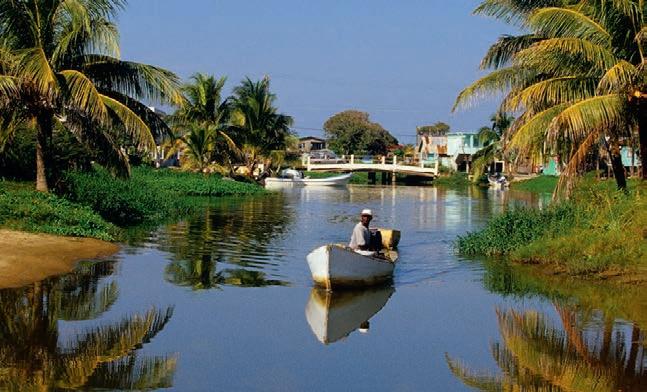
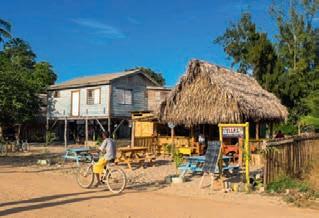

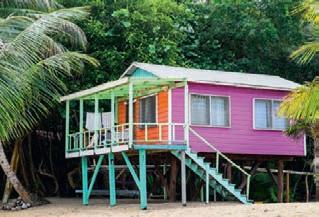
JOURNAL Belize www.wanderlustmagazine.com 77
The big day (clockwise from far left) A boat makes its way up Stann Creek to Dangriga for the landing ceremony on Garifuna Settlement Day, which marks the moment the Garifuna people first arrived in what is now southern Belize; a local Garifuna fisherman heads out for the day; the colourful houses of the Garifuna community remind you of their Caribbean roots and the similar designs that are found across the region; the town of Hopkins is another important cultural centre for the Garifuna community and is surrounded by small fishing villages; Daytha demonstrates hollowing out a log to make her drums







78 October/November 2023 DISPATCHES
Cultural explosion (this page; clockwise from top left) Gloria leads a cookery lesson in which guests are only allowed to use traditional Garifuna preparation methods; a typically appetising bowl of hudutu; Pen’s turtle-shell drums are what first gave him his unique sound; sunset over the Pelican Beach Resort in Dangriga; a group of drummers lead the procession on Garifuna Settlement Day; the November celebrations touch every corner of the Garifuna community, both young and old; (right page) one of the most striking things about Belize, other than its Maya ruins, is the sheer diversity of its peoples, from Creole to Mennonite
What I have left unsaid is just how unique this whole business is. Historically, it was only the Garifuna men that took up this craft. Drums are a hugely important part of their culture, and the two sisters were breaking a generations-long mould by being the first women to have taken up the calling.
I soon learnt that Daytha had shown an early interest in her father’s profession. As a child, she had been intrigued that he didn’t seem to work every day, and she only grew more curious after he explained this was because he was his own boss.With her brothers uninterested in the family business, Daytha and her sister carried it on instead.
She’d begun by learning to smooth out the wooden drums alongside her father.When she had originally asked when she’d know when the drum was ready,Aston had replied: “When you can smell the garlic.” It made little sense, but as an adult she realised that he had been describing a formula for unattainable perfection. The wood would never smell of garlic, any more than the perfectionist would be satisfied with their work.
What I found fascinating was that not only had Daytha and her family broken with convention, but she was willing to innovate too. She had decided to speed up the process of hollowing out the drums by using a chainsaw, which she ably demonstrated. Aston had been against this at first, preferring the old-fashioned way of crafting entirely by hand, but using modern machinery has revolutionised her drum-making business, meaning they can make instruments much faster.
Before long, it was time to depart, but I did so knowing that I was in for a treat. I joined up with tour-guide Ian, who delivered us to the popular beachside restaurant Tauni for a taste of traditional Garifuna food.
“Don’t be afraid to use your fingers,” he advised as the food arrived, picking at a piece of fish dexterously.We were having hudutu, a traditional Garifuna coconut soup. Next to this steaming bowl was a grilled red snapper, ready to be pulled apart and added to the broth, and floating atop the soup was a habanero chilli – locals typically sprinkle in the seeds to spice things up. Alongside this was a huge disc of cassava, a type of traditional flatbread made from the eponymous plant.
Wiggling my toes in the sand, I scarfed down the accompanying plantain mash and thought back to Pen’s story of the origins of punta music. All the while we were watched over by Bob Marley, Elvis Presley and other legendary figures painted on the walls.
This wasn’t my first taste of local cuisine.
Earlier in the week I had visited another Garifuna stronghold, the town of Hopkins, to have a cookery lesson with Gloria at Tugucina Gloria. We made hudutu soup using only traditional utensils and methods. She instructed each participant on how to cut and peel plantain, husk coconuts, grind coconut meat and then squeeze it into a milky substance.The hardest task was manoeuvring the enormous hardwood pestle into a wooden bucket in order to mash up the plantain.
“Be sure to put passion into everything you cook!” declared Gloria. Perhaps it was because of the effort that was involved in making it, but this was one of the most delicious meals I had ever tasted.
Back in Dangriga, we finished lunch and moved on to our final stop, the Gulisi Garifuna Museum, which has a primary school on its grounds that teaches lessons in the Garifuna language. I was met here by Wahrisie Elijio, who was, appropriately enough, wearing a yellow dress with black trim for the occasion, and had even gone so far as to dye half of her naturally black hair blonde. She gave me a personal tour of the museum, highlighting Garifuna history, music and educational principles. Several displays showed cooking utensils, including matapi, which are used to remove toxins from the cassava root before baking bread.
I was fascinated by a timeline in the museum that indicated an alternative history to the one widely told about the origins of the Garifuna people. In 1311, it claimed, two expeditions travelled the Atlantic Ocean from West Africa under the orders of King Abubakari II of Mali to what we now know as the Caribbean island of St Vincent.There is some controversy as to whether theWest Africans arrived at this date, were shipwrecked much later (as some believe) or escaped slavery.Whatever the history, there is no doubting the remarkable culture that it gave rise to.
The most important exhibit in the museum,Wahrisie told me, demonstrated the making of drums. It made me think back to Pen and to Daytha, who had carried on this tradition but also shaped it in their own image. It made me realise that you can’t turn a living culture into an exhibit, as it’s forever evolving, but you can meet and talk to the people who carry it within them: in their art, their food, their clothes, their music.That is the point of the Garifuna Trail, and in doing this, I had experienced a side to Belize every bit as unique as its reefs and Maya ruins.
OTHER BELIZE CULTURES
Maya Indian
The Indigenous ancestral Maya make up about 10% of Belize’s population and are split into three groups: the Yucatec Maya in the north and the Mopán and Kekchí Maya in the south. They are working to save their languages, as many worry they could be lost. Caves in the Cayo region have evidence of ancient Maya ceremonial sacrifices.
Mestizo
The Mestizo, who have a mix of Indigenous and European ancestry, are the largest ethnic group in Belize, compromising nearly half of the population. They are often found in the sparsely populated interior; many also live in the north.

Mennonite
Mennonite farmers arrived here from Canada and Mexico in the 1950s to escape religious persecution, settling in rural areas. Many speak Plautdietsch, an archaic Low Saxon language influenced by the Dutch. They shun most technology and have strict rules regarding dress and their appearance; for example, older men typically grow long beards. Though small in number, they make a significant contribution to the economy through their farming.
Creole
Descended from enslaved West and Central Africans and the British who once traded them, the Creole are mainly based along the central coastal regions. They have their own dialect, or patois, which is unique to Belize and is spoken by most of the population.
JOURNAL Belize www.wanderlustmagazine.com 79
“She instructed us on how to grind coconut meat and then squeeze it into a milky substance”
Alamy; AWL; Lynn Houghton
Blues, Southern hospitality, and community charm: if that is the lifeblood that runs through the veins of Mississippi, its small towns are surely the heartbeat. With their historic homes, wild bayous and Civil War and civil rights histories, each one is different to the last, offering a glimpse of the real Magnolia State.
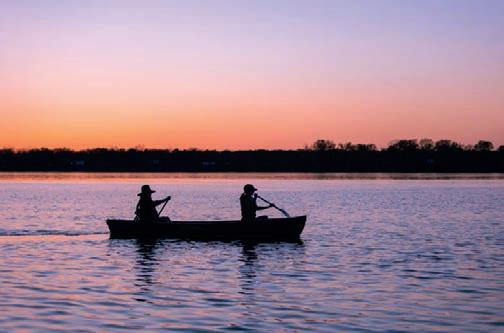
1 CLEVELAND
Cleveland’s character is diverse and compelling in equal measure. There’s good reason that Southern Living magazine named it one of the ‘Best Small Towns in the South’, and its laid-back, unassuming vibe belies just how historically significant it is: as the birthplace of the blues.
A key crossroads within the Mississippi Delta, Cleveland lies at the epicentre of some 50 Mississippi Blues Trail markers and historical sites, all within a 45-minute drive. Begin at Dockery Farms, where one of the first bluesmen, Charley Patton, perfected his art, playing in juke joints across the area and going on to influence such early blues greats as Robert Johnson and Howlin’ Wolf, who both hailed from Mississippi.

Next, head south to Indianola, where you can pay homage to the iconic BB King and his legacy, then drop in on Cleveland’s interactive GRAMMY Museum Mississippi. Here you can learn about the progression of the blues in the States and the role it played in society at the time.
Delta blues (this page; clockwise from right) The Dockery Farms Plantation is widely considered the birthplace of Delta blues music; the Mississippi River is a fine spot for a paddle
2 VICKSBURG
History runs deep through Vicksburg’s veins. It’s here that the most notable Vicksburg Civil War battle took place, which ended with the 47-day Siege. So it stands to reason that no visit is complete without a tour of Vicksburg National Military Park, which is packed with wartime artefacts, including the USS Cairo gunboat, a Union-built ironclad that was sunk by a mine in 1862.
Riverfront murals pock the floodwall at Levee Street, showcasing the town’s compelling stories, while historic homes offer a glimpse of Southern culture. Visit the McRaven Tour Home, one of many historical properties open to the public, which was built in 1797 and has been named the state’s most haunted house. If you prefer outdoors to indoors, there are plenty of lakes and forests surrounding the town. Boating and wildlife spotting are the order of the day here, while the more adventurous can rent canoes and kayaks.
3 NATCHEZ
Gangly oak limbs, draped in Spanish moss, frame the driveways of the colonnaded historic homes
80 October/November 2023 PROMOTIONAL FEATURE
The state of Mississippi is much more than its namesake river, and its small towns pack a big punch – you just need to know where to look…
5 towns to wander in...
of Natchez. This is one of the oldest continuous settlements on the Mississippi River, and having been spared the destruction other cities incurred during the Civil War, it remains a remarkable time capsule.

Take in the town’s historic architecture on tours of its homes, churches and heritage sites – all of which betray a mix of French, English and Spanish influences. Sites such as Longwood, the largest octagonal home in the US with its six storeys from base to dome, and the Rosalie Mansion, still with most of its original fixtures and fittings, are must-sees.
Finish in the city’s revitalised Downtown and breathe in the coffee and chocolate aromas that hang in the air. Or, if you’re feeling curious, try driving or cycling parts of the Old Natchez Trace, an ancient 710km-long forest trail that runs from Natchez to Nashville.
4 OXFORD
Oxford captures the hearts of writers, artists and musicians alike, firing creativity in spades. Often dubbed the ‘Cultural Mecca of the South’, it was once home to the Nobel Prize-winning author William Faulkner, whose historic home, Rowan Oak, is open to the public.

At the other end of the literary spectrum, bestselling thriller novelist John Grisham attended Ole Miss, the University of Mississippi. Who knows how many of his books were first conceived in Oxford itself.
The city’s cuisine is no less moreish than its literature and it’s best sampled in the restaurants flanking the town
square, with their mix of Southern cooking and elegant haute dishes. The square is Oxford’s quaint hub, so take the time to peruse its independent bookshops, boutique shops and art gallery showcasing talented local work. Make sure to pop into Neilson’s, the oldest department store in the South.
5 CLARKSDALE
Perhaps soul singer Sam Cooke was talking about his hometown of Clarksdale, Mississippi, when he wrote ‘Wonderful World’ in 1959. However, it is blues heritage that rules here. This is, after all, where John Lee Hooker and Muddy Waters first found their voice, and where Robert Johnson was said to have sold his soul to the devil at a crossroads in exchange for his legendary guitar skills. Uncover the town’s rhythmic roots at the Delta Blues Museum, or listen to live blues music 365 days a year.
Southern roots (this page; clockwise from top) Clarksdale’s blues heritage is best soaked up through its live music clubs; Longwood in Natchez is a fine example of historic architecture; Oxford’s red double-decker buses were imported from England in the 1990s and are now used for tours
Music is such a driving force that it has even bled into Clarksdale’s restaurant scene. Combine live music and good, local food at Hopson Commissary, Bluesberry Café, Levon’s Bar & Grill and the iconic Ground Zero Blues Club – co-owned by the actor Morgan Freeman. Or why not see for yourself why Clarksdale’s landscapes are so inspirational and take a canoe or kayak for a paddle on the Mississippi?

MAKE IT HAPPEN
With decades of knowledge, the experts at America As You Like It (www.americaasyoulikeit.com; 020 8742 8299) will ensure you see the Mississippi beyond its iconic river and craft your small-town adventure.
www.wanderlustmagazine.com 81 For more information, head to: visitmississippi.org
Visit Mississippi
READER TRAVEL AWARDS

THE 22ND ANNUAL WANDERLUST TRAVEL AWARDS ARE HERE!
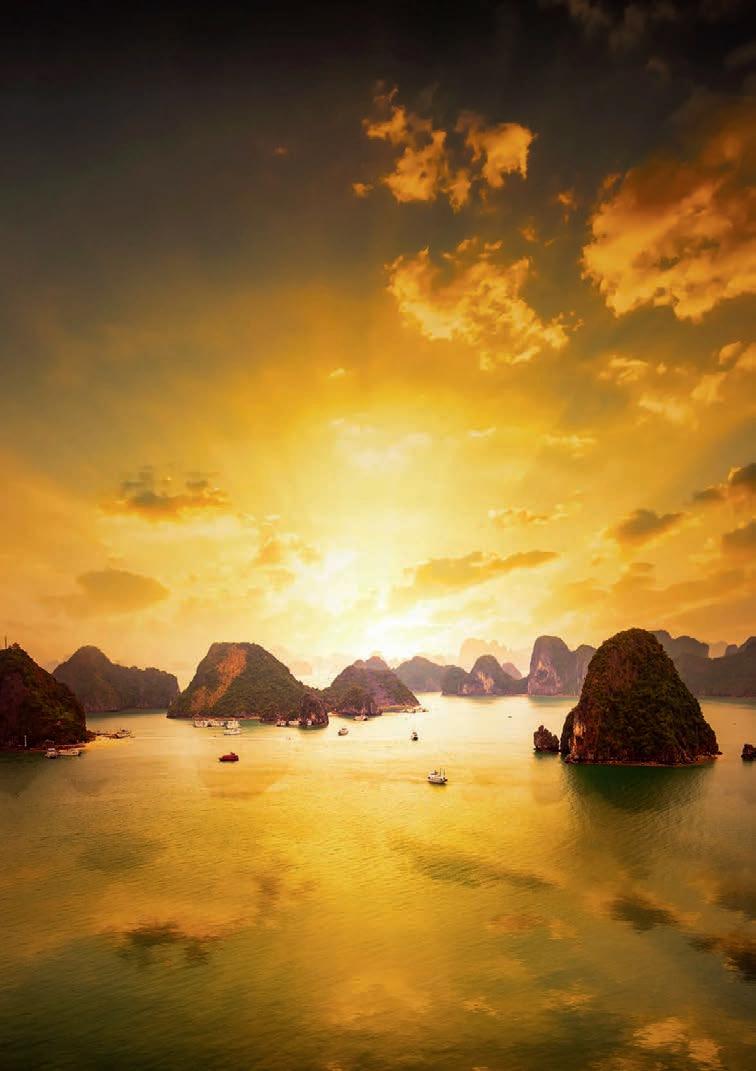
VOTE TO WIN 1 OF 11 PRIZES WORTH OVER

£40,000!
It’s your last chance to send us your thoughts for this year’s awards. What are your most desirable destinations for the upcoming year? Which tour operators and airlines do you feel are making a difference? We want to hear about the people, places and cities that are making travel better. Let us know and you could win some fabulous prizes…
Deadline for entry is 18 October!
QR CODE TO VOTE
wanderlusttravelawards.com OR VISIT
SCAN
VOTE ONLINE
Win a 9-day Galápagos Island expedition with Hurtigruten Expeditions



A once-in-a-lifetime trip for two following in the footsteps of Charles Darwin. Experience close encounters with the Galápagos Islands’ most famous residents, including sea lions, turtles, marine iguanas, giant tortoises and blue-footed boobies. Flights included.
Win a 7-day Highlights of Jordan group tour with Exodus Travels



Ever dreamed of seeing the Rose Red City of Petra? Visit this and all the top sites of Jordan on a week-long adventure for two, including flights.

Win a rail odyssey aboard the USA’s Rocky Mountaineer train with First Class Holidays & Rocky Mountaineer

Ride one of the world’s most iconic trains through the otherworldly landscapes of Utah and Colorado on this trip for two, including flights.
Win a 10-day group tour of Uzbekistan’s Silk Road with Wild Frontiers



Uncover the cultural treasures of capital Tashkent before heading to the legendary Silk Road cities of Khiva, Samarkand and Bukhara on this trip for two.
Win an 11-day selfguided walking holiday in Cape Verde with KE Adventure Travel Roam the islands of São Vicente and Santo Antão on foot and experience authentic Creole music and cuisine along the way on an escape for two.
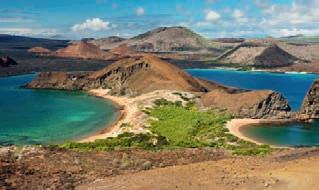
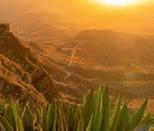
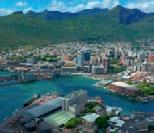
Win a 9-day group tour to Costa Rica with G Adventures











Two people can sample the highlights of this nature lover’s haven and search for elusive rainforest wildlife, learn about local produce and zip-line above forest canopies.
Win a 12-day immersive group tour of Morocco with Intrepid Travel
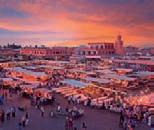
A chance for two to visit oases, deserts and cities, uncovering this North African country’s most authentic experiences, from bustling Marrakech to the Old Town of Fes.
Win a 7-night private tour of Vietnam with Bamboo Travel

Enjoy some of this SouthEast Asian country’s most enchanting destinations on a private tour for two, starting in Hanoi before heading to Halong Bay and the historic town of Hoi An.

Win a 7-night all-inclusive hotel stay in Mauritius at Veranda Grand Baie

A tropical oasis stay for two in the idyllic north of Mauritius courtesy of Veranda Resorts, where guests can kayak along the unspoilt coastline or head into Port Louis for a taste of urban living.
Win a pair of Swarovski Optik binoculars




These CL Pocket 10x25 binoculars are designed for viewing comfort, allowing anyone to enjoy the wonders of nature, whether on safari in Africa or just birdwatching from your window at home.
Win a £300 voucher to spend at Craghoppers

Whether preparing for an expedition or just spending time outdoors, get yourself kitted out in Craghoppers’ versatile, lightweight, insulating and sunproof products.
For full prize-draw terms and conditions, visit: wanderlust.co.uk/misc/wanderlust-awards-2023-prize-draw-terms-conditions/

WANDERLUST TRAVEL AWARDS
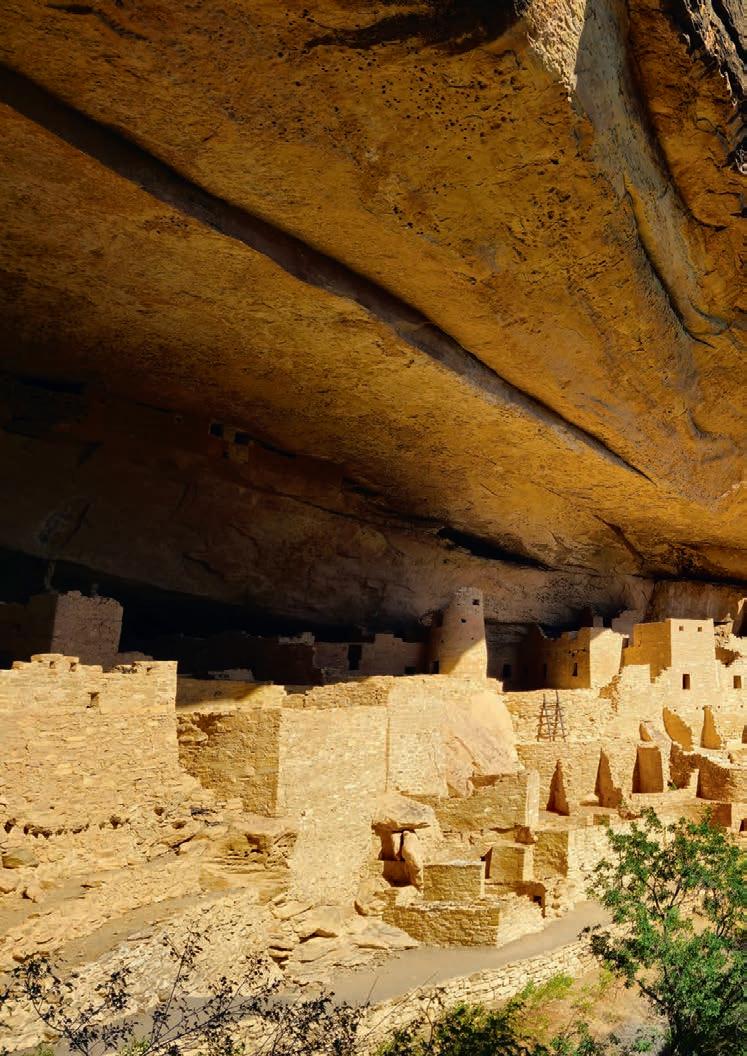
DISPATCHES
On the edge of history
In south-west Colorado lies the largest archaeological preserve in the USA, a series of vast cliff dwellings whose residents ‘vanished’ overnight. But was the answer to their disappearance in plain sight?
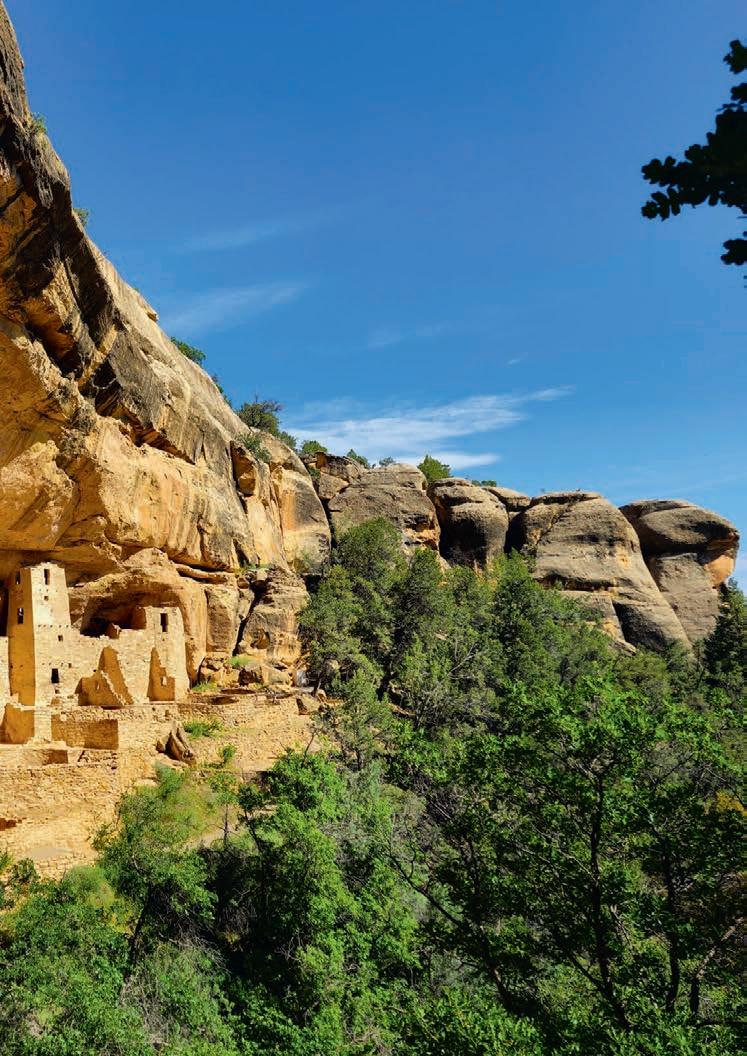
JOURNAL Colorado, USA
Words & photographs George Kipouros
“This is North America’s Machu Picchu, except it is far less well known around the world,” beamed Liz, our hotel concierge in Durango, Colorado, as she described how to find the scenic route that leads to Mesa Verde National Park.The ruins we were headed to are in fact centuries older than the more famous Inca citadel, but we would soon discover that the two locations share a similarly extraordinary setting, as well as an air of mystique around their creation stories.
MesaVerde means ‘GreenTable’ in Spanish, defined by a people who were pioneers in misnaming geographical phenomena.The site is actually a cuesta (a ridge with a slight incline), only this one is made up of many smaller flat-topped hills (mesas) that are scattered between the canyons. In reality, it is even more impressive than its name suggests.
Yet we were not here just for the magnificence of Mother Nature. In 1906, Mesa Verde became the first US national park that was protected not only for its natural beauty, but for its cultural significance. Normally, such sites are given ‘national monument’ status, but the landscapes unfolding before us were certainly worthy of their designation. For visitors, it’s like suddenly stumbling across a lost city inside the Grand Canyon.
After driving uphill for over 45 minutes, we were greeted at the park’s entrance by Eric Sainio, Mesa Verde’s supervisory ranger. Eric was eager to woo us with Mesa Verde’s pièce de résistance, the ‘Cliff Palace’, otherwise known as the most expansive site of ancient cliff dwellings in North America.
“It will be a great introduction to this place, its people and its history,” assured Eric as we walked from the car park towards the edge of a mesa.The short hike between the car and the site included rock staircases and treacherous cliffside pathways, and it proved a fascinating, if vertigo-inducing, journey, leaving me breathless, not least due to the elevation of over 2,000m.
These perilous pathways are one of the reasons why visitors must be accompanied by a park ranger when visiting a cliff-dwelling site, and booking well in advance is essential for popular spots like the Cliff Palace. Approaching it was like walking through Petra’s Al Siq Canyon and catching your first view of the Treasury.The final reveal at the end of the path was truly magical, and in timing our visit for the start of the golden hour, it meant that the whole place was bathed in a beautiful light, the ruins shining in hues of orange, red and yellow.
In front of us lay North America’s largest cliff dwelling, sheltered in an alcove on the side of the mesa and opening out onto spectacular views of the canyon below.
“The majority of this site dates from the 11th and 12th centuries,” explained Eric as he guided us among the impressively restored multi-storey edifices.“We know with certainty that this was not a palace, but early European
visitors could only attribute such architectural magnificence to a palatial residence.”
Modern archaeological research shows that this dwelling site was an important centre for the ancient community that lived here, known as the Ancestral Pueblo people. Its 150 rooms are spread across multi-storey edifices, including 21 kivas, circular rooms that are usually underground and covered by a roof of timber and soil.These rooms are common throughout the park and the broader region.
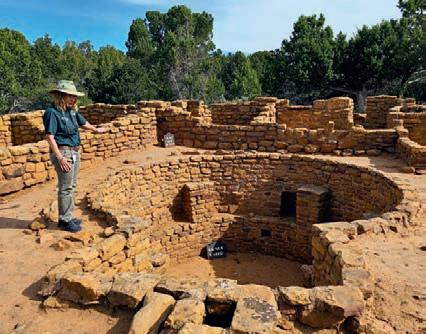
“The kivas had both ceremonial and spiritual significance, and were at the heart of both family and community,” explained Eric. Indeed, the conditions for life here were, despite the inaccessibility of the location, very good. “We knew that the people were thriving because they had corn supplies stored for up to three years,” he continued.
Dabbing the sweat from my brow, I asked why they would build their homes in such a precarious location. Eric’s answer put another spin on the notion entirely: “This was a sheltered and protected setting, rather than precarious,” he countered, going on to explain how the local people made the most of the unique geographical characteristics. For example, the Cliff’s Palace’s southern positioning meant a longer growing season with more days of sunshine, while the buildings were well protected from seasonal rains.
“There’s a lot of soil that you get to capture. You can also capture more of the monsoonal rainwater,” added Eric as he demonstrated the well-sheltered storage areas.
Mesa Verde’s generally arid climate supports a rich ecosystem of more than 1,000 species of flora and fauna. In our first few hours in the park, we had seen wild turkeys, vultures, a hawk, ravens and glimpsed a nesting pair of golden eagles. I was particularly impressed by the local yellow-headed collard lizard, whose bold colours and unexpectedly friendly nature proved endlessly entertaining.
As we concluded our visit to the palace, Eric rattled off a few more statistics, explaining that there are over 5,000 archaeological sites in Mesa Verde. Gearing up for a long day ahead, I gently fanned my forehead at the thought of it, only for him to add that just 600 of them are cliff sites, and only three of those are currently open to the public.
The park’s spectacular cliff dwellings were in fact the very last ones to have been built here, I learned. “The earliest ruins are at the top of the mesa, where most of the community lived for many centuries before descending the cliff,” Eric explained as we ended our visit by heading back topside.
Intrigued, I resolved to find out more, so the following day I joined guide Alex Prime for a cyclical drive around the earlier ‘Far View’ sites. These lie at the top of the
⊲
86 October/November 2023 DISPATCHES
“This was a sheltered and protected setting, rather than precarious”
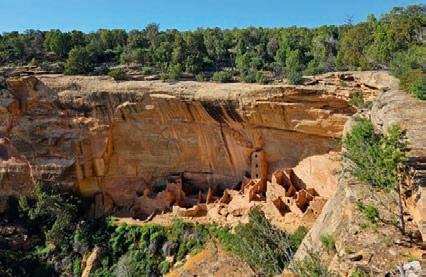

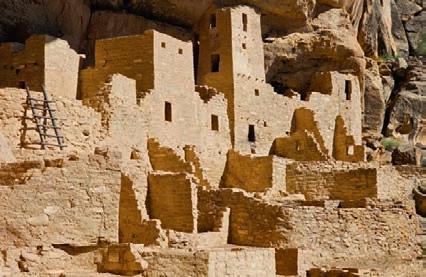
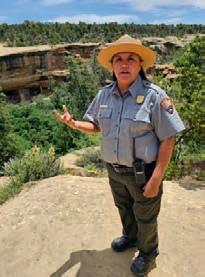


JOURNAL Colorado, USA www.wanderlustmagazine.com 87
A story uncovered (this page, clockwise from top left) Out of some 600 cliff dwellings in Mesa Verde NP, 75% have no more than five rooms, yet the gigantic Cliff Palace contains 150; Mesa Verde park director Cecilia Shields stands in front of the now off-limits Spruce House; Square Tower House nestles within its alcove; a spiral petroglyph at Pipe Shrine House, one of the lesser-seen Far View sites; another friendly lizard; ancient corn and Ancestral Pueblo pottery from the 10th century AD; (left page) Alex Prime, interpretive tour guide at Aramark Mesa Verde, points to a kiva in Coyote Village; (previous spread) the Cliff Palace in all its glory
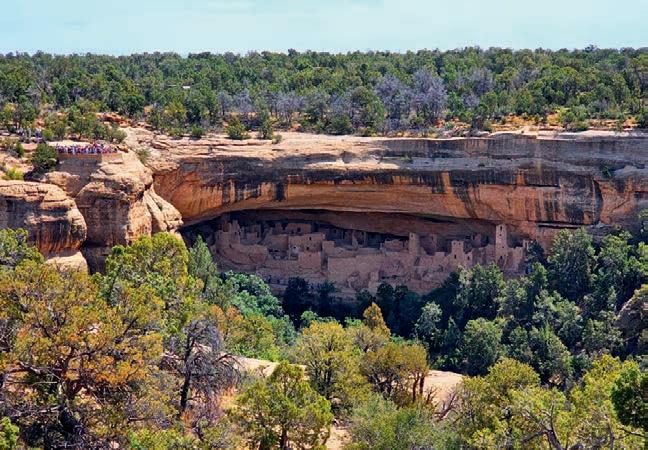
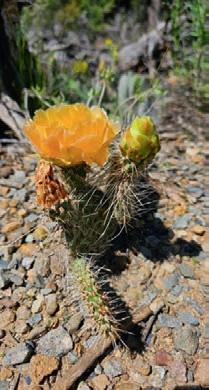
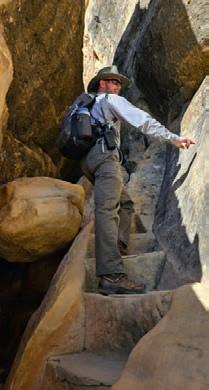

88 October/November 2023 DISPATCHES
Hidden wonder (this page; clockwise from top) Gazing across the mesa to the Cliff Palace, whose ‘rediscovery’ in the late 1800s meant centuries of deterioration caused by dripping water, wildlife and the elements could be halted; the ‘Ute Lady and Sun’ pictograph in Ute Mountain Tribal Park; Eric leads the way on the hike to the Cliff Palace; the hairspine cactus (or plains pricklypear) is indigenous to the Mesa Verde plains and North America in general, and was often used by Native Americans as a medicinal plant; (right page) Mesa Verde NP’s Navajo Canyon View lets you scan the arid landscape from an altitude of 2,130m
mesa, and Alex began our visit by telling me how the earliest settlements of MesaVerde are sometimes bypassed by visitors, who tend to head to the more spectacular cliffside sites. Yet, despite the less dramatic setting, there is plenty here to help understand the story of the people that made this vast cuesta home.
Our first stop, Coyote Village, was only excavated in the 1970s and is in a great state of preservation, even though it dates from around 900 AD. Among the five kivas found here, one giant specimen stood out. Alex explained that it may have belonged to a large clan, as each kiva would represent a different group, or family lineage.
“These were matrilineal societies, and the women had a key role to play in the community,” she elaborated.
From the viewpoint on the MesaTop Loop, near CoyoteVillage, it was easier to appreciate the grandeur of the landscape. Below us lay the spectacular Navajo Canyon, which resembled a greener version of the Grand Canyon crossed with Australia’s Blue Mountains. Scattered on the cliffsides of the mesas, we spotted myriad alcoves hiding dwellings of varying sizes. Sites including the Cliff Palace, Long House and Balcony House came into focus. From this perspective they looked almost impossible to reach, let alone build, perhaps giving one more hint as to why the people here slowly drifted down the cliffsides.
“The defensive element must have been a key one,” exclaimed Alex, while clarifying that there is no actual agreement within the scientific community as to the reason why the communities moved from the top of the mesa to the canyon alcoves below. Indeed, there is so much about this site that is shrouded in mystery, not least why the people here chose to leave towards the end of the 13th century, when the Cliff Palace was abandoned. I asked Alex if war was the reason that they disappeared, eager to understand more about how this majestic civilisation ended.
“Perhaps social upheaval had a role to play in this, but there were certainly many other factors. While the archaeological community has yet to come up with definite answers, the change in the climatic conditions, including an extensive drought affecting crops, may well have also contributed to the communities moving on. But you need to understand that the ‘vanishing people’ of MesaVerde is the biggest myth of them all,” she concluded mysteriously.
Eager to shed some more light on this, later that day I met up with Cecilia Shields, director of Mesa Verde and the only Native American head of a national park in the US. The first question on my mind was what really happened to Mesa Verde’s ancient people, and where did they go?
“The evidence is not fully conclusive, but we can make an informed guess,” said Cecilia. “Through dendrochronology we know that in the 1200s there was a massive drought in the area that put pressure on the people living here. And because everyone here is ultimately a farmer, they must be able to grow enough food to feed their family for an entire year.”
Diminishing resources coupled with social upheaval are, for many scientists, the main reasons that led to the complete depopulation of the once-bustling Mesa Verde region. But just as Cecilia finished explaining, I once more stumbled into the trap of concluding that the people of Mesa Verde had “vanished”.
“We are fighting more than a century’s worth of ‘mystery’,” countered Cecilia with a sigh of mock-exasperation. “It is a disappearance that never was, as we know exactly where MesaVerde’s people went and where their descendants still are.”
As she walked me to the on-site museum, Cecilia showed me a map of the area and explained that there are several communities that are tied to the Ancestral Pueblo people, who are named after the settlements in which they lived.
“There are 21 pueblos in New Mexico, Arizona and Texas that trace their ancestry back to the people here,” she told me. Several of these are listed as some of the oldest continually inhabited towns in the

US, dating back nearly 1,000 years. Cecilia is even a member of a pueblo community herself, having grown up in Picuris, New Mexico – one of the communities descended from Mesa Verde – and I was eager to hear more about her connections to the site beyond her role as park director.
“Our people remember to remember.We know where we came from and can retrace our steps. People still come here for pilgrimages and religious practices, and many of the traditions found here continue in our communities. Knowledge of this place was never lost and never forgotten,” she affirmed proudly.
We walked towards a viewing point that overlooked Spruce House. This was previously one of the most accessible cliff-dwelling sites, but it has been closed to the public since 2015 after major cracks were discovered in its alcove.
“Some descending tribes would want Spruce House to be allowed to collapse altogether, along with its alcove,” explained Cecilia. “There is the idea that all material goods should be allowed to return to nature once their cycle is complete.They should be allowed to finish their circle… But the counter-argument to this is that these are unique places where our people can appreciate how our ancestors lived, so there is a strong educational element too.”
Cecilia drew my attention to Spruce House’s kivas to prove her point. “Our modern-day kivas in the pueblo communities have exactly the same function as they did back then,” she continued, adding that the structures are still built underground to almost the exact same design. “Going on the idea of migration, we believe that the kiva itself represents the origin story of starting
⊲
“It is a disappearance that never was, as we know exactly where the people went”
JOURNAL Colorado, USA www.wanderlustmagazine.com 89
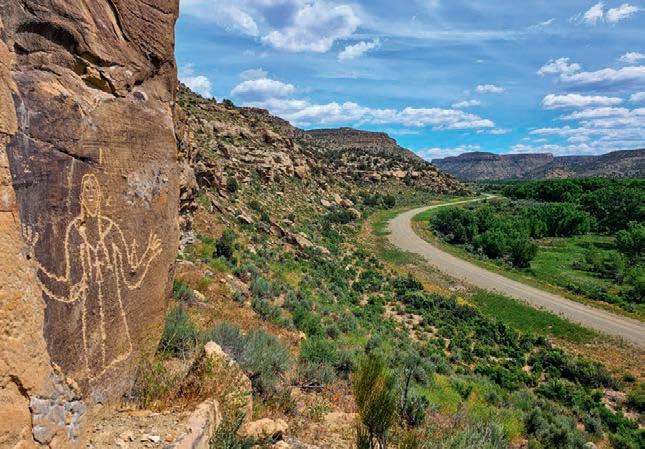

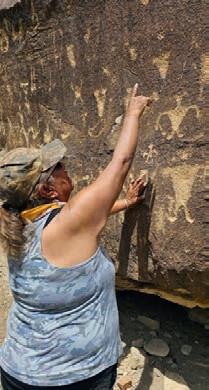

90 October/November 2023 DISPATCHES
The other park (clockwise from top left) Beverly Yazzie points up to one of the petroglyphs left behind by the Ancestral Pueblo people in Ute Mountain Tribal Park; you can still glimpse wild horses roaming the lands of the Southern Ute; the monolith at the entrance to Ute Mountain Tribal Park is known locally as Chimney Rock (1,662m) because of its shape, though its formal name is Jackson Butte, named after the photographer William Henry Jackson, who travelled here in 1874 on behalf of a government survey; the petroglyphs within the park reveal plenty about the life of the Ancestral Pueblo people who once lived here
from below and coming up into this world. It’s a circular story; the circle of life. I am not protecting this site just for my children, but for the many future generations to come. Our people were here, and we will always be here, alongside our culture, traditions, dances, songs and languages,” she concluded as we drove towards the park exit.
My next stop was beyond the park’s remit yet still connected to the Mesa Verde people and culture.We were headed to the nearby Native American reservation of the Southern Ute, who are not a community descended from the Ancestral Pueblo people, but do manage a vast area of land that once included all of Mesa Verde until the creation of the park.
While just a half-hour drive away, the landscape here is surprisingly different to Mesa Verde. This is closer to the otherworldly expanses of the AmericanWest – realWile E Coyote and Road Runner territory.
Here we met BeverlyYazzie, an experienced Southern Ute guide who would be taking us on a day visit across the Ute Mountain Tribal Park. The only way to visit this area is through a guided tour, and it is home to a significant number of Ancestral Pueblo ruins.
We started the drive up to Makers Canyon with Beverly narrating her life story and that of the park itself.The Ute are a nomadic people who roamed all the way up to Utah, Idaho andWyoming.
“We lived in the mountains as well as in the flats.We were hunters and gathers but never farmers,” said Beverly as she highlighted some of the differences between the Southern Ute and Ancestral Pueblo people. “We believe our people coexisted here with them for a time, and now we are back here again… Mesa Verde was Ute Territory, and the US government took it away from us. But at least they didn’t build it up!”
It was back in the early 1970s that the Southern Ute community started running tours of the area, offering an alternative to those of MesaVerde NP and providing a source of revenue for the community.
My experience was certainly very different to my time in the park.We started with a visit to what Beverly described as “the biggest kiva in the area”, known asThe Great Kiva. Indeed, it was larger than anything I had seen in MesaVerde, yet its roof was still fully covered. “The tribe does not want anything excavated,” she reminded me.
Beverly then pointed to the ground, urging me to look harder. “You will see a lot more if you look carefully,” she advised as we stepped
on thousands of decorated fragments belonging to Ancestral Pueblo pottery. Some of the pieces were large and ornate enough to be displayed in a museum, but that is not how the Southern Ute want them to be seen.
“We don’t put the pieces in a museum because this is where they belong, within nature, within their home,” said Beverly.
We visited multiple petroglyph sites, many dating back to the 8th century AD. They were in a remarkably good state of preservation.“The arid climate helps,” said Beverly as she continued to recover beautiful pieces of pottery, promptly showing them to me before returning them just as swiftly to the ground.
This was unlike any other ancient site I’ve experienced in my life; it had been fully discovered by humans but barely touched. The highlight was also yet to come, as we ventured 45 minutes off road, driving along an unpaved and barely visible path that splashed across parts of the San Marcos River.
There was no reception, and no map either. Instead, we simply relied on Beverly, whose unique way of orienteering involved using the landscape. While I was convinced that we were lost, I was happily proved wrong when we finally arrived at the isolated Porcupine House, deep in an alcove canyon off a cliff.This site is so well concealed that you could be standing metres from it and still miss the opening.
The wild vegetation here has not been removed, and nor has the site been restored. Nonetheless, it looked to be in an excellent state of preservation.This was as impressive as any of the sites in Mesa Verde, and yet it was completely devoid of visitors.
A giant, perilous-looking ladder marked the beginning of a path that took us to the cliff dwelling from the top of the mesa.
“They wanted to make their homes hidden from view and inaccessible so that they would be safe,” Beverly told me. I replied that this had not really been highlighted in the National Park Service narrative. “Well, we all have different takes when it comes to history, don’t we?” she smiled, seemingly amused.
“You see, we always knew about this place. My grandmother and her ancestors knew of it, and my children and grandchildren will know of it.The spirits of our ancestors still live here. Its story, just like its people, will never really vanish,” said Beverly after we emerged from the dwelling and started our drive back to the park entrance.With her words ringing in my ears, I finally realised there was no mystery here, just the continuation of a long tale; one that I too would now never forget.
NEED TO KNOW
Getting there: Both British Airways (ba.com) and United Airlines (united.com) operate non-stop flights from London Heathrow to Denver, Colorado. These cost from £520 return and take from around 9 hours and 40 minutes. From there it’s a scenic six-hour drive to Durango, and another hour to Cortez – the two nearest towns to Mesa Verde NP. Durango has a regional airport (flydurango.com) that receives internal flights from Denver and other US cities.
Booking: Make sure you book your guided tours to the cliffside dwellings of Mesa Verde NP well in advance on the park website (nps.gov/meve). Aramark (visitmesaverde.com) offers good tours of the park that are sometimes easier to book. You can also reserve a tour of the Ute Mountain Tribal Park online (utemountaintribalpark.info).
Where to stay: There is only one hotel inside Mesa Verde NP, the rather basic and dated Far View Lodge (from £131; open Apr–Oct; visitmesaverde.com). It is also the only restaurant/food concession available in the park, so stock up. We recommend you base yourself in nearby Durango, which has a walkable historic core and the excellent Strater Hotel (from £127pn; strater.com), or provincial Cortez, which has many solid options, including a characterful Holiday Inn (from £103pn; ihg.com). When to go: The park is open year-round, although snow can make some sites inaccessible in the winter. The crowds are busiest between mid-June and early September; the best months to visit are May and October. More information: For more information, visit colorado.com and nps.gov/meve.
The author travelled with support from the Colorado Tourism Office and the US National Park Service.
“The spirits of our ancestors still live here. Its story, just like its people, will never really vanish”
JOURNAL Colorado, USA www.wanderlustmagazine.com 91
THREE GREAT REASONS TO VISIT ALBERTA IN AUTUMN

Most visitors make a beeline for Alberta in the summer or winter, but go in autumn for a golden-tinged glimpse of this unique Canadian province…

Alberta is special at any time of year, but autumn has a magic all of its own. The end of summer brings with it a palette of golds, yellows and ochres to the region’s forests, and with fewer visitors and attractive accommodation prices, it’s an ideal time to visit. Here are a few more reasons to explore Alberta in autumn...

1HIKE AND BIKE AMONG THE FLAXEN FOLIAGE
There’s a crispness in the mountain air come September, making autumn a prime time for hiking. Most of the main routes will still be open and it’s a great time to explore if you want to have all of Alberta’s widescreen landscapes to yourself. Routes such as the Plain of Six Glaciers, Johnston Canyon and Jasper’s epic Skyline Trail, are justifiably popular with hikers in the summertime but when autumn arrives, it’s just you and Mother Nature in all her splendour.
For the most beautiful fall colours, head for Larch Valley and Paradise Valley, both near Lake Louise, or hike up to the famous Lake Agnes
Teahouse for some tea and cake with a majestic mountain view. Alternatively, there are several options to head off the beaten track for more dreamy autumn lakeside views, from the ochre-hued larch trees which line Healy Pass or are reflected in Bourgeau Lake. For maximum freedom, pack up your panniers and hop on a bike. Autumn is ideal for tracing scenic roads such as the Bow Valley Parkway and the Icefields Parkway in Banff and Jasper National Parks; the Kananaskis Trail in Kananaskis Country; and the Maligne Lake Road and Cavell Road in Jasper National Park. Bikepacking and bike touring offer the flexibility to explore away from the roadside, and you’ll find lots of campgrounds where you can pitch a tent for a night under the stars. Bikes can be hired around Banff, Lake Louise and Jasper.
Hiring an RV is another option, allowing you to explore at your own pace and enjoy a camping adventure without having to sacrifice comfort. You can also explore Alberta cowboy-style, with several experienced trail outfitters offering guided horseback rides that range from half-day hacks to multi-day treks deep into the backcountry.
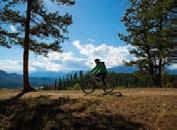
Golden backdrop (clockwise from left) Autumn casts a golden ripple over Alberta’s lakes; the backcountry trail around the Skoki Lakes is full of fall colours; Jasper National Park is great for a twowheeled view of Alberta in autumn
Autumn spotlight
Opened in 1920, the Bow Valley Parkway (Highway 1A) is the granddaddy of Banff’s scenic roads, running for 48km from Banff to Lake Louise via must-see sights like Johnston Canyon, Castle Mountain and the famous mountain viewpoint at Morant’s Curve. Drive it at dawn or dusk to maximise your chances of animal sightings, and take it slow: this is a road to savour. But it’s its pioneering monthlong pockets of closures to motor vehicles, designed to help safeguard wildlife, that make it such a legendary route for cyclists and sightseers.
PROMOTIONAL FEATURE www.wanderlustmagazine.com 93 For more information, head to: www.travelalberta.com
Tourism Canmore Kananaskis/John Price; Lukasz Warzecha; Parks Canada/Nicole Gaboury
2SEE WILDLIFE AT ITS ACTIVE BEST
After the long days of summer, autumn is the time of year when animals begin stocking up in preparation for winter. As such, it’s one of the best times for wildlife spotting. You’ll likely spy elk, moose, marmots, mountain goats, bighorn sheep, depending on where you are headed, or even a black or grizzly bear foraging for a snack before their winter hibernation. And don’t forget to look up, especially in the high mountains: there might be a bald eagle soaring overhead on the autumn breeze.
Banff’s wildlife bridges
As Banff National Park’s popularity grew in the late 20th century and the roads became busier, the wildlife looking to continue their centuries-old routes conflicted with the TransCanada Highway as it cut through the Rockies. Enter the park’s ingenious wildlife overpasses, akin to leafy bridges across the road. The first was built in 1997 and across the 25-plus years since they’ve been built, animalvehicle collisions have decreased by over 80%. Over 12 species have been recorded using them, including deer, elk, bears, lynx and coyotes. They are recognised throughout the world as a major global conservation success.
Jasper National Park
Jasper’s quieter roads offer myriad opportunities for wildlife photographers. The key is to get up early and stay out late: many animals go foraging for something to eat around first and last light. Maligne Lake Road, just to the north of Jasper, is a good place to try for wildlife spotting, especially anywhere where there are trees or scrub opening onto meadows. Bears can also be seen foraging in these areas for berries, nuts or dandelions. Route 93A, up
towards Marmot Basin; Pyramid Lake Road; and Snaring Road are also good routes to try. But to really see Jasper, enjoy a guided wildlife experience to see it through expert eyes, like those offered by SunDog Tours and Maligne Adventures.
Waterton Lakes National Park
Since it receives far fewer visitors than its larger, better-known neighbours, Waterton Lakes is fantastic for wildlife enthusiasts seeking encounters to enjoy all by themselves. Its open meadows, grasslands and lower mountain slopes are the best spots for sightings, as these areas provide important food sources for wildlife. Fall is also mating season for elk, deer and bighorn sheep, so this is the time to go if you want to see some rutting and headbutting. Look out too for bears foraging, as they will want to pile on the pounds in preparation for winter.
You don’t have to travel far to be in with a chance of a wildlife sighting: the main Entrance Parkway offers an excellent view over Waterton Valley and its main lakes. Other good wildlife roads to try include the Red Rock Parkway (which offers many hiking and
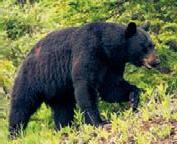
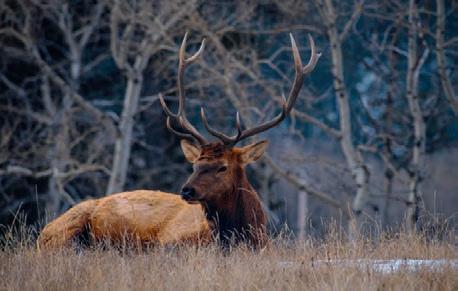
Animals in autumn (this page; clockwise from top left) Shorn of their thick coats, bighorn sheep take on a golden sheen in autumn; bull elk can be spotted along Banff’s wildlife highways; spy wood bison in Elk Island National Park; black bears can be seen prowling Jasper National Park
biking pit stops) and Chief Mountain Highway, while the Bison Paddock Loop Road offers the chance to see wild plains bison grazing from spring through to autumn from your car.


Elk Island National Park
Just 45km from Edmonton, the grassy hills and gin-clear lakes of Elk Island National Park are home to the highest density of wild hoofed animals on the planet outside of the Serengeti. The reflection of the golden larch trees in the park’s many lakes in autumn provide an idyllic backdrop from which to go wildlife-spotting, while the longer nights make it ideal for taking advantage of the park’s status as a dark sky preserve. Bison are the star attraction and are best spotted along the Bison Loop Road in the fall. They’re a conservation success story too, having been re-introduced to Elk Island in 1907 and saved from extinction. You can learn more about their story at one of the park’s bison handling facilities. The park is also home to over 250 species of birds, from red-tailed hawks to bitterns.
94 October/November 2023
3ENJOY THE DARK SKIES
With low levels of light pollution and endless open spaces, Alberta is superb for stargazing, especially as the days shorten and the skies darken in autumn. It means there’s more time to explore the constellations overhead, and the nights are still warm enough to make stargazing comfortable (although it’s still sensible to wrap up against the evening chill).
It’s possible to see many stars, constellations and even planets with the naked eye, but a decent pair of binoculars comes in handy for seeing them up close. Don’t forget to check the weather forecast: ideally, you want to be doing your stargazing when there’s little or no cloud cover, and on or around a new moon. Alberta’s wide-open prairies are often fantastic for stargazing, as the skies are usually clearer than up in the mountains. The Canadian Badlands are also famous for their fiery sunsets, while even within Jasper town you can enjoy surprising night sky visibility.
Alternatively, just team up with the experts. Jasper was named a Dark Sky Preserve in 2011 – the second largest in the world – and the Jasper
Cosmic canvas (this page; top to bottom) Camp out in Alberta’s wilderness for a magical night; the skies over Jasper National Park provide an inkblack canvas for the aurora borealis to dance on
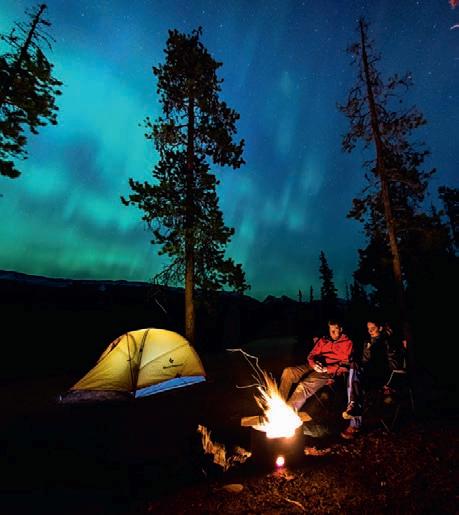
Planetarium offers nightly starspotting sessions gazing through the most powerful telescope in the North American Rockies, while indigenous star tours by Painted Warriors and Mahikan Trails will have you seeing the night sky in a whole new way. If you’re especially fortunate, you might even be treated to a display by nature’s very own light show in late autumn: the aurora borealis, otherwise known as the northern lights. Much of Northern Alberta lies within the auroral zone (the optimum location for viewing the lights), but when atmospheric conditions are right, sometimes these ethereal displays can be seen further south
One for the calendar
Held annually over two weekends in October, the Jasper Dark Sky Festival (jasperdarksky.travel) is a must-visit for star fans. Cosmologists, astronauts, physicists and astronomers come to Jasper to explore the universe alongside visitors. There’s a fine roster of seminars, talks, panel discussions and, of course, lots of stargazing. Special highlights in 2023 include a sunset performance by Cree storyteller Teneil Whiskeyjack, a choreographed drone light show and an outdoor concert under the stars, courtesy of the Edmonton Symphony Orchestra Strings.
too. It is a sight that was considered sacred by the peoples of the First Nations, and glimpsing the aurora’s shifting, dancing lights is a once-in-alifetime experience because no two nights are ever quite the same.

MAKE IT HAPPEN
Start planning your autumn Alberta adventure with these experienced tour operators…
● Canada specialist My Canada Trips’ series of itineraries in Alberta include a Dinosaurs, Lakes & Glaciers tour and a road trip through the Badlands and the Rockies.
www.mycanadatrips.co.uk

● Travel specialist Trailfinders offers various self-drive and motorhome itineraries through Alberta, such as an exploration of the Prairies, Peaks & Dinosaurs by RV before finishing up in Calgary, the cowboy capital. www.trailfinders.com
● Canadian Sky specialises in tailormade fly-drives as well as escorted travel. Their team can help you see Lake Louise in style, book a guided wildlife adventure, ride the iconic Rocky Mountaineer train, and much more. www.canadiansky.co.uk
PROMOTIONAL FEATURE www.wanderlustmagazine.com 95 For more information, head to: www.travelalberta.com
Tourism Canmore Kananaskis/John Price; Jeff Lewis Photography; Alamy; Shutterstock; Parks Canada/Ryan Bray; Jack Fusco
Tigers burning bright
As India celebrates 50 years of its Project Tiger conservation scheme, we visit the reserves of Madhya Pradesh to see how its success has impacted a tiger population that once looked in danger of disappearing
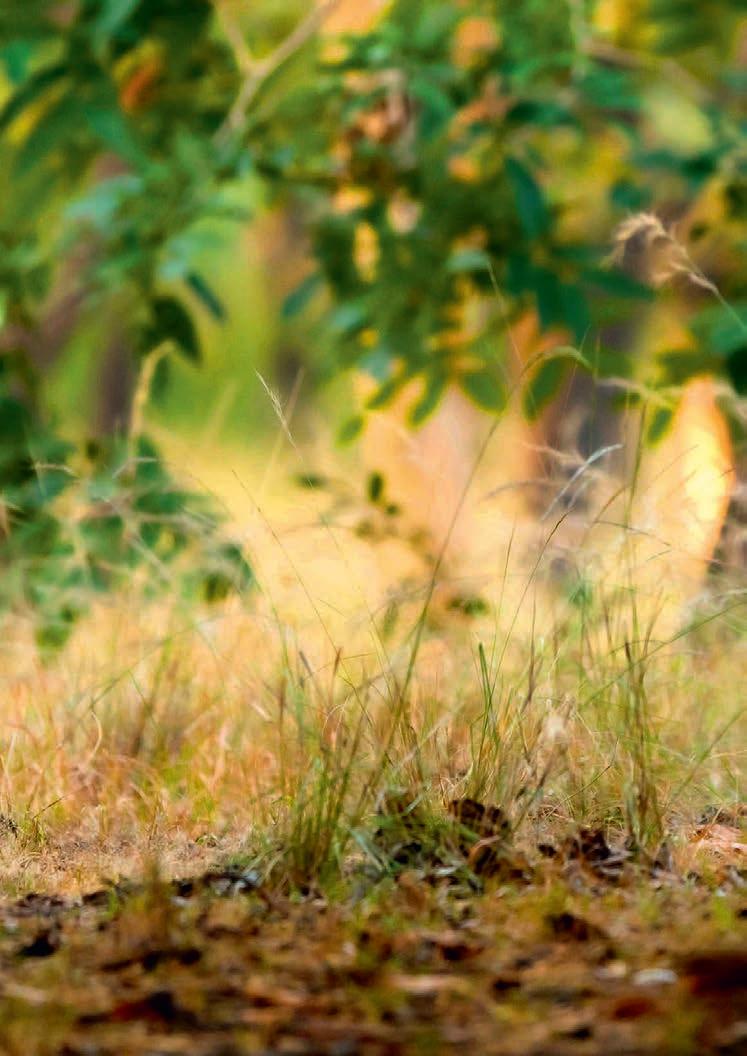 Words James Draven
Words James Draven
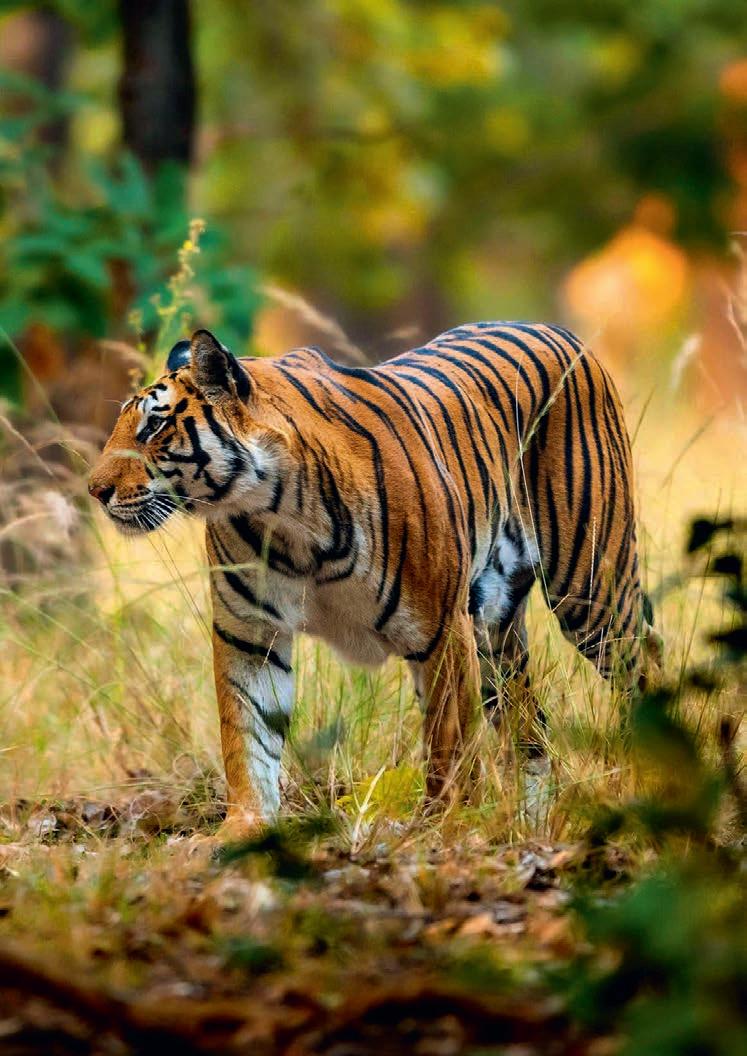
Asambar deer sniffed the air in Madhya Pradesh’s Pench National Park. In unison, the surrounding members of its herd, each the colour of rusting iron, stopped grazing from the wind-rippled grasslands. Heads lifted, glistening nostrils flared and all eyes scrutinised the tree line. A languorous grey langur monkey – drunk on fermented mahua fruit and dozing on a fallen branch – opened one eye.
You can often see langurs and sambar together. They have a symbiotic relationship because sambar can detect a predator’s scent on the breeze from over a kilometre away; in return, the langurs are sharp-sighted when up in the treetops, and messy eaters too, sloppily dropping half-eaten fruit to the sambar below. Neither makes a conscious effort to help the other, but they are inextricably linked by an ecosystem.
Then the alarm call sounded. An unseen jungle babbler bird, invisible above a thick canopy of leaves, emitted the first signal. Through the bush telegraph the call was taken up by scores of other birds until the hitherto silent forest became a riot of panic and white noise.The sambar deer scattered, and then the langurs – all suddenly sober – zipped improbably up the smooth trunks of teak trees, some with their babies clutched to their chests.
Birds took flight, their maelstrom of beating wings a hailstorm of television interference against the sky.The jungle roared like radio static. Everything was in sudden motion but us; our driver slammed his brake pedal to the floor and our emerald-green Maruti-Suzuki Gypsy 4WD – ubiquitous and identical in India’s wildlife reserves – ground to a standstill on the mud-baked track.
“That must be him,” whispered our guide,Vanan, who had previously remained silent. I’d nearly forgotten he was there; the wildlife does all the work for him. The alarm call is a guide’s best friend but, after several days spent in fruitless search of our quarry across three of India’s tiger reserves, I too was attuned to the signals that warned of approaching predators.We spent much of our time stationary: watching, listening, waiting.
It was the end of a long day searching Pench National Park for signs of a Royal Bengal tiger.With little tree cover compared to some of India’s more densely forested reserves, I had high hopes that this would be the place where I would finally spot one. About four hours earlier, we’d had a false alarm when we came across a fresh paw print, or pugmark, on the track that was the size of a saucer. Embossed into the dusty ground, on top of the fresh tyre treads of other 4WDs, the tiger must have been incredibly close, but the evanescent cat clearly hadn’t cared to stop for tea.
On this occasion, however, we had a bit more luck. From a tangle of undergrowth, which we’d already scrutinised with binoculars and telephoto zoom lenses without discovering anything, a hulking tiger languidly stepped out onto the track. Scowling, with its cover blown and its prey beyond reach, it plodded across the roadway in front of us. Regarding our idling 4WD with house-cat nonchalance, the tiger vanished into the undergrowth on the other side of
the trail, leaving a vacuum in his wake.We exhaled as one. The whole experience had lasted less than ten seconds. For just a moment, that dusty track was a stage. In the faded pastel hues of the gloaming, in a theatre encircled by packs of bill-print-grey langurs, flocks of grey hornbills and sounders of ash-coloured wild boar, the tiger hogged the spotlight, burning bright as if lit by sodium lamps. But once he exited, stage right, enveloped by the safety curtain of the jungle, my heart dropped from the gods to the foot of the orchestra pit.The wildlife chorus groaned into the distance. The greatest show on Earth was over – for now.
THE EYE ON THE TIGER
I have been besotted with tigers since infancy. So much so that despite being something of a night owl, this trip across India’s national parks and tiger reserves had seen me rising merrily each morning at 5am, when it was so cold that my camera lens – trained on dewdrop-bejewelled dawn landscapes and steam-shrouded waterholes – was clouded by my own hot breath.
But there was another reason for my enthusiasm, as this is a special year for tigers. In 2023, India marks 50 years of ProjectTiger, a conservation effort that has ensured now is the best time for sightings of these big cats in recent memory. Indeed, the number of wild Royal Bengal tigers in India has more than doubled in the 21st century alone.
Prior to this intervention, the situation had become desperate. Despite being the country’s national animal, an estimated 80,000 tigers fell victim to hunting in India between 1875 and 1925. Maharajas, monarchs, officials and trophy hunters slaughtered these creatures with guns, snares, poisons and spears.Their heads can still be found – stuffed, mounted and moth-eaten – on walls, while their skins continue to warm the floors of historical palaces.
This carnage continued well into the 20th century. Prince Philip and Queen Elizabeth were even photographed on safari with a dead tiger, which was reportedly shot by the Duke of Edinburgh in 1961 in what later became Ranthambore National Park – it was the same year he became president of theWorldWildlife Fund.The widespread practice of killing tigers for profit and sport led to a sharp decline in their numbers, and by the late 1960s, they were on the brink of extinction in the wild, with some estimating there were fewer than 600 remaining in India.
In 1973, the government, led by Indira Gandhi, initiated Project Tiger, a conservation programme aimed at managing and safeguarding tiger habitats.Additionally, the SpecialTiger Protection Force was established to combat the menace of poaching. By the time of India’s 2006 census, there were still just 1,411 tigers remaining in the wild; today things are looking far rosier. On 9 April 2023, in honour of ProjectTiger’s 50th anniversary, Prime Minister Narendra Modi released the results of this year’s All India Tiger Estimation, revealing there are now 3,167 in India. That’s about 70% of the world’s wild tiger population. ProjectTiger’s conservation initiatives have involved educating village populations near to the parks on the benefits of conserving the species; remunerating locals who
⊲ 98 October/November 2023
“In the faded pastel hues of the gloaming, the tiger hogs the spotlight“
Predator and prey (clockwise from top left) Pench NP was only a sanctuary back when Project Tiger was launched in 1973 – it is now one of over 50 national parks in India taking part in the landmark conservation scheme; sambar deer are a Bengal tiger’s favourite prey, even if their top speed is a good 10kph quicker than their tormentor; the eagle eyes of the grey langur make a great early warning system when scouting for tigers; the ruddy mongoose is a fearsome predator of snakes and even produces its own anti-venom; the Indian peafowl leaves quite the impression; a kingfisher in flight; (previous spread) the real king of the jungle

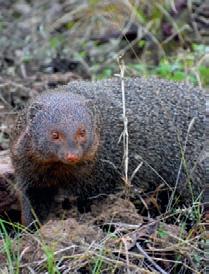
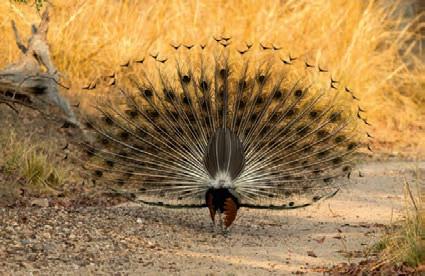
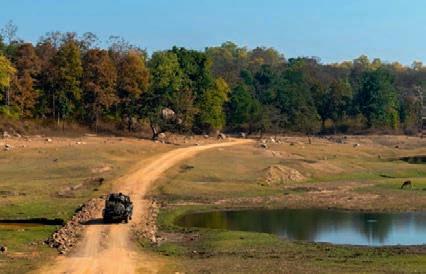
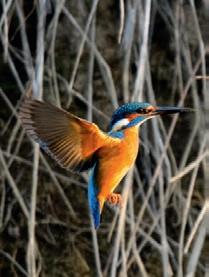

INDIA www.wanderlustmagazine.com 99
Previous
spread: Alamy; this spread: Alamy; James Draven

have lost livestock to tiger attacks; increasing the amount of protected land on which tigers can roam free; boosting the number of park rangers to combat poaching; and – most boldly of all – only allowing tourists access to 20% of any of India’s national parks and tiger reserves.This gives tigers the range and privacy to thrive, unseen, in the remaining 80%.
Yet life continues as normal in the parks. Each day at lunchtime, fleets of 4WDs would converge in the safety of numbers and wide-open terrain. Always glancing over our shoulders, it was here that we drank chai and ate packed lunches of pakoras and boiled eggs, prepared by our lodges and spread out on table cloths on the bonnets of our vehicles.Then we returned to the trails in the blazing heat and pointed our lenses at the long grasses, scanning for dips and depressions where a cat might make its bed to bask in the afternoon sun.
We also stalked the tiger’s favourite prey: sambar deer. When spooked, these animals can reach speeds of over 65kph, while a tiger can only sprint at 55kph. Since these big cats can’t outrun their prey, they need to get within 15m to strike, so the tiger has become a master of ambush hunting. It also has one big advantage: like many creatures the tiger hunts, sambar have just two types of colour receptors in their eyes, making them red-green colour blind. For them, a tiger’s orange fur is indistinguishable from the jungle greenery, which makes India’s legendary predator far more elusive. Even human eyes struggle: a tiger’s stripes look just like bamboo leaves when cloaked in the forest.
Tigers aren’t the only threat here.We also saw antelope and white-tailed deer being stalked by dholes – wild Indian dogs that hunt in packs and devour their prey alive.
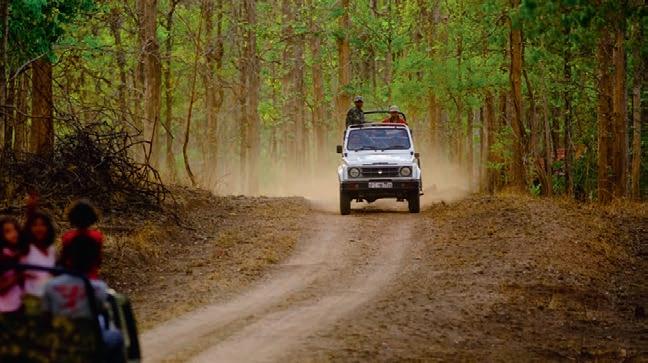
“When there’s enough of them, they can even take a tiger down,” said Vanan, rousing himself as a lone dhole skipped past our wheel arch and glanced up at us with innocent eyes.
We clocked pompous peacocks parading their plumage, and I spotted, perched on high and near perfectly camouflaged against the bark of the tree hollows, diminutive collared scops owls watching me watching them. But I saw not another tiger at Pench.
SILENT ALARM
Before long, I moved on to another of Madhya Pradesh’s famous tiger reserves, Kanha National Park. At lunch, on my second day there, I noticed a gaggle of locals and tourists excitedly passing camera screens around. As part of ProjectTiger’s initiatives to minimise the impact of tourism on tiger reserves, the use of radios and phones are forbidden in many parks.These guests had sighted and snapped a tiger in the morning, but since visitors, guides and drivers are prohibited from communicating tiger locations to each other, the occupants of my vehicle had not.
Unlike safaris seeking the African lion – pretenders to the title of ‘King of the Jungle’, since they are neither the largest of the big cats, nor do they live in a jungle – you won’t see 4WDs encircling groups of lazing tigers on sparsely vegetated savannah.These big cats are solitary creatures,
“Near perfectly camouflaged, diminutive collared scops owls watched me watching them“
⊲ INDIA www.wanderlustmagazine.com 101
Good news (left page) When Project Tiger launched in 1973, tiger numbers in India had been falling for decades. By the time the country achieved independence in 1947, there were 40,000 living wild in India; by the 1960s, some estimates were as low as 600. The nine tiger reserves that existed at the project’s beginning have since expanded to more than 50, but while recent findings reveal broad population rises and tigers moving into new areas, some parts of India (Jharkhand, Andhra Pradesh) are seeing numbers shrink, so there is still work to be done; (right page) a Maruti-Suzuki Gypsy 4WD trundles the rough tracks of Pench NP
Alamy
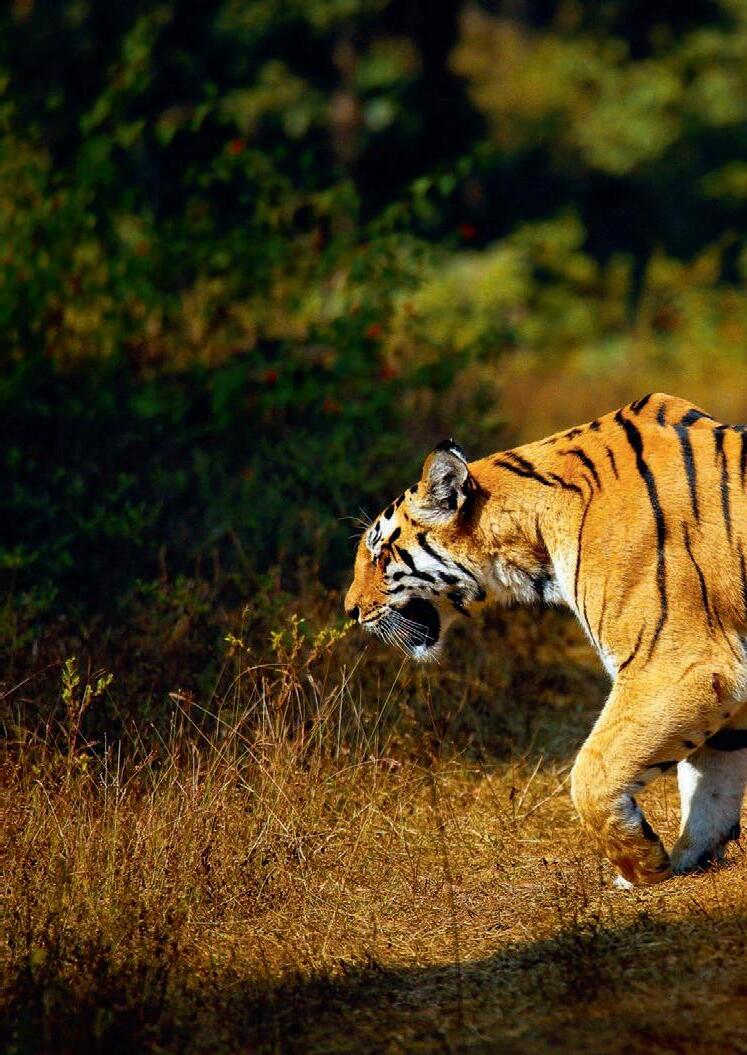

www.wanderlustmagazine.com 103 INDIA
Law of the jungle (clockwise from top left) Spotted deer have become so successful in Pench NP that their 50,000-strong population is currently being scattered among other parks in India to relieve the strain on the eco-system; a scops owl takes it easy during the heat of the day; India is home to around 70% of the world’s tiger population and their number is increasing by 6% every year; a grey langur waits next to a termite mound – an easy-to-find feast; jackals are often seen in the vicinity of tigers because they can scavenge their kills; (previous spread) sometimes you can stumble across tigers when least expected

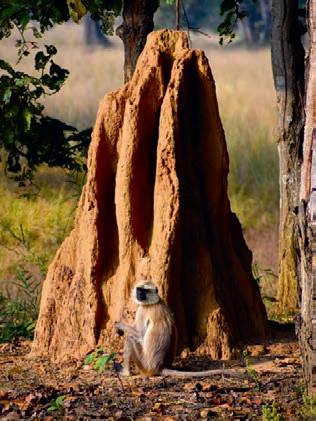


104 October/November 2023
Previous spread: Alamy; this spread: Alamy; James Draven
who only socialise to mate, and Kanha is densely forested with evergreen sal trees, which means sightings are far less frequent. If you do spot one, however, you will likely have it all to yourself here.

On our morning excursion we were graced with sightings of the endangered barasingha, colloquially known as the swamp deer, which was rescued from the precipice of extinction through Kanha’s dedicated breeding programme. In the afternoon we spotted golden jackals, a ruddy mongoose and the immense gaur – the world’s largest, wild bovine species. A male spotted deer, seemingly signifying his victory in combat to the females of his herd, wore a crown of dried grass on his antlers that, when lit by crepuscular rays, glowed with the inner luminescence of a halo.
The sun had started to set on my final drive around Kanha Tiger Reserve. As the light faded, so too did my hopes of seeing a tiger. Satish, our appointed guide for the day, had positively crackled with enthusiasm throughout our safari, but as twilight fell, his eyes glazed. In the tangled sal forests that bordered the roads, it was already nighttime. Our driver,Arun, was winding a sinuous course back towards the park gates. All was quiet, for now.
The soft pads of tigers’ feet ensure their movement through the undergrowth is almost silent.While this makes them formidable hunters, it does offer us one advantage: tigers don’t like the feel of the forest floor against their
delicate paws, so they will often take to trails that have been worn smooth by safari vehicles.
There had been no alarm calls, no shrieking monkeys, no stampedes foretokening his arrival, but nonetheless there he was. He’d been there all along, an insurmountable distance of a metre away.As he slipped out of the forest and onto the track, it was as if the tiger had pressed the mute button on the wilderness. He brought with him a deafening silence.
For the past week, across a dozen wildlife drives, I had felt like these tigers had been evading human detection, but he wasn’t hiding from us.With king-of-the-jungle confidence, he strode along the pathway towards us, staring straight down the barrel of my camera lens. He was anything but camouflaged; his vibrant coat read much more like a warning. Beautiful and deadly, dangerous and endangered, he seemed to drain the pigment from the surrounding jungle. Everything else just faded to grey.
“This is him!” gasped Satish, jigging in his seat with excitement. “This tiger is young, but he’s expected to become the next alpha male in this region.”
With juvenile insouciance, the tiger lifted his pink nose – yet to turn brown with age – and sniffed the air, inhaling the sweet scent of some blooms hanging from a tree. For a moment, he luxuriated in the belief that he was the jungle’s next monarch.Thanks to the work of ProjectTiger over the past 50 years, he may well grow to become just that. ⊲
INDIA www.wanderlustmagazine.com 105
“The tiger was anything but camouflaged; his vibrant coat read much more like a warning“



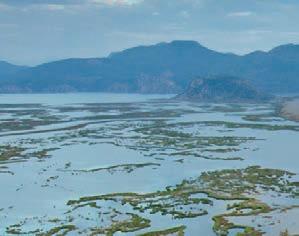
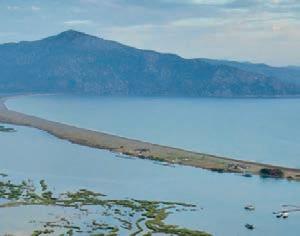












Vital statistics
Capital: New Delhi
Languages: India has 22 official languages, though there are many more.
Population: 1.42 billion
Time: GMT+5.30
Internationaldiallingcode: +91
Visas: UK nationals require a visa before travelling to India, and may apply for an e-visa (indianvisaonline.gov.in/evisa).
Some visitors may be required to apply for a paper visa (indianvisaonline.gov.in),
however, so be sure to check beforehand. In all cases, your passport must be machine readable, valid for a minimum of 180 days at the time of application and have at least two blank pages.
Money: Indian rupees (INR), currently around INR104 to the UK£. Visitors must not bring Indian currency into the country, though you can bring cash or travellers’ cheques in other foreign currencies. ATMs are available in all big cities, so it may be easier to withdraw rupees once in India.
When to go
April–June: The heat can be oppressive during this period, but this is the best time to spot tigers, which are drawn to the waterholes.
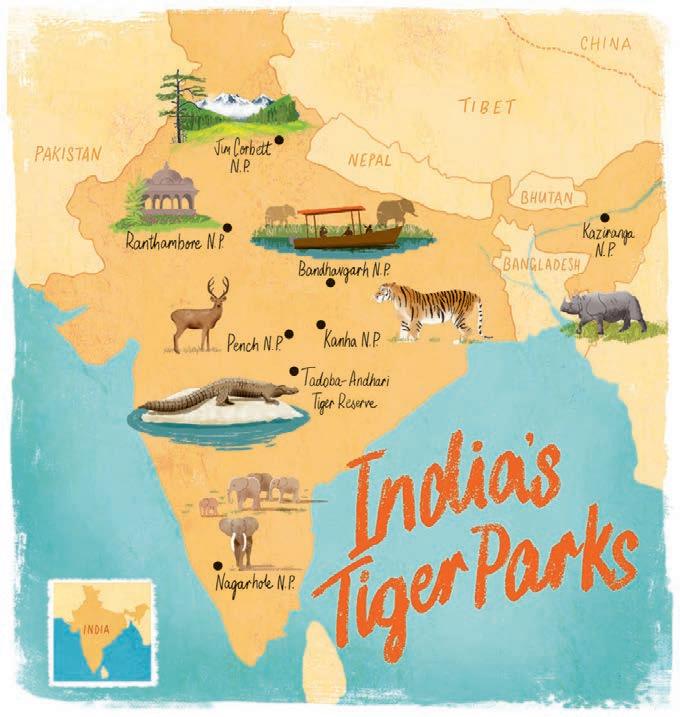
July–September: Monsoon season. Most parks are closed due to impassable tracks.
October–February: Warm, dry and sunny. This is a popular time to visit, so the parks might be busy during this period.
December–January: Cold mornings and nights, but the parks are less crowded.
www.wanderlustmagazine.com 107 INDIA FOOTNOTES
Map illustration: Scott Jessop
Health & safety
Visitors no longer need to show proof of COVID-19 vaccination or a negative test before travel. A yellow fever vaccination certificate is required from travellers arriving within six days of departure from an area with a risk of yellow fever transmission.
Recommended vaccinations for India include hepatitis A, tetanus and typhoid You should also be up to date with all your routine vaccinations and boosters, such as MMR and diphtheria-tetanus-polio.
While most of India is malaria free, the area around Kanha National Park can be a malarial zone. Always consult your local travel clinic and ensure you have adequate travel health insurance.
Getting there & around
Many airlines fly direct from London Heathrow to Delhi, including British Airways (ba.com), Air India (airindia.com) and Virgin Atlantic (virginatlantic.com). Flights start from around £500 return and take 8.5 hours.
After you arrive, train travel in India is an experience unto itself, and it’s very economical, with extensive networks connecting major cities.
A return flight from London to Delhi produces 538kg of carbon per passenger. Wanderlust encourages you to offset your travel footprint through a reputable provider. For advice on how to find one, visit wanderlust.co.uk/sustainable-travel.
Cost of travel
Train travel is very cheap, with extensive networks connecting major cities. It can cost as little as 70p for long-distance journeys, depending on which class you travel. Food is also very affordable; a meal for two in a mid-priced restaurant can cost from around £10.
Accommodation
The author stayed at various properties in the Pugdundee Safaris portfolio, including King’s Lodge in Bandhavgarh (kingslodge.in; from £195pn), Kanha Earth Lodge (kanhaearthlodge.com; from £175pn) and Pench Tree Lodge (penchtreelodge.com; from £260pn). Prices include all meals. Pugdundee runs a variety of conservation initiatives, including education funding and programmes for local kids, the banning of single-use plastics in their properties, reforestation schemes and raising money to support wildlife corridors.
Food & drink
Daal bafla is Madhya Pradesh’s most famous dish: crispy, baked wheat balls dunked in ghee and served with spicy daal, pickles or curry. Eating vegetarian is also often a way of avoiding stomach problems with street food.
What to pack
Bring binoculars and/or a telephoto zoom lens for your camera. Loose-fitting, breathable fabrics are necessary for dealing with the heat, but it’s best to wear long sleeves and trousers to avoid mosquito bites. Bring layers and a jacket if travelling in winter.
Further reading & information
India (Lonely Planet; April 2022) – Up-to-date and thorough guide book. www.incredibleindia.org – Tourism board. www.wwf.org.uk – Find out more about the dangers that tigers are facing.

The author travelled with Hayes & Jarvis (hayesandjarvis.co.uk; 01293 762456), which offers a 15-day In Search of Tigers tour priced from £6,711pp. This includes international and domestic flights; three-star and four-star accommodation; the majority of your meals; transfers, including the Agra-Katni overnight train; and day excursions to take in the highlights of New Delhi and Mumbai. The trip offers 13 exclusive safari drives across four tiger reserves: Bandhavgarh NP, Kanha Tiger Reserve, Pench NP and Tadoba Andhari Tiger Reserve.
TOP TIGER PARKS
1 Jim Corbett NP, Uttarakhand
India’s inaugural national park is also the birthplace of Project Tiger. Established in 1936, its marshlands and forests are also great for seeing wild elephants.
2 Tadoba-Andhari Tiger Reserve, Maharashtra
Maharashtra’s largest reserve has one of India’s highest tiger populations, yet it sees fewer visitors than many other parks in Central India, which makes for a more peaceful safari.
3KazirangaNP,Assam
Set on the floodplains of the Brahmaputra River, this park has over 100 tigers but was created in 1905 to save the Indian one-horned rhino; it now has the world’s largest population of these animals.
4 Nagarhole NP, Karnataka
Officials minimise vehicular impact here by using trucks seating 20-plus people, so some opt to explore by boat instead. This is one of India’s top tiger spots, and it’s the best place to see Indian elephants.
5 Bandhavgarh NP, Madhya Pradesh
Renowned for its dense tiger population, local lodges often buy entry tickets in advance to offer to last-minute visitors. Landscapes span lush forests, meadows and rocky cliffs.
6 Ranthambore NP, Rajasthan
Protected since 1973, this former hunting ground is now a top tiger reserve. The park’s ancient ruins, including an impressive fort, offer a unique setting to spot tigers.
WANDERLUST RECOMMENDS
There are more tigers in captivity in the USA than living wild in the world. Netflix’s Tiger King offers a scary insight into the practices of commercial tiger breeders.
Rise of the tiger Recent estimates state that India is now home to 3,167 tigers, which is an increase of 200 in just the last four years alone
108 October/November 2023 INDIA FOOTNOTES
James Draven



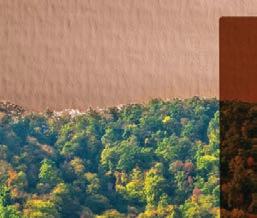
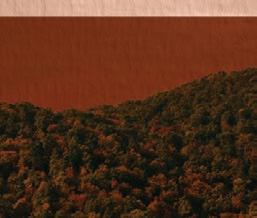

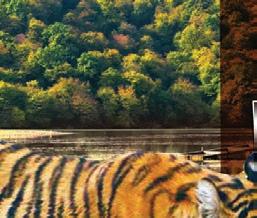
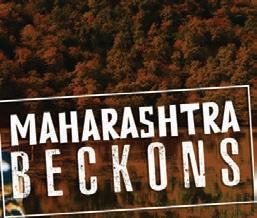



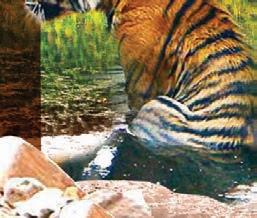


NEW YORK IN AUTUMN EXPLORE
Go beyond New York City to discover a state where the landscapes come alive with fiery hues each autumn…
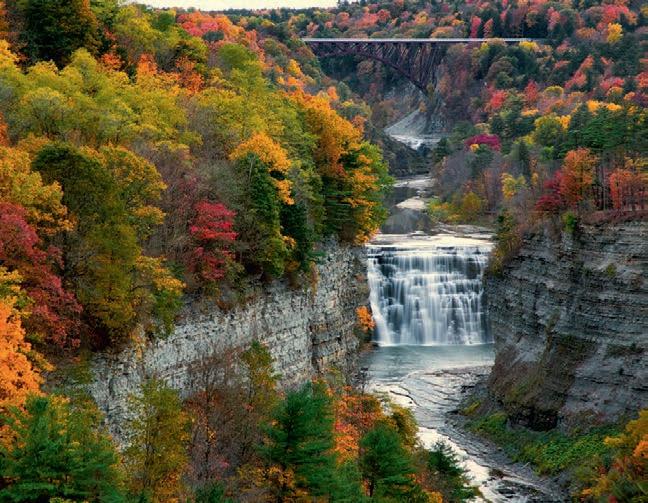
Manhattan Island, Brooklyn Bridge, Times Square: the bright lights of New York City (NYC) are legendary in their own right. However, beyond this iconic US metropolis, a wilder world awaits in New York State, with thrilling hiking trails, quaint country towns, fall foodie experiences and forest-clad peaks that glow crimson, russet and gold in the fall. Set your travel radar statewide in autumn and take a bite of what lies beyond the Big Apple...
WHEN TO GO
While we can’t always rely on Mother Nature to keep to a schedule, America’s famous fall colours can usually be seen sweeping across New York State from the last two weeks in September until the end of October or early November. The foliage in the higher regions, such as the Adirondack Mountains, usually turns fiery first, with the colour change reaching the lower points, including NYC and Long Island, later in the season, so plan your trip to follow the colours as they peak.
NEW YORK’S ‘LEAF PEEPERS’
It’s not easy keeping up with the changing colours of fall. Timing is everything: visit too early and you’ll be met by a sea of green; go too late and you’ll see nothing but brown. Thankfully, a team of locals, collectively known as ‘Leaf Peepers’, have taken on the task of recording where and when the foliage is reaching its peak and where to find the state’s most vibrant displays. Sign up for the weekly Fall Foliage Report online and you’ll have the latest news delivered to your inbox, so you can plan your own perfect leaf-peeping journey. Search for ‘Leaf Peepers’ on www.iloveny.com
110 October/November 2023
AUTUMN ADVENTURES
With more than 200 state parks and historic sites, New York State has all the ingredients for a soul-soaring adventure on four wheels – or two feet. From mountain trails and pristine lakes to a wealth of seeping waterfalls (not forgetting the iconic Niagara Falls), the region’s natural beauty knows no bounds.

DAZZLING DRIVES IN FALL
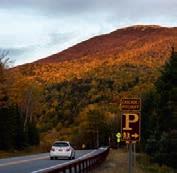
Leave the hip streets of Manhattan behind to embrace the freedom of the open road on a self-drive trip around New York State. Autumn is a glorious time to explore. The forests of the Adirondack and the Catskill mountains are cloaked in russet, ochre and gold, and fresh, sunny days offer endless opportunities to hike, bike or browse the region’s friendly countryside towns.
Epic views emerge at every bend in the Thousand Islands region, which stretches north of Lake Ontario and along the St Lawrence River, while the famous Erie Canal – which connects the Hudson River to Lake Erie, 544km to the west – is fringed by more than 200 historic canal-side
communities, each one making a unique pit stop for weary travellers. Drive east of NYC to reach the ocean, where you’ll find Atlantic white-sand beaches, verdant wineries and the upscale Gold Coast mansions of Long Island. Cruise past The Hamptons, where beachside eateries transform into cosy inns come autumn time, and out to the famous lighthouse at Montauk on the eastern tip of Long Island.
AUTUMN HIKES
Fall is a great time to hike the many kilometres of mountain, river and lakeside trails found across New York State. The heat of summer slowly subsides, giving way to cooler days

ROAM NEW YORK RESPONSIBLY
To help visitors contribute towards the protection of New York’s wild spaces for years to come, New York State Parks and the State Department of Environmental Conservation have launched the ‘Love our New York Lands’ campaign, whose free app and online resources help travellers plan ahead and learn how to truly ‘leave no trace’. Find out more at parks.ny.gov/Love-NY-Lands
Autumn spectacle (clockwise from left page) Autumn foliage fringes waterfalls in Letchworth State Park; take a road trip through the golden-coloured Adirondack Mountains; Montauk Point Lighthouse is an iconic sight on Long Island; hikes in the Adirondacks deliver sweeping forest scenes
and quieter trails, all bathed in soft autumnal light.
Hiking the dramatic gorges and waterfalls of Letchworth State Park, known as ‘The Grand Canyon of the East’, is a must. Another gem is the gorge path at Watkins Glen State Park, which winds over and under a series of tumbling cascades as the park’s river drops 122m amid soaring cliffs.
One of the world’s great trekking routes, the Appalachian Trail, passes through the Hudson Valley, yielding a range of day hikes. There is also an extensive network of trails within Hudson Highlands State Park that offers walks through the fall foliage. Hike to the top of Castle Rock to take in dazzling autumnal forest displays across the Adirondack Mountains, or explore the 42km Scenic Trail in the Catskills – a former railway line running alongside Delaware River.
PROMOTIONAL FEATURE To find out more, visit: iloveny.com/things-to-do/fall
⊲
New York State; Alamy
HARVEST HAUL
Autumn is typically a season of abundance in New York: a time for harvesting and restocking the larder, and for feasting on super-fresh produce from across the state.
VISIT A PUMPKIN PATCH
Nowhere does Halloween quite so enthusiastically as the USA, and a drive through Upstate New York in the fall will reveal plenty of tricks and treats in the run-up to the spookiest night of the year. Pumpkin patches and farms abound, offering the chance to pick your own gourds to carve into jack o’lanterns. Cosy, familyrun restaurants share the pumpkin love, serving everything from classic pumpkin pie to ice cream, spiced lattes, muffins and more for a literal taste of autumn. Pumpkins are the stars of the show for the Thanksgiving holiday in November, too, adding plenty of festive flair to your fall road-trip photos.

Bountiful harvest (this page; clockwise from above)
Pumpkins are a quintessential decoration across autumnal New York; taste fresh produce at one of New York’s many farmers’ markets; take a bite of New York at one of its apple orchards
HEAD TO AN APPLE ORCHARD

Journey beyond the Big Apple and you’ll soon find yourself in orchard country. New York is home to about 600 apple orchards, and it is America’s second-biggest producer of apples after Washington. Harvesting begins in early September, so autumn is the perfect time to stop off and pick your own fruit to enjoy on a road trip around the state. Many farms also offer hay rides, animal petting and cider tastings.
Pop into their cafés or stores to try delicious apple-cider doughnuts, fresh-pressed juices and homemade apple sauces and jams.
SAMPLE FRESH PRODUCE AT A FARMERS’ MARKET

Few things beat browsing one of New York’s 400+ farmers’ markets, meeting the locals and tasting the best produce the state has to offer.
More than 300 vendors gather each Thursday and Saturday at the Central New York Regional Farmers’ Market in Syracuse, one of the state’s oldest and largest markets. Saratoga Farmers’ Market takes place at High Rock Park every Wednesday and Saturday, with stalls selling local cheeses, honeys and arts and crafts, while the Beacon Farmers’ Market on Main Street in Beacon promotes sustainable farmers and producers from the Hudson Valley, showcasing local artists and musicians at its weekly Sunday gatherings.
ENJOY A SEASONAL TIPPLE
Whether you’re a cider aficionado, a wizard of wines or a craft-beer connoisseur, you’ll find no end of speciality tipples in New York, especially during the harvest season. All those apples are put to excellent use in the state’s cideries, which create a dazzling and delicious array of offerings.
Stop off for an orchard tour and a tasting flight at the Angry Orchard Cider House in Walden, or if spirits are more your bag, try the handmade, small-batch bourbon at Buffalo Distilling Company. Prefer the grape to the grain? Follow the 96km-long Niagara Wine Trail, stopping off to try crisp sauvignon blancs and some of the region’s unique ice wines along the way.
112 October/November 2023
MORE FALL FUN
New York’s fabulous fall colours are one of the state’s biggest attractions, but you’ll find plenty of autumn activities to enjoy between leafpeeping excursions.
GOLDEN TRAIN RIDES
Swap your four wheels for rails and hop onto one of New York’s historic trains for a scenic ride back in time. The Arcade & Attica Railroad is one of the last operating steamtrain excursions in New York State, offering ‘Fall Foliage’ tours through the countryside every October. In the Hudson Valley, the Catskill Mountain Railroad’s Harvest Train chugs through farmlands in celebration of the season each November, while the Pumpkin Express ride includes a pumpkin for passengers to carve at home.
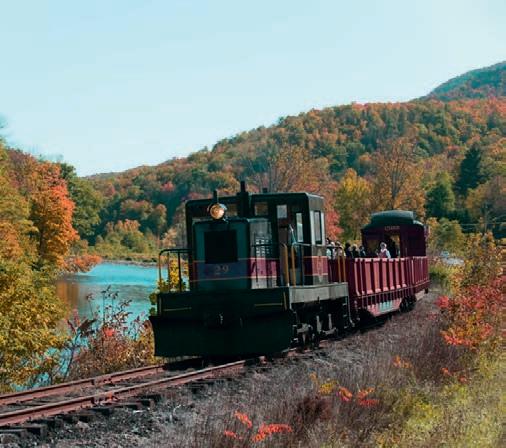
Board one of the vintage trains at the Rochester & Genesee Valley Railroad Museum to view the largest collection of historic trains in New York, or join their ‘Rails & Ales’ tour to enjoy beer tastings from over a dozen craft breweries on your journey.

SEASONAL PUMPKIN FESTIVALS

Forests quilted in fall colours, crisp clear days and cosy cafés serving super-sized portions of apple pie are the epitome of the New York State experience in autumn. How about adding in some pumpkin parties, to really seal the deal? Harvest time and the run-up to Halloween sees New York pumping with pumpkin fests, including The Great Jack O’Lantern Blaze in the Hudson Valley, which has more than 7,000 hand-carved, illuminated pumpkins on display, and The Great Pumpkin Farm Fall Festival
in Clarence, home to amusement rides, a music stage, the Pumpkin Olympics and The World Pumpkin Weigh-Off.
AUTUMN HIGHS
The best way to see the fiesta of fall foliage is from the air, and New York has plenty of exhilarating ways to shoot you skywards. For close-up views of the forest canopy, join a treetop or zipline tour. The Adirondack Extreme Adventure Course, Bristol Mountain Aerial Adventures and The Adventure
Autumn highs (this page; clockwise from above) Spy New York in fall along the Catskill Mountain Railroad; Indian Ladder Cidery and Brewery is one of the state’s many breweries you can visit; New York’s markets are well stocked with colourful produce throughout autumn
Park at Long Island offer rope and zipline courses with incredible forest views. Less strenuous, but no-less breathtaking, are the gondolas and chairlifts that will whisk you to new heights, revealing scenes of forest-clad ranges in the Catskills, Adirondacks and Bristol Hills – just remember to open your eyes.
MAKE IT HAPPEN
Specialists in creating unique, tailormade trips to the USA and Canada, America As You Like It offer a 13-night, self-drive adventure from NYC to Niagara Falls called the The Wonders of Upstate New York. Plan your trip at americaasyoulikeit.com, or call 020 8742 8299.
PROMOTIONAL FEATURE To find out more, visit: iloveny.com/things-to-do/fall
New York State; Darren McGee; Alamy
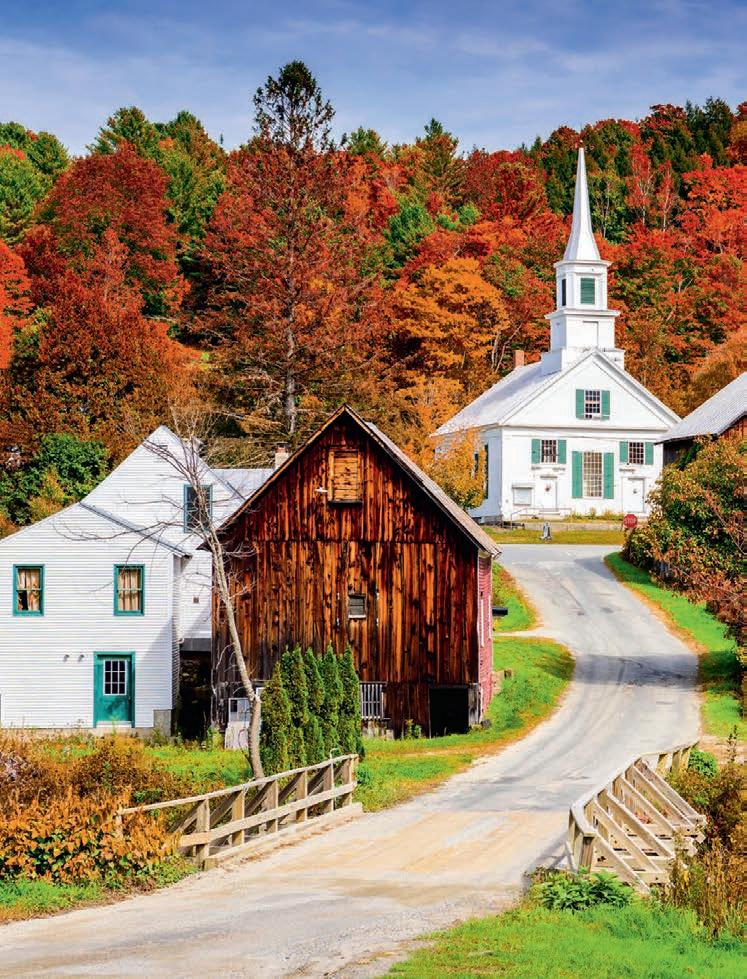
114 October/November 2023
“Ohushed October morning mild, thy leaves have ripened to the fall,” wrote Robert Frost in his ode to the American autumn, beguiled by the changing of the leaves, the ripening of the grapes and the almost imperceptible slow-down in the natural world after the frenzied heat of summer had passed. It’s no wonder he was so enchanted by this annual changing of the guard. As the weather cools and the leaves begin to turn, the USA and Canada transform into vibrant kaleidoscopes of colour.


Nature is prompted to put on its most splendid shows, from the wildly beautiful northern lights to the wildlife readying itself for winter; and with fewer crowds to spoil the view, it’s often a better time to explore the coasts, countryside and cities across the continent. Add to that a host of arts festivals, events and attractions that fill the calendar from September to November, and it’s hard to imagine why you would want to travel at any other time.
To track down the best autumnal experiences, we’ve canvassed local experts across the USA and Canada to find out what they love about this time of year.

 Words Katie McGonagle, Jim Bamboulis, Amy Bizzarri, Jennifer Broome, Priscilla Blossom, Karen Burshtein, Gareth Clark, MaryRose Denton, Carolyn B Heller, Nathalie Katinakis, Jessica Wynne Lockhart, Shelley Cameron-McCarron, Diana Lambdin Meyer, Lola Méndez, Misty Milioto, Vikki Moran, Diane Selkirk, Cristina Slattery, Rebecca Toy, Taryn White and Brandon Withrow
Words Katie McGonagle, Jim Bamboulis, Amy Bizzarri, Jennifer Broome, Priscilla Blossom, Karen Burshtein, Gareth Clark, MaryRose Denton, Carolyn B Heller, Nathalie Katinakis, Jessica Wynne Lockhart, Shelley Cameron-McCarron, Diana Lambdin Meyer, Lola Méndez, Misty Milioto, Vikki Moran, Diane Selkirk, Cristina Slattery, Rebecca Toy, Taryn White and Brandon Withrow
Quieter Time Event/Festival Weather/Nature KEY
⊲ AUTUMN IN USA & CANADA www.wanderlustmagazine.com 115
From fiery fall foliage to art fairs and harvest festivals, autumn opens up a wealth of experiences across the USA and Canada
Alamy; Shutterstock
LEAF-PEEPING FOR ALL TENNESSEE
Seeing the rich hues of autumn is a special experience. But for those who are colour-blind, those vivid shades can be impossible to tell apart. That’s why Tennessee’s state parks have introduced viewfinders that use special lenses to enable those with colour-blindness to see the leaves in all their bright, blazing glory.
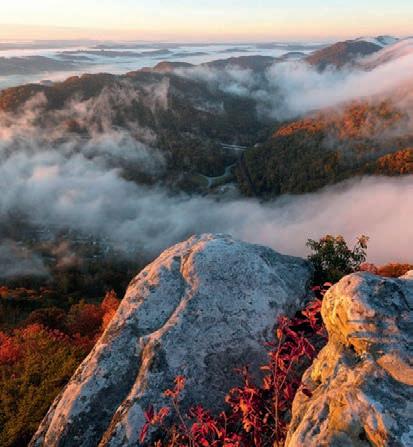
Leigh Gardner, ranger at the Justin P Wilson Cumberland Trail State Park, says: “People who cannot perceive red-green colours can use these viewfinders to see the autumnal colours change. We have an Access 2030 initiative to create more accessibility – paved trails, parks with all-terrain wheelchairs – so folks with limited mobility can see more of the park, and we don’t charge an entry fee because we’re trying to make sure that the parks remain accessible to all.


“The waterfalls start to pick up toward the end of fall, so if you’re lucky, you’ll get that waterfall-autumnal colour combination as you enter the final weeks of November.” KM
EMBRACE TRADITIONAL CELTIC HERITAGE IN CAPE BRETON

You can’t talk about fall on Cape Breton Island without mentioning Celtic Colours International Festival, a nine-day musical and cultural romp that brings the island community together. Gaelic-speaking Scottish Highlanders brought music, dance and language to the eastern edge of North America nearly three centuries ago, and it has been passed down the generations to form part of today’s living culture.
Mabou native Dawn Beaton, the festival’s artistic director (and a talented fiddler), says: “Fall in Cape Breton is tough to beat. The highlands burst into colour, accompanied by the sound of fiddles, guitars, Gaelic singing and step-dancing.

“Celtic Colours takes place every October and offers an islandwide window into this culture, with concerts held in community halls, schools, churches and theatres. As you drive the island, look for workshops and community turkey dinners, or join in on a family square dance or milling frolic.”

SCM
116 October/November 2023 AUTUMN IN USA & CANADA
Alamy; Shutterstock; Ryan MacDonald
TAKE IN WINE AND HIGHLANDS IN SONOITA, ARIZONA
Just 45 minutes’ drive south of Tucson lies Sonoita. This is wine country, and as far removed from the cactus-strewn deserts of Arizona as you’ll find, especially when the grape harvest gears up in autumn and the slopes still glisten green from the August monsoon, explains Todd Bostock of Dos Cabezas Wineworks.
“South of Tucson, the road starts to climb, the hills begin to roll and you can reach up to 1,300m. It’s quite a bit cooler up here, so back in the 1970s, when they were looking for places
FOLLOW THE BIRD MIGRATION ALONG THE GEORGIA COAST
“Little St Simons Island is the jewel of the Georgia coast,” says Stacia Hendricks, director of special projects at The Lodge on Little St Simons Island. “Geologically it’s quite young – only about 4,000 years old – but it is one of the few remaining islands that was never harvested of its canopy.


“Georgia’s coast has 14 major barrier islands and five major river systems, so we have estuaries where freshwater and saltwater mix, making great feeding sites for migratory birds. The peak of that migration is late September and early October.”


This is the time to spot red knots, which travel from the tip of South America to the fertile feeding grounds of the Arctic, along with black-bellied plovers, long-billed curlews and rainbow-bright painted buntings.
“My favourite is the American oystercatcher. It’s an extraordinary bird that can live up to 40 years and eats a bushel of oysters each day. It’s not just happenstance that birds stop in Georgia; the more we learn about the journey, the more astonishing it is. This has been going on for millions of years and we are only beginning to scratch the surface of understanding.”
in the Four Corners states to grow high-value, low-water crops, they picked Sonoita as having the most potential for cultivating wine grapes. Our vineyard now grows 30 varieties.

“There are ten wineries open for tastings in the area, and services in Tucson can pick you up and drop you off for the day. We’ve also got the Santa Rita Mountains on our doorstep –Mount Wrightson (2,882m) even has grapevines growing wild on its slopes. It’s dry and warm in early autumn, so pack a picnic and head out.” GC
Autumn in the Black Hills revolves around one thing: buffalo. Custer State Park’s annual round-up, held on the last Friday of September, sees visitors flock to watch cowboys wrangle the 1,400-strong herd and visit the park’s annual craft market, says Lydia Austin, visitor services supervisor at the park.
“Wildlife in the Black Hills was once hunted to extinction by miners and homesteaders. So, when the park reintroduced buffalo in 1914, we let them roam free, but they soon began eating us out of house and home. It was decided then that we needed to manage the herd.
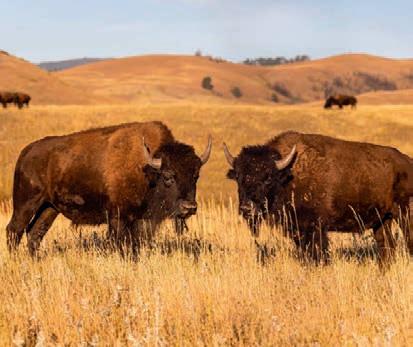
“We did this at first by butchering them, which took off during the Second World War because buffalo meat wasn’t part of the rationing programme. Then, by the 1960s, more and more people were starting up ranches, so we rounded up the buffalo for an auction instead. It took off.
“Now you can buy everything here from street food and bull whips to actual buffalo during this period. But it all stems from the annual drive, which is still a vital part of herd management in the park.” GC

KM
⊲ www.wanderlustmagazine.com 117
WATCH THE BUFFALO ROAM IN SOUTH DAKOTA
LOOK TO THE SKIES IN UTAH
On 14 October, an annular eclipse tears across the skies of a large chunk of North America, between Texas and Oregon. Lying slap-bang in its path is Utah, the state with the highest concentration of certified Dark Sky areas in the world, explains Jason Trump of Salt Lake City’s Clark Planetarium.



“During an annular eclipse, the moon doesn’t completely cover the sun, so you’re left with this incredible ring of fire that hangs in the sky. If you’re in the optimum location, this can take place for around four or five minutes, but the entire eclipse lasts up to three hours and the viewing path runs right through the central part of the state.
“To see it, head either to Natural Bridges National Monument, the world’s first International Dark Sky Park, or Bryce Canyon NP, which has incredible red-rock hoodoos as its backdrop – plus, you get clear views of the Milky Way at night. The latter also runs regular constellation tour programmes, full-moon guided hikes and has astronomy rangers who can point out all the constellations if you’re interested in night-sky tourism.” GC
SEE ECO INITIATIVES IN ACTION IN THE MISSOURI OZARKS
“We led the country in saving our streams: these were the first freeflowing rivers to be preserved and protected by the National Park Service, creating the Ozark National Scenic Riverways,” says travel writer and keen kayaker Barbara Ostmann, who grew up in the Arkansas Ozarks before later hopping the border to live on the Missouri side.
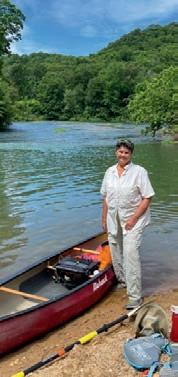
“There’s huge citizen participation in taking care of our rivers. We have thousands of ‘Missouri Stream Teams’, where people adopt sections of the river and are responsible for keeping them clean – and they are crystalclear,” she adds.
The Ozarks have the highest concentration of first-magnitude springs in North America, which pump out more than 2.8 cubic metres of water per second. The area’s conservation efforts extend to the land, where a former railroad corridor is being turned into Rock Island Trail State Park.
“If you want to canoe the rivers or go hiking, the crowds drop off in fall. During this season there are fewer people, the trees are gorgeous and you can see squirrels gathering up their acorns. If you take the time to look around you, it’s a wonderful show.” KM
Shutterstock 118 October/November 2023
Alamy;
CELEBRATE DAY OF THE DEAD IN SAN ANTONIO, TEXAS

San Antonio’s Day of the Dead celebrations in late October and early November are now the biggest in the USA. Given the city’s large Hispanic population (63%), it’s no surprise, says local chef Johnny Hernandez, who helped start the downtown festival less than two decades ago.

“The festivities have grown year on year. La Villita, the historic downtown and birthplace of San Antonio, now sees over 75,000 people arrive for the festivities, and many head straight to the riverside to watch the parade of themed barges.
“The main festival is on Alamo Street, with vendors, DJs and three performance stages, as well as the Culinaria Tasting Texas food festival, run by the James Beard Foundation. We also have
an amphitheatre (Arneson River Theatre) where you can hear mariachi bands perform live.
“If you want to learn about the holiday, which is centred on remembering the dead, the festival runs workshops for visitors. These allow you to see how the traditional altars (ofrendas), which are assembled for departed loved ones, are made and what their different elements mean.
“But don’t just stick to downtown. Try to visit the cultural centres in the old Hispanic neighbourhoods, which have been celebrating this day for over 50 years. Both the Guadalupe Cultural Arts Center and Centro Cultural Aztlan organisation put on incredible art and altar exhibitions in the community.” GC ⊲
AUTUMN IN USA & CANADA www.wanderlustmagazine.com 119
SEE THE MILKY WAY IN NORTH-WEST NEW MEXICO
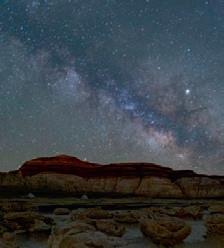
The incredible rock formations of the Bisti/De-Na-Zin Wilderness – set in the San Juan Basin of north-west New Mexico – are an impressive canvas for hikers and photographers by day; however, come nightfall, there are more spectacular sights to behold.
“The fall season is unique because the Milky Way and the stars are visible at the end of our sunset tours, on the walk back to the trailhead,” says Kialo Winters, founder of Navajo Tours USA. “It’s an awesome experience to see a blanket of stars, and a lot of guests actually break down crying. We also offer storytelling based on the night skies and how they link with our creation story.”
Kialo is Diné and Zia Pueblo born, brought up on the Navajo Nation reservation east of Chaco Canyon. He spent 15 years as a teacher integrating Navajo culture and language into schools.

“It’s important to us to model sustainable tourism practices to protect and preserve our ancestral lands for future generations to enjoy, and also to respect our Indigenous heritage and traditions. We hope to leave a lasting impact of enrichment and understanding of our Indigenous communities.” KM
CELEBRATE INDIGENOUS CULTURE IN PUERTO RICO
In mid-November, the town of Jayuya commemorates the original inhabitants of Puerto Rico: the Taíno. Concepción Cruz, who is on the board of directors for Jayuyano Alberto Suárez Martínez Cultural Center, explains what it means to modern Puerto Ricans.
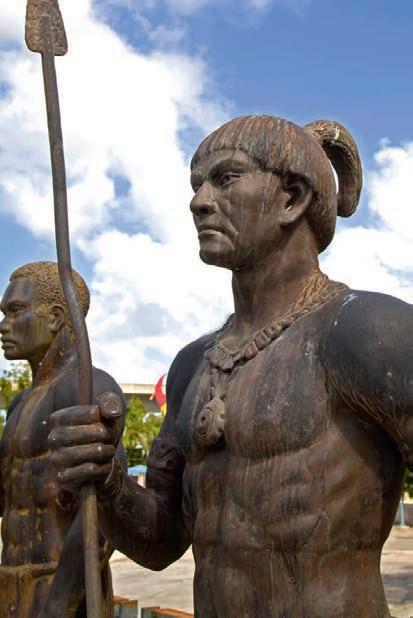
“In 1969, the Cultural Center, which is a non-profit founded to promote, protect and defend our culture, developed the Festival Indigena Jayuya to honour the Taíno as the guardians of our town. In doing so, it unites everyone on the island by opening our doors to thousands of Puerto Ricans and visitors of every nationality.
“During the festival there will be hundreds of local artisans with links to Taíno customs and traditions, while young people of Indigenous descent dress in colourful outfits, designed and made using materials such as seeds, vines and stones.
“We also celebrate the game of batu [a Taíno ball game]. Locals will play drums and fototos [shells that emit sounds], used by the Taíno as a communication tool, while the Dancers of the High Land will perform to the sound of areytos, religious singing, dancing and poetry.
“In the Nemesio R Canales Public Square that weekend, you can also find bohío huts and areas that recreate the life and work of the Taíno, plus there will be lots of typical Puerto Rican food and drink to try.” GC
120 October/November 2023
Alamy; Shutterstock; Jon Reed Photo
DISCOVER AMERICA’S NEWEST NATIONAL PARK IN WEST VIRGINIA
New River Gorge is the USA’s newest national park, set among the ancient Appalachian Mountains. It’s a haven for outdoor enthusiasts, but while autumn is ideal for climbing and white-water rafting, you don’t have to chase an adrenaline rush to enjoy this gem.
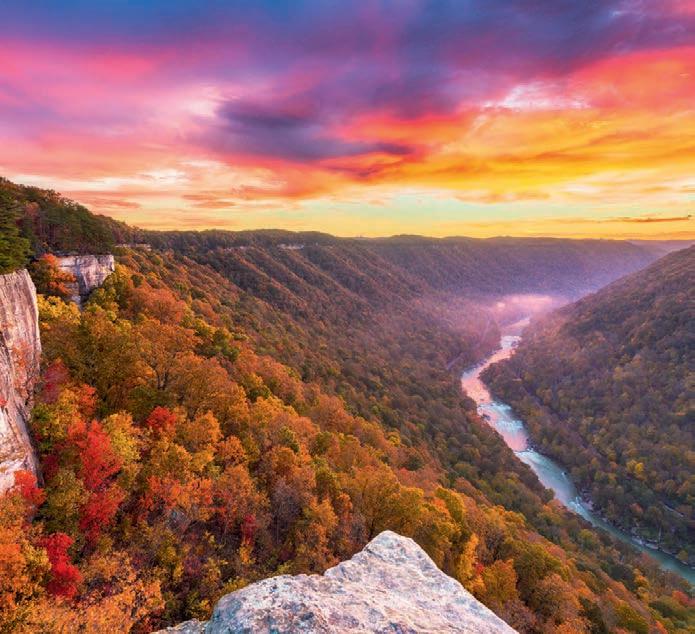
Eve West, the park’s chief of interpretation and visitor services, says: “We are considered one of the most botanically diverse river systems in the central and southern Appalachians. We have phenomenal fall colours, [but] when the leaves

start dropping from the trees, it’s a great time to see things normally hidden by the foliage. You can spot the foundations of coal camps, hospitals, houses… cultural sites that you could walk right by in the summer now stand out.”
Wildlife also comes out of hiding as the heat subsides and the crowds thin. “New River is one of the best birding parks in the US, and the fall warblers will be migrating through at this time.”
There are guided, themed hikes during Hidden History weekend in September, and in the following month, you can watch base jumpers leap 276m off the New River Gorge Bridge as thousands of people cheer them on. RT ⊲
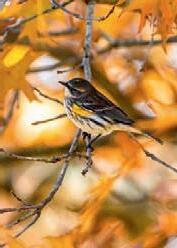
AUTUMN IN USA & CANADA www.wanderlustmagazine.com 121
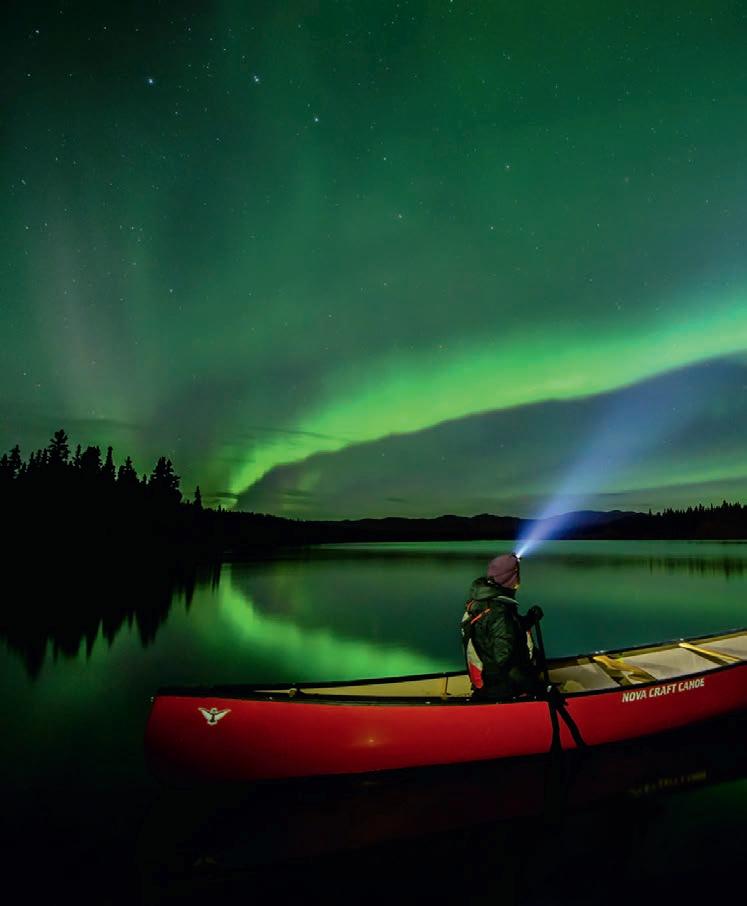
122 October/November 2023 AUTUMN IN USA & CANADA
PADDLE UNDER THE AURORA BOREALIS IN THE YUKON
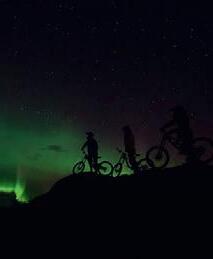

Amid the extreme environment of Canada’s Yukon, you have to grab opportunities while you can. Autumn is a great time – before the ice sets in at the end of October – to kayak across Lake Laberge, as the aurora borealis fills the sky and reflected green, purple and blue lights bounce off the water.
Making the most of that weather window is key, according to Dan Sams , owner of Terra Riders in territory capital Whitehorse, which runs canoe tours on the lake. He says: “We have a campfire with hot drinks and marshmallows. If you end up with no [aurora] display, you still get to see uninhabited wilderness and a night sky with zero light pollution, followed by a paddle back under the stars.”
Locals make the most of the pre-winter weather too, and there are a host of events to take part in. The Mount Lorne Mis-adventure Trail Race, Dark Sky Festival, Gravel Growler bike event and Yukon Beer Festival all take place in September and October, bringing this small but tight-knit community together. CS

⊲ www.wanderlustmagazine.com 123
Michael Hynes; Justin Kennedy
RAISE A BEER AT OKTOBERFEST IN KITCHENER, ONTARIO

Kitchener was known as Berlin until 1916, and German influence –dating back to the late-18th-century Mennonites who arrived here from Pennsylvania – remains strong in this Canadian city. It also claims to have the second-largest Oktoberfest in the world, and the festival’s executive director, Tracy Van Kalsbeek, says people “really feel they’re in Germany”.

“It‘s the 55th year of the KitchenerWaterloo Oktoberfest, and although our German heritage is a major part of it, our community looks very different now. Oktoberfest is an important cultural event that celebrates our [region] as it is today, but also brings people together to experience Bavarian culture and German flair.
“Besides Oktoberfest, fall in the Waterloo region is a great time because it’s harvest, with plenty of field-to-fork experiences on offer,” adds Tracy. “We still have good weather, most of the attractions are open and there’s the Grand River where visitors can kayak or canoe. Our hiking trail system is also great, and when the fall colours are in bloom, it’s a beautiful time of the year to be outside.” JBa
RIDE THE RAILS IN NEW HAMPSHIRE

Tourism is nothing new in the rocky peaks of the White Mountains, which have been drawing travellers for centuries to their forested slopes, swathed in red maple and American beech trees. The woodlands are ablaze with fiery colours come fall, and a ride on the Conway Scenic Railroad’s Mountaineer train puts this on full view, all while recapturing an era of travel that has long since passed, thanks to its 1950s Budd Vista-Dome carriages and Art-Deco-style dining cars.
“It’s a heritage railroad with heritage equipment. The train lends an experience to the journey that you just don’t get from a car,” says railway enthusiast and author Brian Solomon.

“You start your journey at a Victorian station, which was built in 1874. It has retained its classic architecture in the waiting room, old ticket office and high ceilings. After that, you work your way west.
“The most impressive view is when approaching Crawford Notch, as you come across the Willey Brook Bridge, past the site of the old Mount Willard section house that sits isolated on the cliffside. You get a stunning view across the Saco River valley, and if it’s been raining, there are several waterfalls that cascade down the mountains. There are views up there that you’d never see from the road.” KM
124 October/November 2023
Alamy; Brian Solomon; Kris Solomon; Shutterstock; Tomasz Adamski
GET SPOOKY IN SALEM, MASSACHUSETTS



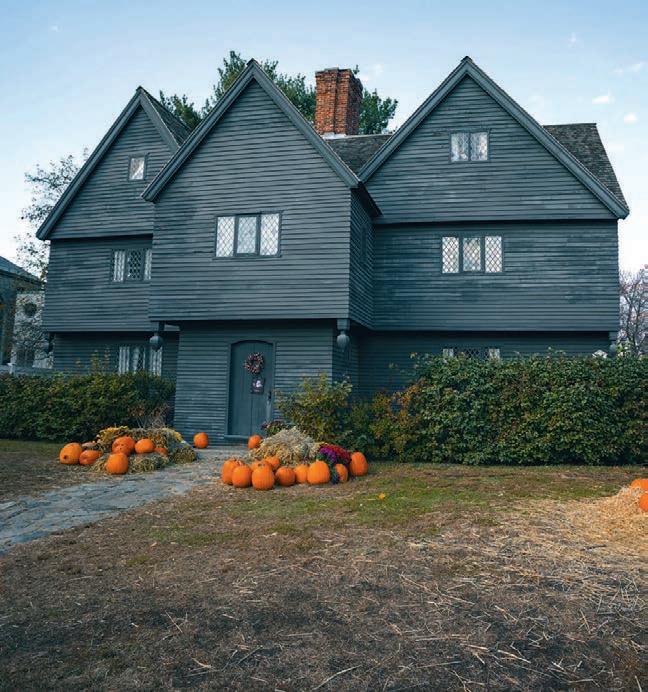
The ‘witch city’ of Salem is famed for its long history of magical happenings, making it an especially spooky spot to explore come Halloween.
“Autumn is simply a special time, as people are enjoying the spirit of Salem during one of the largest Halloween celebrations in the world,” says Leanne
Marrama, tarot reader, witch high priestess and co-owner of the Pentagram Magick Shop.



“People walk the streets in costumes starting in September. Magical experiences include the Witch Walk at Crow Haven Corner and the Haunted Happenings parade with vendors, music, food and performances. Halloween Samhain is also one of the four quarterly festivals where witches celebrate and communicate with their ancestors.”

AUTUMN IN USA & CANADA www.wanderlustmagazine.com 125
LM ⊲
PLAY BRIDGE BINGO IN VERMONT
Vermont is known for having more than 100 historic covered bridges – that’s more per square metre than any other US state. Each has its own architectural style but all were designed for the same purpose: to protect their decking from the harsh Vermont winters (though they also kept horses from being spooked by the running water below).
These 19th-century steel-free structures have earned countless fans, including Heather Hassett , owner of Vermont Confectionery, a store selling local products in the quintessential New England town of Bennington.
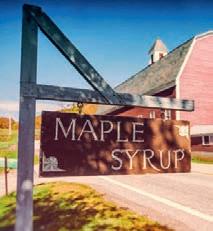
“I’ve lived here all my life, and seeing the bridges in fall still takes my breath away,” she says. Diehard devotees can try to identify the bridge builder by the style of truss, while photographers can simply focus on snapping them with flaming autumnal foliage surrounds.
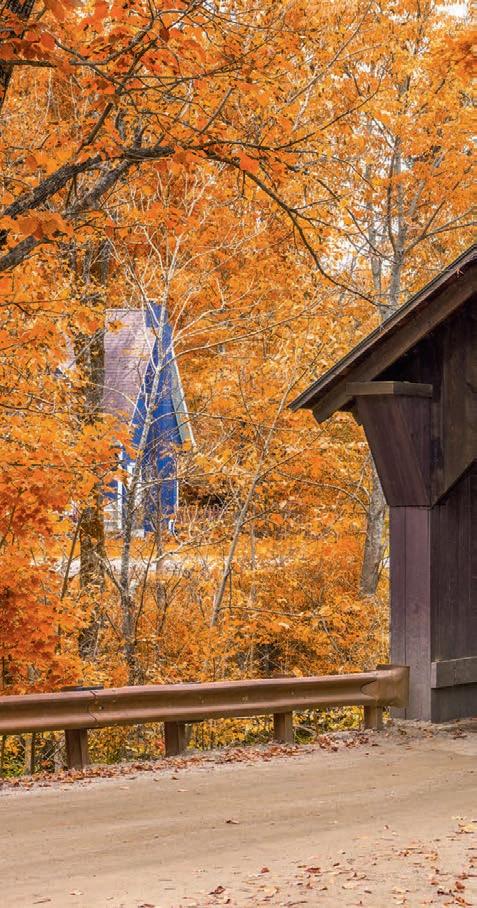
The state’s south-west corner has five bridges in close proximity – three in Bennington and two in nearby Arlington. Hassett says: “Pick up some cider, Vermont cheese and maple or pumpkin products in town and then stop for a picnic next to Henry Bridge, which has a pull-off area with tables.”
Finish by driving to the Paper Mill Bridge to see its “lovely waterfall”, followed by the Silk Road Bridge. Take it slow, advises Heather: go one car at a time and don’t be the person who tries to manoeuvre a camper van under a covered bridge! KB

Shutterstock ⊲ 126 October/November 2023
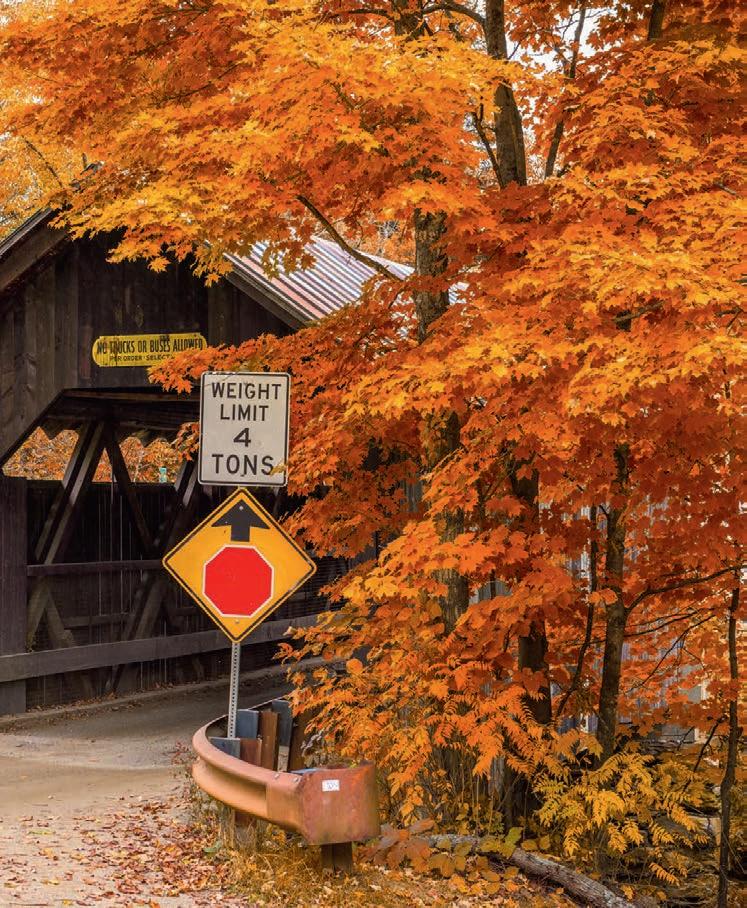
AUTUMN IN USA & CANADA www.wanderlustmagazine.com 127
“Fall is a great time to slow down and catch your breath here [in the Bay of Fundy]. We’re not a park you want to rush,” insists Nancy Lockerbie, general manager of the Fundy Trail Parkway, which follows the billowing outline of the cliffs overlooking Canada’s New Brunswick coast. The parkway also marked its 25th anniversary this year and is set to become an official provincial park from 2024.
“It’s one of the last remaining coastal wilderness areas on the Eastern Seaboard, so the park and parkway have been created out of nothing. There are 21 lookouts where people can see the magnificent Bay of Fundy, where we have the world’s highest and lowest tides.
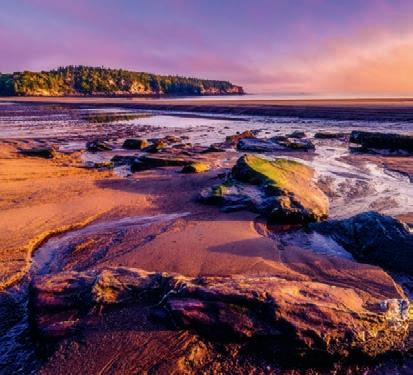
“One of the highlights is Walton Glen Gorge – some people have named it the ‘Grand Canyon of New Brunswick’ – and now we have an electric shuttle to take people who couldn’t do that hike to the observation point. It’s spectacular.” KM

SET SAIL FOR MYSTIC, CONNECTICUT
“Mystic was once one of the biggest wooden shipbuilders in America,” says Peter Armstrong, president of the Mystic Seaport Museum. “These days it’s the quintessential New England town: all the shops are independent, life revolves around the water, and the colours in fall are magnificent.”
The museum spans the river for a kilometre, recreating a 19th-century seafarers’ village. It rents out boats and even has its own shipyard –“Probably the last on the East Coast,” says Peter, who recommends sailing beneath the tree-lined banks of the Mystic River or strolling the riverside

JOIN IN WITH A COMMUNITY CAMOMILE HARVEST IN WASHINGTON STATE

Nestled in the foothills of Washington’s North Cascade mountain range sits Willowbrook Manor English Tea House and Farm Stay, where visitors can witness the vibrant reds and golds that carpet the Pacific Northwest landscape deep into the fall months.
But it’s more than just a beautiful view: homegrown camomile sends sweet floral notes swirling into the air during the Autumn Harvest Tea, when owner and operator Terry Gifford invites the local community to help harvest the crop, followed by cups of camomile tea and scones – with all proceeds going to help those in need.
“People come to the farm to celebrate the wonderful colours and flavours of fall,” says Terry. “The garden tour takes guests down a long path covered with a canopy of wisteria, leading to a large patch of aromatic Roman camomile. I call it ‘the giving field’, because this is where the community comes together for special events like camomile planting, weeding and harvesting. These tea-and-work parties raise awareness and funds for homeless families in our area.” MRD
to Gravel Street to spy the old captains’ houses.

Autumn is also festival season. In October, the museum welcomes a folk festival and food fair to the waterside. The 15th of the month also sees fireworks light up the city’s cantilevered Bascule Bridge, while the Taste of Mystic food fest returns to Olde Mystick Village in early September.
“But when it comes to food, you can’t visit in fall without stopping by Clyde’s Cider Mill,” says Peter. “Its cider doughnuts and biscuits are superb.”GC


SLOW IN
TAKE IT
NEW BRUNSWICK
128 October/November 2023
Alamy; Mystic Seaport/Joe Michael; Shutterstock; Willowbrook Manor
GO APPLE PICKING IN THE ORCHARDS OF QUÉBEC

Autumn in Canada’s Laurentian Mountains brings with it a sensory feast, says Nathalie Labonté, owner of Labonté de la pomme in the small Québec village of Oka. “All seasons are beautiful in the Laurentians, but fall is particularly stunning in the orchard, as it‘s the season of harvest and a lively time for fruit picking.”

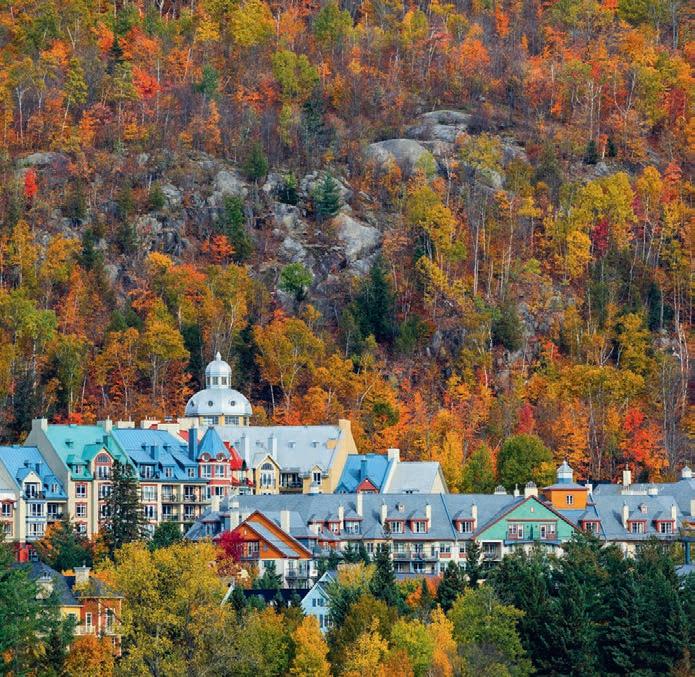
This sugar shack is a beacon of Québec‘s apple-growing prowess, even by the standards of this region‘s bountiful farmlands. “The weather cools down and our fruit trees gradually change
colour, just as the wood oven heats up and allows visitors to taste delicious dishes from the apple shack. We have nearly 20 different varieties of apples,“ she adds. This annual, authentic autumnal experience invites visitors to indulge in the region‘s rich agricultural heritage and savour its most fruitful season. NK ⊲
AUTUMN IN USA & CANADA www.wanderlustmagazine.com 129
SEE LAKES AND STARS IN NEVADA

As the crowds at Lake Tahoe thin in the autumn and Nevada gears up for the annular eclipse (14 Oct), there are plenty of ways to soak up the state’s beaches, dark skies and rocky wildernesses, says Dawn Andone, park interpreter for Nevada State Parks.
“The beaches of Lake Tahoe are crazy busy in summer, but by September, the crowds have died down and it’s still warm going into October. Most head to Stateline for its casinos, but Incline Village, in the quieter northern part of the lake, is more beautiful and has some nice hotels, while
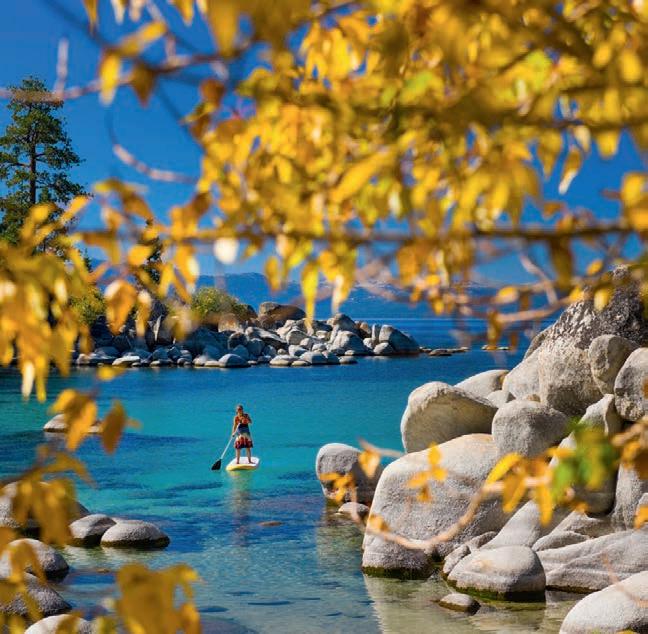
the 270km Rim Trail offers hikers peaceful views of the shoreline from up on high.
“Over in the eastern part of the state, I started the annual Park to Park cycle ride (65km–160km), which starts at Kershaw-Ryan State Park and goes up to Echo Canyon and back. It runs on the first weekend of October this year, and the reason we do it is so that you can watch the leaves changing from a different perspective.
“Or if you want to see the eclipse, head to Charcoal Ovens State Historical Park [named after its 19th-century beehive-shaped ovens], which has the best open skies. Or to see the state’s starry nights, the Nevada Northern Star Train runs from Ely to the Great Basin.” GC
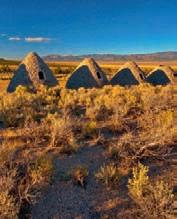
Alamy;
Shutterstock 130 October/November 2023
North Dakota Tourism;
JOIN A POWWOW IN NORTH DAKOTA
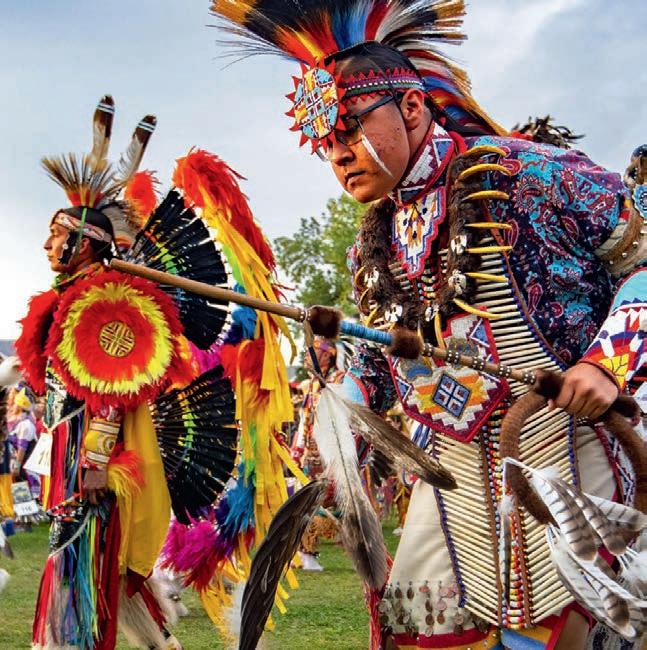
September witnesses the return of North Dakota’s United Tribes International Powwow, which brings together Indigenous peoples from across North America to compete in traditional dances. But it’s more than just a stage, says Jason Morsette, interpretive guide for the Mandan, Hidatsa and Arikawa Nations.
“We use powwows as a way to celebrate our traditions, religions and ways of life through singing and dancing. But when you think about how history played out for the Native Americans, a lot of our peoples were scattered, so it’s also a way to keep in touch with family members.
“The United Tribes powwow has been around for years, dating back to when Bismarck’s military base was first given over to the Native Americans in 1969. They turned it into an education facility, and the students got together to create a powwow for all the tribes. It’s now a competition, so the money that visitors spend in attending the event goes to creating a prize fund.
“There are five reservations in North Dakota and ten different tribes. Many also hold their own powwows, and there is nothing to prevent outsiders from visiting; it’s mostly intertribal dancing, so come and enjoy the music.” GC

AUTUMN IN USA & CANADA www.wanderlustmagazine.com 131
⊲
SIP CHARDONNAY IN SANTA BARBARA, CALIFORNIA
When the annual grape harvest is in full swing and the foliage takes on the colours of the California sunset, it’s an ideal time to explore Santa Barbara‘s wine country. Vineyards are abuzz with activity as grapes are picked, crushed, pressed and fermented, producing elegant, sophisticated wines for the 100-plus tasting rooms across the county’s six official wine sub-regions.
Set among 44 vine-filled hectares on the Foxen Canyon Wine Trail, Fess Parker Winery transforms its grapes into award-winning syrah, riesling, pinot noir and chardonnay. Established in 1989 by late American actor Fess Parker, known for his portrayals of Davy Crockett and Daniel Boone in

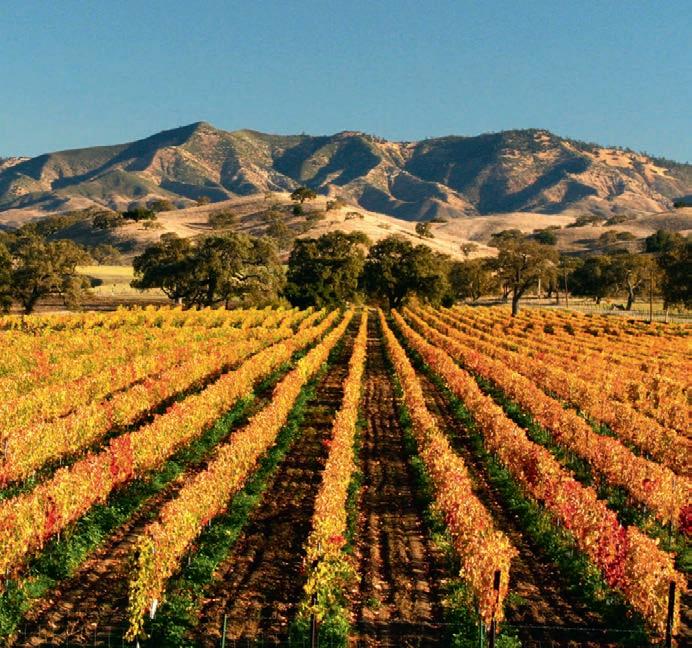
a pair of 1950s TV series, the winery is now owned by his daughter, Ashley Parker Snider
“Los Olivos in the fall has the best of everything,” says Ashley. “The days are still warm and the light takes on a golden hue in late afternoon, highlighting the vineyards‘ red and gold leaves. Once the sun goes down, a nip in the air makes sipping wine in front of a wood-burning fireplace even cosier.”
Several wineries also pair tastings with live music, and the Santa Barbara Vintners Festival brings more than 70 wineries and 30 local eateries together to mark the grape harvest in style in October. AB
132 October/November 2023
Alamy; Heather Daenitz/Craft & Cluster; Omni Amelia Island Resort; Shutterstock; NPS/Elena DeMarco
SAVOUR THE PEACE OF YOSEMITE NATIONAL PARK, CALIFORNIA
Autumn comes late to Yosemite National Park, but it also opens up a labyrinth of trails and landscapes with no one else around, says Elizabeth Barton of cooperative tour operator Echo Adventures.

“Fall up here looks different to down at sea level; it starts mid-October and can last until Christmas. It’s still very much summer going into September, so my favourite time is later on, when the crowds leave and the weather cools.
“Any time you hike more than a mile from your car in Yosemite, you’ll lose the bulk of other visitors, especially in the high country along Tioga Road and Highway 120. My favourite route is the North Dome trail, a 14km loop that most people can do because there’s not a lot of elevation. It takes you out to the northern rim of Yosemite Valley, so you’re walking through beautiful forests, then you pop out and you’re facing Half Dome, El Capitan and Glacier Point. It feels like a summit, but it’s just an easy 7km hike.
“It’s a good time for horseback riding in the area too. You can trot among giant sequoias –the largest trees on the planet – in Yosemite‘s Mariposa Grove. It’s so cowboy!” GC
EXPLORE AN ECO SUCCESS STORY IN OHIO


A sea of shining sugar maples, dogwoods and red oaks blanket the Cuyahoga Valley National Park in north-eastern Ohio. Yet, when taking in the wide valley views from Ledges Overlook, it’s hard to imagine this park was born out of one of the worst environmental failures in US history.
The Cuyahoga River that runs through the park, emptying into Lake Erie, was once so polluted by factories that it would catch
fire. In 1970, President Nixon established the Environmental Protection Agency and Clean Water Act to address pollution in America‘s natural spaces, and Cleveland and the Cuyahoga River became its poster-children. A clean-up of land around the city created a new recreation area in 1974, which became the national park in 2000 – an incredible rewilding victory for Ohio.
Now it’s one of the most acclaimed national parks in the country, with forests, wetlands and prairies that are home to more than 250 bird species, coyotes, foxes, bats, white-tailed deer, beavers, otters and
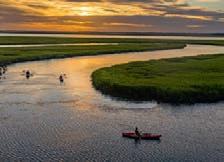
WATCH WHALES IN THE WATERS OFF FLORIDA’S AMELIA ISLAND
Perched on the edge of the Florida coast, Amelia Island has a front-row seat for the wildlife migrations passing up and down the Eastern Seaboard. Delicate monarch butterflies pause to feed on milkweed as they flit through in search of warmer climes, and North-Atlantic right whales are known to bask in the island’s waters.
Lauren Hodges, marine biologist at Omni Amelia Island Resort’s nature centre, says: “I always recommend to people that they come in fall, because the temperatures have cooled off, schools are back in session and there’s less traffic, so it’s an ideal time to visit.”

“I moved here because there are a lot of marine species that are specific to this area. This is also a critical habitat for the endangered North-Atlantic right whale, which comes here to breed in fall because of the island’s warm waters. They edge close to the coast because they like to give birth to their babies in the shallows.” KM
turtles, as well as eight impressive waterfalls, including the 18m-high Brandywine Falls.
“Autumn is my favourite time, as the valley turns golden and gets that bit cooler,” explains park ranger Rebecca Macko


“The scurry of animals, the crisp air, the fall flowers and the leaves underfoot make this a spectacular season to visit.
“Fall rains usually mean the waterfalls are in good flow. Weekends in October can be crowded, so consider midweek, late September or early November. The trees put on their finest colours, proving that it’s beautiful to let things go.” BW
⊲ AUTUMN IN USA & CANADA www.wanderlustmagazine.com 133
SEE THE NORTHERN LIGHTS IN ALBERTA
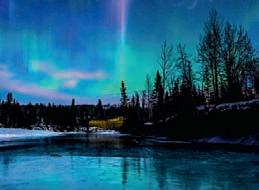
“Métis people are intimately tied to the land,” explains Juanita Marois , chief executive of Métis Crossing, an interpretive centre outside Smoky Lake, Alberta. Through guided activities and riverside accommodation, it explores the history and culture of this Canadian Indigenous group.

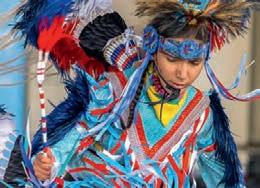
“In the past, fall was when communities across the Prairies gathered for the buffalo hunt, which would sustain us for the winter months. These gatherings also helped build the Métis Nation –our democratic and judicial systems are based on the laws of the buffalo hunt,” says Juanita.
“Today, it’s when elk and bison get into the rut and demonstrate breeding behaviours. It’s still warm during the day, but at night the skies are clear and dark enough to see the northern lights.”

In June, Métis Crossing added sky-watching domes with a transparent roof to allow for nightsky viewing deep into the colder months.
“We’re also building partnerships with the Athabasca University Geophysical Observatory, which specialises in studying the aurora borealis in northern Alberta, to develop a new programme blending Western science with Métis stories,” adds Juanita. “The sky was used by the Métis as a clock and as a calendar; it provided critical instructions for understanding when to plant, hunt and work the land.”
JWL
134 October/November 2023
Alamy; Shutterstock
⊲
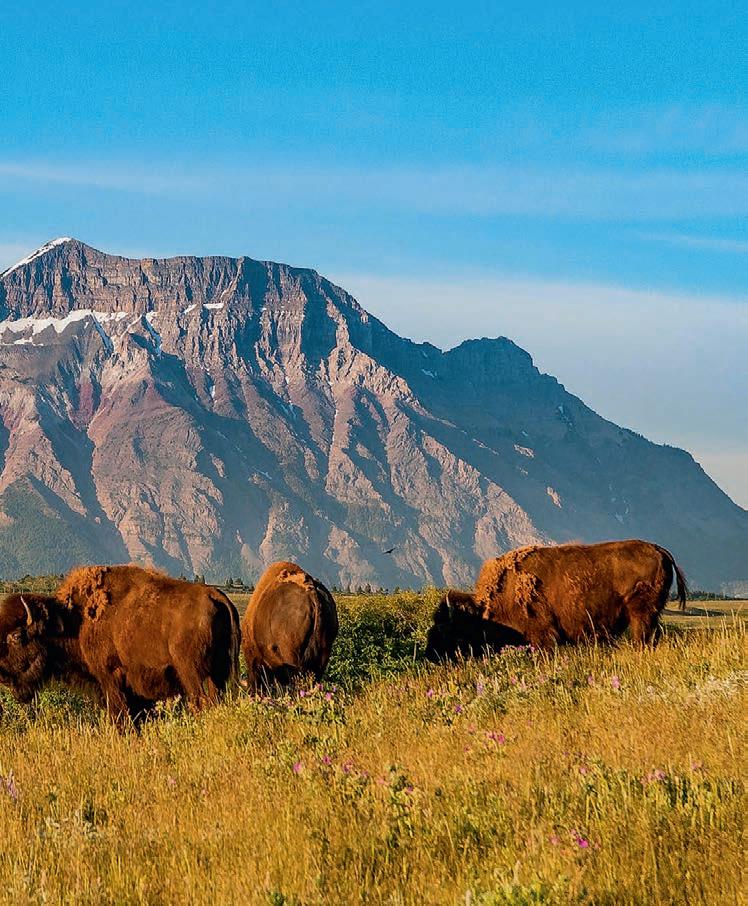
AUTUMN IN USA & CANADA www.wanderlustmagazine.com 135
Canada’s Rocky Mountains are awash with tourists in summer, but to connect with the area’s Indigenous heritage – exploring flora and fauna alongside its traditional owners – it pays to wait until the crowds have gone. Matricia Bauer is a Cree knowledge keeper and plant medicine guide at Warrior Women in Alberta, who leads medicine walks through Jasper National Park.
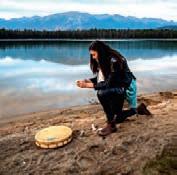

“The Wapakwanis Plant Walk lets me share local flora through the eyes of an Indigenous
person,” says Matricia. “We look at it from an edible, medicinal and spiritual perspective.
“Traditionally, fall was when we did the final harvest to fill our caches for winter with blueberries, fireweed, Labrador tea and rosehips. By visiting during this harvest season, people are re-establishing their connection to the land. I show them what they can harvest for themselves, then we get busy using the plants to make brews, lotions and salves.” DS
RECONNECT WITH NATURE IN JASPER NATIONAL PARK, ALBERTA
136 October/November 2023
Butch Braun; Placid Boatworks; Shutterstock; Diana Lambdin Meyer; Indigenous Tourism Alberta/Roam Creative; Zachary Goff
GO CRAZY FOR CRANBERRIES IN WISCONSIN

Nearly 125 years ago, Jamie Biegel’s great-grandfather started a cranberry farm on the banks of the Wisconsin River, near the little town of Wisconsin Rapids; now, as the co-owner of the Dempze Cranberry Company, she’s the fourth generation to grow fruit there.

“October is our favourite time of year because that’s when all our efforts come to fruition in the harvest. We flood the marshes to make the berries float – it makes it easier to rake them up – and we love sharing [stories] about cranberries with visitors,” says Jamie.
Cranberries have a long history in this area, and were used by its Indigenous peoples in medicines, as dyes for clothing and blankets, and as stuffing for game birds. Today, Wisconsin growers produce more than half the world’s cranberry crop, and the Wisconsin Cranberry Discovery Center in Warrens – at the terminus of the 80km-long Wisconsin Cranberry Highway – delves deeper into the fruit’s history. DLM
TRY BOATING IN NEW YORK’S ADIRONDACK REGION
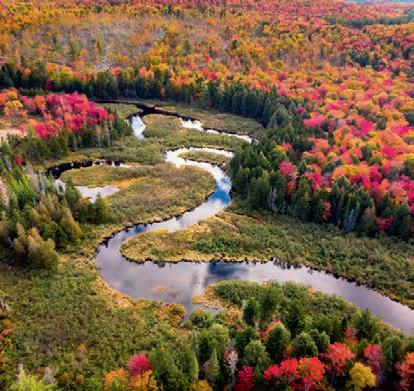

The Adirondacks region in northern New York State is a vast protected expanse, spread over 2.5 million hectares of mountain peaks and pristine lakes. Just a few hours‘ drive along the scenic Adirondack Northway from Albany, wildlife wanders freely, streams teem with anglers casting their lines and bucolic mountains are dotted with hikers on lush green trails.
Boat builder Joe Moore, renowned for crafting the region’s finest pack canoes (open-top kayaks where paddlers sit on angled seats), says the village of Lake Placid is “truly spectacular” at this time of year. “The reflections of autumnal colours and mountains mirrored on the crystal-clear, glassy lake are what fall looks like in the Adirondacks, as boating enthusiasts relish the cooling waters and the end of the summer hustle.
“Our boats glide the waters, transporting us to the time of [19th-century boat-builder] Henry Rushton by using a primordial mode of transportation – the pack canoe. Whether you enjoy hiking the peaks or boating, fall allows outdoor enthusiasts to venture into pockets that cars just can’t access.“VM
Mayor of McMinnville, Oregon, Remy Drabkin was born and bred in the wine country of the lush Willamette Valley, where she has gone on to found not just the Remy Wines winery, but the world‘s first Queer Wine Fest.

“We harvest wine grapes in September,” says Remy, “so the smell of grape pomace heavily fragrances the Willamette Valley during this time. Producers offer grape-stomping, and release parties often celebrate their new vintages.
“The local wineries host end-of-harvest collaborative dinners called La Paulée; this is a tradition born in France, where winemakers have come together after the harvest for generations to drink special bottles of wine from their personal cellars and share a feast.”
It’s also the time for local, late-summer vegetables like delicata squash and cinderella pumpkins. “End-of-summer Oregon tomatoes will knock your socks off,” adds Remy. LM
AUTUMN IN USA & CANADA
START GRAPE-STOMPING IN OREGON’S WILLAMETTE VALLEY ⊲






“As soon as bears sense the return of the chum salmon in the late summer, they start making their way down to the river valley,” says Randy Louie, cultural interpreter and grizzly bear guide at Klahoose Wilderness Resort, on the edge of Canada’s Great Bear Rainforest in British Columbia.
“That’s when I take visitors to the viewing platforms. You’ve seen pictures,butit‘smorememorablewhenyouseebearsinperson.Youhear them breathing and see the moment they spot the salmon. Sometimes it’s a mama bear [and] I’ll explain how she teaches her cubs. It’s such fun watching them splash around trying to catch fish.”
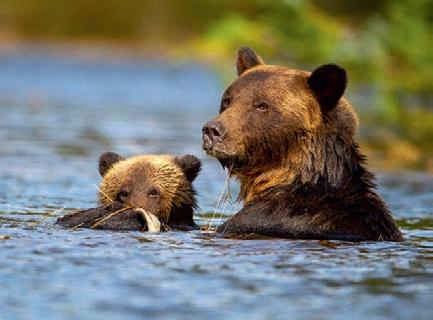
In 2017, thanks to pressure from Indigenous Nations and British Columbia’s guides, the government announced it would end all trophy hunting of grizzly bears. It has proved a boon for visitors in particular.
“Peoplelearnhowseeingbearsinourterritorybroughtjobsandhelped protect the land,” adds Randy, who is seeing a real impact on the local wildlife. “More and more, the grizzly bears are coming back.” DS

British Columbia’s Sunshine Coast meanders along waterfront coves and inlets and lies just 40 minutes by ferry from Vancouver. Dozens of painters, potters, textile designers and other artists have settled in its small towns, drawn by the Pacific seascapes and quieter life.
To celebrate this artistic community, Linda Williams founded the Sunshine Coast Art Crawl,anopen-studioeventthat’sbeendrawing art-lovers to the coast each autumn since 2010.

“This year, we‘ve got 170 venues and over 250 artists, from Langdale all the way to Earls Cove,” says Linda. “You wander in, meet the artist, get
inspired,andthenyou‘re offtothenextone.Some areprivatestudios,some arebiggervenueswhere three or more artists get together. It becomes a giant treasure hunt.”
While most visitors come during the sunny summer, meeting the artists is a good reason to brave fall’s more variable weather. “Early in the morning, you get that gorgeous mist over the water.Ifit‘sbeautiful,thecoloursareoutstanding. If it rains, our forests love it,” says Linda. CBH
Inmid-September,beforelocalsflitoff totheirhouseboatsonthecoolwaters of Lake Cumberland, the grounds of Bardstown’s Spalding Hall are taken overbytheKentuckyBourbonFestival, when some 40-plus distilleries fill its GreatLawn.There’snothinglikeit,says JeffreyCrowe,directoroftheHeaven Hill Distillery/Kentucky Experiences.
“Kentucky is the bourbon capital of the world: 95% of it is made right here in this state. We locals are naturally proud of it, so the Bourbon Festival is almost comparable to the Kentucky Derby in that the excitement starts building up in the weeks beforehand.

“Visitors will find tastings, classes, mixology tips and food and drink here. It’s a bit like the Bourbon Trail, which runs across the state, except that takes days to explore whereas you have everything in one space here. You can even sample and taste special products that the distilleries don’t normally offer.” GC
 MEET LOCAL ARTISTS ON CANADA’S SUNSHINE COAST
GO BEAR-SPOTTING IN BRITISH COLUMBIA
SIP BOURBON
MEET LOCAL ARTISTS ON CANADA’S SUNSHINE COAST
GO BEAR-SPOTTING IN BRITISH COLUMBIA
SIP BOURBON
IN BARDSTOWN, KENTUCKY
⊲ AUTUMN IN USA & CANADA www.wanderlustmagazine.com 139
Alamy; Chase Teron; Gary Sean Loewen; Shutterstock










SET YOUR SIGHTS ON SHENANDOAH IN VIRGINIA
From its sweeping national park to its grand fall festivals, the Shenandoah Valley is a prime spot to soak up “serenity and adventure”, says Raquel Montez,deputysuperintendentofShenandoahNP.
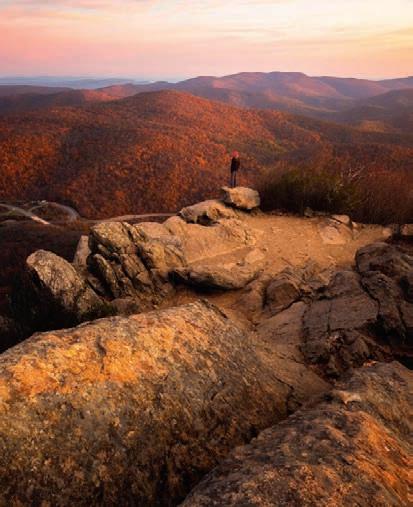

The park boasts 75 scenic viewpoints and 800km of hiking trails, including a 162km portion of the Appalachian Trail. It is also home to one of the most extraordinary drives in the country: the 169km Skyline Drive. And adjacent to the valley is the Blue Ridge Parkway, which stretches 755km through Virginia and North Carolina and has access to hiking trails, historic sites and scenic lookouts, including a kilometre-high overlook with magnificent views over the local foliage.
“The cooler temperatures of the season make it ideal for hiking, camping and picnicking,” says Raquel. “As the trees showcase their kaleidoscope of colours, visitors can enjoy the scents of fall, the soothing sounds of leaves crunching underfoot and pristine views via hiking trails and numerous overlooks along Skyline Drive.“
Adding to the valley’s allure are several cultural festivals, including the Fall Foliage Bike Festival, Shenandoah Valley Apple Harvest Festival and ShenandoahAutumnFest,whichfeaturesalog-splittingcontestintribute to the role of the axe in shaping the American landscape.TW

CELEBRATE CINEMA AT NEW ORLEANS FILM FESTIVAL

Not only is New Orleans one of the oldest cities in America, but it combines acclaimed cuisine, characterful architecture and classic jazz with an irrepressible arts scene. Amid the cooler temperatures of fall, the city showcases more than 145 films at the New Orleans Film Festival (3–8Nov),whichisnowinits33rdyear. Sarah Escalante, executive director of the New Orleans Film Society, says: “The city is home to a vibrant and diverse independent film culture. This community shows up in a big way at the festival, welcoming guestsfromoutoftownandcheering on fellow artists. There’s nowhere like NewOrleans,andthefilmcommunity matches that unique quality.
“It’sthebesttimeoftheyearforfilmloverswholiketodiscovertheworksof storytellers first-hand, attend parties andmeetfellowfilmbuffs.Overhalfof ourline-upisdedicatedtostoriesfrom artists based in the American South.” To find out more information, visit neworleansfilmsociety.org/festival MM
⊲ AUTUMN IN USA & CANADA www.wanderlustmagazine.com 141
Alamy; Shutterstock; Troy Conrad; Neal Lewis
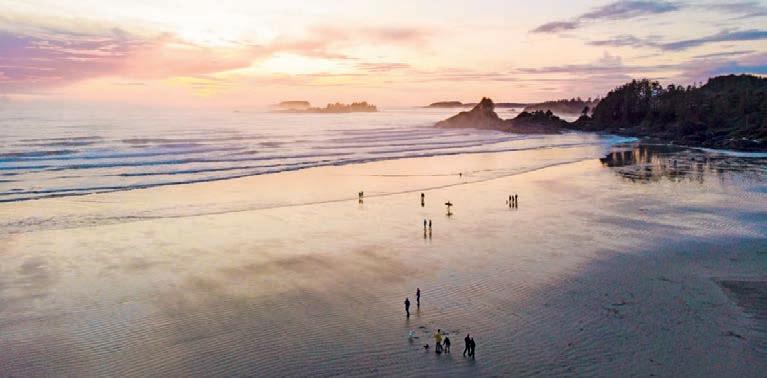


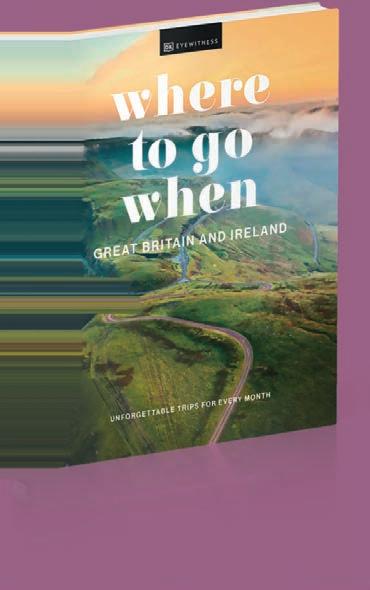




Autumn might just be the time when Chicago is at its all-round best, before the winter weather sets in. VeronicaArreola, councillor for Chicago’s 24th district and director of Hispanic Serving Institution Initiatives at the University of Illinois, says: “[This] is when all our sports overlap: baseball – the Cubs and the White Sox – and men’s and women‘s soccer are winding down, while basketball, hockey and [American] football are starting up. Chicago also does Halloween well – there are haunted tours and pumpkin patches throughout the area.”


Spend time leaf peeping in its parks or get a rare behind-the-scenes glimpse of the city’s most significant landmarks during Open House Chicago (14–15 Oct), a public festival that sees hundreds of buildings open their doors for visitors and locals to enjoy self-guided history and architecture tours free of charge. PB
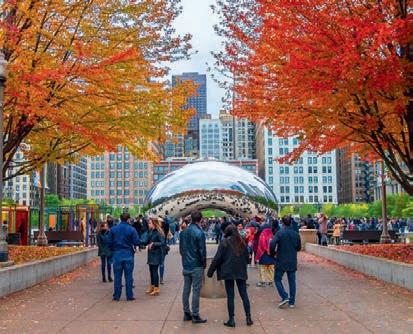
Forestsofblushingaspen and golden cottonwood fur the foothills of Idaho’s Sawtooth Mountains. By autumn,saysSteveBotti, mayor of Stanley, their colours make for thrilling roadtripsalongsidetheSalmonandSnakerivers.
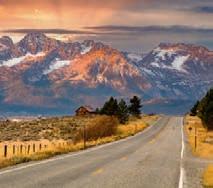
“In Sawtooth Valley, near Stanley, the aspens turn red, gold and yellow between late September and late October. To see them, drive the Fourth of July Creek Road or make a stop at Redfish Lake, which has the largest groves.”
“TheSawtoothScenicBywayalsorunsthrough here,fromStanleytoShoshone.Theviewasyou comeoverGalenaSummitisspectacularbefore you drop down to a landscape of old lava fields. Another good driving route is the Salmon River ScenicByway,north-eastofStanley.Thereused to be a lot of mining in this area, and miles of golden cottonwood trees take over as you head downriver, past ghost towns such as Bayhorse.
“Look out too for the Trailing of the Sheep festival in Ketchum in early October, as herders move their flocks out of the valley for winter, marching them through the city streets.” GC



Come autumn, the maple-heavy forests and marshes of Rhode Island turn a dizzying array of purples, oranges,yellowsandreds,butevenon thecoastthisisacolourfultimeofyear, says Kim Calcagno of the Audubon Society of Rhode Island.

“The George Parker Woodland Wildlife Refuge has one of the largest trailsystemsintheAudubonSociety’s reserves. The foliage is amazing in fall and you can see all sorts of woodland birds, from tanagers to wild turkeys, as well as coyotes and fishers – a landbased otter that’s about a metre long.

“In fall, Block Island becomes a vital migration stopover point for birds blown in by the weather. Get the ferry, rent a bicycle and pedal the island to see them for yourself, or join the Audubon Society tour. We have run overnight birding trips there in late September for the past 50 years.
“If I had to pick one area for coastal birding, it’d be Sachuest Point. In the colderweatherofthelatermonths,you can see raptors such as snowy, barn and short-eared owls – the kind found on dunes rather than in trees. Around the coast you can also spot harlequin, ring-neck and eider ducks.” GC
DRIVE THE WILDS OF CENTRAL IDAHO
GO BEHIND THE SCENES OF CHICAGO LANDMARKS
Shutterstock ⊲ AUTUMN IN USA & CANADA www.wanderlustmagazine.com 143
ENJOY BIRDS & BIKES IN RHODE ISLAND
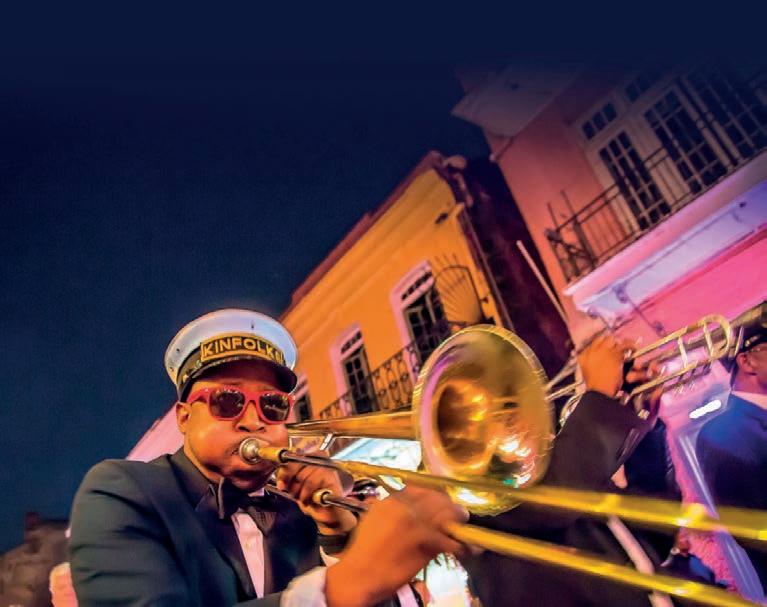
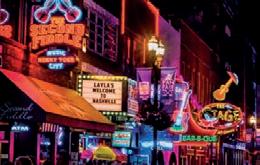






AT
“The Pacific Northwest is the glass capital of the United States,” says Raya Friday, an Indigenous glass artist of the Lummi Nation. She is also the education and outreach supervisor at Pilchuck Glass School, which was co-founded in the 1970s by celebrated Washington-born artist Dale Chihuly, who launched the region’s glass art movement.

Today, the Seattle area sparkles with the work of several hundred artists, especially during Refract: The Seattle Glass Experience, the city’s autumn festival of glass art (12–15 Oct). “Artists open up their studios who otherwise would not,” says Raya. “It’s a ‘who‘s who’ tour of this industry.”
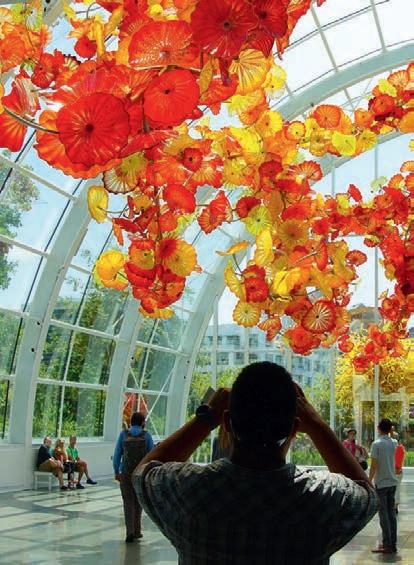
HighlightsincludevisitstoTheBoathouse,Chihuly’sprivatewaterfront studio and hot shop, as well as a grand gala at popular visitor attraction Chihuly Garden and Glass.
Glass-blowing demonstrations, lessons and programmes featuring female, LGBTQIA+ and Indigenous artists take place across the city too. Glass, adds Raya, “is a medium that plays with light, and [in fall], the light in the city is gorgeous.” CBH
EXPLORE PHILADELPHIA’S LANDMARKS ON FOOT

Phillyusuallyemptiesduringsummer, as the heat drives locals to the shores of neighbouring Jersey, but come autumn, says Liz Pagonis of Philadelphia Runner, the weather cools, the parks and neighbourhoods spring to life and you realise just how walkable (or runnable) the city can be.

“PeoplecometoPhillyforitshistory (Independence Hall, etc), and these sitesarealwaysquieterinfall,butthisis a city of neighbourhoods too. It’s cool enough to wander during this time and you’ll find each area has its own thing going on. This city has so many pockets that you can only see on foot.
“Take, for example, Philadelphia’s artmurals.Aswellastheusualwalking tours,therearealsorunningtourswith non-profit Mural Miles as the weather cools down. It organises monthly art runs and brings artists along to talk about the pieces as you go.
“There are plenty of fall colours, too. Fairmount Park is the largest landscaped urban area in the US and connects over 60 parks. The secondlargestoftheseisWissahickon,where you can watch the foliage turn to orangeasyouwanderthecreek.You’re still in the city, but it feels like you’re in the middle of nowhere.” GC
Shutterstock;
⊲ AUTUMN IN USA & CANADA
MARVEL
GLASS ART IN SEATTLE
Freddy Lane
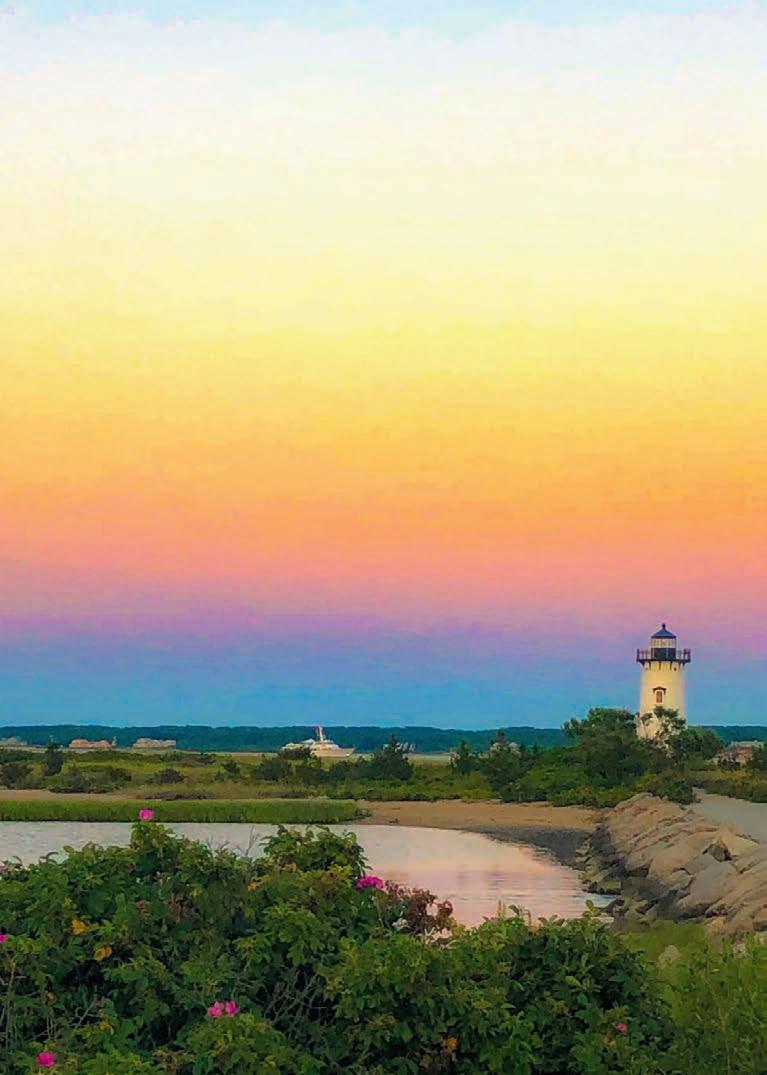



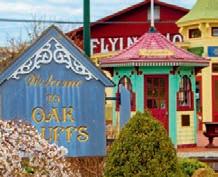



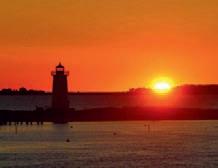





Alaska’s Kodiak Island is known for its record-sized bears, and when fall arrives, the ones that have hunted in these lakes, rivers and mountains all summer slow down to gorge themselves on the spawning salmon.
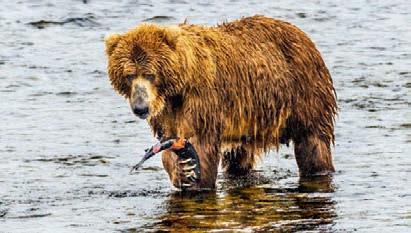
StaceySimmons,operationsdirectorfortheKodiakBrownBearCenter and Lodge, is Sugpiaq/Alutiiq and a tribal member of the Native Village of Afognak. She often watches Kodiak bears – the largest species of brown bear – from her office at the lodge.
“The bears are fat, happy and slow in fall. By the time we close, they’re like fluffy roly-polies. They‘ll just watch you fish – like you‘re amusing them because there‘s so much to eat.
“You get deer walking next to you on the trails at this time, plusthegorgeousturningoftheseasonsasthefireweedgoes from pink to red. The sides of mountains look so red that they’re almost purple, and that sweet berry smell in fall sweeps the land. It’s my favourite season.”
It is also harvest time, a necessity when the island’s grocerydeliveriesareatthemercyoftheAlaskanwinter.
“Whether it’s elk hunting or getting fish ready –smoking and freezing it for your family – it’s what I grew up on. In my village we’d start school in fall and take the entire class up to Big Creek in Old Harbor. We’d fish for salmon all day, clean it, pack it and give it to the elders in our community.” RT
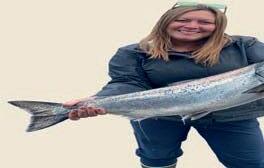

SAVOUR THE BEST ATLANTIC SHELLFISH ON PRINCE EDWARD ISLAND
Manyresidents of Canada’s Prince Edward Island (PEI) earntheirliving from the land or the sea. In autumn, when fish and shellfish are in season and the summer beachgoers have gone home, PEI also hosts two gourmet events that make ‘Canada’s Food Island’ even more delicious.
Chef and restaurateur Liam Dolan conceived the PEI International Shellfish Festival nearly 30 years ago. “Wehavethebestmusselsandoysters in the world, but nobody was telling thatstory,”hesays.“Sowecreatedthe biggest kitchen party in Canada, with the world’s largest oyster bar.”

Chefs come from across North America to shuck oysters or make chowder. There’s ample seafood to taste, plus music and entertainment daily (14–17 Sep).It also whets the appetite for the two-week-long Fall Flavours Festival (1–15 Oct), where island-wideculinaryeventsrangefrom lobster parties and fish fries to foodfocused bicycle rides and tastings at local cideries and distilleries, all celebrating the bounty of PEI. CBH

With world-class museums and monuments at every turn, there’s never a bad time to visit the nation’s capital. But, to avoid spring’s cherryblossom crowds and summer’s humid weather, fall is the quietest time to explore.
“Ialwaystellpeople:ifyouhaveachoiceofany time of year, November is when to come,” says Tim Wright, owner of tour company Attucks Adams. “Even in Thanksgiving week, people leave DC, so it usually empties out.”

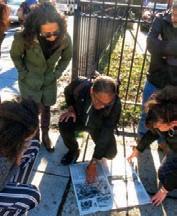
Wrightrecommendsquietoutdoorspotssuch as the National Arboretum, with its collections
of dogwoods, azaleas and Asian gardens. “It’s huge, and on some days I feel like I have it all to myself. The leaves also change in October and November, so you get some incredible colours.”
The Anacostia Riverwalk Trail and the free community firepits at waterfront development TheWharfalsocomerecommended,butforthe best views, Wright advises skipping the queues at the Washington Monument. “Tickets are very hard to come by, so head to the Old Post Office toweronPennsylvaniaAvenueinstead–it’sfree, underrated and the sightlines are great.” KM
WALK CROWD-FREE STREETS IN WASHINGTON, DC
WATCH BEARS PILING ON THE POUNDS ON KODIAK ISLAND, ALASKA
Alamy; Government of PEI; Shutterstock ⊲ AUTUMN IN USA & CANADA www.wanderlustmagazine.com 147
EXPLORE REMOTE ISLES AND TREE TUNNELS ON KEWEENAW PENINSULA, MICHIGAN

All summer long, Lake Superior soaks up the sunshine, creating a unique microclimate around Michigan’s Keweenaw Peninsula, which juts deep into its waters. Because of this, even the leaves turn in reverse order here (south to north), with the state’s northernmost town, Copper Harbor, the last to feel the change, say Nancy and Bill Leonard of the Michigan Nature Association.
Driving Brockway Mountain Drive – the highest paved point between the Rockies and the Alleghenies – is a fine way to get a glimpse of the changing fall foliage. “You can even look down and see the tops of eagles flying by,” says Bill.
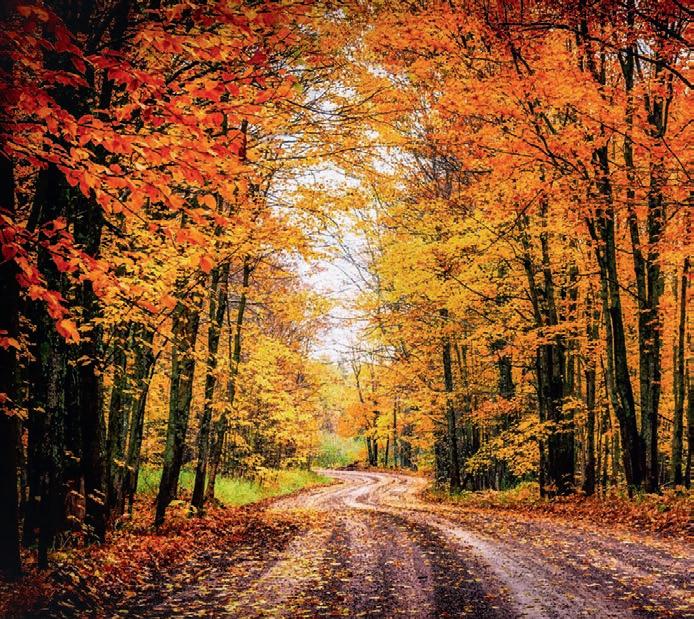
It also has plenty of scenic stops, adds Nancy: “Brockway is wrapped by stone-built walls,
created as part of a public works project in the 1930s; just pull off beside any of these and gaze over the colourful hillside. Another good route is the Covered Drive, which is famous for a tree tunnel that arcs over the road. The colour is spectacular in fall as the leaves shave the tarmac.”
Autumn is also your last chance to visit Isle Royale National Park (closes 31 Oct), an island 90km off the peninsula. By then, the mosquitoes and blackflies are gone and the moose have started rutting. Ferries and seaplanes stop running at the start of October, but you can still hire a boat to get there, and even a short hike can make you “feel like you’re in the middle of the wilderness,” says Nancy, “and the colours are incredible”. GC
148 October/November 2023
Alamy; Shutterstock; Jon Kedrowski
ENJOY THE FUN OF THE FIESTA IN

ALABAMA
Alabama is great in the fall. It never gets too cold and we have a number of events that land at this time,” says Kyle Sullivan of film production company Screen Door Pictures. One of those is Fiesta Birmingham (30 Sep).

“[It’s] the state‘s largest celebration of Hispanic cultures,” says Kyle. “There‘s food, dancing, Aztec dancing (my favourite!) and music, booths and tents. Alabama has long been the poster-child for overt racism, but the truth is much more complicated than the stereotypes. We have a diverse Hispanic population, and Fiesta Birmingham is a spot on the calendar when those folks can shine.”
Sullivan also recommends Birmingham’s sizeable Día de los Muertos celebration at Sloss Furnaces National Historic Landmark, another worthy stop on any visit. PB
TAKE IN THE VIEW IN VAIL, COLORADO
Before Vail gets its white winter blanket, its ski resort is covered in a patchwork quilt of shimmering golden aspens, making it an ideal time for hikers and bikers to snag great deals on accommodation. Mountain guide, skier and author Dr Jon Kedrowski, who has summited Everest three times, grew up in the Vail Valley and can’t get enough of it in autumn.


“When the first snow dusts the high peaks and the air gets crisp, ski season is just around the corner. You can catch fall colours from mid-September to mid-October, and for the avid hiker, the 14km Missouri Lakes Fancy Pass Loop trail is awesome,” he says.
Vail is also close to one of Colorado’s best fall drives. Highway 24 goes from the quaint town of Minturn to Camp Hale-Continental Divide National Monument, one of America’s newest national monuments. Built during the Second World War, Camp Hale was a training facility for the US Army’s 10th Mountain Division of elite alpine soldiers. Surrounded by the impressive Tenmile Range, the Army’s first and only mountain infantry division trained in warfare techniques at Camp Hale, then fought the Nazis in Italy’s roughest mountain terrain. Look out for the Tennessee Pass Memorial on the Continental Divide.
“There are so many wonderful places to see brilliant fall colours and enjoy bluebird skies in and near Vail,” says Jon. Add a short drive to Piney River Ranch for panoramic views, or visit the free Betty Ford Alpine Gardens to see a palette of autumnal hues. JBr
GET CREATIVE WITH MAINE’S ARTS SCENE
Early October sees the breweries, workshops and studios of Maine’s creative community open their doors for the statewide Maine Craft Weekend (7–8 Oct). It’s a good time to meet the people behind the work, says Kate Anker of Portland art-studio collective Running With Scissors.

“We’re a closed-door space, so we’re not typically open to the public. That’s why festivals like this appeal. A lot of people walk into a store, pick up a pot and have no idea what goes into it, how it’s made or the thought processes behind it. This is about sharing that knowledge.
“We will have demos and interactive experiences, as well as painting on pre-made ceramic vessels that we’ll fire up. But there’s plenty more to see in Portland. The First Friday Art Walk, a self-guided tour of the city’s music, art and food scene, is a particularly good starting point.
“Download the Creative Portland App, which lists places that don’t get much exposure. The Indigo Arts Alliance [an arts space for Black and Brown artists] will also open their studios for the festival, plus there are great breweries and the Maine Craft Portland retail gallery to visit.” GC
AUTUMN IN USA & CANADA
HOW TO EAT YOUR WAY AROUND MOUTHWATERING
MICHIGAN
One thing’s for sure: you’ll never go hungry (or thirsty) in Michigan, which serves up some of America’s tastiest comfort food (Detroit, we’re looking at you), and is famous for its homegrown produce, whether it’s cherries (at nearly 82,000 tonnes a year, 70% of America’s cherries are grown here) or its wines, made from the 93,400 tonnes of grapes that grow in the state.
CRAVING COMFORT
When it comes to pizza, the Detroitstyle pie is seriously underrated. Invented in the 1940s by restaurantowner Gus Guerra, its squareshaped, deep-dish pizzas are served

everywhere in Michigan, although aficionados say Detroit’s are the best.
Other guilty pleasures include the Coney dog – a beef frankfurter served in a bun and topped with chilli, diced white onions and yellow mustard. Inspired by Greek and Macedonian
Upper crust (this page; top to bottom) Pair Detroit’s culinary scene with its cityscape at sunset; Detroit-style pizzas are a must-try guilty pleasure when in Michigan

immigrants, Michigan is passionate about its version of the Coney dog, best sampled at Michigan-based chain National Coney Island restaurant might suggest otherwise. Give them a try.
Other dishes worthy of your radar include ‘wet burritos’ (burritos stuffed with ground beef and drenched with a tomato-based sauce); olive burgers, which comprise a beef patty topped with green olives (Grand Rapids is said to have some of the best); corned-beef egg rolls; and sweet-potato pie.
Finally, there’s the humble crisp. Michigan is one of America’s biggest potato-producing states, and over 770 million kilogrammes of potatoes are harvested in Michigan every year. There’s no shortage of local potatochip brands (Better Made is one of the largest), and we’d recommend sampling some of the more unusual flavours, such as honey barbecue.
ARTISANAL TREATS
Michigan’s fertile soil means fresh produce abounds. Take apples, for example: Michigan has over 11.3 million apple trees used for commercial production, with most grown on familyrun farms. Look out for pick-your-own signs when exploring the state.
150 October/November 2023
Michigan’s food scene is seriously underrated, which is why it’s high time that the world knew about its culinary treasures
Then there are blueberries. Over 45 million kilogrammes of blueberries are grown here every year in an industry that dates back to the 1900s. And if you’re wondering why honey barbecue crisps are so popular, look no further than Michigan’s bumblebees, which produce over 2 million kilogrammes of honey annually.
With all this fresh produce, it’s no surprise that Michigan has some of America’s finest farmers’ markets. Ones that should be at the top of your hit list include Detroit’s enormous Eastern Market, which has been feeding hungry Michiganders (as the state’s residents are known) since 1891. The biggest queues tend to form outside the tasting stations, where visitors can sample local treats for free.

Elsewhere, Holland Farmers’ Market, in the city of Holland, is famous for its seasonal produce. Check out the Hot Crops section of its website (hollandfarmersmarket.com) to see a handy list of what’s in season and when. Also pay a visit to Rochester’s farmers’ market, which has some fantastic seafood to try, with vendors including Pure Mackinac, which sells fresh fish from Michigan’s Straits of Mackinac. And lastly, don’t miss Marquette’s downtown market, where you’ll find a wide range of vendors, plus plenty of live music. Blackberry pie with a side order of blues? Sign us up!
CRAFT-BEER CULTURE
There are plenty of places to toast Michigan’s craft-beer scene; the state is the fourth-largest producer of hops in the US, so both the ingredients and the pedigree is there. Michigan also produces some of America’s finest wines and spirits, and its bars, restaurants and grocery stories are known for embracing independent brands, so you can always find a local alternative to try.
Short’s Brewing Company produces some of Michigan’s most popular beers, which are sold throughout the state. It’s also worth dropping by the


Food for thought (this page; clockwise from top left) Milliken State Park Lighthouse; scenic Lake Superior; cherries are just one of the state’s many homegrown foods; discover breweries across Michigan; craft beer culture thrives here; try fine food in its eateries; Michigan’s delicious wines
brewery’s Bellaire Pub in the pretty village of Bellaire (nab a spot in the beer garden if you can).

Founder Joe Short believes that it’s passion that sets Michigan’s brewing scene apart from other states: “Whether it’s in Michigan’s cities or the more rural areas, everyone’s brewing here,” Joe says. “Beer brings people together in Michigan!”

There’s certainly plenty of beers to try. Austin Brothers Beer Company, a brewery in Alpena, is known in particular for its diversity of brews, which are available to sample in-house at the taproom or at one of the bars, farmers’ markets and grocery stores that stock their ales. It’s worth trying the Sumo Sumatra especially, which is made with cacao nibs.
If you prefer grapes to hops, make a beeline for one of Michigan’s many wine producers, such as the 18-hectare Brys Estate Vineyard & Winery. It’s known for its small-batch wines like pinot blanc, merlot and more, all of which are grown a stone’s throw from Lake Michigan. Coney dogs and a pinot blanc? Sounds like the ultimate combo to us.

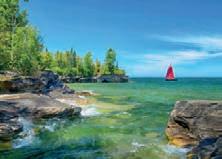


PROMOTIONAL FEATURE www.wanderlustmagazine.com 151 For more information, visit: www.michigan.org
Alamy; David Weidner Photography; Pure Michigan
Waking a sleeping
GIANT
A slow drive along the North Wales Way, from the English border to Anglesey, reveals not only a land of incredible local food and castles, but a region that is slowly reimagining itself
 Words David Atkinson
Words David Atkinson
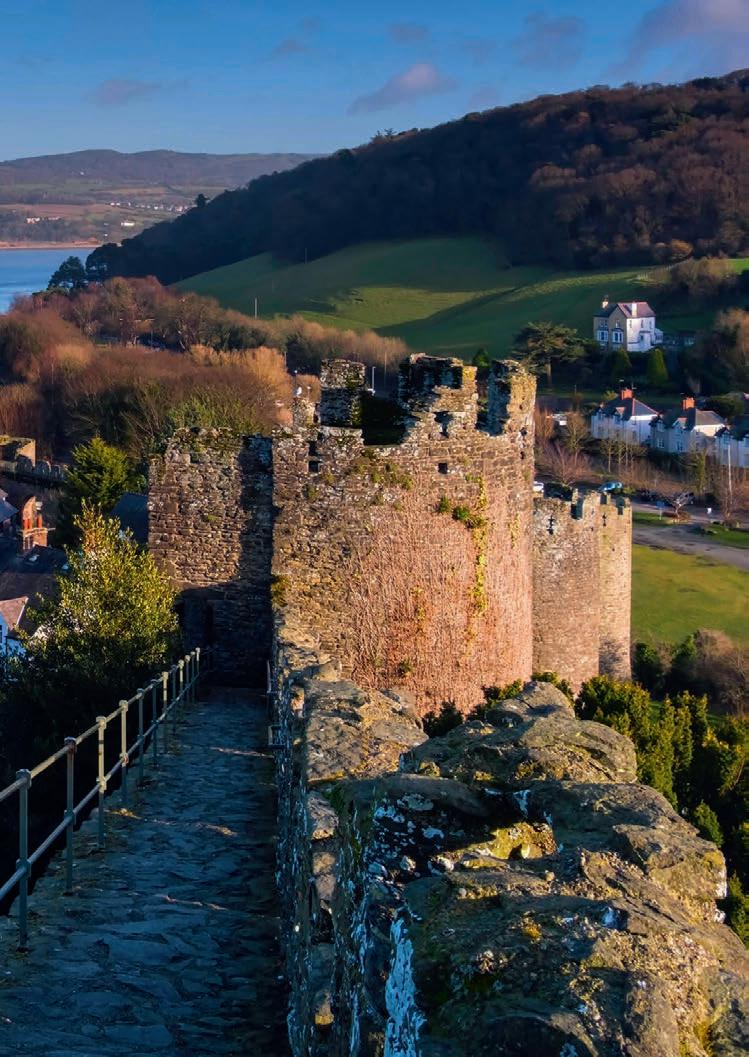
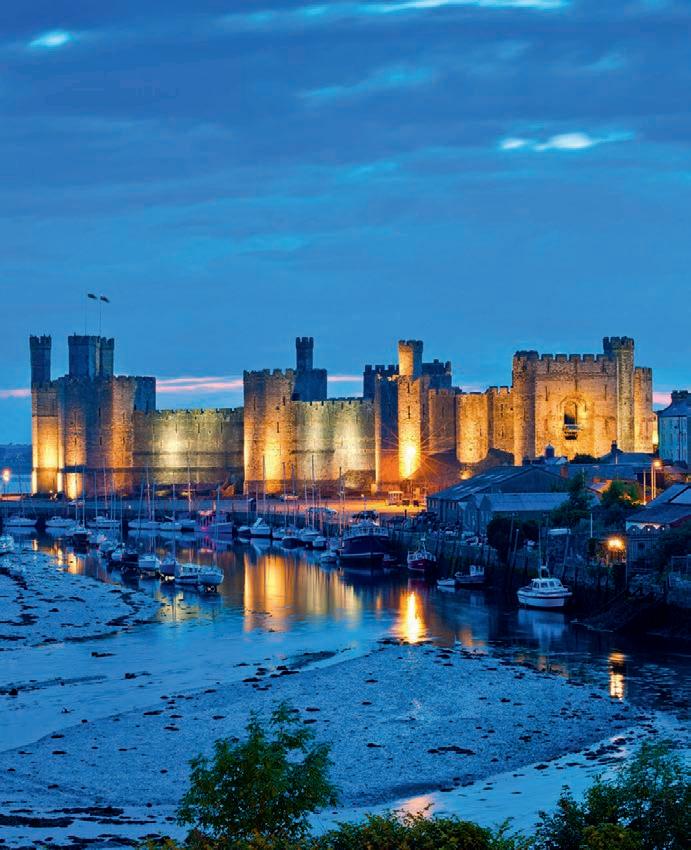
154 October/November 2023
In the shadow of history (clockwise from above) Caernarfon Castle is the most impressive of Edward I’s so-called ‘Ring of Iron’ fortifications, a chain of castles the English king had built to subdue locals in the 13th century; visitors sample the whiskies of Penderyn Distillery, which is well known for its single malts; Welsh whisky was given a well-overdue Protected Geographical Indication status recently, a recognition long since granted to its Irish and Scottish cousins; one of many sculptures now found dotted around Caernarfon Castle; (previous spread) Conwy Castle looms over a town now filled with exciting local food producers
Angharad encouraged me to stick my nose deep into the barrel.
“Go on,” she smiled, “give it a good sniff. The Madeira wine one is my favourite.” Somewhat fazed, I obliged and inhaled deeply while she talked the rest of the group through the process of using old bourbon and sherry casks to mature post-fermentation whisky.
“I was always a brandy girl, but I’ve come to appreciate the complexity of whisky,” she told me as we headed to the tasting room for the end of our visit.
I had joined the distillery tour at Penderyn in Llandudno just days afterWelsh whisky was awarded Protected Geographical Indication (UK GI) status – a recognition of its all-Welsh operation. It came as a revelation to me. After all, I’d visited North Wales many times before, first as a child and then later with my own children; in all that time, I’d enjoyed its castles, coastal walks and seaside breaks, but never its single malts before.

The all-female distillery team at Penderyn in Llandudno, along with the company’s sister sites in Brecon and Swansea, will soon be producing up to 2.5m bottles of whisky each year, having recently beaten the Scottish and Irish to the plaudits at the Spirits Business World Whisky Awards. By the time I’d extracted my nose from the cask, I was already starting to see North Wales in a new light. But, then again, that was the idea all along.

My visit to the distillery was part of a road trip along the North Wales Way, one of three new national routes devised by Visit Wales to look afresh at regions most people think they already know.Visitors often travel from the North Wales border, outside Chester, to the tip of Anglesey in a day, either bombing down the A55 or trundling the train line that chugs alongside it, but they miss out on all the fun by doing so. I have certainly been guilty in the past of being too preoccupied with the destination to realise that the journey, spanning 120km of seascapes and mountains, reveals epic tales of Welsh heritage, folklore and adventure, among other delights. It was time to look afresh at North Wales.
REWRITING HISTORY
I had started my NorthWales odyssey a few days earlier by revisiting a couple of the region’s big attractions, beginning at Caernarfon Castle. Its impressive fortifications form part of the ‘iron ring’ of castles constructed under King Edward I to crush the 13th-century rebellion of the Princes of Gwynedd. Along with the castles at Conwy, Harlech and Beaumaris, it has attracted UNESCO World Heritage status, but its story is now also getting a bit of a twist. A recently unveiled £5 million pine-and-glass upgrade to the King’s Tower gatehouse is recasting the imperial history of Edward’s bastide (fortress town).
The idea behind the project, according to lead custodian Hannah Litherland, was to shift the story from Edward to the hands of the people who built the castle, including local stonemasons and female embroiderers. As such, 12 new sculptures were commissioned to symbolise the skills of these medieval craftspeople.A new viewing platform, meanwhile, looks out over the city walls – which were, ironically, built to keep the Welsh out – and gazes over to the mountain passes where the local resistance once gathered.
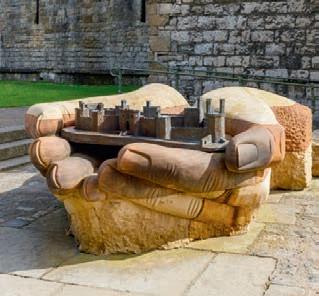
⊲ NORTH WALES www.wanderlustmagazine.com 155
Previous spread: Alamy; this spread: Alamy; Tony Trasmundi; Visit Wales
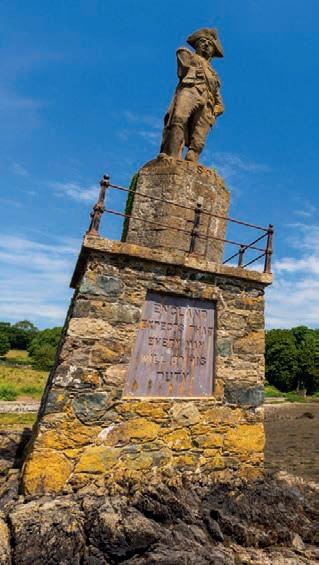
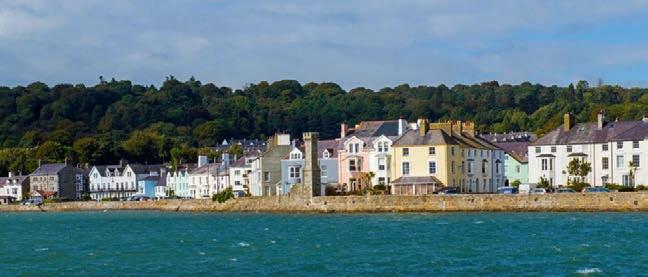
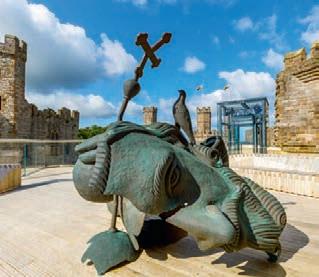

156 October/November 2023
A coast with a past (this page; clockwise from top) The Anglesey town of Beaumaris is a muddle of medieval, Georgian, Victorian and Edwardian architecture; the sculptures of Caernarfon Castle help retell the story of the building from a local standpoint; Gelert’s Grave is said to be where Prince Llywelyn buried his faithful dog, who he killed after mistakenly believing it had savaged his child; this concrete statue of Lord Nelson, erected between the impressive Britannia Bridge and Plas Newydd stately home, was originally intended to be of the god Neptune; (right page) Beaumaris is one of the world’s great unfinished castles
The statement sculpture, located atop the new gatehouse (which has an accessible lift), depicts Edward’s legacy in pieces, the accompanying verse from the 16th-century Anglesey poet DafyddTrefor cheekily highlighting how a Welsh flag now flies over a castle built by an English king to subjugate theWelsh. It reads: “Where is Edward… He himself is silent, away in his grave.”
After a quick lesson in reframingWelsh history, I headed onwards, crossing the Britannia Bridge to the island of Anglesey in order to find the Norman settlement of Beaumaris.This is now the visitor hub of the island, busy with day trippers.The attractive high street of gift shops, galleries and cafés was doing a brisk trade, while the perennial queues outside the Red Boat ice-cream parlour were snaking back towards the old harbour. Charles Dickens stayed at Ye Old Bull’s Head Inn in Beaumaris when he visited Anglesey as a journalist in 1859 to report on a maritime disaster off the island’s coast; he was a bit sniffy about the cuisine, but now it’s all comforting pub food and local produce.
Nearby lies Plas Newydd, the stately former pile of the Marquess of Anglesey, which was gifted to him after he served as second in command to Wellington at the 1815 Battle of Waterloo. The war-hero first marquess, whose effigy looms over southern Anglesey from a giant Doric column, lost his leg at Waterloo. His replacement limb –

one of the world’s first moveable prosthetics – is now on display in the house’s Waterloo room.
The curators here are also working to reframe the story of the local landowning family. A new series of art installations, ‘AllThatWas Left’, tells the lesser-known tale of the black-sheep fifth marquess, Henry Cyril Paget. Known as the ‘Dancing Marquess’, he was a flamboyant character who died in 1905 having squandered his annual allowance and run up debts of £40 million (in today’s money) in the pursuit of the arts and high living.
A contemporary of Oscar Wilde, the scandalous insolvency of the marquess led to the Great Anglesey Sales of 1904, when 18,000-odd lots of his personal possessions, ranging from clothes to furniture, were sold off to the local community to clear his debts.The auctioneers even sold his housekeeper’s parrot, which reputedly swore in three different languages.The Welsh artist Alison Neighbour has recreated the assorted lots with ghost-white installations that run throughout the property’s labyrinthine rooms to tell a story that has been swept under the heavy, dusty carpets for years.
“The fifth marquess was a man before his time. I’ve come to feel he was looking for something with his extravagance that he never quite found,” said Taya Drake, project curator for the exhibition. “It’s a tragic story
“The auctioneers sold off a parrot that reputedly swore in three different languages“
⊲ NORTH WALES www.wanderlustmagazine.com 157
Alamy; Tony Trasmundi


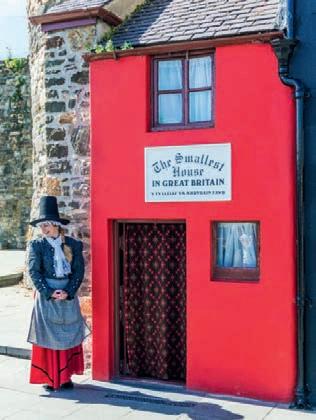
158 October/November 2023
Big Wales, small Wales (clockwise from top) Llandudno’s promenade is over 3km long and is the centrepiece of the Victorian resort town; South Stack Lighthouse lies on the westernmost tip of Anglesey, atop a small rocky island known as Ynys Lawd, and is a guiding light for vessels crossing the Irish Sea; a woman in traditional dress stands by the smallest house in Great Britain, nestled in the corner of Conwy’s quayside – it’s barely 2m wide and not much more than 3m high; hikers make their way along the Llanberis Pass trail, which is one of the longest routes up Yr Wyddfa (Mount Snowdon) but arguably the easiest

Alamy NORTH WALES www.wanderlustmagazine.com 159
but, through research for this project, we’ve come to better understand a forgotten member of the family.”
RURAL DETOUR
The next day, I cruised into Llanberis on a detour from the main route, following the switchback roads of Eryri National Park (Snowdonia), overlooked by its brooding, mist-shrouded peaks and rugged, sheep-grazing mountain passes. It’s easy to dismiss North Wales as kiss-me-quick territory, brassy as a B&B landlady in a smeared pinnie, but hidden between theWales Coast Path and the mountains of the Eryri (Snowdonia) range are an array of lost-in-time villages and ancient sites.These are typically found within a 30-minute drive of the North Wales Expressway that most people hurtle down, oblivious to the area’s treasures.
Arriving mid-morning into Llanberis, I made my way to the Snowdon Mountain Railway, a Victorian-era rackand-pinion service scaling the highest mountain (1,085m) in England and Wales.There was already a Gore-Texclad crowd gathering there, but I had other plans; I knew that, just 200m away, towards Padarn Country Park, an ancient structure slumbered undisturbed. I parked nearby and followed a short but steep woodland trail, crossing a gurgling stream to emerge through the trees at Dolbadarn Castle, the domain of Llywelyn the Great, which was still maintaining its lonely vigil over the mountains.
Built in around 1220 AD, the castle survived the demise of the Princes of Gwynedd under Edward I and was later captured in watercolours by JMWTurner, who eulogised its ‘darkness, solitude and silence’. Almost alone, lost in the landscape and my own thoughts, this felt like the defining moment of my journey – what the Welsh would call hiraeth, a longing for an ancient homeland.
In Beddgelert, later that day, I encountered an equally moving glimpse of local heritage.While the day trippers were hustling for a scoop of wild cherry at the Glaslyn ice-cream parlour in the village, I followed the path along the river in search of an ancient Welsh legend
According to the story, Prince Llywelyn left Gelert, his faithful dog, in charge of his infant son while he went hunting. He returned to find the dog covered in blood, so he took his sword to him, only to then discover the infant asleep beside a dead wolf, slain by Gelert to save the child.The dog’s grave, said to have been built by the remorseful prince, is marked with a stone and a plaque explaining how he never smiled again. It’s probably just a folk tale but, on a busy summer’s day in Eryri, it offered a peaceful meander through the mists of Welsh folklore.
A FRESH VIEW
The next day, I was back on the main coastal road, stopping for a stroll along the pebble beach at Llandudno’s quieterWest Shore.This is whereVictorian author Charles Lutwidge Dodgson (aka Lewis Carroll) first met a young Alice Liddell, who was taking the sea air with her family. The impression the young girl made on him went on to inspire his novel, Alice’s Adventures inWonderland I later wandered the cobblestone lanes of Conwy, where the high street is home to independent local producers
such as Dylan’s deli, Parisella’s ice-cream and Vinomondo, which sells local microbrewery ales,Welsh spirits, and wines from the nearby Conwy Vineyard. Most intriguing of all was a small, white-fronted shop just within the medieval town walls, where Mark and Emma Baravelli run an artisan chocolaterie, creating bespoke creations for clients that include the London store Liberty and Regent Seven Seas Cruises.Their home-grown business took off after a starring role in the Channel 4 TV series Extreme Chocolate Makers in 2019, and recent commissions include a Fabergé-style egg with a powder-blue motif, plus a flock of tiny birds with delicate, chocolate-carved wings. Each hand-painted project can take up to a week to craft.
“I love the way we enjoy chocolate with all the senses. For me, every step of the chocolate-making process is an opportunity for creativity,” said Emma, a former textiles designer turned cocoa-butter artist.
I agree, and I couldn’t resist a take-home box of luxury, fresh chocolates, including dipped cherries, raspberry creams and a dark-chocolate ganache flavoured with Penderyn whisky.“I love the violet creams,” smiled Emma. “That’s my go-to desert-island luxury.”
Before heading for home, I made one last stop, and it turned out to offer a truly fresh perspective on North Wales.The faded seaside town of Rhyl is the base for the latest project from Zip World, a company that operates adrenaline sports attractions across Wales.The Skyflyer air balloon, tethered to the ground, flies 20 people at a time some 150m above the Rhyl promenade, offering North Walian views that stretch from Moel Famau in the Clwydians AONB to the heart of the Eryri range.
The company already has several sites in NorthWales, ranging from the Velocity zip wire at the former Penrhyn slate quarry to an underground crazy golf course at the erstwhile Llechwedd quarry. However, according to the fast-talking Zip World co-founder Sean Taylor, Skyflyer could kickstart a new golden age for this old resort town.
“Rhyl is a sleeping giant,” he enthused over coffee at the Pavilion Theatre adjoining the Skyflyer base. “It was the bucket-and-spade seaside town of my childhood but could become NorthWales’ answer to New Zealand’s South Island.” While soaring above the push-penny arcades, with Liverpool and the Isle of Man on the horizon, I couldn’t help but admire Sean’s enthusiasm for the town’s future.
If Rhyl is still dozing, the larger giant of NorthWales has definitely started to stir. It’s a thought that had crossed my mind earlier, at the Penderyn distillery, when I joined tour guide Angharad in the tasting room to sample a snifter of Rhiannon whisky, named after a powerful enchantress who appears in a collection of 11th-century Welsh folk tales known as The Mabinogion. As we savoured the hints of vanilla and caramel, I reflected on how travelling the North Wales Way had shifted my perspective on a place I thought I knew. In reframing its history and celebrating its local food heroes, the area is enjoying a timely renaissance.
“I’m local to the region, and I’ve seen this place evolve fast,” smiled Angharad as I drained my glass. “These days I can walk into my local pub and order a Penderyn old fashioned. Nobody,” she laughed,“even bats an eyelid.”
⊲ 160 October/November 2023
“Llandudno’s quieter West Shore is where author Lewis Carroll first met a young Alice Liddell“
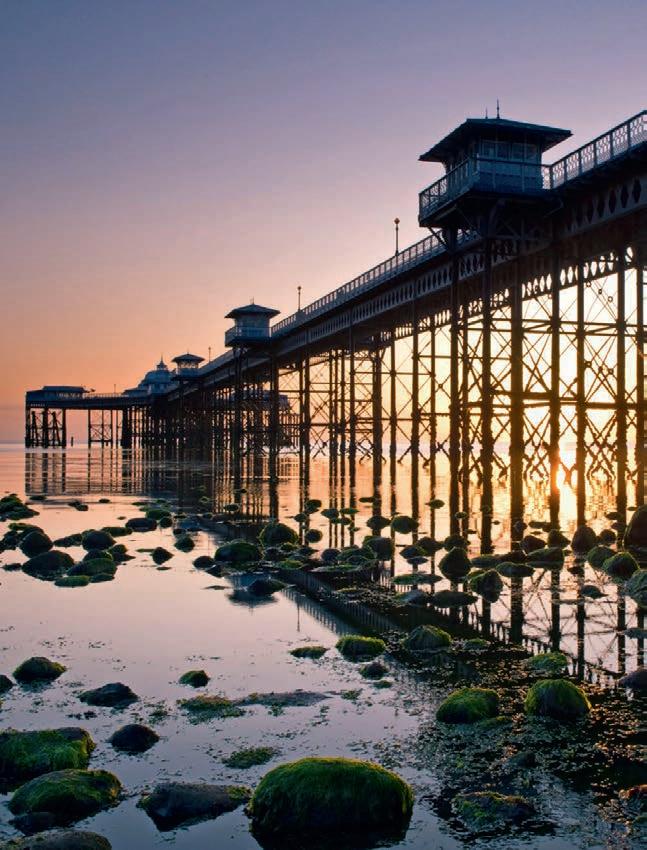 Pleasure town (above) At 700m in length, Llandudno has the longest pier in Wales, but the current incarnation wasn’t the first to be built on this site. A wooden version was originally erected in 1858, though its main purpose wasn’t pleasure; it was largely used to transfer limestone from quarries in the nearby Happy Valley to waiting ships. The pier standing today dates from 1877, a time when Llandudno was a fast-growing destination, and it became a landing stage for visitors disembarking from steamships. These days it is known as the home of Britain’s longest-running Punch and Judy show, which has been here for over 160 years
Pleasure town (above) At 700m in length, Llandudno has the longest pier in Wales, but the current incarnation wasn’t the first to be built on this site. A wooden version was originally erected in 1858, though its main purpose wasn’t pleasure; it was largely used to transfer limestone from quarries in the nearby Happy Valley to waiting ships. The pier standing today dates from 1877, a time when Llandudno was a fast-growing destination, and it became a landing stage for visitors disembarking from steamships. These days it is known as the home of Britain’s longest-running Punch and Judy show, which has been here for over 160 years
NORTH WALES www.wanderlustmagazine.com 161
Alamy
Vital statistics
Capital: Cardiff
Population: 3.1 million
Languages: Welsh; English
Time: GMT+1 (GMT Oct–Mar)
International dialling code: +44 Visas: Not required by UK nationals. Money: Pound sterling (£).
When to go
October–March: Expect chilly and changeable weather. Bring suitable clothing for the rain and cold. May, June & September: The shoulder months are ideal for exploring Eryri
(Snowdonia) and North Wales without the school-holiday hordes getting in your way. July–Aug: Places are busy and prices are hiked for the main summer-holiday season.
Getting there
Rail connections offer a useful gateway to North Wales, with Chester, Llandudno Junction and Holyhead the key hubs for regular services on the West Coast Main Line from London Euston; tickets cost from around £35 one way. Ferry services from Dublin with Stena Line (stenaline.com) and Irish Ferries (irishferries.com) sail
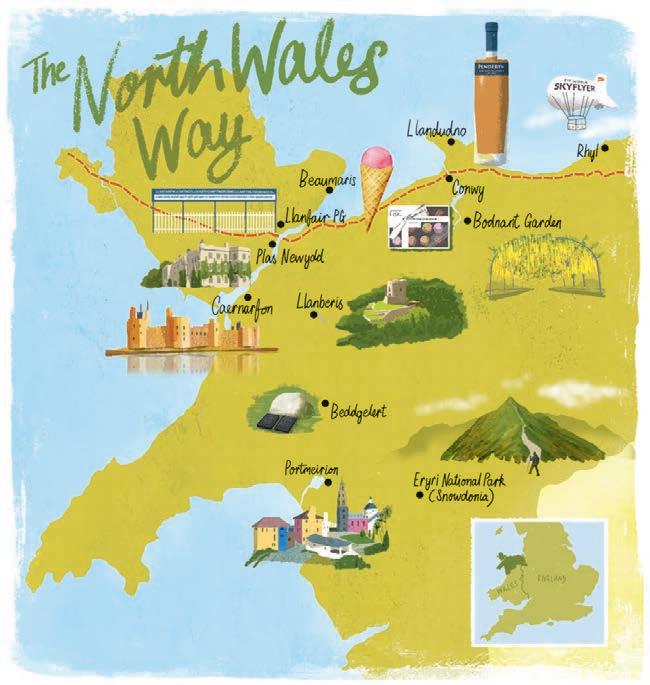
into Holyhead or Anglesey from £35 one way, with onward connections by rail.
Getting around
The main road that you will follow is the A55 North Wales Expressway, which runs from Chester to Holyhead. The North Wales Coast Line railway (nwrail.org.uk) runs largely parallel to this, with connections at Llandudno for the scenic Conwy Valley Line. Transport for Wales offers discounted Explore Wales passes (tfw.wales) for use on its lines. For walkers, North Wales forms part of the wider Wales Coast Path
162 October/November 2023
Map illustration: Scott Jessop; image: AWL
(walescoastpath.gov.uk), with many of its sections suitable for day walks. See Traveline Cymru (tfw.wales/ways-to-travel/ rail/ticket-types/rovers-and-rangers) for bus information between trailheads.
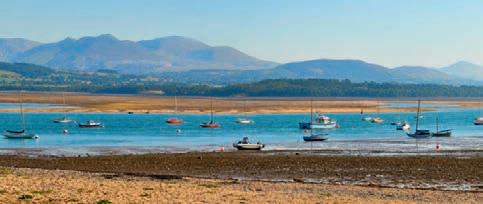
Cyclists can follow the Sustrans North Wales Coastal Route (sustrans.org.uk), and you can also buy a North Wales cycle map via the Sustrans shop.
Cost of travel
Wales is not considered a particularly cheap destination in the UK, although the huge range of accommodation and places to eat ensure there are options for all budgets. Tipping is welcome but not generally expected, with a service charge often added to bills. Membership of Cadw (cadw.gov.wales) or National Trust Wales (nationaltrust.org.uk) helps visitors to save on entrance and parking fees when visiting the region’s major historical sites.
A ride on the Zip World Skyflyer (zipworld.co.uk) costs from £20pp. The ‘All That Was Left’ exhibition is being held at Plas Newydd until 5 November, with entrance to the stately home costing £11pp; visit nationaltrust.org.uk for details.
Accommodation
There’s a huge number of accommodation options across North Wales, from caravans and selfcatering stays to boutique hotels and Michelin-starred restaurants with rooms. There’s also plenty of Welsh hospitality at informal, family-run B&Bs. Standards are generally high, and the breakfasts that are included offer a welcome taste of home cooking. Welsh Rarebits (rarebits.co.uk), in particular, has a directory of chic retreats scattering Wales that are worth exploring. The author stayed at the following:
Plas Dinas, Caernarfon, has ten stylish bedrooms, plus three self-catering cottages and a destination restaurant; B&B doubles from £199pn. 01286 830214; plasdinas.co.uk
Bodysgallen Hall, Llandudno, has period hotel rooms as well as cosy cottages and a spa; B&B doubles from £260pn; two-person cottages from £340pn. 01492 584466; bodysgallen.com
Food & drink
Wales is blessed with a thriving local food scene, with main meals often based around Welsh lamb and black beef. If you have a sweet tooth, treats such as bara brith (fruit bread) and sconelike Welshcakes can be found at Dylan’s deli in Conwy (dylansrestaurant.co.uk/ general-stores). Baravelli’s chocolaterie has premises at 13 Bangor Road, Conwy (01492 330540; baravellis.com).
Welsh spirits and craft ales are booming in North Wales, with Aber Falls distillery (aberfallsdistillery.com) and Purple Moose brewery (purplemoose.co.uk) among many local food heroes. You can try a pint with a chaser at local microbrewery pubs such as The Albion in Conwy (01492 582484) or The Australian in Porthmadog (01766 515957). The Penderyn Distillery tour and tasting costs £13.50pp; book online at penderyn.wales/tours-llandudno.
Further reading & information
Wales Coast Path (Cicerone, 2022) – Useful guide for walking the Welsh coast and seeing more of North Wales. Wales (2000) by Jan Morris – The late author’s novel is a paean to her old home. www.visitwales.com – The Visit Wales site has local information as well as route highlights for driving the North Wales Way.
NORTH WALES HIGHLIGHTS
1 Railway travel
Heritage rail enthusiasts will find lots to celebrate in North Wales, with the combined Welsh Highland Railway (from Caernarfon) and the Ffestiniog Railway (Porthmadog–Blaenau Ffestiniog) chugging for 65km through the landscape of Eryri NP (Snowdonia). festrail.co.uk
2 Portmeirion
The Italianate-style village of Portmeirion was the vision of the architect Clough WilliamsEllis. It was founded in 1925 as a ‘home for fallen buildings’ and has been a haven for artists ranging from Noel Coward to The Beatles. portmeirion.wales
3 Bodnant Garden
A historic, Grade I-listed horticultural gem in the Conwy Valley, Bodnant was established in 1874 by the industrialist Henry Pochin. Its most famous display is the Laburnum Arch, a cascade of yellow flowers that bloom in late May. nationaltrust.org.uk
4 Beaumaris Castle
Beaumaris Castle was meant to be the final piece in King Edward I’s ‘Ring of Iron’. Its design consists of concentric rings – a moat, outer ward wall and inner wall. It’s essentially a castle within a castle, but it was never finished because Edward’s attention turned to Scotland. cadw.gov.wales
5 Llanfair PG
This tiny town on Anglesey is famous for having the second-longest place name in the world (with 58 characters), though it is often shortened to just Llanfair PG. The village sign at the train station is a popular selfie stop for visitors.
WANDERLUST RECOMMENDS
The rather trippy 1960s TV series The Prisoner made a star of Portmeirion, and it’s worth going back to watch an episode or two of it in order to get a taste before visiting.
www.wanderlustmagazine.com 163 NORTH WALES FOOTNOTES
Northern star Anglesey was once a base for England’s King Edward I, whose unfinished castle at Beaumaris was meant to be the last part of a ring of fortifications built to consolidate his Welsh conquests. Today, the island is a popular retreat, with many arriving to walk its 225km-long coastal path, which skirts a scenic shoreline of dunes and woodland
The Wanderlust Club has a great range of exclusive offers, competitions and events for our members – here are just a few. Already a member? Head to wanderlustmagazine. com/your-wanderlust to find out more.
WIN! A Craghoppers fleece made with carbon emissions! Craghoppers are always pushing sustainable solutions, and this is no exception. In a world first for outdoor clothing, it is using CO2 emissions as the starting point to create a recycled polyester fabric. Not only will you look and feel good, but you’re helping the planet too. We have a man’s and a woman’s fleece (worth £85 each) to give away in a choice of colours.

WIN! A copy of Remembering Leopards



Crammed full of jaw-dropping images of the many different species of leopard that still exist in the wild, this glorious and important book (see p16) is arguably the most beautiful yet in the Remembering Wildlife series. It will make you not only want to travel to see them in their natural habitats, but also want to protect and conserve these magnificent big cats before it’s too late.
25% OFF! Purchases on the Stanfords website





Stanfords, the UK’s leading specialist retailer of maps, travel books and accessories, has been beloved by explorers and keen travellers since 1853. Members can get 25% off all purchases of the books featured in ‘Read This’ (see p45), and 15% off any other purchases from the Stanfords website.

WIN!AcopyofDKEyewitness

TheScreenTraveller’sGuide

From Stranger Things to Paddington; Indiana Jones to Kill Bill, this brand-new guide from DK Eyewitness reveals the real-life locations behind some of the greatest TV shows and films. Split by genre, it features location maps, roadtrip routes and details of studio tours. We have three copies to give away.

25% OFF! Water-to-Go Sugarcane water bottles

Completely free of single-use plastic, this revolutionary plant-based bottle is reusable, recyclable, durable and light. What’s more, the filter technology eliminates 99.9999% of bacteria, viruses, chlorine, fluoride and heavy metals, allowing you to safely drink the water anywhere in the world.

164 October/November 2023
Craghoppers; Stanfords; Water-to-Go
FIND PEACE IN THE WILDERNESS OF
WALES
WIN a
£1,000 voucher to enjoy an idyllic stay in Wales

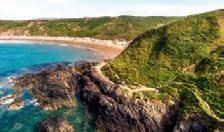
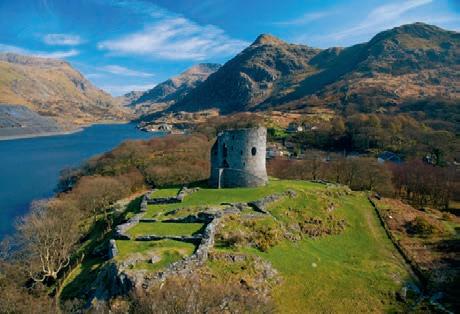
From cosy cabin stays in Ceredigion to grand manor houses on the Creuddyn Peninsula, escaping to Wales always promises a scenic getaway. Visit Wales is inviting you to enter a competition to be in with a chance of winning a £1,000 voucher for the Rarebits Collection, which has a postcard-perfect selection of eco-friendly and locallyowned stays around Wales. Whether you’d prefer to delve into Welsh culture, hike along the contours of verdant valleys or sample the flavours of local produce, a Welsh mini-break will leave you fully refreshed.
A TASTE OF WALES
For dedicated foodies and the curious alike, the culinary scene in Wales offers plenty. Bask in the comfort of a Welsh cake or Welsh rarebit, or try sampling local cheeses and a hearty cawl stew. There’s plenty of freshly foraged and fished produce to enjoy in humble inns or as part of a fine-dining experience at a Michelin-starred restaurant, such as Home in Penarth or The Whitebrook in the Wye Valley. When in Wales,
your curiosity for local flavours will be more than satisfied.

A DROP OF ADRENALINE
While Wales is ideal for enjoying some downtime, it’s also a haven for adventure seekers. If switching off means getting out in the wild, then a break in Wales could see you hiking windswept coastal trails, mountain biking through the hills and valleys, zip-lining through a mine or rafting down river rapids. From a walking odyssey on the North Wales Pilgrim’s Way to intrepid coasteering in Pembrokeshire, outdoor adventure is easy to pursue in Wales.
A SPOT OF STARGAZING
It’s no secret that Wales is home
A rare find (clockwise from top left) Castell Dolbadarn is at the base of Llanberis Pass; get stuck into some stargazing in the Bannau Brycheiniog (Brecon Beacons); see Wales from above on a dramatic zip-lining experience; the Llŷn Peninsula has 100 miles of dramatic coastline; tuck into a locally sourced delicacy at St Brides Spa Hotel, Saundersfoot
to spectacular natural landscapes. When you’re not taking on the likes of Eryri’s (Snowdonia’s) peaks or the surging rapids of the River Dee, take a moment to appreciate the immaculate dark skies overhead. Head to the Llŷn Peninsula, the Isle of Anglesey or the Eryri (Snowdonia) International Dark Sky Reserve to marvel at the mesmerising constellations.
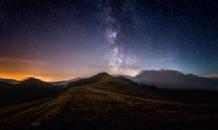
HOW TO WIN
Visit Wales is offering a £1,000 Rarebits Collection accommodation voucher. For a chance to win, please answer the following question: Which of these ingredients is not typically used in Welsh rarebit?
A) Beer B) Cheese C) Rabbit
To enter and for full terms, conditions and data policies, please go to wanderlust.co.uk/competitions. The closing date is 20 November 2023.
COMPETITION For more information on planning a Welsh
head to the official Visit Wales website: www.visitwales.com
escape,
Visit Wales; © Alyn Wallace
Photography
Take an autumn road trip through the
CAPITAL REGION
From America’s cosmopolitan capital, Washington, DC, to the forest-clad peaks of Virginia and the sweeping beaches of Maryland, the Capital Region’s diverse delights offer a spectacular backdrop for any road trip, whatever the season. But if you choose to hit the highway in autumn, the fall displays will make your memories burn even brighter.
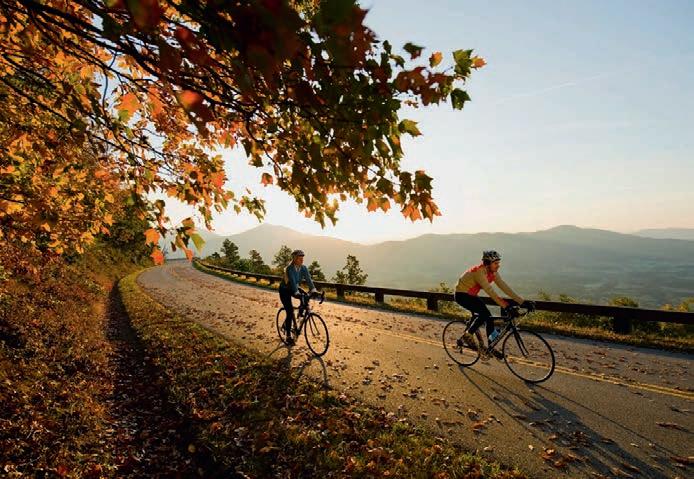
KICK OFF IN THE CAPITAL
With more than 20 neighbourhoods, 24 Michelin-starred restaurants and some of the world’s best (and free) galleries and museums, Washington is the perfect place to kick off your Capital Region road trip. Fly into Washington Dulles International and spend a few days discovering American icons such as The White

House and the National Mall, a 3km-long national park linking the US Capitol, the Lincoln Memorial and a slew of excellent Smithsonian institutions, including the National Museum of African American History and Culture. Next up, head to new waterfront development The Wharf, for drinks, dinner, or live music at
The Anthem, or perhaps explore the eateries, lounges and boutiques edging the canals of Washington’s historic district, Georgetown. As one of America’s most walkable cities, DC is ideal for clocking up some steps (or hiring a bike) before picking up your rental car and hitting the road.
HISTORY AND HARVESTS
Leaving the capital behind, drive across the striking Arlington Memorial Bridge, which spans the Potomac River; you’ll soon arrive in Northern Virginia, known locally as NoVA. Here you’ll find one of the United States’ most venerated sites, Arlington National Cemetery, which honours those who fell in service of their country, and is also home to the grave of President John F Kennedy. Autumn is a special time to visit, as the trees in the gardens and Memorial Arboretum start to glow gold, russet and red.
Nearby lies another of America’s legendary buildings, The Pentagon – headquarters for the United States Department of Defense – and its moving Pentagon Memorial, which was created to remember and honour those who died in 9/11. Before you hop back in the car, expore some of Arlington’s leafy parks like Glencarlyn
166 October/November 2023
Motor past historic cities, national icons and fiery fall colours on a road trip around the USA’s Capital Region in autumn
Golden glow (this page; top to bottom) The landscape along the Blue Ridge Parkway is the ideal backdrop for an autumn cycle; the Lincoln Memorial is bathed in fiery sunset colours
Park and Potomac Park to stretch your legs and get one last glimpse of Washington, DC before you hit the road again.
Set your sat nav for Frederick County, where you’ll find harvest festivals, farmers’ markets and pickyour-own farms worthy of a pit stop. Several major US Civil War battles occurred in this area. Today, Frederick is rich with historic sites you can visit that depict different elements of the conflict, like the Monocacy National Battlefield and the National Museum of Civil War Medicine. Continue on to the undulating forested mountains of Shenandoah National Park, where you can cruise one of America’s most scenic highways: Skyline Drive. Running the crest of the Blue Ridge Mountains, this 169km route offers spectacular views of foliage aflame with vermilion and tangerine, plus a chance to spot black bears when the autumn temperatures are mild as they stock up for their winter hibernation.
The next stop is Charlottesville, the historic hometown of former US President Thomas Jefferson, whose 2,000-hectare plantation, Monticello, and the nearby University of Virginia combine as a designated UNESCO World Heritage Site. By this point, you may be ready for a libation, so you’re in luck. Virginia is one of the USA’s top wine-producing states, and Charlottesville has more than 40 wineries on its Monticello Wine Trail, along with many more craft breweries, distilleries and cideries.

A REVOLUTIONARY RIDE
A few kilometres on, Williamsburg awaits, where you can browse restaurants, bars and boutiques before heading back in time to explore the world’s largest living history museum at Colonial Williamsburg. Nearby Jamestown Settlement commemorates the first permanent English colony in the United States, established in 1607, and has an immersive dive into 17th-century life. Visitors can also walk in the boots of a Revolutionary War soldier at the American Revolution Museum at Yorktown.
Next, leave the battlefields behind for a stay on the sandy shores of Virginia Beach, where Chesapeake Bay meets the Atlantic Ocean. It’s a great place to quench your thirst, with the Virginia Beach Beer Trail offering

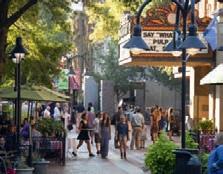
opportunities to sample some of the region’s best craft brews. There are also plenty of other ways to stretch your legs: try fat-biking along the shore, strolling the famous Oceanfront Virginia Beach Boardwalk and ViBe Creative District, or hiking through dunes at Back Bay National Wildlife Refuge, looking out for birds, bobcats and loggerhead turtles.
An exciting drive awaits as you cross the Chesapeake Bay BridgeTunnel to Virginia’s Eastern Shore and head on to Maryland. Take time to explore the largest estuary in the United States. Local outfitters make
Hit the road (this page; clockwise from top left) The Governor’s Palace in Williamsburg is an iconic landmark; downtown Charlottesville is a great place for a stroll; go kayaking along Spa Creek in Annapolis; spy the Atlantic Ocean from Virginia Beach; stop by Baltimore’s American Visionary Art Museum to see some thought-provoking creations
it easy to get out on the water via paddleboard, kayak or chartered boat trips. Make your base in the lively port city of Annapolis, which is also known as the sailing capital of the USA. It offers plenty for foodies, too, and makes for a scenic gateway to the historic waterfront towns that scatter the region, including Edgewater and Shady Side.
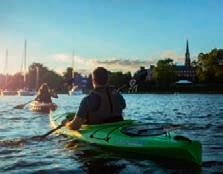
The final stop on this road trip is Baltimore, where revamped districts, repurposed architectural gems and a thriving arts scene make this an underrated city escape. Time your visit right and you’ll catch the Halloween celebrations, which are suitably lavish for one of America’s oldest (and reportedly most haunted) cities. To get in the mood, take a ghost tour of historic Fell’s Point or the former home of macabre US writer Edgar Allan Poe, then let Maryland’s dazzling autumnal displays lift your spirits on the drive back to Washington, DC.

PROMOTIONAL FEATURE www.wanderlustmagazine.com 167 For more information, visit: www.capitalregionusa.org
Virginia Tourism Corporation; Washington.org; Jason Varney; Sam Dean; Visit Annapolis

JEDDAH Therebirthofold
WordsLynHughesandEmmaThomson
PhotographyWilliamGray
As efforts to restore Al-Balad, Jeddah’s historical district, take hold, we get an exclusive peek at how art and culture are taking centre stage
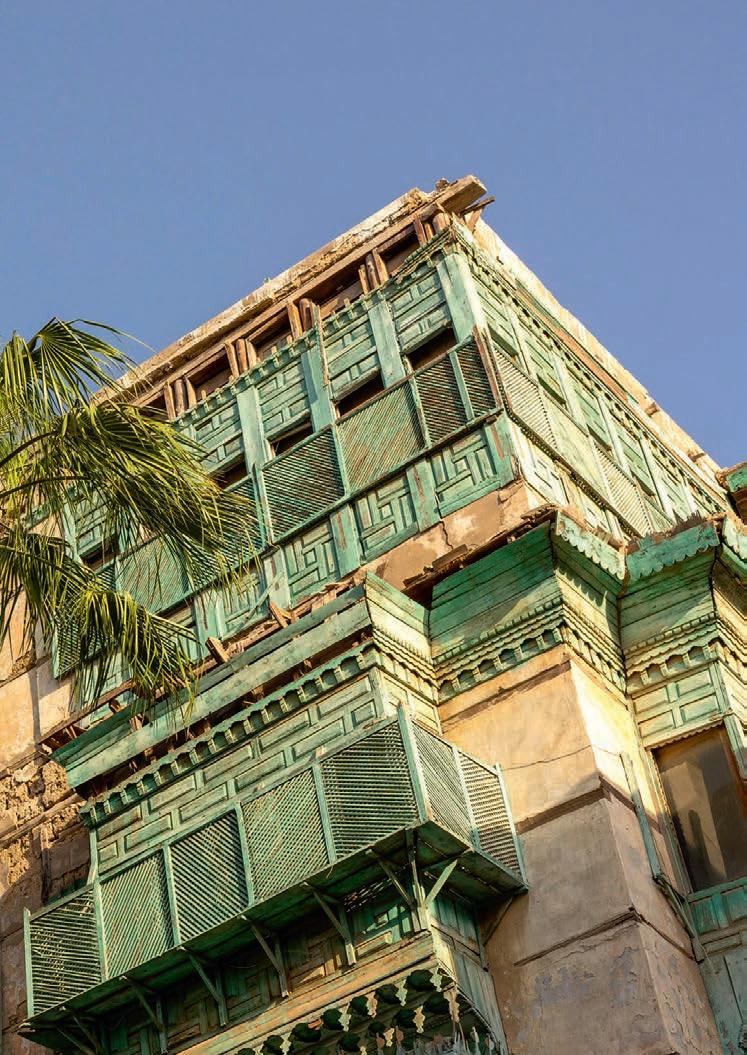
Al-Balad: Regenerating the past
Restoring Jeddah’s historic district offers not just a connection to another time for visitors, but a vital link for a local community that still considers it very much a part of the present
When I tipped my head to the side, I could almost hear the clop of camels’ hooves on the cobblestones, their saddle bags bulging with cloves, pepper and ginger from the Far East; porcelain, jade and silk from China; and cardamon, cumin and turmeric from India, all unloaded from dhows that had sailed up the long barrel of the Red Sea. Some of them would have been led out into the desert by traders, others marched upstairs and into the kitchens of coral-stone mansions so tall that they carved the sky into thin blues lanes.Today, the dromedaries may have disappeared from the streets, but you can still buy spices in the souks, hear the call to prayer issuing from candle-like minarets and step inside the ancient homes of Al-Balad, Jeddah’s UNESCO-listed Old Town.
Jeddah started life as a modest fishing village, but when the third Caliph, Uthman Ibn Affan, visited in 624 AD to swim in its waters and pray on its soil, he declared it the main entry port to Makkah (Mecca) and its fortunes changed almost overnight. Devotees travelling for Hajj (the pilgrimage to Mecca) flocked through the city walls – which were only torn down in 1947 – and the town
became a major stopping point on the silk, spice, coffee and incense trade routes.
Over the centuries, many explorers have passed through Jeddah, including Ludovico de Varthema, Ibn Battuta, Richard Burton and TE Lawrence (better known as Lawrence of Arabia).When writer Paul Salopek visited Al-Balad in 2013 as part of his ‘Out of EdenWalk’ – a 38,600km odyssey to retrace our ancestors’ global migration routes – he wrote: “Modern-day Saudi Arabia has lost so much of its memory beneath sleek highways, parking lots, hotels, malls,” but here “is a remnant world – a preserved square kilometre of remembering.”
However, during the 1970s oil boom, locals moved out to modern complexes and the Old Town was largely neglected. On average, two buildings per year either fell down or were lost to fire, so in 2018, the Ministry of Culture appointed the Jeddah Historical District Progam (JHD) to oversee the restoration of Al-Balad. The area comprises four districts – Harat Al-Sham, Harat Al-Mazloum, Harat Al-Bahar and Harat Al-Yaman –and contains five historic souks, 36 mosques and 650 centuries-old mansions. Even today it still hums with

170 October/November 2023
Jeddah Historic District
busy brick-oven bakeries and traditional coffee shops, and has its own 170-year-old restaurant.

“Old cities are like bodies, the lanes like veins – they arise organically. And that hasn’t been lost in Al-Balad,” said Ahmed Angawi, founder of artist collective Zawiya 97 (see p179). Indeed, the area has managed to maintain a sense of community down the years, whether that is found in locals gathering five times a day to stand shoulder to shoulder while praying at Al-Shafi’i Mosque with its 800-year-old minaret, or in those joining the Jeddah Academy of Fine Arts for its outdoor classes, it is a familiarity that endures. Many of the people who work here have memories built into its old coral stones.

“My grandfather was a merchant in Al-Balad, and my mother still buys her groceries here,” said Rawaa Bakhsh, communications manager for the JHD, as we sat in her office inside the 120-year-old Beit Jamjoom in the heart of the Old Town. “In some restored places around the world, the soul has been sucked out – not here. This isn’t a ‘living museum’ – our aim is to regenerate and revive.These houses long for their people. Like two lovers, they thrive when they’re together.”

The JHD is aiming to avoid the mistakes that have been made by other cities around the world in restoring their old quarters.
“We don’t want a Venice or Dubrovnik. So, cruise ships will have to moor 2km away,” said Abdulaziz Alissa, director general of the JHD. “This includes returning to how it looked in 1948, when the sea lapped at the shores of the old city,” he added.
There is a real sense of time travel here. Perhaps it’s because in Saudi Arabia it’s still the year 1445, thanks to the lunar Hijri calendar, or because just north of Al-Balad sits the cemetery which legend says was the burial place of Eve, who is said to have alighted on a mountaintop here after she was exiled from Paradise. Indeed, the name Jeddah is believed to derive from the Arabic word ‘jaddah’, meaning ‘grandmother’ (Eve is often called the grandmother of humanity), and it has been suggested that the city may be one of the world’s oldest.What is undeniable is the feeling of being transported to another era as you wander the alleys of Al-Balad. I guarantee you’ll be listening for the clop of a camel around each corner. ET
AL-BALAD, JEDDAH www.wanderlustmagazine.com 171
⊲
The grand plan (clockwise from far left) Jeddah’s history as a thriving port enabled generations of wealthy merchants to build elaborate townhouses that rose ever higher, as space in the Old Town, which was walled until 1947, was tight; Jeddah’s days as an emporium for spices from around the world are far from over; plans to restore the Al-Balad historic area are geared around preserving it for both the future and the local community, many of whom still work and shop there; local families fill Al-Balad’s streets; (previous spread) the Old Town is home to around 650 historic houses, the majority of which require urgent restoration work
Back to the start again
The difficult task of restoring and saving hundreds of Al-Balad’s leaning townhouses is just part of an even larger project, aimed at transforming the Old Town without losing its soul
“This is a national treasure,” said Rawaa Bakhsh of the Jeddah Historical District Program (JHD). “Al-Balad should be for everyone. Our intention is to restore and regenerate it, not to gentrify. It’s a walkable city with a strong sense of community that we want to keep, and we aspire to be a model for sustainable development.”

Strolling the streets of Al-Balad can be like stepping into an Arabian Nights fantasy, thanks to the aromas of oriental spices, the shopkeepers trading just as their forefathers did, and the recurring soundtrack of the call to prayer. But then you turn a corner and you’re brought straight back to the modern day by the sight of workers in hard hats and hi-vis.
The restoration project is part of the country’s Vision 2030 plan for economic and social reform, and it’s nothing if not ambitious.The JHD office lies in the middle of Al-Balad, where the team is split 50/50 between men and women. I met with Sami Nawar, who through one capacity or another has devoted himself to preserving the area.
“About 80% of my working life is spent in the historical district, first as the director of inspection and then as director of the Historic Preservation Department. My job was to protect the city. I was very lucky to work in this position for 24 years.When I retired from the government, his Highness hired me; now I work with this beautiful team.”
Sami knows Al-Balad better than anyone and is a mine of local anecdotes, including tales of showing around the late Prince Philip, who recalled visiting as a 20 year old. And as for the local belief that Eve once settled in Jeddah: “I have searched for any other city in the world that has a similar legend and there is none,” he told me.
“We have 650 buildings ranging in age from 150 to 1,400 years old, and we have a project to restore all of them,” he said, talking me through their layouts. “The ground floor was for men, the ladies were upstairs for privacy. Some of the more modern houses – and when I say modern, I mean
150 years old – have their kitchens upstairs and were built so that horses and camels could deliver goods up to them.”
The buildings are being bought up in preparation for restoration, which can be a complex task if the family moved out decades ago, or if there are multiple owners –one had as many as 300, I was told.The former owners can also continue to be involved with the building in some way, whether using it for their business or some other project.
As I saw more houses, I began to see how they had been built to fit their setting. Jeddah’s position on the coast was instrumental not just for its role as a port and gateway for pilgrims, it also affected the architecture.“The houses are sometimes shaped according to the wind,” said Sami. “If you go to my family house, you will see a U-shape facing the sea.” Sections of Jeddah’s waterfront were filled in decades ago to accommodate urban expansion, but an important part of the JHD project is going to be to reconnect the Red Sea with Al-Balad and to restore the historic Al-Bunt Port.
The plans are far reaching and extend beyond the core UNESCO zone. It is also good to see a new generation getting involved with the restoration.The JHD collaborates with the Royal Institute of Traditional Arts, which has a branch in the heart of Al-Balad.They offer courses that teach students – 70% of them female – traditional crafts such as woodwork, natural dyeing and painting.They recently completed a roshan that they carved and slotted together without using a single drop of glue.This will be placed on the façade of one of the restored homes.
I had been amazed by the passion of the people I had met here, whether they were business owners, artisans, guides, or worked on the project. I mentioned this to Rawaa.
“Once someone works in Al-Balad, it’s hard to leave. Most of us had family here, so it’s our duty to restore it,” she said.That sense of duty was clear to see, but I was struck by something more: a shared desire to restore Jeddah’s Old Town to its place as ‘the grandmother of the world’. LH ⊲
172 October/November 2023
Rising high (this page; clockwise from top right) While Al-Balad’s more modest dwellings rise just two or three storeys high, more opulent buildings, such as Beit Nassif, rose far higher as a symbol of wealth – its third floor even once housed a hammam; the blue colour of Al-Balad’s rawasheen stems from a local mayor falling in love with the houses he saw in Tunisia; the detailing on the Old Town’s doors and rawasheen are like fingerprints; the height and proximity of the taller buildings help to shade the street below; Sami Nawar’s house is over 300 years old; (left page) after the walls of Jeddah fell in 1947, the city spread far and wide
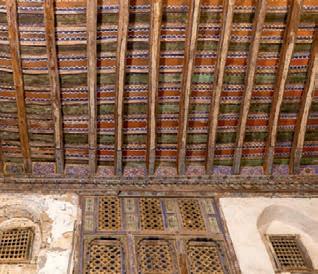
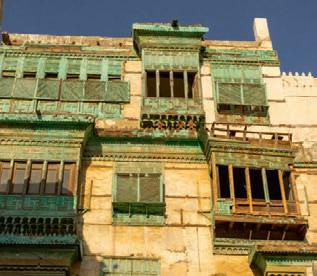

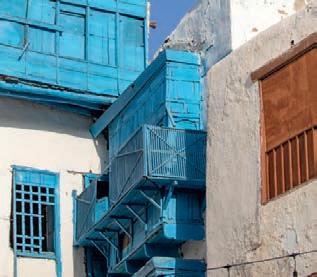


AL-BALAD, JEDDAH www.wanderlustmagazine.com 173
Designs for life
The stars of Al-Balad are its 650 or so townhouses. Their intricate balconies and facades offer a thrilling glimpse of the past but, for many years, were in danger of disappearing
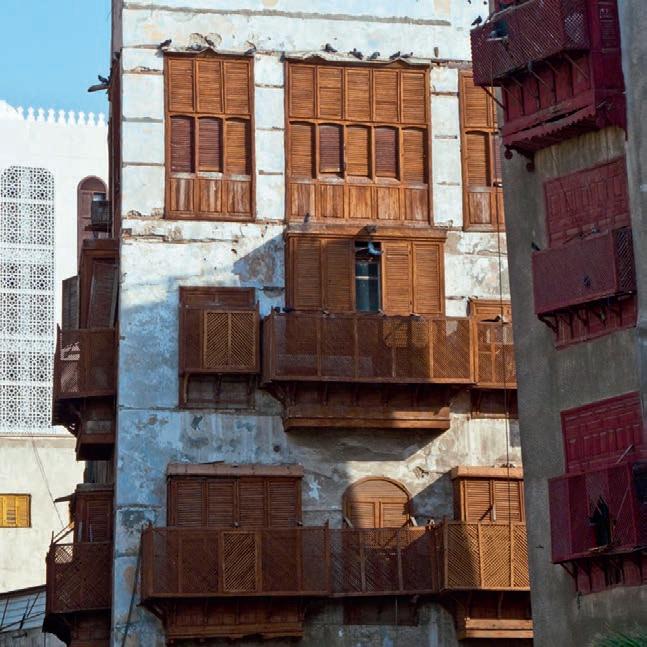
The UNESCO-listed houses of Al-Balad sat in crooked rows that resembled old teeth – white but worn around the edges.They lined up along a labyrinth of cobblestone alleys, their facades gilded with arches, doors and latticed screens so intricately carved that even hundreds of years later, you could still sense the devotion their craftsmen had put into each notch and niche.
“Their genius is shown in techniques that have stood the test of time,” said Rawaa Bakhsh, communications manager for the Jeddah Historical District Program (JHD).To walk among them is to travel back in time, and some buildings contain fragments dating back 1,400 years.They also offer travellers a chance to see architecture similar to that of the holy city of Mecca, which is closed to non-Muslims.
Built from East-Asian teak and coral stone taken from the Red Sea, these homes reflect the evolution of Al-Balad.
“Architects call the coral stone ‘biscuit’ because it crumbles so easily,” explained our guide, Abir, who pointed to a hunk of coral in the corner of one building.The walls stand a bulky 80cm thick, but because the foundations are only a metre deep, their weight often causes them to tilt left or right. “I call them dancing houses,” smiled Abir.
Much like the guildhouses lining Brussels’ Grand Place in Belgium, these mansions were symbols of the might and fortunes of the great families of the city, who had accrued their wealth by importing everything from fruit to spices.
“I can tell you whose house is whose based solely on the windows,” said Abir, pointing to the rawasheen – enclosed balconies that jut out and are decorated with carved latticework designs known as mashrabiyas.This is one of the defining characteristics of Hijazi architecture, and homeowners would choose their patterns from a complex
174 October/November 2023
Alamy
combination of options so that no two were the same. “They are the fingerprint of the building,” said Abir.
Other typical features include the takaleel – wooden beams running through the walls – that help to distribute the house’s weight evenly, the latticework on the roof and the geometric or floral carvings that sit above the doors.The word ‘rawasheen’ (or roshan in the singular) comes from the Persian ‘razin’, meaning ‘source of light’, and they come in three colours: the natural brown of the teak, green to celebrate the Saudi flag, or sky blue because a former city mayor once visitedTunisia and fell in love with Sidi Bou Said.
But these architectural elements are not built just for beauty.Their design is highly functional. In the kiln-hot heat of Saudi, the high homes cast cool shadows across the alley and provide relief from the unrelenting sun, while winds from the sea (which used to be much closer) would be funnelled down the narrow alleys and into the protruding rawasheen, which are closed on the sides so that the air is forced to curl up and waft into the room.Their latticed patterns also allowed women sitting in the cooled rooms to view what was going on from behind a screen of privacy.
Inside, the ground floor was reserved for the men’s majlis (sitting rooms) and a space to welcome pilgrims, while the upper floors were for the family and kitchen.These buildings have no gardens because the communal squares were considered an extension of the home, and men – and sometimes women – would gather there in the evenings on high wooden benches to drink tea and talk. (For a glimpse inside some of Al-Balad’s historical homes, see p178.)
But the undoubted jewel of Al-Balad’s historic homes is Beit Nassif. Located on the main road to Mecca, and guarded by an ancient neem tree, this 106-room mansion was built in 1881 by the governor of Jeddah and was used as a royal residence by King Abdulaziz Ibn Saud for a few years in the late 1920s. Since 2009, it has served as a museum and cultural centre, but it is currently undergoing restoration. It also forms the core of many memories of the Old Town for local Jeddawi.

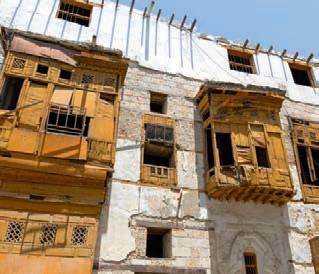

“I remember when I was a child and I was sent to buy ice,” recalled historian and engineer Sami Nawar. “I was carrying it back on my head, but my head had become numb from the cold, so I stopped outside Beit Nassif to play with the leaves and found ten riyals – that was like finding 1,000 riyals today. But then the ice melted!”
Sami, who holds the keys to the building, had kindly let us in, and what struck me first were the scalloped steps of the staircase, which are famously wide enough to allow a camel to carry supplies up to the kitchen on the top floor.
On the ground floor was a museum filled with treasures: tombstones from the cemetery where legend has it that Eve was buried and one of two ebony pillars taken from Sri Lankan ships found at the nearby site of Uthman Ibn Affan mosque.Wood is scarce in Saudi, so builders would often repurpose it from boats. But the real jewel here is the house itself, and as you wander it, you slowly begin to appreciate just how unique Al-Balad is. Beit Nassif is currently only open at weekends (5–10pm), but it should be open more frequently in 2024. ET ⊲
The art of good design (this page; top–bottom) The façades of Al-Balad’s historic houses were designed to catch the breezes that rolled in from the sea, funnelling the cooler air into the interiors of the houses via rawasheen, whose shutters and fretwork directed it where needed; these enclosed balconies doubled as cool spaces in which to sit or sleep when the heat got too much; the flat-topped roofs of houses also provided a welcome escape from the heat, and were often where locals would escape to, hidden behind elaborate screens – Beit Nassif even had a rooftop pavilion; (left page) demand for land within the enclosed city meant houses were typically built without gardens or outdoor spaces (except for the rooftops), so the city used to have many communal gardens
AL-BALAD, JEDDAH www.wanderlustmagazine.com 175
Reading the room (this page; clockwise from top left) Writer Emma Thomson fits right in; hardwoods imported from the East Indies were essential materials used in the design of Al-Balad’s traditional houses and were inevitably the most expensive part of any build; the designs of the old houses reflect the lives of those who lived in them, with many having doubled as both residential and commercial properties; in line with the tenets of traditional Islamic art, decorative designs are nearly always geometrical; visiting a local antiques stores; special care was always taken with the design of the main entrance to a home – these were often intricately carved, as this is the first thing that visitors would see; a design by Ahmed Angawi; (right page) a typical street scene in the Old Town

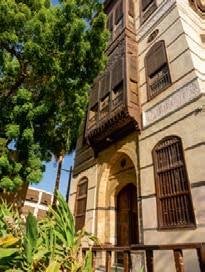

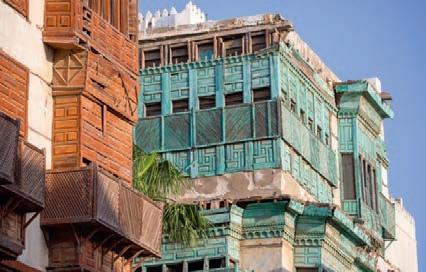



176 October/November 2023
AL-BALAD, JEDDAH
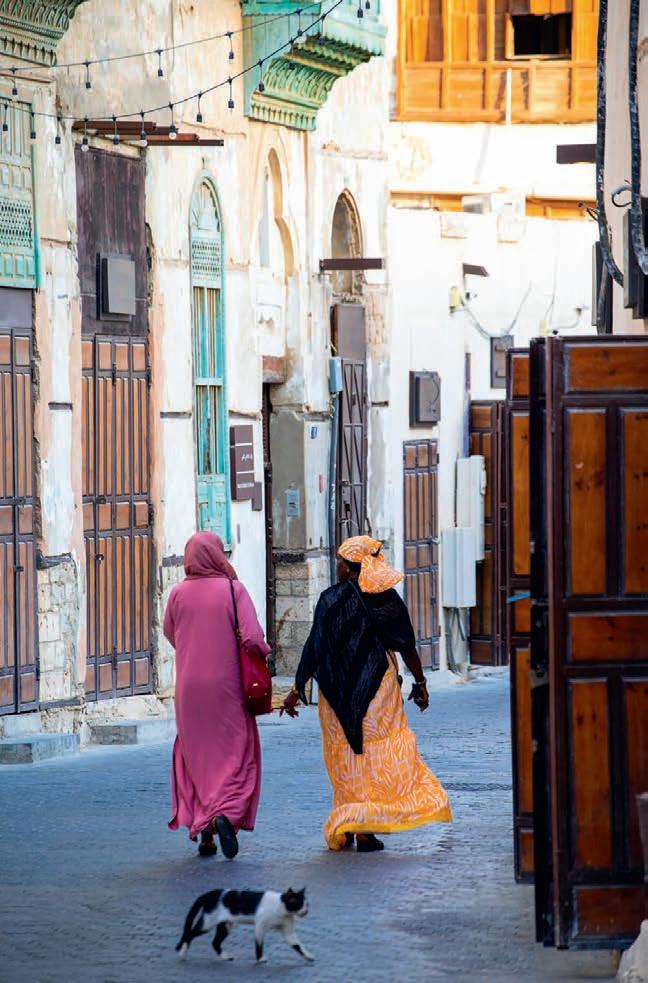
Top five historic houses to visit

Al-Balad is filled with historic homes that offer a unique look into how life in the city used to be
BEIT BAESHEN
During the heyday of merchanting in Jeddah, the Baeshen family rented out ships, and with the money they made from that, they built this staggering six-floor townhouse in 1856. It’s one of few left in the city with the traditional three entrances – one for men, one for women and a third for servants – and also boasts its own private mosque. Later, the family began trading tea, and their brand’s popularity in Saudi is now on a par with Lipton.This wealth allowed them to restore the house themselves – look out for the family tree on the right side of the entrance. As well as exhibits on the ground floor, the women’s entrance leads to a local art gallery, while the old annexe is now the Historical Nights café (see Footnotes). Baebasah Lane; entry is free.

BEIT SALLOUM
Located very close to Beit Baeshen, and perhaps the most museum-like of the traditional houses that have been opened to visitors, this four-floor mansion was built in 1880 and hails from a similar time period to that of Beit Nassif. Its vintage belongings have been preserved to create something of a time capsule – some of the furniture imported from India is more than 120 years old. Look out for the karaweeta (high benches for storage and relaxing) in the men’s sitting room, the bridal trunk and the newlyweds’ clothing laid out in the master bedroom, the gramophone in the upstairs family sitting room, as well as the old canned foods and pre-electricity fridge in the cupboard-sized kitchen. Al-Kabli Lane; £2 entry fee.
BEIT NASSIF
Built in the late 1800s, this is the jewel in the starry firmament of Jeddah’s historic houses. But Beit Nassif remains tricky to see for the moment; its opening hours are due to improve in 2024, but for now you can only visit at weekends (5–10pm). Nevertheless, it remains a fine example of local architecture and has served as a museum and cultural centre since 2009. Its splendour is to be expected, since this was once the temporary home of King Abdulaziz Ibn Saud, and its hallways have hosted countless ambassadors since. For a long time this was also known as the ‘House with theTree’ because it opens onto a square with a neem tree on it, which was the only one in the whole of Jeddah for many years. Al-Dhahab Street; see p174 for more details.


BEIT MATBOULI
More than 420 years old, this four-floor beauty belonged to a family of spice traders, and it arguably feels like the most untouched of all the historic homes that have been opened to the public in Al-Balad. Make your way to the sitting room at the back to discover intricately carved niches made from al-mangabi stones that have been excavated from the Red Sea as well as ebony chairs chiselled from wood imported from East Asia; there is even an old well that can be found off to one side of the living room.The only downside is that access to the rooftop is closed; however, for those interested in local traditions, it does occasionally host ‘bride nights’, so visitors can see traditional bridal preparations for themselves. Souk Al-Alawi; £2 entrance fee.

BEIT AL-SHARBATLY
Built in the early 20th century, this four-floor, whitewashed home is considered one of the finest in the Old Town, thanks in no small part to its ornate Hejazi balconies. It was purchased by Al Sayed Abdullah Abbas Sharbatly, who earned his fortune importing fruit and vegetables and is still a big name in Saudi Arabia. For two decades, the mansion also served as the headquarters for the Egyptian embassy.There are exhibitions on the ground floor and the restored home now operates as a cultural centre that offers free music nights and craft workshops that can be booked via Instagram. It’s also possible to visit the rooftop for bird’s-eye city views. Al-Matt’haf Lane; entry is free. ET
178 October/November 2023
Alamy
The lost arts of Al-Balad
A unique workspace in Al-Balad is enabling artisans practising traditional skills to breathe new life into crafts that are slowly disappearing – and visitors are invited along for the ride
ÒTechnology will always advance, but we inevitably come back to balance, back to art, because it’s our human nature – we’re tied to the sacred,” explained the bearded Ahmed Angawi, leaning back in his office chair beneath the ancient beams of the Beit Al-Sharqi building.

Son of the famed Saudi architect Dr Sami Angawi, Ahmed is a respected artisan in his own right – five of his carved wooden mangour screens hang in the British Museum. He is also the founder of Zawiya 97, a collective that celebrates heritage, culture, craft and art by offering workspaces inside a series of old buildings – located just behind Beit Nassif – to artisans producing contemporary products that use traditional techniques.
Ahmed grew up visiting his father’s house in Al-Balad. “Seeing my father interacting with artisans here inspired
me,” he said. “It’s about reviving what was here before: spaces to eat, work and live, and to melt the division between art and artisan, returning it to what it once was,” he continued before turning to gaze out of the window.
In order to foster talent and protect its meaning and role in community life, Zawiya 97 also hosts free lectures and music concerts every Thursday.These are open to both locals and travellers and are followed by a homecooked meal – using ingredients from neighbourhood suppliers – at the community kitchen.
“Al-Balad is like a river; people flow through here, so we try to pick those that will create the right environment. We live in a very important time for defining our [Saudi Arabia’s] identity as we reopen to the world. I want to take what’s good from the past and adapt it for now,” he said, tapping his desk to drive home his point.
AL-BALAD, JEDDAH www.wanderlustmagazine.com 179
⊲
Point and carve Ahmed Angawi shows how he designs his intricate mangour screens, an integral feature of traditional Hejazi architecture
So far, Zawiya 97 has offered residencies to 20 artists and artisans. One of them is the fashion designer Reem Abdulghani, who left Saudi Arabia when she was only eight years old on account of her father’s work. She returned three years ago, but while she was abroad, she earned a masters degree at Polimoda, Florence’s premier fashion school, and worked in the embroidery department at Roberto Cavalli before developing her own 3D embroidery technique.

“It was like an eruption,” Reem explained. “I had felt closed, then through embroidery I bloomed again. It’s like painting with thread. Put fabric in front of me and creativity flows – it’s just me, the thread and the fabric.”
In the hope of empowering other women, Reem now offers free embroidery workshops. She has also launched her own clothing label, but none of it has come easily.
“I had to revisit the ‘Reem’ who had grown up here,” she said, sitting behind the embroidery table in her studio, which doubles as a small giftshop and sells her embroidered tote bags, key chains and hair scrunchies.
“I visited Al-Balad for a workshop and felt very attached to the place – one week later, I had an interview for an artist’s space, and then I found out that the building had belonged to my family a long time ago,” she marvelled.

Her garments combine Islamic designs with styles from her travels. “I never follow trends – it’s all about emotion. I try to incorporate feminine energy by moving away from blacks and beiges and using colours such as fuchsia and yellow. Girls of my generation connect with the bold theme
of the designs because, in a small way, they aim to encourage more inquiry into our emotions and decisions – they start to ask themselves: what’s ok for me and what’s not?”
Another of Zawiya 97’s artists is 29-year-old Hassan Mohammed, a woodturner who is well aware of how niche his craft is. “There are few woodturners left now – it’s rare in the world, not just Jeddah,” he told me as we stood in his workshop, my nostrils filled with the scent of warm wood.

“Back in 2015, I decided I wanted to carve my own chess set, but there were no teachers, so I had to teach myself,” Hassan said, gesturing to the heavy machinery at the back of his studio. “In doing so, I discovered the art’s great history and realised there was an Al-Kheratah (Woodturner Lane) in Al-Balad. People of my generation come to this area for the nostalgia, but the younger generation come to be part of the old quarter’s new movement.”
I picked up one of the bowls on display. “Wood is precious here, so whenever they’re cutting branches in the neighbourhood, they call me,” Hassan told me proudly. “I don’t try to fix the imperfections, but I love giving life to a dead piece of wood that will last generations.”
He turned a bowl over to show me where he’d engraved the name of the wood used and the date it was made. As I was leaving, I pointed to the shop sign hanging inside the entrance. It read ‘Aromat’. “It’s an old Arabic word meaning ‘the roots of the tree inside the land’ – like me here in Zawiya,” he finished. Visit zawiya97.com for more information. ET

180 October/November 2023 AL-BALAD,
JEDDAH
Crafting a future (clockwise from bottom left) One of the wooden designs of Hassan Mohammed, who battles with the reality that wood is a precious resource in the arid climate of Saudi Arabia, so he is often given a heads up whenever branches are being cut locally; Reem Abdulghani is hard at work on her embroidery; the geometric creations of Ahmed Angawi, who studied industrial design at the Pratt Institute in New York before returning to his homeland, where he employs traditional Hejazi designs in his work; iconic painter Hisham Binjabi is the founder of the Jeddah Academy of Fine Arts; Hassan proudly holds one of his bowls
Finding the right expression
Al-Balad is home to a number of art academies, spaces and studios offering a platform for young artists, as well as visitors looking to discover the complex story of Saudi expression

Dried vines sprouted from the latticed-wood windows of the Jeddah Academy of Fine Arts, the entrance of which is announced by two giant papier-mâché fish and a whimsical tin-can camel. Inside, acclaimed artist Hisham Ahmed Binjabi sat adding the final dabs of oil paint to a vase of flowers that he had captured on canvas.With his white leather loafers, paint stains on his cuffs and grey hair scraped back into a ponytail, he certainly lived up to his image.
“There’s not a minister or prince that doesn’t have a painting by Hisham,” elaborated my guide, Abir, as we stepped into the cool embrace of the studio.
Hisham set up this space to represent and support the work of 20 up-and-coming artists (more than half of them women). He ushered us toward an L-shaped, green-brocade sofa and platters laden with glasses of lemon juice
and slices of chocolate cake. Behind him hung portraits of Prince Majid, a former Saudi governor, and King Abdulaziz Ibn Saud, the founder of Saudi Arabia.
“I’ve painted all my life,” said Hisham, gesturing to the frames that hung all around us.“But my first job was painting house walls.”Things have certainly moved on, and he has since risen to become one of Saudi’s most respected and trusted artists. “I cannot breathe without art,” he told me. “Art is what it means to be human; it’s like flying and standing in flowers at the same time – pure freedom.”
It has also taken him many places, and he freely reels off the famous figures he has encountered along the way.
“I visited the Prince of Wales, Charles, for three days to meet local Welsh artists back when he’d just married Diana,” he recalled, pointing to a faded framed photo of the pair.“And I met Salvador Dalí at a lecture in France.
www.wanderlustmagazine.com 181
⊲
He arrived in a diving suit and flippers, said ‘hello,’ and then declared the lecture was finished! And King Faisal… he asked me to sit and paint him live, not from a photo.”
During his career he has witnessed plenty of change when it comes to art here. From the 1980s until the 2000s, life drawings were deemed haram (forbidden) in Saudi Arabia.

“When I drew as a kid,” said Abir, joining in, “I had to draw a line across the neck to show the drawing was not alive, ie not an imitation of one of God’s living creatures. But now our children study art at school.”
“You have to defend art,” nodded Hisham.
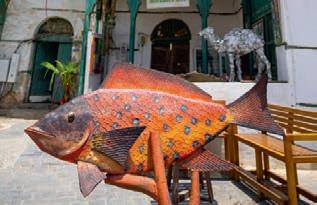
To that end, he moved from the south to Jeddah to establish the academy in Al-Balad. He now gathers young artists to give freestyle classes, strolling the area onThursdays and Saturdays.Tourists can even join in for free.

“It’s like a mini Montmartre,” smiled Hisham. “And if you’re visiting the academy, you can just sit and enjoy the art – there’s no pressure to buy,” he added as I rose to explore the collection of sculptures, paintings and papier-mâché figures created by the young artists.
He’s not the only one giving free workshops. Ibrahim Alhamar, whose atelier lies nearby, also gives classes to kids.
“Art is for everyone,” said Ibrahim as we entered a small room, its walls lined floor-to-ceiling with abstract images of candles, moons and suns painted in playful neon colours.They were all bold and expressive, and made for a stark contrast with the regal-looking man sat before me in smart, traditional dress.
“I use colours opposite to that of which I often feel, to lift my spirits,” he explained with impressive honesty.
I spotted other works among the moons and the suns that also bore Ibrahim’s signature, including a series of Arabian horses painted on woven palm leaves. “I treated horses as a vet for 20 years and bring that love to my paintings,” he explained. It was amazing to see how he had captured their movement and stillness with an expert’s eye.
The art scene in Al-Balad is made up of just as many women as men. As the afternoon sun started to gild the tops of the houses, Abir and I knocked on the heavy wooden door of Robat Alkhonji Alsagheer, a 100-yearold house that once served as a women’s refuge. Spanning off from the main corridor, the small rooms that once provided women and their children with safety and shelter have been repurposed as art studios. Occupying one of these was Rana Alsaggaf, a contemporary artist with a background in interior design who pays homage to Jeddah’s historical buildings by capturing them using stark black and white lines against colourful backgrounds.
“I chose green, brown and blue to honour the colour of the rawasheen balconies,” said Rana, her raven hair swathed in a royal-blue headscarf. Each painting also bears her signature yellow sun – “Because my name in Arabic is made from the same circular shapes,” she explained.The centre also offers calligraphy and Arabic lessons. “Around 60% of the attendees are women,” smiled Alsaggaf proudly. Her enthusiasm left me itching to pick up a brush. ET

182 October/November 2023
A brush with success (this page; clockwise from top left) Artist (and former equine doctor) Ibrahim Almahar sits in his colourful studio surrounded by vibrant paintings of horses, suns and moons; one of the more unique finds at the Jeddah Academy of Fine Arts; Hisham Binjabi’s paintings have taken him all over the world, and the list of people to have sat for him is a who’s who; Rana Alsaggaf poses beside one of her graphic drawings of the historic houses of Al-Balad, which also bears her signature yellow sun – the word for sun in Arabic has similar shapes to her name
Meet the locals
We talk to three Jeddawi’s who grew up alongside the old buildings and streets of Al-Balad and are now making their way in the modern city…
AL-BALAD HISTORIAN: SAMI NAWAR

“I was born in Al-Balad and have spent 80% of my waking life here,” smiled Sami as we stood on the rooftop of Beit Nassif, surveying the cobweb of streets below. He has guided hundreds of people here down the years, from the late Prince Philip to Hollywood actress Jessica Alba. Deemed the ‘Guru of Al-Balad’, he played a major role in the preservation and restoration of the district. “These buildings are like my older brothers,” he said, patting the walls affectionately.“In some houses, camels can reach the top floor; in others, barely a chicken can get up!” he chuckled. His own house has been in his family for more than 300 years.“When I took over the family home 20 years ago, they told me the story of a thief who had once broken in but got lost in the maze of rooms. He had to wake up the family to ask for the way out!”
SAUDI’S FIRST FEMALE TOUR GUIDE: ABIR ABUSULAYMAN

“My love for heritage comes not from studies, but from my father. He used to tell us stories about Saudi Arabia’s great cities,” said Abir, perched on the sitting-room benches of Beit Salloum.“Then, in 2011, my son had a school trip to Al-Balad, but it was going to be cancelled, so I took him and his friend there and fell in love with the area.”
Abir then set up ‘Jeddah’s Heart’, a Facebook page that had 15,000-plus members and shared historical information aimed at reviving interest in the past.“Back then, being a tour guide wasn’t a job for ladies, but I didn’t take ‘no’ for an answer. I visited people to learn more, and for seven years I offered tours on a complimentary basis to whomever called me.Then, when SaudiVision 2030 [the Kingdom’s plan for economic and social reform] was announced, things changed. In 2019, I got my guide licence, so I retired early from the Ministry of Education to do this full time. My kids made me a cake with my tourist licence number and ‘Best Guide in theWorld’ written in icing!”
It’s a remarkable story, and I asked her what had been her proudest moment so far. “I was part of the UNESCO application to preserve Al-Balad,” she smiled.“My name is listed under the social movement section. My son Googled me and said, ‘Mum, you’re famous!’What was a dream for me, and my generation, is now a reality for my daughter – we now have more than 300 female tour guides.”
Before I left, she added: “Saudi has been closed for a long time, and not everyone is sure if they should visit, but hospitality is part of our culture – you have to come and see the reality.”

MISWAK SELLER: HUSSEIN AL-ABDALI
There’s always a hum around Hussein’s stall, which sits amid the Qabil gold district. Since the 1960s, he has sold miswak – toothbrushes made from the arak tree. “Bite off the bark, spit that bit away and then soften the fibres with your saliva,” he explained, handing me a slender stick, even though women don’t normally partake.The best quality miswak come from the desert-like southern towns of Jazan and Al Qunfudhah, I’m told, and it grows in two varieties: spicy and mild – though both taste pretty tart. “The sap kills bacteria and cleans the teeth and gums,” said Hussein. “It’s better than toothpaste – and reusable.We use it all the time, but especially when fasting during Ramadan. Every man keeps one in his top pocket, even the king!” ET
AL-BALAD, JEDDAH www.wanderlustmagazine.com 183
⊲
A taste of the Old Town
You can’t visit Al-Balad without trying its distinctive coffee or dining on the fresh seafood that is the backbone of a city that began life as a small fishing village
“I’m happiest making coffee. My father and grandfather loved it too,”Waleed Diyab grinned as he made us a fresh pot, serving it the traditional way: in a brass coffee pot, known as a dallah, and accompanied by delicious dates.
Waleed explained through our guide, Abir, that it was six years since he had started selling coffee in Al-Balad, initially at a kiosk but now in Diyab Café, his proper, and very beautiful, premises. It’s only small but he’s expanding into the upper floor and has plans for traditional floor seating too. His clientele has also expanded, as he now gets international visitors as well as Saudis:“French,Americans, Italians... and now British. I love meeting them all,” he said.
Serving coffee is an important act of hospitality in Arab society and, as such, has been recognised by UNESCO on its Intangible Heritage list. Saudi coffee is distinctive in being flavoured with cardamom, or sometimes saffron or other spices.The result is a fragrant and aromatic drink without any hint of bitterness. It is served in small cups and without sugar; the accompanying dates act as a natural sweetener when eaten between sips. Neither is it served with milk or cream, although Waleed did admit that one secret of his coffee blend is the addition of a smidgen of milk. He experimented with his coffee until he got a consistent blend that he felt worked best.“If you have it at other coffee shops it will be a bit different each time,” he explained.And it has become so popular that he now sells jars of his readymade ‘instant’ blend to visitors and Saudi expats to take home – “Saudis miss their coffee when they are overseas.”
Waleed then served us a Hijazi almond coffee, a regional delicacy not made with coffee beans at all but with almonds, milk and cornstarch. It was a comforting, slightly sweet drink, and I could see why some liken it to hot chocolate. It is traditionally served at NewYear’s and on joyful occasions, and local legend even claims that it brings good luck.
Like most of the rest of the world, the coffee revolution of lattes and cappuccinos has hit Jeddah, and cafés including
the excellent local Medd chain, who also put on cultural events, have proliferated. It’s good to find one that gives a truer Saudi experience though, serving their coffee in the same way that it has been done for millennia. But it’s not just coffee that you should try. If there’s one ingredient that defines coastal Jeddah, both past and present, it is seafood.
“Visitors have not had a Jeddah experience unless they have tried fish from the Red Sea,” said Nabeel Hamad Hasan, proprietor of Al-Basali restaurant. Initially started in 1949 by his uncle and father to cater to pilgrims arriving at the port on their way to Mecca, the walls of his bustling seafood eatery in Bab Makkah Souk are covered with photos of just some of theVIPs who have made their own pilgrimage to this renowned location since.
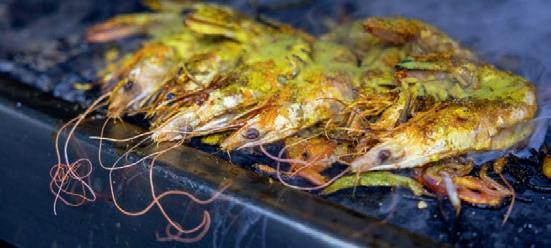
Jeddah began life as a fishing village, and even today it is still home to the biggest fish market in Saudi Arabia. Nabeel’s family once had their own fishing boats, but then decided to focus on the restaurant instead, buying in the best and freshest fish each day. He puts the secret of its success down to the spice mix his grandmother developed, as well as the fresh oil that they use and the variety of dishes that go beyond the simple fried offerings found elsewhere.
The restaurant’s glass cabinet was stuffed full of the Red Sea’s finest seafood, and we left it up to Nabeel to select our dishes for us. One absolute must-try is the popular najel, which is red in colour and is known more widely as the leopard coral grouper or coral trout. It was joined on the table by grilled hareed, or parrotfish; a bowl of small sejan, which are eaten whole; fried shaour; and some huge red prawns. On the side we were give fragrant sayadieh rice, cooked with fish stock and onion; an exquisite seafood soup; and the restaurant’s three standard sauces that accompany most meals: tamarind, green chilli and tahini.
“Although a businessman, Nabeel has stayed here and not opened other branches,” said Abir, nodding at the owner.
“This is my place,” he responded, touching his heart. ET See Footnotes for details of cafés and restaurants. ⊲
184 October/November 2023
Fruits of the sea (this page; clockwise from top left) Waleed Diyab’s coffee shop is a delight for those craving caffeine and a traditional taste of Saudi hospitality; Jeddah began life as a fishing village and its seafood is second to none in the Kingdom; Saudi coffee tends to be flavoured with cardamom, saffron or other spices, giving it a unique kick; the secret to Waleed’s coffee is said to be a dash of milk; Nabeel Hamad Hasan, proprietor of Al-Basali restaurant, doesn’t need tongs or a hammer to break open a claw; a dallah is the traditional pot that is used to serve coffee in Saudi Arabia; a feast of fish in Al-Basali; Waleed perfected his pouring technique long ago, having started out in a coffee kiosk before getting his own café; (left page) Jeddah’s Red Sea prawns are a must-try


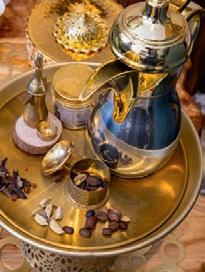





AL-BALAD, JEDDAH www.wanderlustmagazine.com 185
AL-BALAD HIGHLIGHTS
Vital statistics




Capital: Riyadh




Population: 35.9 million



Languages: Arabic; English spoken widely
Time: GMT+3
International dialling code: +966











Visas: UK nationals can get a visa on arrival (£102) or can apply online for a multipleentry e-visa in advance (£112; https://visa. visitsaudi.com). Both are valid for a stay of up to 90 days. Travellers booking flights through Saudia are eligible for a free 96-hour stopover visa (see ‘Getting there’). Money: Saudi riyal (SAR), currently, around 4.79 SAR to the UK£. Credit cards are widely accepted.
When to go
Weatherwise, Jeddah has two noticeable seasons.
November–April: The city is best visited during this period, when temperatures range between 19ºC and 29ºC. Note that Ramadan is expected to be observed from around 10 March to 9 April next year. This marks peak tourist season in Al-Balad.
May–October: Outside of the cooler months, the mercury soars up into the 40s (ºC), making daytime exploration uncomfortable and transforming Al-Balad into a bit of a ghost town, especially during the day. If you don’t like crowds,
it’s probably best to avoid Muharram (New Year) on 7 July and Saudi Arabia’s National Day on 23 September.
Health & safety
Saudi Arabia has a zerotolerance drugs policy, so if you need to bring in controlled/prescription medication, obtain a signed hospital note or a letter from your GP detailing the drug, the quantity prescribed and the dosage. Also be sure to wear sun protection, especially during the hotter months.
Crime is rare in Saudi Arabia, so there is little to worry about when walking the streets at night.
186 October/November 2023 1 2 7 5 6 8 10 11 13 15 18 14 17 9 19
1. Beit Nassif 2. Beit Noorwali 3. Beit Al-Sharbatly 4. Beit Baeshen 5. Beit Zeinal 6. Beit Salloum 7. Zawiya 97 8. The Royal Institute of Traditional Arts 9. Al-Basali Restaurant 10. Baeshen Restaurant 11. Forn Al-Shiekh 12. Masjid Al-Mi’maar 13. Masjid Ash-Shafe’i 14. Souq Al-Nada 15. Souq Al-Jamei 16. Souq Al-Alawi 17. Souq Al-Badu 18. Qabel Street 19. Art Sculpture Garden
Map: Jeddah Historic District; image: William
Gray
Getting there
Saudia (saudia.com) has daily direct flights to Jeddah from London Gatwick and Heathrow. If you’re travelling elsewhere, they also offer a free 96-hour stopover visa and complimentary one-night hotel stay when you book with them. Flights take roughly six hours from London and cost from around £593 return. British Airways (ba.com) also flies daily from London Heathrow.
A return flight from London to Jeddah produces 480kg of carbon per passenger. Wanderlust encourages you to offset your travel footprint through a reputable provider. For advice on how to find one, visit wanderlust.co.uk/sustainable-travel.
Getting around
Al-Balad is pedestrianised, except for its electric golf buggies, which can be hired for short tours. Most people stay elsewhere in the city and book an Uber (uber.com) or a similar taxi service to drop them on the outskirts of the old town.
Hours
Most places open in the morning, close during the peak midday heat and reopen in the late afternoon until 10/11pm. Some shops and other businesses are closed Friday mornings. When it come to the historical houses, Beit Salloum is open 9am–12.30pm and 4.30–10pm daily, except Friday morning; Beit Matbouli opens 4–10pm daily; Beit Al-Sharbatly opens 10am–5pm daily; Beit Baeshen opens 9am–midday and 4pm–10pm daily; and Beit Nassif currently only opens 5–10pm at weekends.
Accommodation
A trio of boutique hotels, including the 120-year-old, nineroom Gokhdar, are scheduled to open inside Al-Balad in the next few months. Otherwise, Jeddah has a wide range of stays, and it is both easy and cheap to get an Uber to the old town.
Food & drink
Given its Red Sea location, seafood is popular here and generally of good quality, especially at Al-Basali (+966 50 430 1163) on Suq Bab Makkah. It is a sign of hospitality to be offered coffee, so do accept if there is the opportunity. Otherwise, Café Diyab (no tel) is a lovely place to experience the local variety. Lattes and the like are widely
available at places like the funky Medd Café (meddcoffee.com). Layali Tarikhiya (Historical Nights; +966 50 567 5651) is a three-story café that is set within an annexe of Beit Baeshen and has a popular rooftop terrace. Al Balad’s best-known bakery, Al Saidi, near Beit Nassif, was closed for restoration at the time of our visit but will be reopening soon.
Sobia is a refreshing non-alcoholic drink made from fermented barley or bread and is popular during Ramadan. Several places in Al-Balad sell it. Some restaurants also offer delicious juices or mocktails.
Local customs & traditions
The dress code for visitors is now much more relaxed than it was previously. Women no longer have to wear an abaya or cover their hair, but both men and women should dress modestly, ensuring shoulders and knees are always covered. Male and female foreign visitors can now share a room in a hotel without proof of marriage and can eat together in restaurants, but public displays of affection are deemed highly offensive. It is a dry country, so no alcohol can be taken in or consumed.
Further reading & information
Visitalbalad.com – Site with advice and tips for food and activities. Visitsaudi.com/en – The official website for Saudi Arabia. Jeddah Our Days of Bliss Library – This bookstore on Bazan Lane has a great stock of historical books, magazines and maps. It opens 9am–midday and 4–10pm daily, except on Monday and Friday morning. Coming soon – An official visitor centre should open soon, so keep an eye out.
TOP INSIDER TIPS
Be an explorer
With so much restoration underway, places can often be temporarily closed or may have only recently opened, or may have changed hours, or may have moved. So, take local advice and follow your nose.
Go shopping
The historical district is the key shopping area of Jeddah, and you can pick up everything from spices and fragrances to organic honey and clothing. Don’t be afraid to browse.
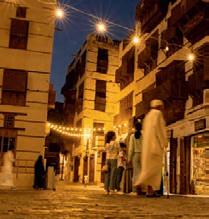
Hop on a scooter
Join locals in whizzing around on these pay-and-go electric scooters. They cost SAR1 (21p) per minute, but spending 90 riyals earns you double time.
Spending a penny
The cafés and restaurants don’t have toilet facilities; however, there are new and smart blocks of lavatories by the Al-Shafi’i Mosque and Beit Matbouli
Avoid Wednesdays
In peak season, cruise ships arrive on Wednesdays, depositing over a thousand day-trip visitors.
Pick a currency
Most shops in Al-Balad will accept payment in euros or dollars, and will usually exchange it on your behalf.
Cat-feeder stations
Al-Balad is famous for its street cats. Be assured that they’re well looked after: new feeding stations are being installed and the cats are even given a health check every three months.
The authors travelled with on-the-ground support from the Jeddah Historical District Program.
www.wanderlustmagazine.com 187 AL-BALAD, JEDDAH FOOTNOTES
The soul of Al-Balad One of the biggest tasks in restoring a historic district like Al-Balad, which is still very much a part of the local community, is finding a balance between developing facilities for visitors and keeping the spirit of the area intact
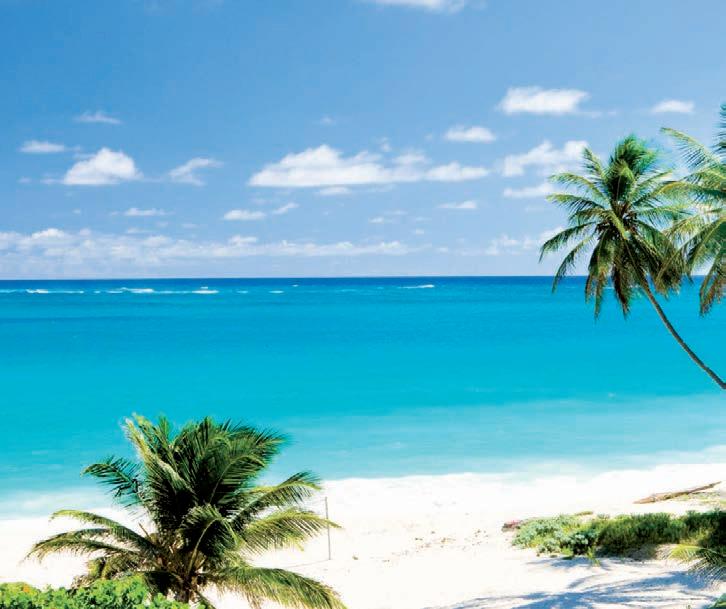
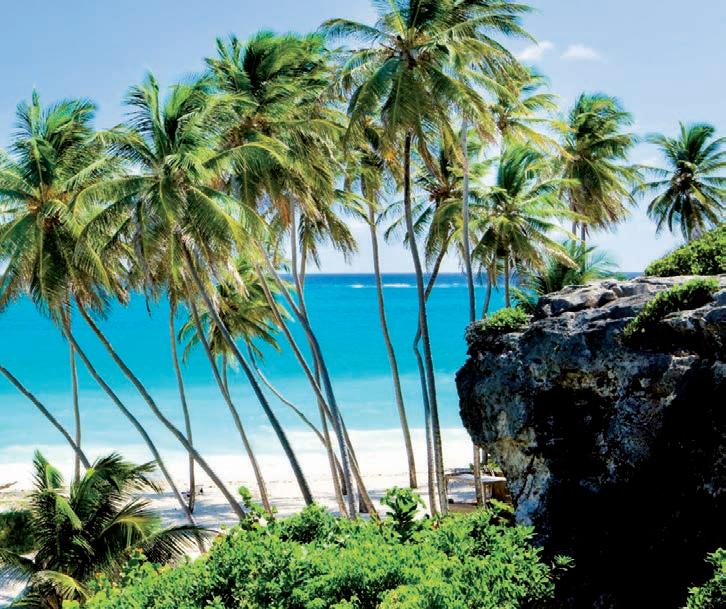



CANADA RECONNECT WITH THE ELEMENTS IN
An extraordinary destination like Canada demands an extraordinary trip. But knowing where to begin in the second-largest country in the world (9.985 million sq km; 243,042km of coastline) is a whole other matter entirely. Your time is precious, so First Class Holidays can bring your dream escape to life without the stress and hassle. Their team of experts design and tailor every trip to your preferences, so you can experience the ‘True North’ in a way uniquely made for you.
Wander with wildlife
The call of the wild can be irresistible in Canada, and few experiences top the thrill of getting up close to its iconic wildlife in their natural habitat. Whether you want to kayak with sea lions, watch bears
catch leaping salmon, witness the Qamanirjuaq caribou (reindeer) migration or do all of the above, lining up the best respectful wildlife encounters requires an expertly designed trip featuring unique stays in wilderness locations.
Head for the pristine parks of British Columbia, where towering mountains and temperate rainforest meet the west coast. This is a prime habitat for grizzly bears, otters, seals and eagles. Or go east to Newfoundland, where sightings of humpback whales in summer (June–August) are so regular that it’s no longer a surprise, as the world’s largest population returns to feed in its waters each year. You can even take the opportunity to embark on a polar bear safari in Manitoba and stay in remote eco-lodges out on the tundra.
Learn from First Nations culture
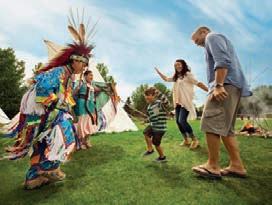
From the Inuit people of the Arctic to the Mi’kmaq of Canada’s eastern provinces, over 50 Nations live in communities across Canada. For several Indigenous groups, their oral histories tell of how the world was formed on the back of a turtle; today the original caretakers and inhabitants of ‘Turtle Island’ (North America) continue to be stewards of the land, water and animals. Each region affords an opportunity to connect with Indigenous history and culture in different ways. At the Calgary Stampede you can experience a traditional powwow, a ceremony of dancing, singing and drumming. On a wildlife-watching boat
Out of the blue (this page; top to bottom) Hiking in Banff National Park in Alberta reveals beautiful azure lakes; the powwow is an exuberant celebration of First Nations culture that includes dancing, singing and drumming
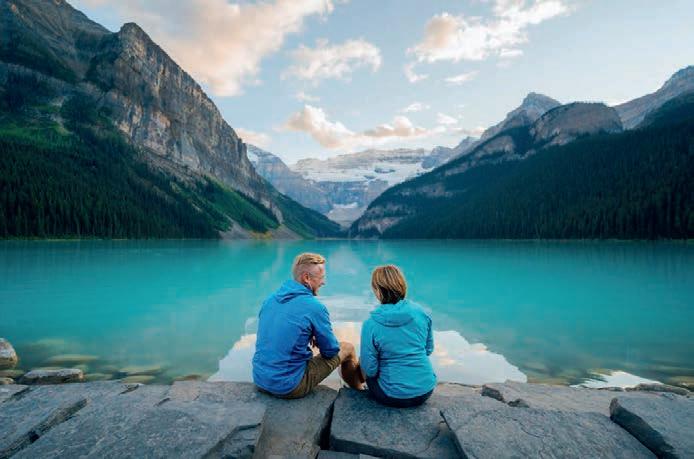
190 October/November 2023
Dennis Fast/Travel Manitoba; First Class Holidays; Roamcreative.ca; Roth & Ramberg
Ignite your sense of wonder and make life-long memories on a unique Canadian journey
trip through Broughton Archipelago, British Columbia’s largest marine park, you can even view the natural world through an Indigenous lens, as First Nations guides recount local history and lore and reveal pictographs and other archaeological evidence that show how the islands have been used for thousands of years. Even out in the tundra of Manitoba, after a day spent observing polar bears in the wild, you can dine on sustainable Indigenous ingredients such as Arctic char, elk and bison.
Admire natural landscapes
When it comes to Canada’s landscapes, be prepared to be astonished by their scale and diversity. In between the verdant Great Bear Rainforest of the west and the rugged Atlantic shores of the east lie vast prairies, boreal forests and tundra, plus lakes and rivers that contain 20% of all the fresh water on Earth. The country’s astounding natural wonders invite travellers to slow down and disconnect from the stresses of modern life.
Every season has its delights so it’s worth planning accordingly. Autumn is the time for ‘leaf peeping’, when visitors can admire the local foliage turning fiery shades of red, yellow and orange. September to March is the optimal time to see the Northern Lights in Yukon and the Northwest Territories, while if you head to Whistler, Jasper, Toronto or Mont Tremblant in winter, you can make the most of a postcardperfect snowy wonderland.
Embark on an outdoor adventure
A tickle of sea spray on the skin, the resiny scent of pines, the haunting call of a loon: immersing yourself in nature can awaken the senses.
Canada certainly makes for an impressive outdoor playground. Whether canoeing one of the 1,500plus lakes in Ontario’s Algonquin Provincial Park or hiking in Banff, the country’s oldest national park, visitors can come face to face with pure wilderness. Meanwhile, some 3,306 hectares of skiable terrain await snow lovers at North America’s largest ski resort, Whistler Blackcomb, which becomes a mountain biker’s paradise in the summer months.


Whether you love to walk, pedal or paddle, organisation and planning are key to accessing the best trails and waterways – and, if adventure is on your bucket list, to safely get you out of your comfort zone and into the incredible backcountry. The top active-adventure companies and specialist guides can take you deeper and off the literal beaten track.
The back of beyond (this page; clockwise from top left) Spot snow-white polar bears in Manitoba; try ice skating on Alberta’s frozen lakes in the winter; British Columbia is home to huge swathes of temperate coastal rainforest
About First Class Holidays

Winner of ‘Best Operator to Canada’ at the British Annual Canada Travel Awards a record 15 times, First Class Holidays is a trusted leader in providing tailor-made trips. They offer over 27 years of experience, awardwinning service, financial protection and a price-match promise.








Be it an escorted tour or bespoke private trip for a couple, family or group, their travel specialists deliver expert advice and personalised attention in crafting your perfect getaway. Imagine a luxe journey through the Rockies, a cruise from Vancouver to wild Alaska or a oncein-a-lifetime trip to see polar bears in their natural habitat – First Class Holidays makes it possible.

PROMOTIONAL FEATURE Plan your dream holiday at fcholidays.com | 0161 888 5632 | enquiries@fcholidays.com | Visit your independent travel agent
Stretching out into the Gulf of Mexico on Florida’s sunny west coast, Bradenton is easily reached via Virgin Atlantic’s direct flights from London Heathrow and Gatwick to nearby Tampa, and is also just two hours’ drive from Orlando. Having starred recently in an episode of the popular TV travel series Fantastic Friends, come and discover the city for yourself and explore an alluring mix of pristine golden beaches, exciting outdoor adventures and innovative sustainable initiatives....
HIT THE COAST
It isn’t hard to fall in love with Anna Maria Island, which is attached to Bradenton via a long, slender
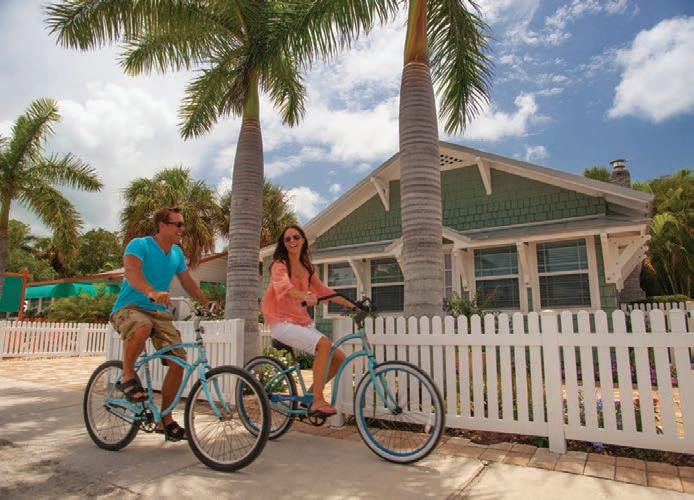
BRADENTON TAKE IT SLOW IN
With its sustainable values and starring role in a new episode of hit TV series Fantastic Friends, there’s no better time to visit Bradenton…
causeway. Here you’ll find a Florida that’s like it used to be in the 1940s and ’50s: picture-perfect, pastelcoloured clapboard houses; gently swaying palm trees; fully stocked bait shops; island-style bar shacks serving Floribbean cuisine. At around 11km long and just over a kilometre wide, it has resisted the lure of big business. You’ll see no high-rises, chain hotels or restaurants – just independently run mom-and-pop stores, bars and restaurants, each as local and welcoming as the last.
You can choose from a wealth of accommodation, ranging from family-run guesthouses to boutique hotels or holiday homes by the beach. Indeed, it was in a clapboard beach house that the Harry Potter actors and twins James and Oliver Phelps stayed
while filming the Florida episode of Fantastic Friends. From a similar waterside location, it’s easy to get out and about, whether attempting stand-up paddleboard yoga, going dolphin-spotting in Sarasota Bay or watching a Bradenton sunset in style by renting a cabana with Beach Suites.

If you’d rather explore the shoreline, Bradenton boasts myriad secluded stretches of sand. Head to Beer Can Island (also known as Greer Island) on Longboat Key for dazzling white shores and turquoise waters, or make for De Soto National Memorial Beach, another great place to watch the sun slowly sink below the horizon.
STRETCH YOUR LEGS
It’s not all about pure relaxation. If you want to experience more outdoor
192 October/November 2023
Powered by people (this page; top to bottom) The best way to explore Pine Avenue is by bicycle; go standup paddleboarding on Florida’s warm Gulf waters
activities and culture, Bradenton has you covered. First, you’ll want to get out onto those shimmering green Gulf waters. Whether by kayak, paddleboard or motorboat, take things at your own pace and enjoy the scenery as you glide through tangled mangroves and past spectacular coastline.
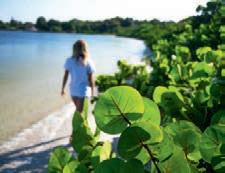

Getting out on the water means getting considerably closer to nature. Sign up to an eco-tour, which explores the area’s local habitats and wildlife sustainably; you might even spot the odd alligator or spy an osprey swooping down on its catch. Trips typically range from birdwatching to spotting dolphins and manatees – you are in Manatee County, after all!
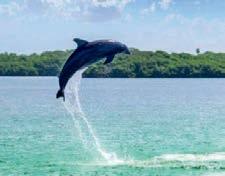
Later, wander the Bradenton River Walk, a 2.4km-long stretch of public green space overlooking the Manatee River. You’ll find public parks, live event spaces and plenty of places to stop and explore. Learn about your surroundings at the Bishop Museum of Science and Nature, which features a manatee rehabilitation habitat, a planetarium and regular exhibitions. And don’t miss Bradenton’s Village of the Arts, an eclectic artists’ community made up of colourful, historic 1920s and ’30s cottages, which now house galleries, studios, restaurants, bakeries and speciality shops. The area also holds fascinating
Art Walks on the first Friday night and Saturday afternoon of every month.
GREEN FOCUS
This heavenly patch of Florida is home to some of America’s most beautiful landscapes: warm Gulf waters; wild mangroves that nurture dolphins, manatees, alligators and all manner of fish; and sweeping nature preserves, home to a range of wildlife, from rare birds to sea turtles. It’s on all of us to make sure they stay pristine. Bradenton prides itself on keeping its piece of paradise as perfect as possible. Among a raft of sustainable initiatives is Love It Like a Local, which has partnered with the Leave No Trace campaign to encourage visitors to treat the area as if they lived there – keeping beaches

Sunshine state of mind (this page; clockwise from top left) Surf’s up on Holmes Beach; dine with seaside views at the Beach House; creativity flows in the Village of the Arts; wander the mangroves of De Soto National Memorial; this lookout offers fine views over Robinson Preserve’s salt marshes; spy dolphins in the Bay or Gulf’s waters
and waterways clean, conserving energy, protecting local wildlife and supporting local businesses. Another interesting example is the All Clams on Deck scheme, which aims to restore local estuaries by replenishing clam populations and seagrass meadows to improve the quality of the water and create healthier habitats for both marine life and humans.
Even the local food scene is keeping things green, with a wealth of responsibly caught local seafood found on local menus. Its pioneering farm-to-fork restaurants aim to serve sustainable seafood from local fisheries, and many are working with organisations to avoid serving overfished species. Pioneering examples include the Chiles Hospitality Group, whose three wonderful waterfront restaurants subscribe to the Gulf Coast Oyster Restoration and Recycling programme, which repurposes used oyster and clam shells to create new ocean reefs.
MAKE IT HAPPEN
Award-winning tour operator Ocean Florida (ocean-florida.co.uk; 0203 5530 948) have years of experience throughout the Bradenton area. They offer a seven-night city and beach trip for £1,889pp (based on two adults sharing), including direct return flights from London Heathrow to Tampa, two nights at The Godfrey Hotel, Tampa, and five nights in a one-bedroom condo on Anna Maria Island, Bradenton.


PROMOTIONAL FEATURE www.wanderlustmagazine.com 193 For more information, visit: www.bradentongulfislands.com
Bradenton Gulf Islands
DISCOVER A NORTHERN VIRGINIA STATE OF MIND IN

FAIRFAX COUNTY
A stone’s throw from Washington DC yet seemingly worlds apart, down-to-earth Fairfax County is where nature and rich American history live happily side by side
Sitting west of Washington DC, across the meandering Potomac River, Northern Virginia’s Fairfax County blends revolutionary history with magnificent local cuisine and some unique outdoor adventures.
Unmissable things to do in Fairfax County
Cruise along the Potomac River to Mount Vernon
Snaking for over 650km through three states, the Potomac is one of America’s most iconic rivers, and the section between Washington DC and Mount Vernon is particularly historic. Guests aboard Nautiste’s vintage 1961 Burger Motor Yacht can even enjoy a curated meal from a Michelin-starred chef while they plot a course for George Washington’s former estate.
Start with a champagne toast while the yacht glides into the Washington Channel’s vast expanse before a fine
lunch is served, including superb seasonal fare like local oysters paired with hand-selected wines from around the world. When the journey is over, step out for a behind-the-scenes private tour of George’s Washington’s Mount Vernon.
Explore Great Falls Park
The sound of water crashing through the narrow Mather Gorge is the highlight of Great Falls Park, a natural oasis that serves up myriad outdoor adventures. Fanning out for 323 hectares along the winding hem of the Potomac River in northern Fairfax County, the park offers a chance to take a reviving hike, watch kayakers take on Class V rapids or soak up views at the accessible Overlooks.
Alongside the outdoors, there’s unusual history here too. Don’t miss the ghostly ruins of Matildaville, a once-thriving canal town devised by George Washington but eventually went bust in the mid-19th century.
Find your zen at the Korean Bell Garden
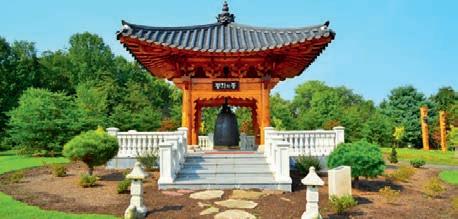
Hidden away in the lush 38-hectare surroundings of Meadowlark Botanical Gardens, the Korean Bell Garden was the first of its kind in the Western Hemisphere and is a delightful place to unwind, away from the hum of the city. Weighing three tonnes and sitting quietly beneath a traditional wooden pavilion, its bronze bell sits at the heart of the garden and has been handcrafted by skilled Korean artisans.
The ten traditional Korean symbols of longevity (sun, mountain, water, cloud, stone, pine tree, white crane, turtle, mushroom of immortality and deer) have been engraved onto the bell alongside the Rose of Sharon (the national flower of Korea) and the Dogwood (flower of Virginia). It’s a great spot to just soak up the peace and quiet.
Fairfax County foodie experiences
Enjoy seasonal fine dining at L’Auberge Chez Francois
Most people wouldn’t expect to find a rustic slice of north-eastern France in Northern Virginia, but L’Auberge Chez Francois has been serving fine
194 October/November 2023
Historic landmark (this page; top to bottom) To visit Mount Vernon is to peek into George Washingon’s life; the bronze bell is a signature sight at Meadowlark Botanical Gardens
AWL; Dan Chung; Kip Dawkins Photography/Archer Hotel Photography; @rkat414; Visit Fairfax; James Diedrich Photography/L’Auberge Chez Francois; George Washington’s Mount Vernon; Nautiste
Alsatian cuisine here since 1976 and offers exceptional eight-course prixfixe meals near scenic Great Falls Park.

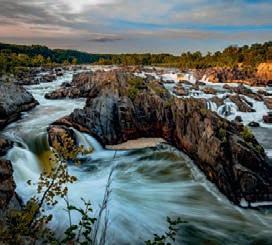
Tucked within its cosy farmhouse setting, meals here are magical on chilly winter nights. Chef Jacques Haeringer’s menu includes beautifully presented French classics like aiguillettes de canard, showcasing the diversity of Alsatian cooking and the quality of local Virginian produce.
Taste the whiskey heritage of Mount Vernon


The first US president is famous for a lot of things, but perhaps less wellknown is his taste for whiskey. Back in the late 18th century, American whiskey was in a fairly early stage of its development, but those original methods and recipes are still used today at Mount Vernon to recreate the authentic taste of Washington’s famous rye whiskey. Pay a visit to the distillery at Mount Vernon and sample true American spirit heritage.
Visit the wineries
Virginia boasts over 300 wineries, but only Fairfax County can claim America’s first bicoastal wines. With a sister location in Santa Barbara, California, Paradise Springs’ awardwinning wines are made on land

originally granted by Lord Fairfax himself back in the 18th century. The luxurious Winery at Bull Run offers another intriguing window into US history, as it sits on land adjacent to the Manassas National Battlefield Park – the site of the first major land battle in the American Civil War.
See Fairfax spreading its culinary wings
While the produce in Virginia remains sublime, Fairfax County’s gastronomic choices are increasingly going global. Authentic Singaporean restaurants are rare in America, yet the excellent Jiwa Singapura by chef Pepe Moncayo in Tysons showcases high-
Free-flowing (this page; clockwise from top right) The Potomac River is Fairfax County’s wild artery; the Winery at Bull Run offers vintage tastings; the industrial-chic of Archer Hotel Tysons; take a luxury yacht cruise along the Potomac River; find French foodie flair at L’Auberge Chez Francois
end takes on classic street foods. Around the corner, Joon by chefs Christopher Morgan and Najmieh Batmanglij brings sophisticated Persian and Iranian cuisine to Fairfax, while the Kirby Club on District Avenue offers a playful spin on Lebanese and Egyptian food.
Where to stay
With its sustainable Metrorail links to both downtown Washington DC and Dulles International Airport, stylish Tysons is a superb base for exploring the wider Fairfax County.
Archer Hotel Tysons
Just a short walk from the McLean Silver Line metro station, the boutique Archer Hotel Tysons boasts an industrial chic vibe and 178 contemporary guest rooms and suites. Don’t miss sipping deliciously smoky cocktails on AKB bar’s cosy al fresco patio.

The Ritz-Carlton, Tysons Corner
The opulent Ritz-Carlton, Tysons
Corner is a wonderful gateway to the region – it’s just 20 minutes from the nearby Tysons metro to downtown DC’s attractions. The hotel’s plush modern rooms and suites make for a luxurious nest to return to every night.
The Watermark Hotel
Flanked by some splendid restaurants and located just around the corner from McLean station, rooms at the Watermark Hotel are classy and its lobby opens out onto the vibrant 11th-floor Perch Skypark. Summertime rooftop cocktails here are a must.
PROMOTIONAL FEATURE For more information, visit: www.fxva.com www.wanderlustmagazine.com 195


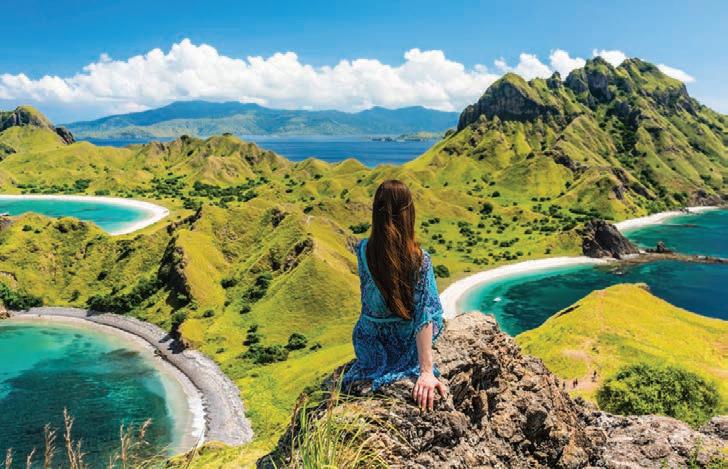




Where to find the UK’s darkest skies, why Bordeaux is far more than just a city of wine, how Guyana’s capital is balancing history with progress, and more…





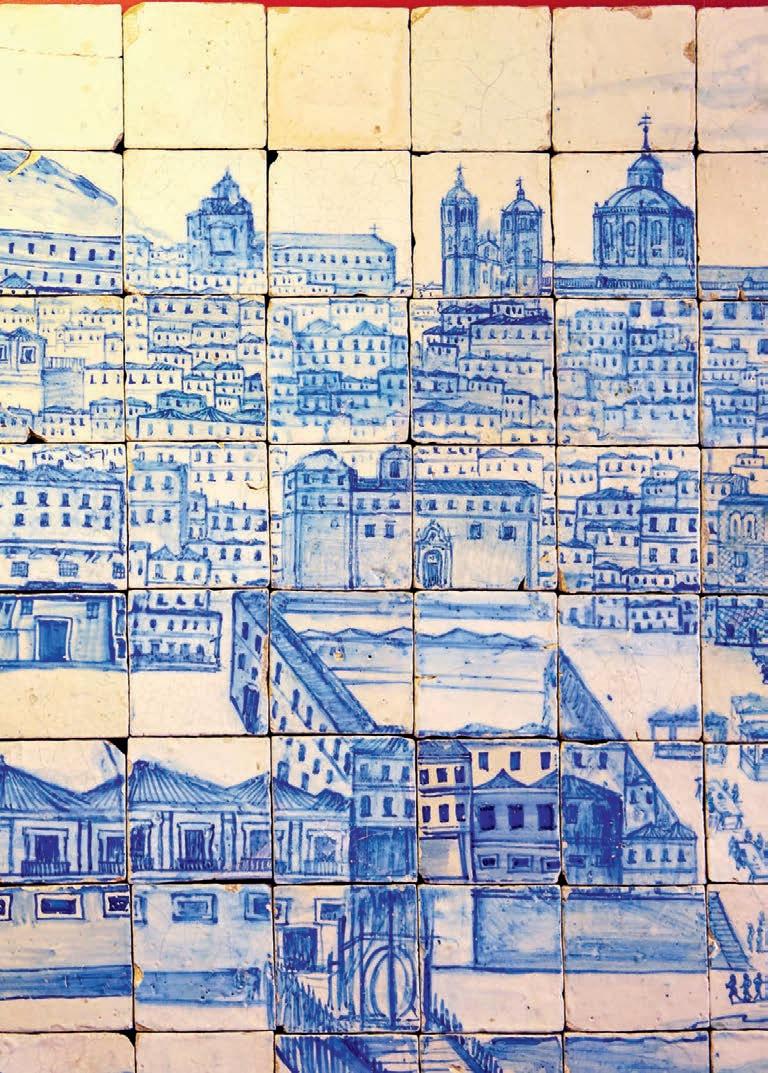
discover Alamy World Heritage: Georgetown, Guyana 200 Museum Cities: Lisbon 204 Indigenous Culture: Kenya 206 Urban Spotlight: Bordeaux 208 British Break: Dark Skies 216 Wander Quiz: USA 223 Top Guide: Malick Suso 226
Feeling blue? The highlight of Lisbon’s National Azulejo Museum is a 23m-long cityscape made from 1,300 blue-and-white tiles. This is one of few detailed records of what the Portuguese capital looked like before the Great Earthquake of 1755, yet it is only one jewel among many in the city’s museums; see p204
Georgetown, Guyana
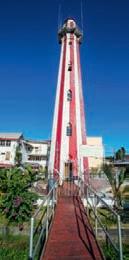
On the mouth of the mighty Demerara River lies Georgetown, a capital city whose past pokes through on almost every street. Even the drive from the airport to the town centre reveals a cultural patchwork of Hindu prayer flags, mosques and brightly painted Caribbean rum shacks.
The roots of all this lie in Guyana’s history of European colonisation, when enslaved Africans and indentured labourers from India, Portugal and China were shipped in to work on the plantations. Not for nothing is it known as the Land of Six Peoples, yet from this dark past was improvised a
cosmopolitan capital of infinite colour. Now, with Guyana in the midst of an economic boom, thanks to the discovery of offshore oil in 2015, the city is having to balance progress with the preservation of its historical buildings.
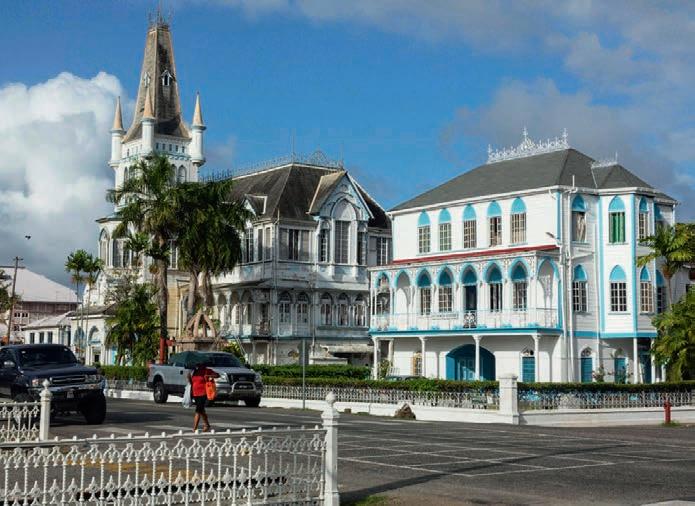
Georgetown might be self-sufficient these days, but its history and architecture were shaped by the French and Dutch. The latter established
the Demerara colony 25km from the present-day capital, and its name offers a clue as to what drew them: sugar. By 1769, there were 206 plantations in the area and it had caught the attention of Britain and France.
In 1781, the British took control and established the settlement that would later become Georgetown.This was made a capital the following year by its new French owners, only for the Dutch to later seize it back and rename it Stabroek after the President of the DutchWest India Company. Its old moniker lives on today in the capital’s iconic iron-and-steel Stabroek Market, known for its four-faced clock.The city wouldn’t get its present-day title
With Guyana’s capital in the midst of an oil boom, the city needs to balance modernisation with the preservation of its colonial buildings and the difficult history they represent, writes Claire Antell-Thorne
“The Great Fire of 1945 consumed many of Georgetown’s wooden buildings”
200 October/November 2023 WORLD HERITAGE Alamy; Shutterstock
until 1812, when the British renamed it after King George III.
Evidence of this relentless horse trading can be seen across the capital. Dutch heritage exists in everything from street names and the Georgetown Lighthouse to the sluice gates that drain the city, much of which lies below sea level at high tide. Even today, the capital’s Dutch-designed and British-built seawall is a popular spot for ‘liming’ (doing nothing) at weekends, especially on Sundays when the pop-up snackettes and bars emerge.
Georgetown’s design likewise reveals its colonial past. Laid out in a grid that has been interlaced with lilyfilled canals running perpendicular to the river, its waterways follow the lines of the old sugar estates, helping to funnel excess stormwater to the sea. It is also wildly green, with tropical parks that are home to Caribbean manatees and over 200 species of bird. It’s little wonder the capital was once touted as the ‘Garden City of the Caribbean’.
Today, historic Georgetown has a kind of faded glamour.The Great Fire of 1945 consumed many of its historic wooden buildings, but those that survived offer a glimpse of its elegance, even if some are in a poor state. Any visit should begin at the City Hall, which was built by the British in 1889 and is being renovated this year.This fairy-tale structure, with its wroughtiron crenellations, is often dubbed the best example of Caribbean Gothic
architecture still standing.Afterwards, take a peek at the Prime Minister’s Residence, which used to belong to the Booker brothers, whose sugar empire was once so powerful that the country was jokingly called Booker’s Guiana.

Next make a stop at the Walter Roth Museum of Anthropology, which offers not only an insight into Guyanese Indigenous life, but has fine examples of local architectural features such as gingerbread fretwork and Demerara shutters.The latter is an ingenious kind of window that was designed to block sunlight but allow air to flow inside over cooling ice blocks.
Finish at St George’s Cathedral, which dates back to 1810 and is one of the world’s tallest free-standing wooden buildings (43.5m). Recently renovated, it has beautiful Gothic-style features juxtaposed with traditional and contemporary stained glass. There is even a chandelier donated by Queen Victoria, who remains a problematic figure here; her statue can still be seen outside the High Court, despite being dynamited and defaced as a symbol of colonialism.

Today, the burgeoning oil industry is undoubtedly changing the face of Georgetown, as more and more steeland-glass constructions are erected. At the same time, it has also brought much-needed funds for the conservation of its historic buildings. It is a tantalising conundrum for a city where history still lingers on every corner.
NEED TO KNOW
Saving the past (clockwise from far left, bottom) Georgetown’s wooden lighthouse was first erected in 1817, but it was replaced with a brick version just 13 years later; one of the most striking elements of the City Hall is its 29m-high tower; St George’s Cathedral was built with a local hardwood called greenheart; the name of Stabroek Market recalls Georgetown’s early Dutch rulers; you can see manatees in the city’s Guyana National Park; the statue of Queen Victoria is a contentious reminder of Georgetown’s colonial past
Getting there: Never has it been easier to reach Georgetown from the UK. British Airways (ba.com) recently introduced direct flights from London Gatwick, which take 11.5 hours and cost from around £497 return. These arrive at Cheddi Jagan International Airport, which is between one hour and 90 minutes’ drive from Georgetown.
Eugene F Correia Airport lies in the city and is the point of departure for domestic flights and flights to Suriname, Barbados and Trinidad. It is also possible to enter the country by land at Lethem on the Brazilian border, or by ferry from Suriname. Getting around: Georgetown traffic is not for the faint-hearted, and selfdrive is not recommended. Travel around town instead with a local tour company and always take a taxi at night. Georgetown is best when explored with a city guide, or even a local chef who can highlight the many tastes and culinary highlights of the capital, ranging from a backyard café to dinner in a secret garden (wilderness-explorers.com).
Day trips further afield include boat journeys on the Demerara River, where you can look for hoatzin birds and howler monkeys in the morning and roosting scarlet ibises at sunset. You can also take a short flight to Kaieteur Falls, which is almost five times the height of Niagara.
Accommodation: A perfect base for exploring Georgetown is Cara Lodge (caralodge.com), an awardwinning heritage hotel that dates back to the 1840s and has welcomed visitors as prestigious as King Charles III and Mick Jagger. Alternatively, Rainforest B&B (rainforestbbguy.com) is a tranquil oasis that lies in the city’s Queenstown area; it has splendid art and Guyanese artefacts dotted about the house and tropical garden.
Further info: The author updated the current edition of the Bradt guide to Guyana (bradtguides.com), which is still the only dedicated major guidebook for the country.
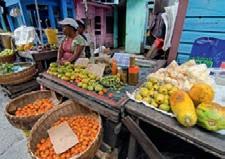
John Gimlette’s Wild Coast (Profile Books, 2012) and Evelyn Waugh’s Ninety-Two Days (Serif, 2007) are quintessential reading.

DISCOVER Guyana www.wanderlustmagazine.com 201
Kitzbühel Take a winter break in

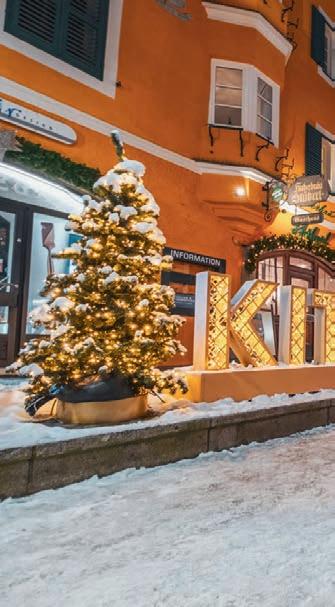
From the moment Franz Reisch tore down Austria’s Kitzbüheler Horn on 15 March 1893, the status of Kitzbühel as a capital for winter sports became as firm as the early spring snow. Today it offers some of the best skiing on the planet and an exhaustive range of winter activities, not to mention the famous Tyrolean hospitality. Here are just some of its highlights…
HIT THE SLOPES
The numbers alone will widen the eyes of any ski enthusiast. Kitzbühel is home to 96 ski slopes, ranging from gentle downhills and steep drops to long descents through the valleys and wide routes that are ideal for carving. In total, there are 188km of groomed pistes, plus a further 45km of off-piste downhill slopes. If you’ve never skied before, or even if you’ve competed in the Winter Olympics, you’ll find all that you need in Kitzbühel. It’s certainly no surprise that the ‘Gamsstadt’, as it’s fondly known, has been voted Austria’s Best
Ski Resort every year for the past decade at the World Ski Awards.
Kitzbühel’s success is a result of its geography: big mountains and world-class conditions are found from mid-November to mid-April. But many winter-sports enthusiasts are also taken with Kitzbühel’s remarkable Alpine heritage. The aforementioned Franz Reisch made history in 1893 with Austria’s first high-Alpine ski descent from the Kitzbüheler Horn. These days the Hahnenkamm mountain and Kitzbüheler Horn are widely accepted as the ultimate challenge for the world’s greatest downhill skiers, particularly on the famous Streif slope, considered by some to be the toughest on Earth.
The region’s vast size also means that you can easily escape the big-ticket routes. And when you need to warm up, there are over 60 cosy ski huts dotted around the mountain, offering plenty of traditional foods and hot drinks to wrap your hands around. Given the number of lifts and pistes, make sure to pick up the Ikon Pass, a multi-day ski pass that can be
Hitting the slopes (this page; above)
The traditional inns and eateries in Kitzbühel’s historic heart serve up fine food to recharge your battery for tackling more slopes; (bottom left) snow-wigged guesthouses offer the perfect respite away from the slopes
used all across Kitzbühel’s expansive KitzSki ski area.
WIDEN YOUR WINTER ADVENTURES
If you want to take a break from hurtling down a steep-sided mountain every day, there are more peaceful pursuits to be found in and around Kitzbühel. These include snowshoeing, curling, winter hiking, tobogganing and simply gazing wistfully through the frosted window of a warm ski hut with a mug of hot chocolate or glühwein in hand.
Firstly, the landscape in and around the Gamsstadt is some of the most beautiful in the Alps, which is to say very lovely indeed. It’s impossible not to get a little misty-eyed at the scenery, which is easily explored on the 70km of cross-country trails that forge deep into the Alps. And for non-skiers, or those enjoying a day off from knee-crunching descents, the
202 October/November 2023
The Austrian ski town of Kitzbühel offers plenty of adventures in the Tyrol for winter enthusiasts of all abilities
intricacies of the mountain landscape can be easily explored on foot. There are 170km of hiking trails around the fairytale winter terrain, many linking cosy mountain huts, while Kitzbühel Tourism also has plenty of free hiking routes to follow.
Once you’ve reached one of the Kitzbühel peaks, you’ll likely want to spend as much time savouring the region’s beauty as possible. But
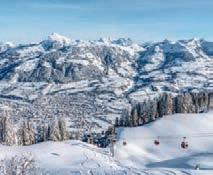
the most fun way to get back down the valley is to jump on a toboggan and slide your way to the bottom. It’s almost as fast as skiing, and just as exhilarating, especially for little ones. In particular, you’ll find long, fast straights together with sweet, winding sections at the Kelchalm, Trattenbachalm and Gaisberg runs, the latter of which has a chairlift you can hop on and do it all over again!
ALPINE FUEL
Kitzbühel is the quintessential Austrian mountain town, and is rich with the history and culture of Alpine skiing. Wander the quaint streets of Kitzbühel, side-stepping the many famous skiers who live there, and you’ll get a taste of its heritage. Be sure to drop by the Museum Kitzbühel, which charts the town’s history from the Bronze Age through to its current ski boom, when it became one of the world’s most famous winter sports destinations. But it’s perhaps the culinary culture of Kitzbühel that appeals the most. Scattered across the town’s streets and up in the mountains is an abundance of traditional inns, worldrenowned gourmet restaurants and mountain huts cooking hearty local fare, all served with a generous side of warm Tyrolean hospitality.
A taste of Kitzbühel (this page; bottom left) Medieval Kitzbühel has been a premier alpine resort for over a century; (top right) Kitzbühel’s gondolas transport you to some of the toughest ski runs in the world

Eggerwirt, in the centre of Kitzbühel, has welcomed guests since the 1600s and is now run by the local Klackl family. Like many of the classic inns of Kitzbühel, it offers some beloved traditional dishes.
For haute cuisine, Berggericht serves spectacular food from one of Austria’s most exciting chefs, Marco Gatterer. Tyrolean cuisine is the star here, yet it is elevated to gourmet standards, while the restaurant Lois Stern adds Asian touches to the best of local produce. But you’ll likely find just as much pleasure in the many huts scattered high on the mountainside, each of which has a different vibe and culinary speciality. For example, don’t miss the cranberry pancakes and locally foraged mushroom dishes at Hahnenkammstüberl or the exceptional wine list at Hornköpflhütte. Consider it your fuel (or reward) for hitting the slopes.

PROMOTIONAL FEATURE www.wanderlustmagazine.com 203 For more information, visit: www.kitzbuehel.com
Kitzbühel Tourismus
Lisbon, Portugal
Lisbon’s museums, which number more than 60 if you count even the tiniest of them, let you bathe in Portugal’s history and culture. Some lie along the quays of the lagoon-likeTagus estuary, others scatter the city’s hilly neighbourhoods.

History-minded visitors will, at some stage, find themselves at the water’s edge in Belém, the perfect spot to take the pulse of the Age of Discovery, a time when Portugal shaped the world. It was from here that the caravels set sail, and the district is now studded with the trappings of Empire, such as the Jerónimos monastery, as well as an eclectic array of museums, including the Berardo Collection and the horse-drawn carriages of the National Coach Museum.The exploration-inspired Museum of the Orient is also just a stroll along the Avenida da Índia. While this trio all lie in modern, purpose-built buildings, several of Lisbon’s most alluring museums are housed in historic monuments as dazzling as the pieces on display. A case in point is the National Azulejo Museum, sensationally set in the stone-carved cloisters of the Madre de
Deus convent, founded in 1509. Another is the National Museum of Ancient Art, which lies in the rooms of a palace adorned with Manueline flourishes. On the quirkier front, the bizarre façade of the 16th-century Casa dos Bicos, home to a museum on Nobel laureate José Saramago, often has architecture buffs scratching their heads. However, Lisbon’s luck in hosting one of the world’s most mesmerising museums is down to one man’s munificence. In the 1890s, Armenian chemical engineer Calouste Gulbenkian founded a petroleum company on a hunch that oil would be the world’s main energy source in the next century. He became the world’s wealthiest man, which gave him the wherewithal to indulge his greatest passion: collecting the finest works of art ever created. During the Second World War he took refuge in neutral Portugal, eventually bequeathing his collection to a charitable foundation, stipulating that it be based in Lisbon. Entry to many of Lisbon’s museums is included on the Lisboa Card (£19; lisboacard.org). Some are free on Sundays (if crowded) after 2pm; most close on Mondays.
The ceramic age (clockwise from bottom) Azulejo tiling has its roots in Moorish culture – the word even comes from the Arabic ‘az-zulayj’, meaning ‘polished stone’; the Calouste Gulbenkian Museum opened 14 years after its benefactor’s death; Diogo Pires-oVelho’s Saint James the Greater statue is displayed in the National Museum of Ancient Art; visitors to the same institution can also see the Triptych of Temptation of St Anthony by Hieronymus Bosch
Lisbon’s museum scene traces its roots to the cultural explosion of the Age of Discovery and one very wealthy man, writes Martin Symington
204 October/November 2023 MUSEUM CITIES
Alamy
Calouste Gulbenkian Museum
Gulbenkian specified that his entire collection be displayed under one roof.The resulting museum opened in 1969 in a specially built concrete building rising out of landscaped water gardens.
The most obvious way to get around is chronologically, starting with the Egyptian and Greco-Roman rooms, then passing through the Islamic and Oriental galleries before moving on to European art.What makes the Gulbenkian one of the world’s most important art collections is that every piece in it was chosen not only as a superlative, but as a personal treasure.
Works of genius not to miss include the Lalique collection of Art Nouveau jewellery; pieces by Monet,Turner, Gainsborough and Rubens; and its collection of illuminated medieval manuscripts. One of the undoubted treasures is Jean-Antoine Houdon’s marble Diana statue, which runs with a grace that appears different from every angle; it used to be one of Catherine the Great’s most cherished possessions.Above all, save time for Rembrandt’s Figure of an Old Man – dignified and ineffably sad, his face seems to glow from within. Look out for guided tours on Mondays. gulbenkian.pt/museu/en
National Museum of Ancient Art

Portugal’s national museum is principally a repository of gold and silverwork, paintings, sculptures and jewellery by Portuguese artists from across the centuries.Yet it also houses one of the country’s finest collections of art from around Europe, including masterpieces by Hieronymus Bosch, Raphael and Holbein, as well as displays of ceramics, furniture and artefacts from Africa,Asia and the Americas, reflecting the cultural impact of Portugal’s Age of Discovery.
The MNAA, as it’s known, lies in the Palace of Alvor-Pombal in the smart Lapa area, built on,

BEST OF THE REST
Museum of the Orient
and from, the ruins of a monastery destroyed in the 1755 earthquake. It stands in gorgeous gardens overlooking the river Tagus, where the café makes an excellent recovery room after an exhaustive exploration, which can take half a day. Alternatively, a 60-minute highlights tour is helpfully suggested. museudearteantiga.pt
National Azulejo Museum
It is impossible to exaggerate the significance of the Grande Panorama de Lisboa, the centrepiece of a museum dedicated to the glazed tilework paintings (known as azulejo) that are a distinct Portuguese art form.This enormous cityscape covers most of a wall, and when viewed up close you can make out every spire, bridge and shipyard of Lisbon circa 1700, from when it dates. No other record exists in comparable detail of Portugal’s capital before it was devastated by the massive 1755 earthquake.
The Madre de Deus convent is the museum’s glorious host. Feast your eyes on the unparalleled collection of exquisite azulejos adorning the cloister walls, set around a fountained central courtyard. Each tile is painted individually but tessellated and intricately grouted to form portraits, still lifes, everyday scenes and extravagant panels depicting key moments in Portuguese history. museudoazulejo.gov.pt
This jewel of a museum, set in a revamped warehouse on the Alcântara district quayside, is a reminder of Portugal’s pervading influence on Asia, both in trade and colonisation, brought to life through fine collections of IndoPortuguese artworks and antiques from China, Japan and Timor. foriente.pt

José Saramago Foundation
Casa dos Bicos, a striking mansion with a façade of spiky pyramids, is home to this intriguing little museum on Nobel laureate Saramago (1922–2010), covering his genre-defying novels and life, including his struggles against the Salazar dictatorship. josesaramago.org
National Coach Museum
Featuring hundreds of horse-drawn coaches and carriages from around the world, this one-of-a-kind museum spotlights an art form long forgotten in the automobile era. The collection chronicles their evolution from workaday transport to extravagant, gilded symbols of wealth and state power. museudoscoches.gov.pt/pt Berardo Collection Museum
A counterpoint to the adjacent Jerónimos monastery, Lisbon’s electrifying collection of contemporary art lies inside the ultra-modern Centro Cultural de Belém complex on the waterfront. Showstoppers include Picasso’s Femme dans un Fauteuil, Warhol’s portrait of Judy Garland, and Dali’s Lobster Telephone berardocollection.com
DISCOVER Portugal www.wanderlustmagazine.com 205
Kenya


When you first meet your Kenyan safari guide, there’s a good chance he or she won’t be wearing the beige or green outfits that are standard attire in Africa’s safari heartlands. Instead, they could well be dressed in traditional regalia: a scarlet shuka (shawl) and blue kikoi (sarong), perhaps, with a stack of bangles or a beaded collar and feather-trimmed headdress. Here, Indigenous traditions outweigh safari conventions and traditional colours are worn with pride.

It’s a great ice breaker. Shukas and beadwork are powerful symbols of Kenya’s heritage and diversity, and if you’re as interested in culture as in nature, you’re bound to be curious about the stories behind them. Rural communities that once stuck to Indigenous dress by default – through marginalisation, or because their elders considered Western styles undignified – now embrace their clothing culture as an expression of identity, tweaking it when new local fashions pop up. It’s not just the instantly recognisable Maasai and Samburu peoples that dress strikingly; others, including the Rendille,Turkana, Pokot and Kalenjin, have their own distinct styles too.
Since safari guides love guests to ask questions, there’s no reason why your game-drive chats shouldn’t encompass everything from jewellery (most likely homemade, by them or their female relatives) to talk of livestock. From there, you could perhaps move on to more sensi-
tive and contemporary topics: land rights, for example, in instances where livestock herders and conservationists don’t see eye to eye.They may also have much to say on social issues, and how tourism is helping to fund community-led efforts to tackle HIV, unwanted pregnancies, FGM/C (female genital mutilation/cutting) and the societal impacts of climate change.
Meeting other rural Kenyans on a meaningful footing can be more challenging.The typical route used to be to visit cultural manyattas – show villages where rural performers recreated rituals and dances for spectators. But while some of these were mutually respectful, others felt inauthentic, transactional and borderline voyeuristic.
Fairer, more sustainable alternatives have now emerged, led by communities of semi-nomadic livestock herders and coastal or lakeshore fishermen who are keen to share and exchange aspects of their culture, past and present through hands-on encounters. These enable communities to benefit financially from safeguarding local habitats and keeping traditions alive.
Crucially, such experiences are immersive.You could take a guided botanical walk or birdwatching boat trip, learn how huts are built or how beaded jewellery is made, or join a dance. If, for example, you’re encouraged to take part in a Maasai adumu (jumping ritual), don’t hesitate: there’s something exhilarating about being wrapped in the rhythm of chanting voices and pounding feet.
Jumping for joy (this page; below)
The Maasai adumu dance typically takes place during an eunoto ceremony, a rite of passage for young Maasai warriors that means they have come of age; it is also traditionally a way for them to demonstrate their strength and skill to attract a bride, but that needn’t stop visitors from joining in when asked


Many of Kenya’s 40-plus ethnic groups live in remote rural areas, but a new wave of tourism has opened the door for more of them to benefit from sharing aspects of their culture with visitors, writes Emma Gregg
Alamy
206 October/November 2023 INDIGENOUS CULTURE
dances and a distinctive music and poetry scene – the UNESCOlisted Old Town on Lamu island offers a markedly different cultural experience to the pastoral regions of western and north-western Kenya. During the Lamu Cultural Festival, held in November, cultural performances take place in the main square, with donkey races and a dhow regatta livening up the seafront. Expert Africa (expertafrica. com) can arrange a trip with accommodation at Lamu House (lamuhouse.ke) in town, or at Peponi Hotel (peponihotel.com) on Shela Beach, around 3km away.
5 Learn about life in the semi-desert around Lake Turkana
Five ways to experience Kenyan culture
1 Drive the Masai Mara with a female guide
Proving that a Kenyan safari can be thoroughly progressive, Emboo River Camp (emboo.camp) is challenging gender inequality in the industry. Many of the workers at this thoroughly eco-friendly off-grid lodge are women from the local Maasai community, and there’s an excellent chance it’ll be a young Maasai woman who drives you around the reserve. It is also one of few lodges with a fleet of electric safari vehicles, which are charged using solar energy. Consequently, Emboo River’s game drives are comfortable and quiet, with plenty of opportunities to chat about Maasai culture from a woman’s perspective.
2 Visit a communityowned conservancy
Created in 2001 in a former poaching hotspot, Sera Wildlife Conservancy is owned and run by locals, who are predominantly Samburu, though the area also includes Rendille and Turkana. In 2015, ten black rhinos were reintroduced to a section of the conservancy protected by Samburu rhino guards, as it began offering East Africa’s only opportunity to track black rhinos on foot. Saruni
Rhino (saruni.com/saruni-rhino) is a small, comfortable rhino-tracking camp with a faraway feel. It’s here that Samburu guides share their renewed enthusiasm for nature and lead tours of the semi-desert and its singing wells, where herders are known to chant as they haul water for their camels.
3 Take a guided hike or bike ride across the Loita Hills
The pastoral Loita Hills lie within the Masai Mara ecosystem, around 80km east of the Masai Mara National Reserve. Stay at Loita Hills Basecamp (loitahillsbasecamp.com) or join an adventurous tour of Kenya with Much Better Adventures (muchbetteradventures.com) to explore on foot or by mountain bike, crossing open grasslands and forests with Maasai guides. Along the way, you’ll also soak up elements of warrior lore, such as how to avoid dangerous animals, identify useful plants, select the best camping spots and cook ugali (a type of doughy cornmeal) and vegetables over an open fire.
4
Immerse yourself in Swahili culture

Steeped in Islamic tradition – and with a couple of dozen unique local
Life on the water (this page; top–bottom) Dhow racing is one of the centrepiece events at the Lamu Cultural Festival, as all the local villages join together to exhibit their finest boats; as few as 300 El Molo people now live in the villages around Lake Turkana, with their culture in danger of slowly disappearing
The arid lands around Lake Turkana, an immense salt lake in Northern Kenya, are shared by fiercely independent and resilient seminomadic communities, including Turkana, Samburu, El Molo and Rendille. To learn about their customs, join trips into the Kaisut and Chalbi deserts with Native Eye Travel (nativeeyetravel.com). Alternatively, absorb the sights and sounds of Tobong’u Lore (Lake Turkana Cultural Festival) with Undiscovered Destinations (undiscovered-destinations.com). The festival is a rich spectacle of traditional dress, music and dance that welcomes visitors. Its name, meaning ‘welcome back home’ in the Turkana language, refers to the region’s history as a cradle of humankind.

DISCOVER Kenya
Bordeaux, France
If you think that Bordeaux is just about wine, then you’re in for a shock; this is a stylish, cultured city that is constantly reinventing itself, writes Mary Novakovich
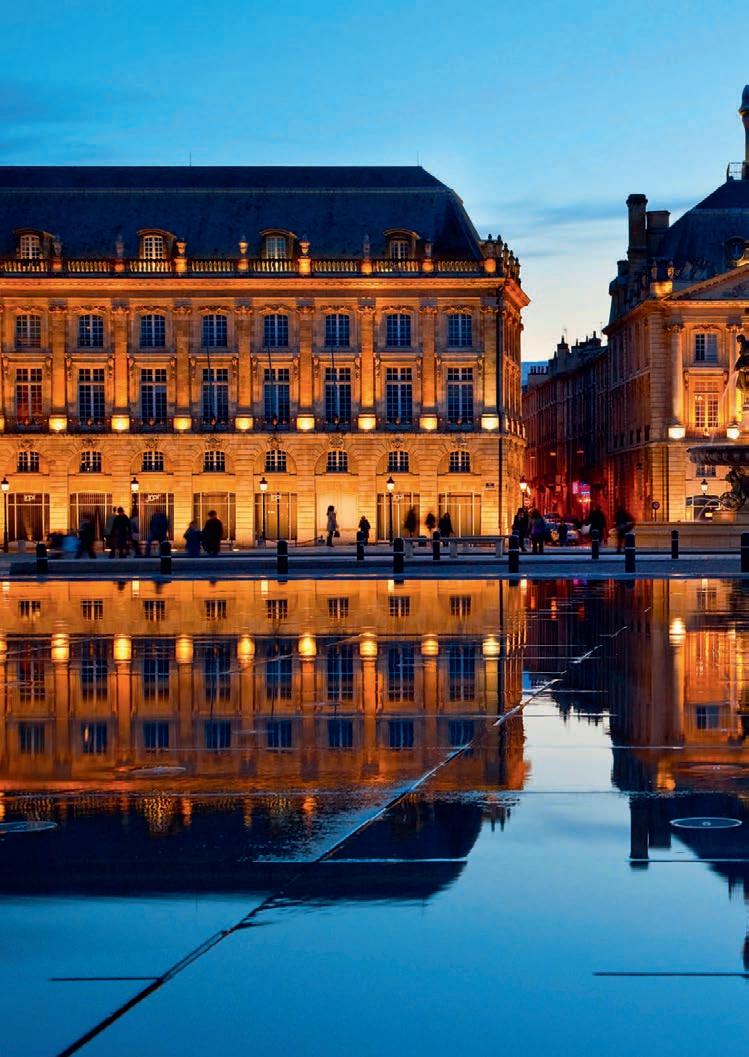
URBAN SPOTLIGHT
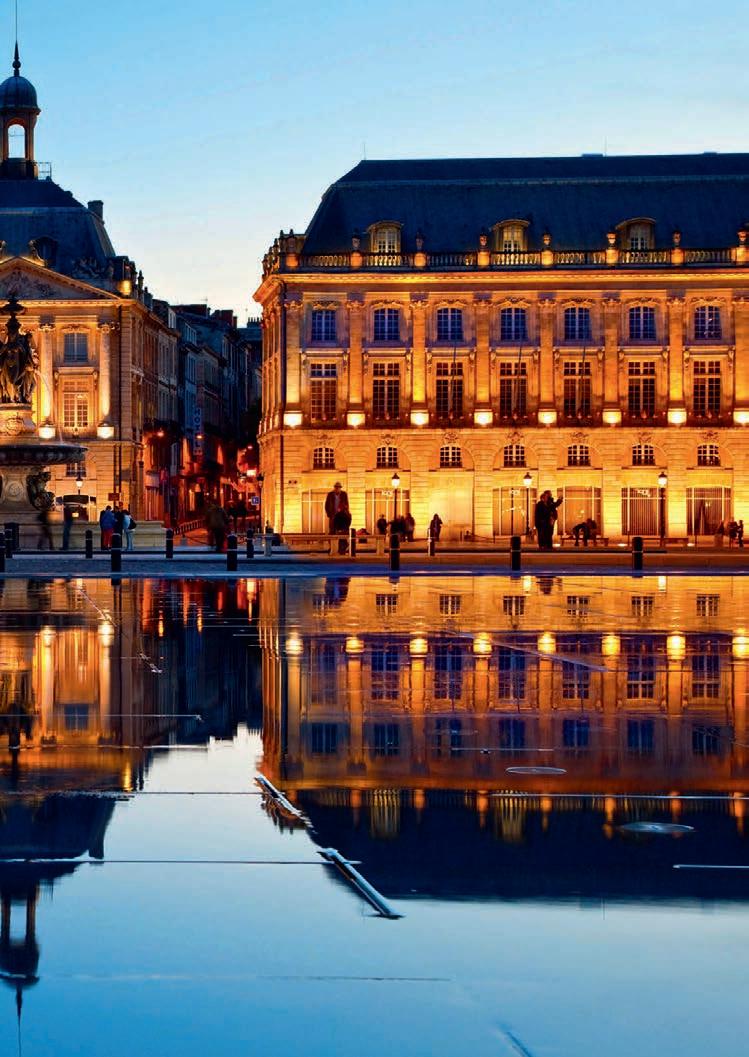
DISCOVER Bordeaux
France’s wine capital becomes more irresistible every year. Between its culture, history and food, Bordeaux balances all the ingredients that make a city appealing. Its surrounding vineyards produce some of the world’s top wines, while gastronomic inspiration comes not only from the nearby coast but also from high-quality beef and south-west France’s delicious duck and goose dishes. But it is how the city brings these elements together that is so exciting.
You can see the restaurants’ ingredients on display just south of the city centre in Bordeaux’s biggest food market, Marché des Capucins. Then head north to see how Bordeaux transformed its old maritime district, Bassins à Flot, into a gleaming, cosmopolitan neighbourhood that holds several of the city’s most fascinating sights. Obviously, the Cité du Vin, the city’s impressive homage to wine, is one of them, but also pop into the Halles de Bacalan for gourmet treats and local produce. At the Vivres de l’Art, you can even discover how an 18th-century navy
warehouse found a new lease of life as an arts venue, exhibition hall and artists’ residence.
Before you leave the Bassins à Flot district, make time for a visit to the largest digital arts centre in the world. Step into the Bassins des Lumières and you will lose yourself in immersive digital art exhibitions – it’s almost like walking into a work of art. The current shows take you into the vivid worlds of Salvador Dalí and Antonio Gaudí (both until 7 January 2024). The setting is just as compelling: the exhibition spaces take up a former submarine base built by the Germans during the SecondWorldWar.
It’s just the latest of many cultural transformations Bordeaux has undergone since the mid-1990s. Since then, some 5,000 grand but greying 18th-century buildings have been spruced up and now form part of a 150-hectare UNESCO World Heritage site. Start in the Place de la Comédie and marvel at the colonnaded façade of the Grand Théâtre before wandering past Cours du Chapeau Rouge’s stately townhouses and towards 44.8378° N, 0.5792° W
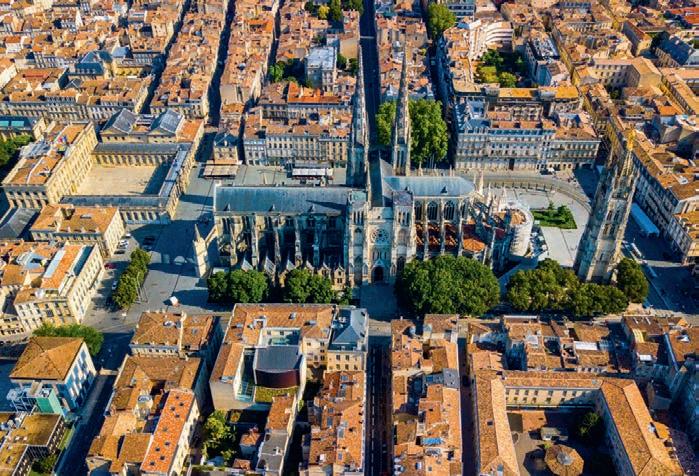
DID YOU KNOW?
The Bordeaux area is not just famous for its wine. While many people associate caviar with eastern Europe, France is the world’s third-largest producer, after China and Italy. The bulk of its farmed sturgeon eggs come from the Nouvelle-Aquitaine region, specifically around the Gironde estuary and the Garonne and Dordogne rivers. The country’s leading producer, Sturia, even has its HQ here.
⊲ Previous spread: Alamy; this spread: Alamy 210 October/November 2023 URBAN SPOTLIGHT
From cathedrals to vineyards (clockwise from above) Bordeaux’s Cathédrale St-André is a magnificent sight, though that didn’t stop it from being turned into a lead factory and a warehouse for food during the French Revolution; the Galerie Bordelaise is one of the most elegant covered shopping passageways in France and is accented with dazzling gilt finishes and wrought-iron twists; the 19th-century Three Graces fountain stands at the heart of the Place de la Bourse and was originally created to replace a statue of Napoleon Bonaparte, which in turn had replaced one of the king that had been torn down during the revolution; there are plenty of bars to slake your thirst in the city; the merlot grape is a native of Bordeaux and is the region’s most widely grown grape variety
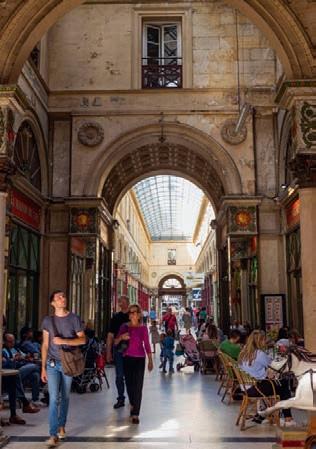


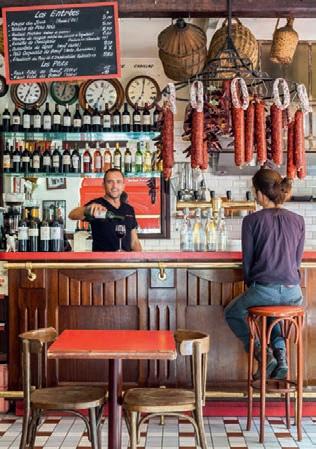
DISCOVER Bordeaux www.wanderlustmagazine.com 211
the Place de la Bourse.The shimmering water of the Miroir d’Eau that reflects the square’s 18th-century stock exchange has become one of Bordeaux’s most beguiling sights. Carry on along the River Garonne to Porte Cailhau, a monumental 15th-century gate that was once an entrance to the city.To put all of Bordeaux’s rich history into context, visit the Musée d’Aquitaine to see how the city grew from its Gallo-Roman beginnings, and to discover the tragic role that slavery played in its fortunes.
THE WORLD OF WINE
The Cité du Vin caused a bit of a stir when it opened in 2016. It’s not surprising when you take into account the sight of its shiny, metallic exterior, shaped like a gigantic wine glass. Inside this audacious structure, visitors enter an immersive, sensory world that celebrates wine from all over the globe, not just Bordeaux. Even if you think you know a lot about viticulture, you’ll be pleasantly and enjoyably enlightened by the interactive exhibits that reveal just how many wine-growing regions and varieties of grape there really are in the world.
Try out the hands-on exhibits that delve into the myriad aromas of wine and you’ll get an idea (if you don’t know already) of what people mean when they say they can discern unlikely scents in an ordinary glass of wine.You’ll also get a digital audio guide that offers translations in eight languages.
Every Thursday, the museum holds wine-tasting workshops, paired with food from the region, naturally. But regardless of the day or time you visit, your ticket includes entry to the eighth-floor Belvédère bar, where you can get a glass of wine to drink while taking in panoramic views of Bordeaux.The interior is quite something – from its ceiling are suspended thousands of empty wine bottles.
CHARTRONS DISTRICT
Back in the 17th century, wine merchants turned the Chartrons district, just north of the historic centre, into the hub of the Bordeaux wine trade. Boats used the Quai des Chartrons to load and offload their barrels from riverside warehouses. Nowadays this lively district is the epitome of French ‘bobo’ (bourgeois bohemian), with
TOP 4 EVENTS
BORDEAUX WINE FESTIVAL
Every June, the Bordeaux wine industry takes over the banks of the Garonne for a four-day festival of tastings, gigs, entertainment and food. Tall ships line the quayside – and are usually open to visitors – and you can buy a tasting card to sample the region’s different wines in the many pavilions.

bordeaux-wine-festival.com
METROPOLITAN SUMMER IN BORDEAUX
Bordeaux brings its arts and culture outdoors during July and August, when more than 100 cultural events take place around the city. Look out for dance and theatre performances, concerts, readings and gastronomic events put on by the Bordeaux Food Club. bordeaux-tourism.co.uk
DANSONS SUR LES QUAIS
For much of July, life on the Garonne quayside steps up a gear during a boisterous outdoor festival of dance. Watch local dance companies perform when you’re not joining one of the regular dance parties taking place. dansonssurlesquais.fr
CLIMAX RESIST FESTIVAL
Mid-September is the time to join the party at Darwin, as the three-day Climax Festival arrives in town. Catch live gigs in the centre of a former military barracks and hear about global issues from speakers from around the world. climaxfestival.fr
URBAN SPOTLIGHT
⊲
212 October/November 2023
Alamy; Bassins des Lumières; Shutterstock
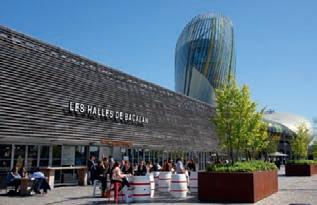



DISCOVER Bordeaux www.wanderlustmagazine.com 213
Cultured takes (this page, clockwise from top left) Porte Cailhau dates from 1494 and was built to celebrate French king Charles VIII’s victory in Italy – it has barely changed since; the Grand Théâtre de Bordeaux is the place to catch performances by the Bordeaux National Opera, which has a permanent team of 110 musicians, 38 dancers and 37 choristers; the Miroir d’Eau is less than 20 years old yet is synonymous with the city; the Halles de Bacalan is a covered market that brings together local farmers and chefs; catch the latest exhibitions at the Bassins des Lumières; (left page) even the wine shop at the Cité du Vin catches the eye
countless cafés, restaurants, delis and vintage boutiques scattered among the wine cellars that remain.A stroll along Rue Notre-Dame, past the imposing 19th-century St Louis des Chartrons church, will take you past at least ten antiques shops and plenty of places to eat.
The old indoor market, Halle des Chartrons, is now a cultural centre, but it also lies within a sea of café terraces. For one of the best market experiences in Bordeaux, head to the Quai des Chartrons on a Sunday morning and sample oysters sourced from the Bassin d’Arcachon, meet local producers and dine at the food stalls.
Tucked away in the midst of Chartrons is the Musée du Vin et du Négoce de Bordeaux, whose atmospheric vaulted cellars take you back through the centuries of Bordeaux’s wine trade. Once you’ve toured the museum, your ticket includes the chance to taste two wines.
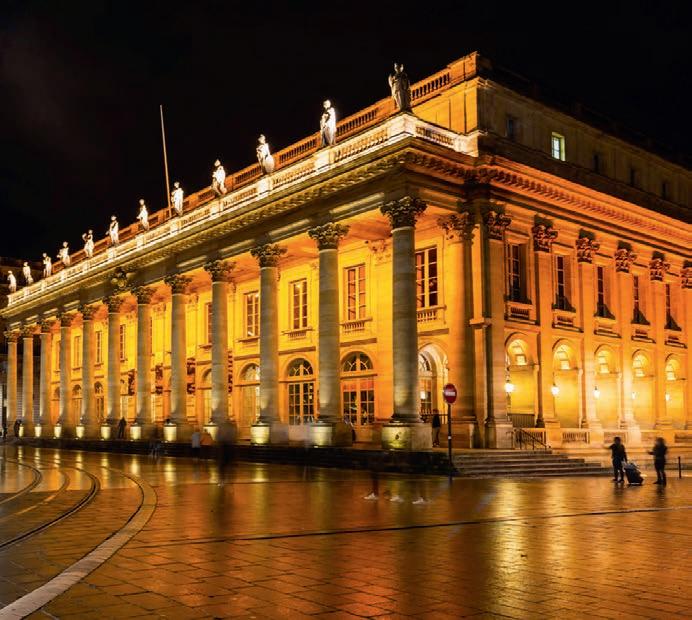
DARWIN REGENERATED
The transformation of a series of scruffy, old military barracks into one of Bordeaux’s trendiest districts is typical of a city that has a long history of reinventing itself. Darwin emerged from the graffiti-covered remnants of barracks that had been abandoned in 2005. It has now been turned into its own ‘eco-système’ on the right bank of the Garonne in the Bastide district.
Everything seems to come together naturally in this buzzing place.The old graffiti has been replaced with vivid and witty street art that adorns the open spaces, especially around the skatepark where people bomb along on skateboards and BMX bikes.The gaps between the various barracks double as an open-air cinema and concert venue. In keeping with the sustainable principles behind Darwin, there’s the huge Magasin Général – part restaurant, part
A break with the past (clockwise from top) The Place de la Bourse is the heart of the city, and its Neoclassical design – helmed by Jacques Gabriel and his son, two of the most prominent architects to work on Versailles Palace – marked a stark break with the city’s medieval look when it was created in the 18th century; one of many trendy escapes within Darwin, the former barracks on the right bank of the Garonne that has been transformed into the city’s hippest neighbourhood and a champion of zero-waste, sustainable dining and urban agriculture; Bordeaux is predominantly a red-wine region – less than 10% of the wine produced here is white
214 October/November 2023 URBAN SPOTLIGHT
Alamy; IHG Hotels & Resorts; Hotel de Sèze; Shutterstock
shop, all organic – which aims for zero waste and sends its biowaste to be composted by a local company.There’s even an organic farm cultivating vegetables, herbs and flowers, and a henhouse with organic chickens.
Industrial chic and rustic chic mingle in the large, open dining hall that sits between two barracks and is covered by scaffolding; lights twinkle in the evening over its wilfully mismatched furniture.What was an old ship-
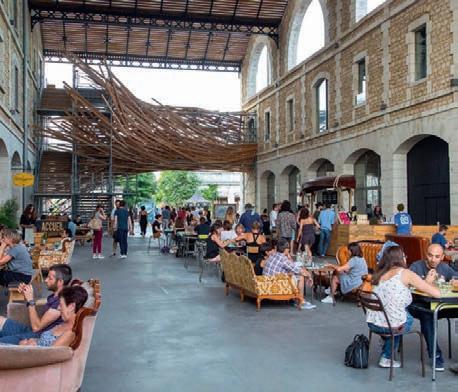
Stay here...
building hangar is now Les Chantiers de la Garonne, an ideal spot to enjoy Darwin beers along with Bordeaux wines. Local businesses and workers have taken over co-working spaces here – Wednesday evenings are the time to drop by for weekly after-work events – and bargain-hunters can rummage through the enormous Bric-à-Brac Emmaüs charity shop in search of vintage second-hand clothing, books, homeware, toys and furniture.
NEED TO KNOW
Getting there: British Airways (ba.com) has daily nonstop flights from London Heathrow and Gatwick to Bordeaux; easyJet (easyjet.com) has flights from Gatwick, Luton, Belfast, Bristol, Glasgow and Manchester; and Ryanair (ryanair.com) flies from Stansted. Return flights cost from £31 and take from around 1 hour and 40 minutes.
By train: Eurostar (eurostar.com) has daily trains from London St Pancras to Bordeaux, changing in Paris. One-way trips cost from £84 and take just under six hours. Online resources: Visit the Bordeaux Tourism (bordeaux-tourism.co.uk), Gironde Tourism (gironde-tourisme.fr) and Nouvelle Aquitaine Tourism (nouvelleaquitaine-tourisme.com) sites for more details.
InterContinental Bordeaux

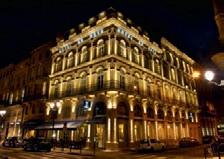

– Le Grand Hotel
Bordeaux’s most historic hotel occupies a regal position opposite the Grand Théâtre and offers sumptuous luxury in a 19th-century grande dame building. From its two-Michelin-starred Le Pressoir d’Argent Gordon Ramsay eatery to the rooftop bar (the chicest in the city) and Guerlain spa, it’s the place for pampering. ihg.com
Hotel de Sèze
You would be hard-pressed to find a more central location than Hotel de Sèze, a handsome, four-star stay near the Grand Théâtre. Its 54 stylish rooms (including four suites) combine colourful 18th-century motifs with modern furnishings, and there’s a lovely little spa as well as a noted restaurant and private golf course. hotel-de-seze.com
DISCOVER Bordeaux www.wanderlustmagazine.com 215
Star-studded escapes
Wilderness, history and wildlife combine at some of Britain’s most iconic stargazing sites, as more and more travellers are looking to the heavens

The view of our cosmos has been enjoyed by humans for tens of thousands of years, inspiring great works of music, literature and art. But while the romance of a starry night is undeniable, light pollution is a growing problem that has already erased the stars from many city skies. The German Research Centre for Geosciences recently found that light pollution is increasing by 10% every year, putting ecosystems, wildlife, human health and the sight of the stars under threat. This trend is a worrying one, but there are still plenty of havens for stargazers.
Many people now travel to see and experience the natural wonders of the night. The British Isles is no different. It offers plenty of opportunities to indulge in some stargazing, with 20 of its dark-sky preserves now certified by DarkSky International (darksky.org), and even more recognised locally as Dark Sky Discovery Sites (darkskydiscovery.org.uk).While the weather doesn’t always play nice, when the clouds clear, these islands offer star-studded getaways with the chance to spot lesser-loved nocturnal wildlife or even connect with history under the cover of night.
BRITISH BREAK
MINI GUIDE
216 October/November 2023
Words Megan Eaves
Autumn haunts in Eryri (Snowdonia), Wales
Rugged Eryri National Park (Snowdonia) is home to some of Britain’s darkest skies. On clear evenings in this part of northern Wales, the stars shine brightly and Eryri’s landscapes are full of nocturnal wildlife, from badgers and bats to toads. One way to enjoy the night is by chugging through the mountains aboard a heritage locomotive, and both Bala Lake (bala-lake-railway.co.uk) and Talyllyn (talyllyn.co.uk) railways offer Halloween-themed night services in October. Elsewhere, Mountain Walks (mountain-walks.co.uk) has hikes up Yr Wyddfa (Snowdon) at dusk, so you can watch the sunset and then descend by the light of the moon. For something special, book early for an escape on Ynys Enlli (Bardsey Island), which opens to visitors between March and October and was crowned Europe’s first Dark Sky Sanctuary this year. discoveryinthedark.wales/snowdonia
Starry festivals in the Yorkshire Dales & North York Moors, England


The neighbouring Yorkshire Dales and North York Moors national parks became twin International Dark Sky Reserves when they were certified by DarkSky International at the same time in 2020, ensuring that much of North Yorkshire remains a cosmic wonderland. Dark Sky Discovery Sites in both parks offer the best viewpoints for seeing the sky on clear nights. In the North York Moors, book a shepherd’s hut or cottage with Gumboots & Wellingtons near Dalby Forest (linktr.ee/gumbootsandwellingtons), then take an Astro Dog astronomy tour (astro-dog.co.uk) or join Yorkshire Coast Nature for an evening bird walk (yorkshirecoastnature.co.uk). In theYorkshire Dales, adventures range from night-photography workshops to canoeing and pizza nights at How Stean Gorge.The NorthYork Moors also hosts its own Dark Sky Fringe Festival in late October, while the parks run a combined festival in February. darkskiesnationalparks.org.uk
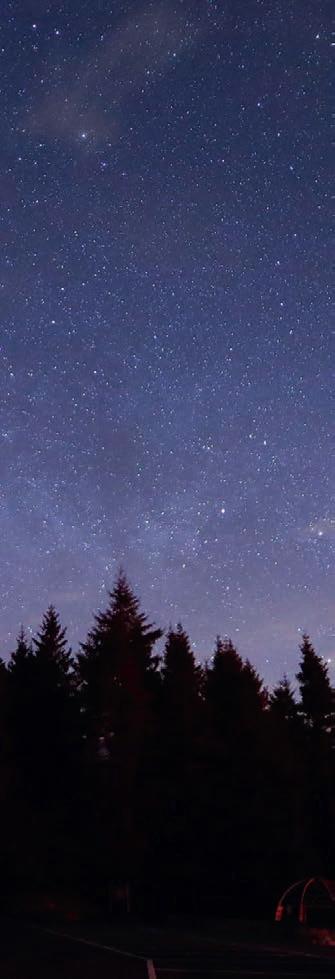
⊲
Mid Ulster District Council; Shutterstock; Steve Bell
DISCOVER British Isles www.wanderlustmagazine.com 217
Nocturnal wildlife in Northumberland International Dark Sky Park, England
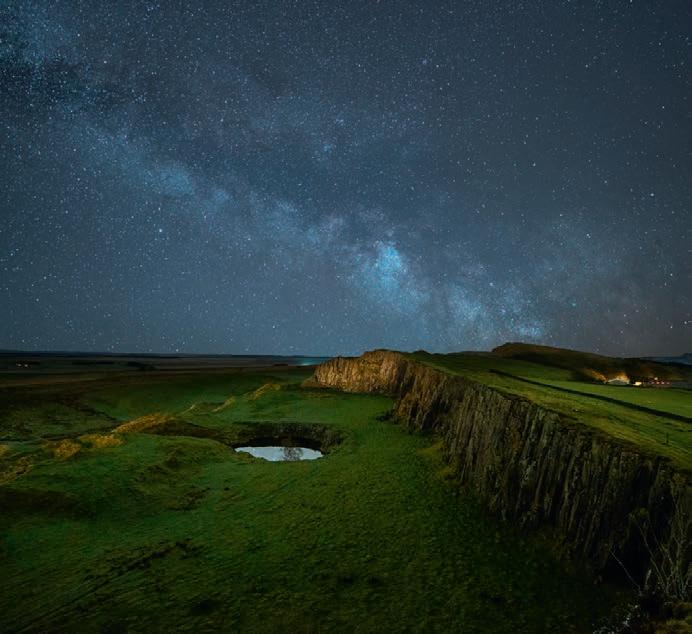
The jewel in England’s stargazing crown is found in the North East, where Northumberland National Park and most of Kielder Water and Forest Park have been awarded international recognition for their dark skies.The region’s 1,483 sq km Dark Sky Park is home to the unique Kielder Observatory (kielderobservatory.org), the best place to begin a stargazing journey in the UK. Kielder’s team of astronomers and science communicators offer a calendar of almostnightly astronomy events, allowing visitors to dip into an introductory stargazing session, try for a full moon or meteor shower, or dive headfirst into the mysteries of dark matter and the deep cosmos. Further afield in Northumberland, Battlesteads is a hotel and astronomical observatory combined (battlesteads.com), offering a place to sleep and stargaze in one property, with an on-site team of astronomers to lead you through the sky, plus helpful stay-and-gaze packages.The Twice Brewed Inn (twicebrewedinn.co.uk) also has a similar programme as well as its own brewery on site, all situated
along the history-laden Hadrian’s Wall National Trail, serving up the ghosts of Roman soldiers for evening company. Indeed, if you turn your telescope to the star Gamma Cygni in the constellation Cygnus (the Swan), then your eye will be absorbing light that left this star some 1,900 years ago, around the same time that the Romans began building their famous wall.
If you just fancy stepping outside and having a gander yourself, there are 18 UK-awarded Dark Sky Discovery Sites that offer the best views of the night sky in the park. Bring binoculars from home or simply take in the glittering spectacle with your own eyes.
To dive a little deeper, spend some time learning about Northumberland’s incredibly diverse nocturnal wildlife on a tour with Wild Intrigue, an ecotourism social enterprise that leads mini-expeditions and safaris across the county to spot animals, birds and insects. They always include a little something special, too; for example, their ‘Bats and Pizza’ nights are incredibly popular, or you could get to know the planet’s most misunderstood but beautiful pollinators – moths – over muffins and hot drinks. wildintrigue.co.uk
BRITISH BREAK MINI GUIDE
218 October/November 2023
Study the stars on Coll Dark Sky Island, Scotland


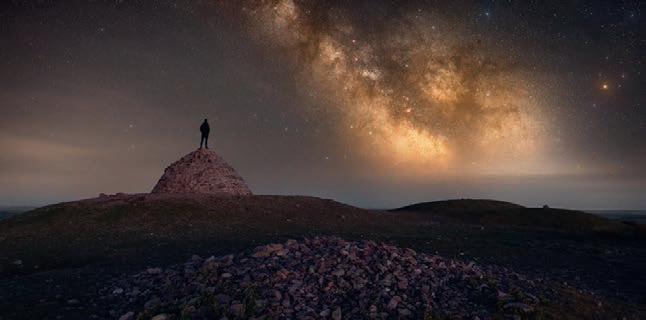
The Isle of Coll in Scotland’s Inner Hebrides became an International Dark Sky Community in 2013, reflecting its residents’ commitment to protecting their unpolluted nights. Calmac Ferries (calmac.co.uk) can drop you off at Arinagour, Coll’s main village, which is a collection of sea-facing, whitewashed cottages.The absence of street lights makes for unpolluted night skies, and almost any beach or field on the island is a good place to stop and look up. In mid-October, Coll Bunkhouse and the Cosmos Planetarium run ‘Coll and the Cosmos’, a two-day astronomy workshop with telescope stargazing and lessons on the solar system and cosmology.You can stay on-site at the bunkhouse or opt for a local B&B and book workshop tickets separately. Coll is also a very good place to glimpse the elusive northern lights. collbunkhouse.com/dark-skies-coll-cosmos
Domes, dark walks and distilleries in Dumfries & Galloway, Scotland
Since being certified as the first International Dark Sky Park in the UK back in 2009, Galloway Forest Park remains one of Britain’s darkest areas, tucked away in the south-west corner of Scotland.Alongside it, the town of Moffat is a certified Dark Sky Community with its own observatory and a sustainable whisky and gin distillery that has the only wood-fired stills in Scotland (darkskyspirits.com). Guided dark-sky and moonlit walks are held in Moffat from autumn to spring, including during the MoffatWalking Festival in early October. Elizabeth Tindal, aka the ‘freelance ranger’, regularly leads night-time tours all over Galloway (freelanceranger.com).And for a starry night’s sleep, book the Dark Sky Dome, a glamping stay in Scotland’s largest geodesic dome in the heart of Carrick Forest. dsd.bbdclients.com
Night hiking in Exmoor National Park, England
As the UK’s oldest Dark Sky Reserve (certified in 2011), Exmoor National Park not only has starry skies above wide expanses of moorland, but one of England’s few surviving examples of temperate rainforest. Activities at the Dark Skies Discovery Hub in Exford include regular evening programmes introducing the night sky. Meanwhile, a nearby night-time walking trail, which opened in 2021, crosses star-blanketed moorland waymarked by glow-in-the-dark finger posts.
Telescopes can be hired year-round from the National Park Centres in Dunster, Dulverton and Lynmouth. The Exmoor Dark Skies Festival also runs from mid-October, hosting dusk wildlife safaris, night cycling, stargazing pizza nights, ranger-led walks and even starry yoga (darkskiesnationalparks.org.uk). Finally, Jennie Wild of Wild About Exmoor is a certified guide who hosts evening tours, hikes and farmhouse dinners complete with roaring campfires; she also has cottage accommodation. wildaboutexmoor.com
⊲ Laurence Liddy; Northumberland National Park; Shutterstock; Visit South West Scotland /Ben Bush
DISCOVER British Isles www.wanderlustmagazine.com 219
Ancient landscapes in OM Dark Sky Park, Northern Ireland
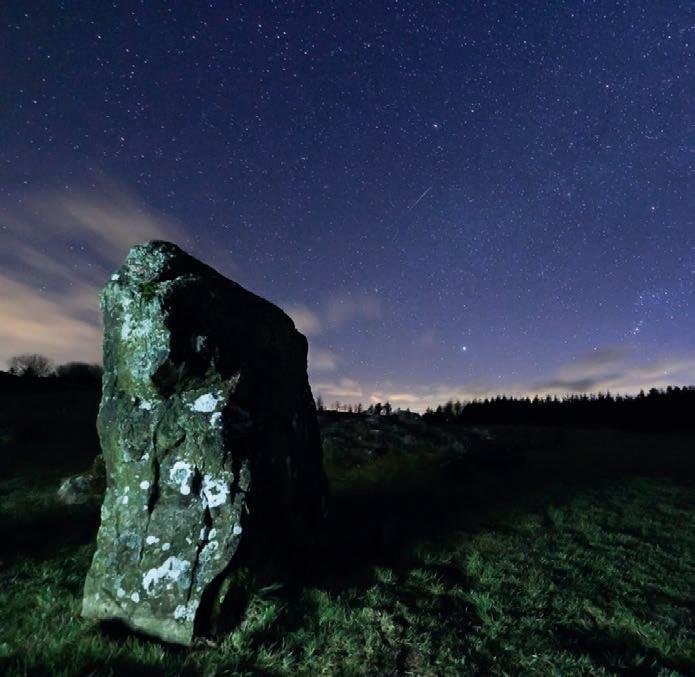
The first International Dark Sky Place certified in Northern Ireland is this ancient landscape at Davagh Forest, near the foothills of the Sperrin Mountains in CountyTyrone.The earthbound attractions of OM Dark Sky Park include the Beaghmore Stone Circles, a group of seven early Bronze Age megalithic stone circles, along with ten stone rows and 12 cairns, but even these have links to the skies.The alignments of the circles and stone rows suggest that they were used as an astronomical calendar to record midsummer sunrise, the rising and setting of the sun and moon, and other heavenly events.Tools found here have been carbon-dated to 2900–2600 BC, meaning this was a place where an ancient people lived their lives by the stars overhead.
OM Dark Sky Park and Observatory opened in 2020 and celebrates astronomy both ancient and modern.There is an indoor
astronomical museum that offers an introduction to the basics of the solar system and cosmic science. But the real draw here are the guided tours around the stone circles and rows, which give a deeper insight into how the landscape is connected to the sky and offer the chance to see these alignments for yourself.
The main attraction every year is the Stars and Stones Experience, which is available in the evening from October to March. Visitors are guided by a local storyteller and guide, who will weave together the site’s archaeology and astronomy, explaining how scientists believe the circles may have been an ancient observatory.There is also the 3.4km Solar Walk, which links up the alignments in the sky with the stones and ancient rituals via an accessible boardwalk. In addition, OM runs regular stargazing nights, meteor-shower viewing parties and astronomy socials and events in the all-weather visitor centre.
BRITISH BREAK MINI GUIDE
220 October/November 2023
Starry alignments in West Penwith & Bodmin Moor, England
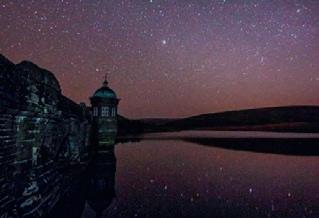
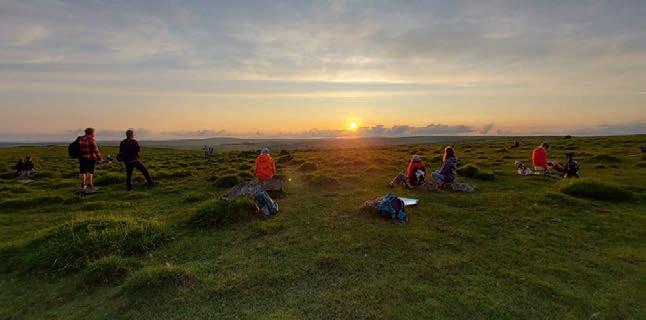
Cornwall’s two International Dark Sky Parks – West Penwith and Bodmin Moor – not only have protected night skies, but they lie within Areas of Outstanding Natural Beauty that are filled with history.These are remote places of unpredictable weather and wild landscapes on which ancient Britons built stone circles, barrows and other sacred sites that align with the stars and movements of the sun.
Stay at Eddington Lodge, near Bodmin Moor, in one of its Scandinavian-style log cabins (eddington-lodge.co.uk).The lodge offers a raft of astronomy courses and also has observation pods that have 50cm telescopes, plus a domed observatory with a refracting telescope to view and photograph Saturn’s rings as well as galaxies, nebulae and moons.You can also get a glimpse of the sun sinking perfectly over a standing stone on an archaeoastronomy tour with local expert Carolyn Kennett. archaeoastronomycornwall.com
Wide skies and wallabies on the Isle of Man
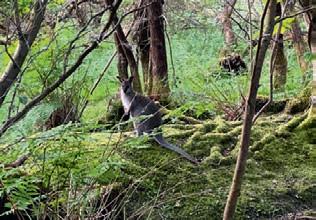
The ‘Dark Sky Discovery Site’ is a uniquely British certification for stargazing locations, and the Isle of Man (with 26) has more than anywhere else. Its sites were created by local astronomer Howard Parkin, who also offers bespoke stargazing tours (iomevents.com). One of the island’s best starry spots is the Sound Café (thesound.im), which sits at the southern tip and overlooks the Calf of Man, a tiny islet offshore; it holds astronomy events in autumn and winter. Look out too for evening walks in search of nocturnal wallabies in the Curragh wetland with local legend John ‘Dog’ Callister (willowmann.im), who tells the story of how these marsupials came to live wild on the island. Make your base at Thie Spooyt, a beautiful self-catering house that is bookable through Island Escapes and comes with Irish Sea views and a telescope for stargazing. islandescapes.im
Dark and quiet skies in Mid Wales
Home to the starry-skied Cambrian Mountains and neighbouring ElanValley Dark Sky Park, which is set on 18,200 hectares of the Elan Valley Estate, MidWales is one of Britain’s most underrated stargazing regions. Both these areas offer great night-sky views when it’s clear, and generally receive fewer visitors than other dark-sky areas inWales, guaranteeing a quieter experience.The Elan Valley has many traditional cottages that are perfect for both star-watchers and cosying up next to a crackling fire.The Cambrian Mountains also have an ‘Astro Trail’ that joins up viewing sites, including a looming stone arch at Cwmystwyth, plus woodland and reservoirs offering expansive nightsky views.Time your trip to coincide withWelsh Dark SkiesWeek in February, when there are astronomy events, photography workshops, stargazing and more. cambrianmountainsdarkskies.co.uk
DISCOVER British Isles www.wanderlustmagazine.com 221
Alamy; Carolyn Kennett; Megan Eaves; Mid Ulster District Council
Next issue on sale 23 November
30TH ANNIVERSARY ISSUE
OUR BIGGEST ISSUE EVER, FEATURING:
Bosnia Bhutan Sierra Leone
France Greece Florida
US Capital Region Italy Finland Scotland New Zealand
Ecuador Singapore South Africa

Croatia Spain Chile
+ DISCOVERTHEFUTUREOFTRAVEL!

Alamy
Cities of the USA
Can you tell Pittsburgh from Portland; San Diego from Santa Fe? Test your transatlantic know-how with our quiz on the USA’s top urban hotspots
1
Can you name this city from just its French Quarter?


a. New Orleans, Louisiana
b. Louisville, Kentucky
c. Atlanta, Georgia
d. Charleston, South Carolina
c. Orlando
d. Tampa
4 New Mexico has the oldest capital city in the USA, but what is it called?
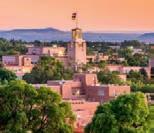
a. Albuquerque
b. Taos
c. Santa Fe
2
In which state would you find the city of Chattanooga?
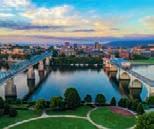
a. Texas
b. Tennessee
c. Utah
d. Arkansas
d. Roswell
5 This city holds a world-famous Mardi Gras celebration that attracts nearly 1.5 million people every year, but where is it?
3
Which Florida city is home to the world’s longest continuous sidewalk?

a. Miami
b. Jacksonville
a. Little Rock, Arkansas
b. New Orleans, Louisiana
c. Dallas, Texas
d. Oklahoma City, Oklahoma
6
The Liberty Bell is an iconic symbol of American independence, but in which city would you find it today?


a. Philadelphia, Pennsylvania
b. New York, New York
c. Boston, Massachusetts
d. Chicago, Illinois
7 Where can you find the neighbourhood of Little Havana?
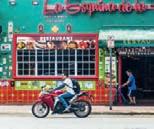
a. Miami, Florida
b. Honolulu, Hawaii
c. Los Angeles, California
d. None of the above
festival? (Yes, it’s dedicated to pickles.)
a. Pittsburgh, Pennsylvania
b. Williamsburg, Virginia
c. Plattsburgh, New York
d. Portland, Oregon
c. F Scott Fitzgerald
d. William Faulkner
9
What is the name of this museum in Los Angeles?

a. The Getty
b. Natural History Museum
c. Los Angeles County Museum of Art
d. The Broad
11 This American football team last won the Super Bowl in 2011, but which Wisconsin city do they call home?
a. Madison
b. Green Bay

c. Milwaukee
d. Appleton
12
In which city would you see this iconic skyline?
a. Seattle, Washington

10
In which city would you encounter the annual Picklesburgh

8
Which famous novelist’s former home can you visit in Montgomery, Alabama?
a. John Steinbeck
b. Mark Twain
b. San Francisco, California
c. Charlotte, North Carolina
d. Minneapolis, Minnesota
For more travel quizzes, go to: wanderlustmagazine.com 223 WANDER QUIZ Answers: 1D; 2B; 3D; 4C; 5B ;6A; 7A; 8A; 9C; 10C; 11B; 12A
1 4 3 2 5 6 7 8 9 10 11 12 Words: Jessica Reid; images: Alamy; Shutterstock

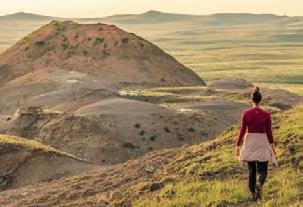























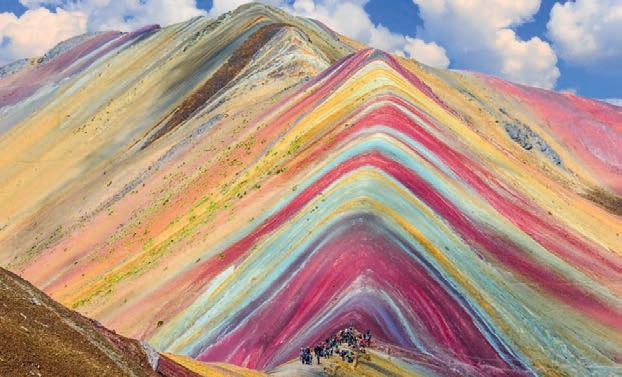






Shutterstock
START AT 18.30 (UK TIME): Join us for these two brilliant virtual events packed full of inspiration. For more information and to register, visit: wanderlustmagazine.com/events THURSDAY 26 OCTOBER ANTIGUA & BARBUDA: AWAY FROM THE BEACHES wanderlustmagazine.com/events WEDNESDAY 18 OCTOBER PERU: BEYOND MACHU PICCHU Wanderlust Virtual Reader Events
BOTH
Malick Suso
Winner of the ‘Wildlife & Safari’ category at Wanderlust’s 2023 World Guide Awards, Malick talks about helping others discover the magic of The Gambia’s birdlife
When did you start to think you could channel the birdwatching knowledge you had built up into a career as a guide?
I was interested in birdwatching from a very young age. I was inspired by my uncle, Lamin Sidibeh, who was the first birdwatching guide in The Gambia and knows everything about birds. He later trained me in how to be a guide; now I enjoy encouraging others to follow in this profession.

It’s always heartening when people are able to turn their passions into their career. What I like about my job is simply getting to wander among the beauty of nature. It’s not just the landscape, either; we have so many colourful birds in this country – The Gambia has over 600 recorded species – and it is always a joy to see one in the wild.
When is the best time to visit The Gambia for birdwatching? It’s great all year round for spotting birds, but it is especially good
Keeping a lookout (top–bottom) Malick and Chris Packham consult their notes way back in 2011 – the pair have been guiding together for over 25 years; Malick scans for birds in the forests of The Gambia, a country with over 600 recorded bird species

between July and November, when they achieve their breeding dress (plumage) and the grasses are not very tall, so it’s easier to spot them. January to early March is also good.
Where do you personally like to go looking for birds?
Mandina Lodges, which lies on a tributary of the River Gambia, is a great spot, especially around the garden area and the dry woodland.
Abuko Nature Reserve’s rice field is also good, as is Farasuto Forest Community Nature Reserve. Any farmland is also perfect for spotting birds, if you arrive early enough. But I am also still discovering new areas within familiar spots, as well as lots of new places upriver.
After all these years of guiding, which bird do you still get excited about seeing?
The black-shouldered kite is impressive. I like the way that he hunts for his prey. He is also beautiful-looking; his colouring is black while his legs
are yellow. He also has a nice red eye with a black stripe around it.




What has been your most memorable moment as a guide?
I enjoy all the time I spend with my guests, but most memorable of all was spending time with [TV presenter and naturalist] Chris Packham, because I believe we learnt a lot from each other.
Chris Packham on Malick
“I first met Malick in 1995 and have co-toured with him more than 25 times inThe Gambia and Senegal.Put simply: he is one of the best birders I have met. His knowledge and understanding of avian behaviour, physiology and ecology is top rate and his bird-mimicking skills – calling to species to lure them out – are legendary. He is also honest, decent, diplomatic and sensitive. In all the years that I’ve known him, I’ve never once heard a single complaint;just praise of the highest order.”
Malick Suso, The Gambia Experience (gambia.co.uk)
226 October/November 2023 TOP TOUR GUIDE
The Gambia Experience








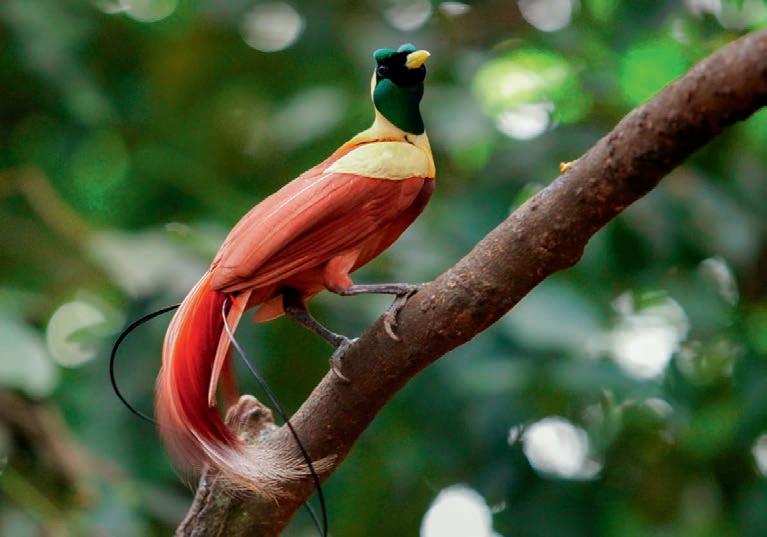































































































































































































































 Alamy; Jimena Agois; Shizen Restaurante Nikkei
Alamy; Jimena Agois; Shizen Restaurante Nikkei


































 Reviewed by Oliver Berry
Reviewed by Oliver Berry












 Alamy; Calgary Photos/Cathedral Mountain Lodge; Fairmont Hotels & Resorts; Moraine Lake Lodge
Alamy; Calgary Photos/Cathedral Mountain Lodge; Fairmont Hotels & Resorts; Moraine Lake Lodge








 Words Lynn Houghton
Words Lynn Houghton










































































 Words James Draven
Words James Draven
























































 Words Katie McGonagle, Jim Bamboulis, Amy Bizzarri, Jennifer Broome, Priscilla Blossom, Karen Burshtein, Gareth Clark, MaryRose Denton, Carolyn B Heller, Nathalie Katinakis, Jessica Wynne Lockhart, Shelley Cameron-McCarron, Diana Lambdin Meyer, Lola Méndez, Misty Milioto, Vikki Moran, Diane Selkirk, Cristina Slattery, Rebecca Toy, Taryn White and Brandon Withrow
Words Katie McGonagle, Jim Bamboulis, Amy Bizzarri, Jennifer Broome, Priscilla Blossom, Karen Burshtein, Gareth Clark, MaryRose Denton, Carolyn B Heller, Nathalie Katinakis, Jessica Wynne Lockhart, Shelley Cameron-McCarron, Diana Lambdin Meyer, Lola Méndez, Misty Milioto, Vikki Moran, Diane Selkirk, Cristina Slattery, Rebecca Toy, Taryn White and Brandon Withrow



















































































 MEET LOCAL ARTISTS ON CANADA’S SUNSHINE COAST
GO BEAR-SPOTTING IN BRITISH COLUMBIA
SIP BOURBON
MEET LOCAL ARTISTS ON CANADA’S SUNSHINE COAST
GO BEAR-SPOTTING IN BRITISH COLUMBIA
SIP BOURBON











































































 Words David Atkinson
Words David Atkinson














 Pleasure town (above) At 700m in length, Llandudno has the longest pier in Wales, but the current incarnation wasn’t the first to be built on this site. A wooden version was originally erected in 1858, though its main purpose wasn’t pleasure; it was largely used to transfer limestone from quarries in the nearby Happy Valley to waiting ships. The pier standing today dates from 1877, a time when Llandudno was a fast-growing destination, and it became a landing stage for visitors disembarking from steamships. These days it is known as the home of Britain’s longest-running Punch and Judy show, which has been here for over 160 years
Pleasure town (above) At 700m in length, Llandudno has the longest pier in Wales, but the current incarnation wasn’t the first to be built on this site. A wooden version was originally erected in 1858, though its main purpose wasn’t pleasure; it was largely used to transfer limestone from quarries in the nearby Happy Valley to waiting ships. The pier standing today dates from 1877, a time when Llandudno was a fast-growing destination, and it became a landing stage for visitors disembarking from steamships. These days it is known as the home of Britain’s longest-running Punch and Judy show, which has been here for over 160 years




































































































































































































































